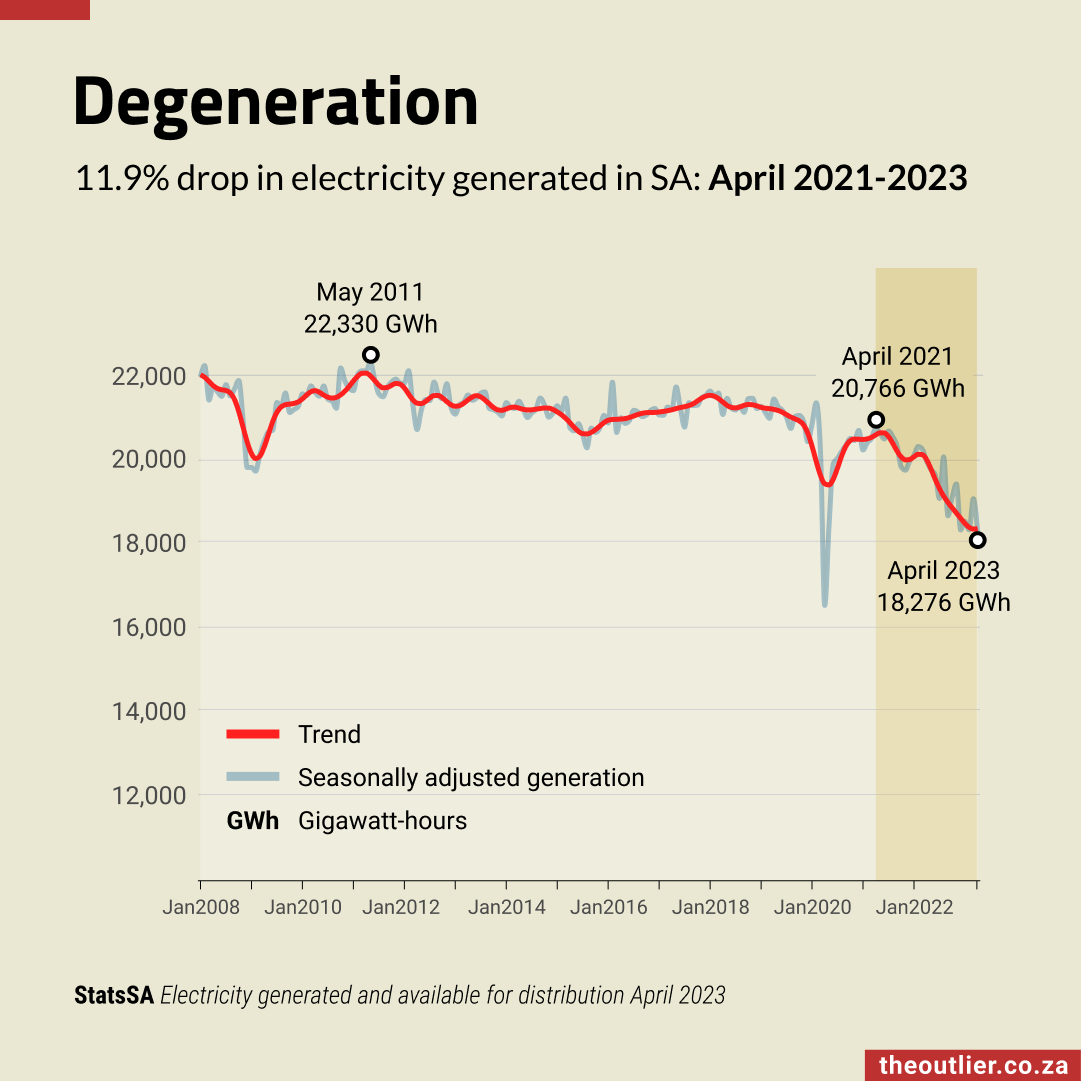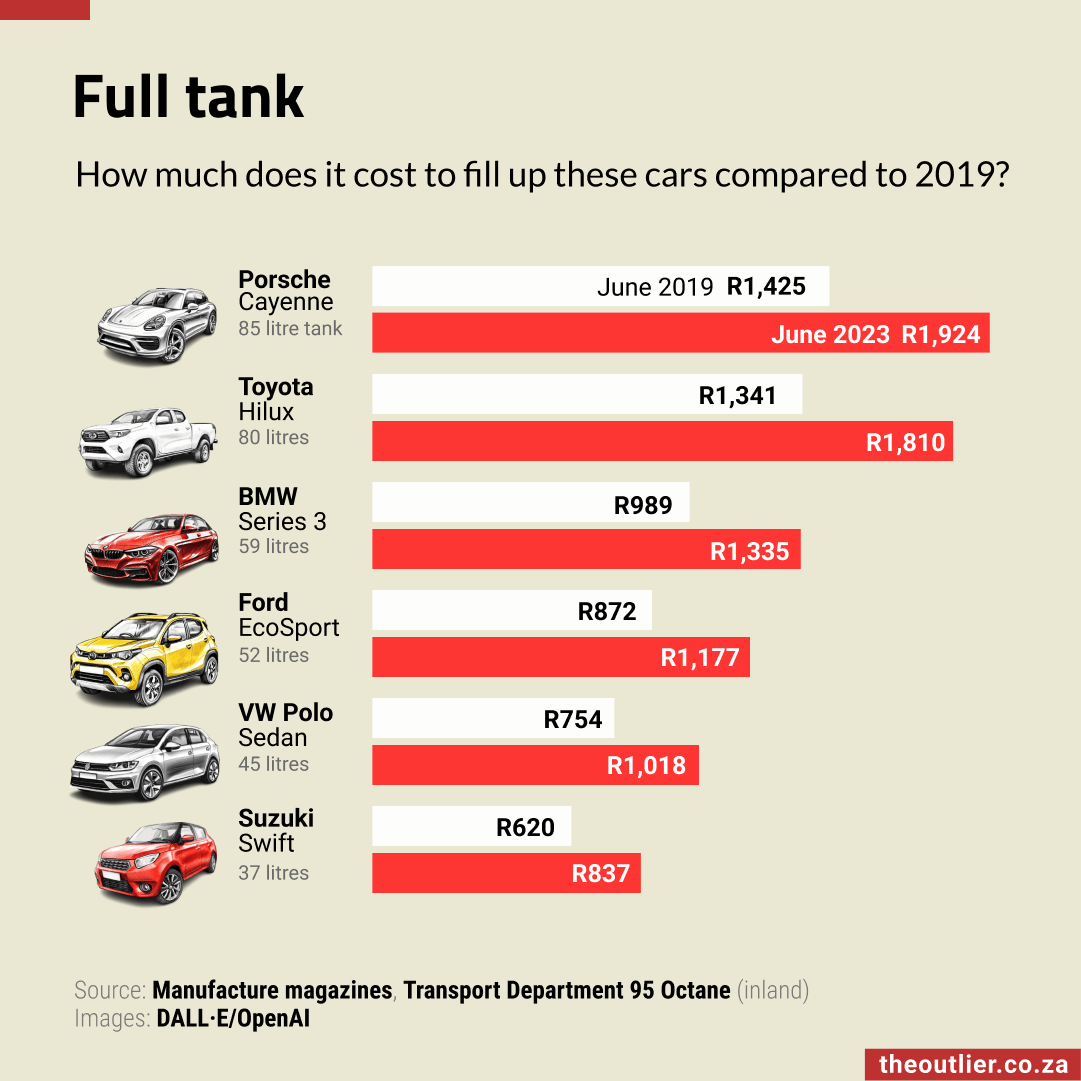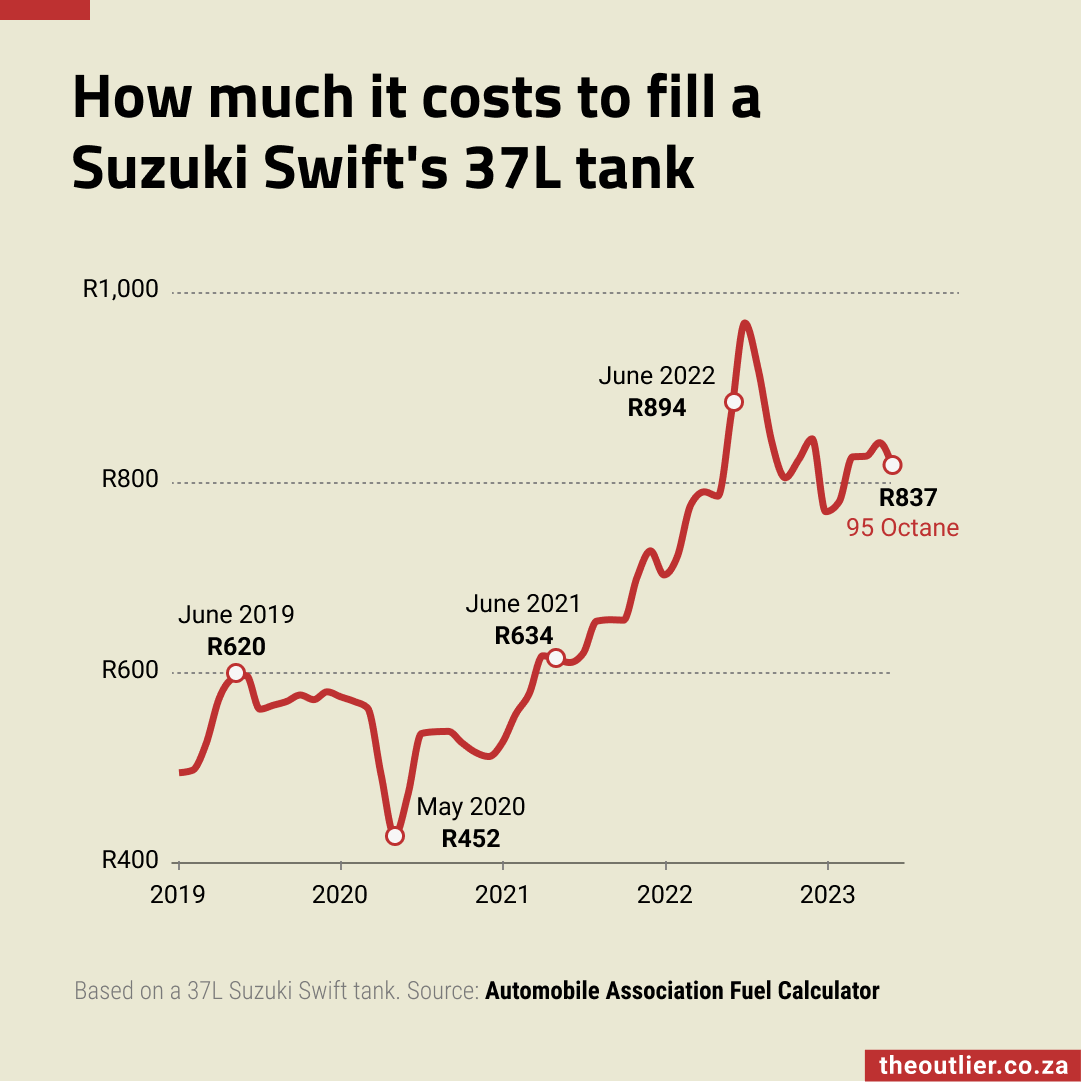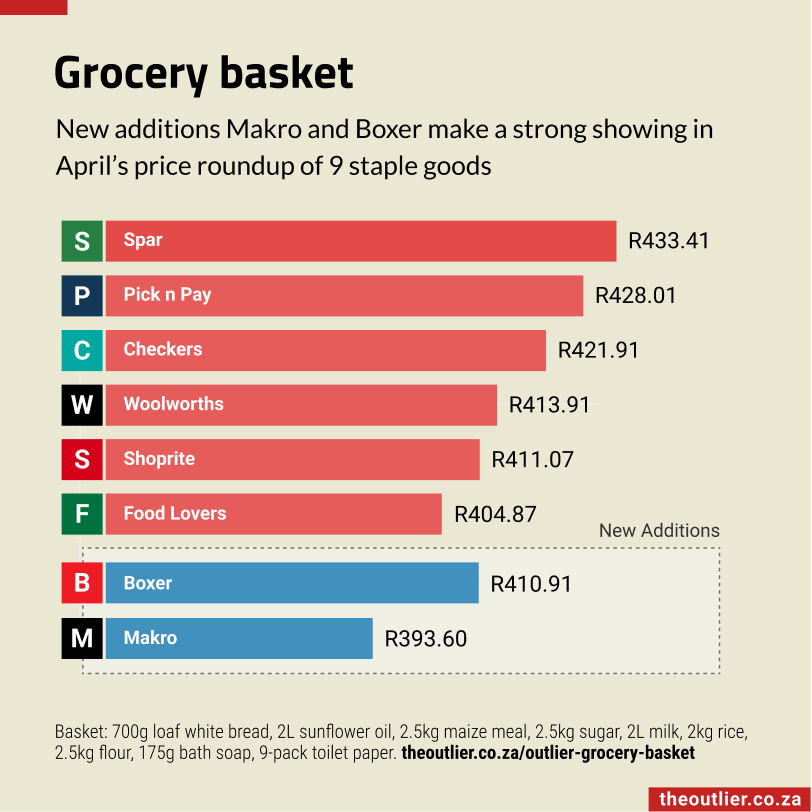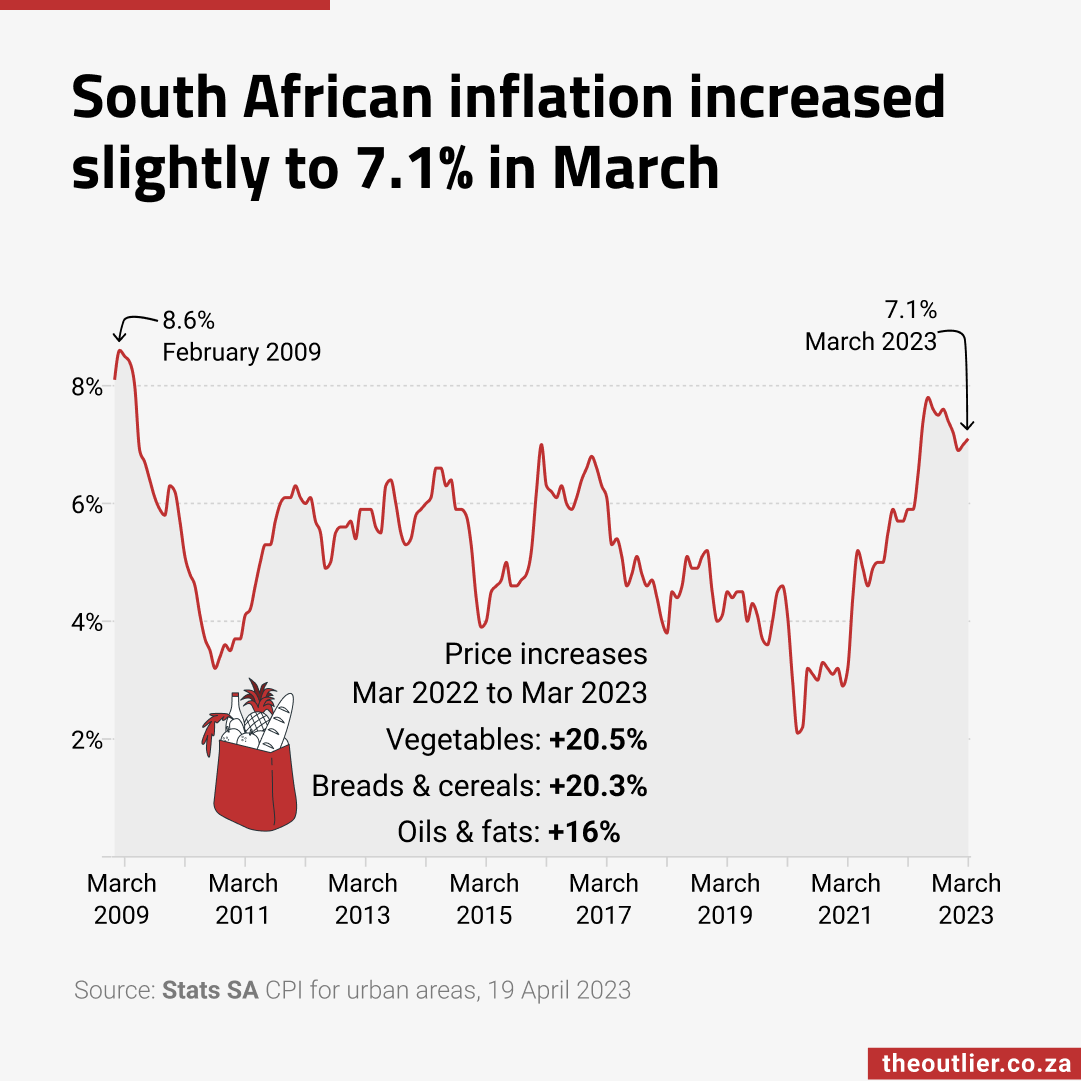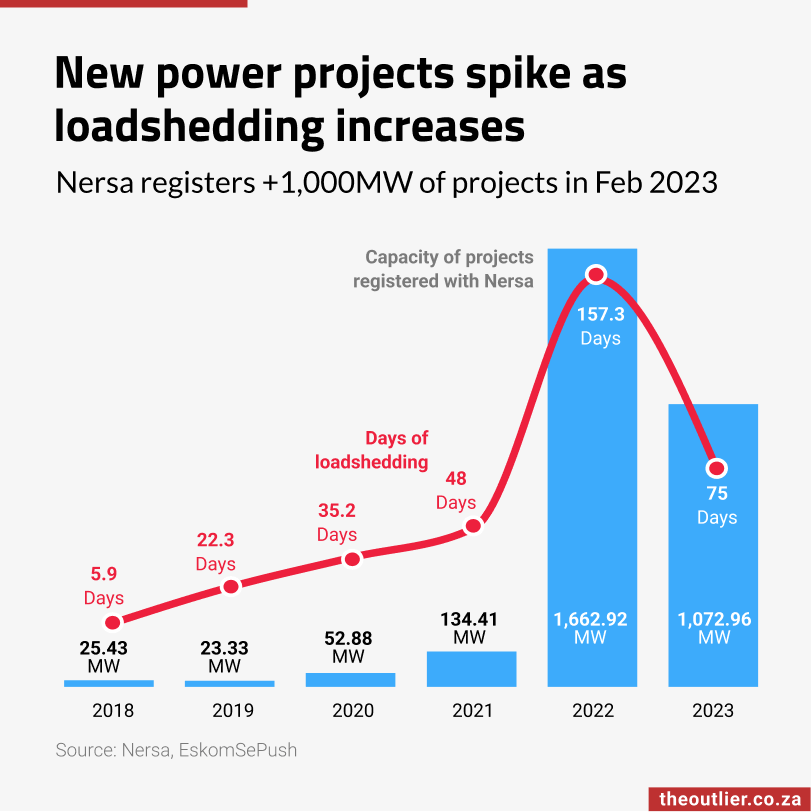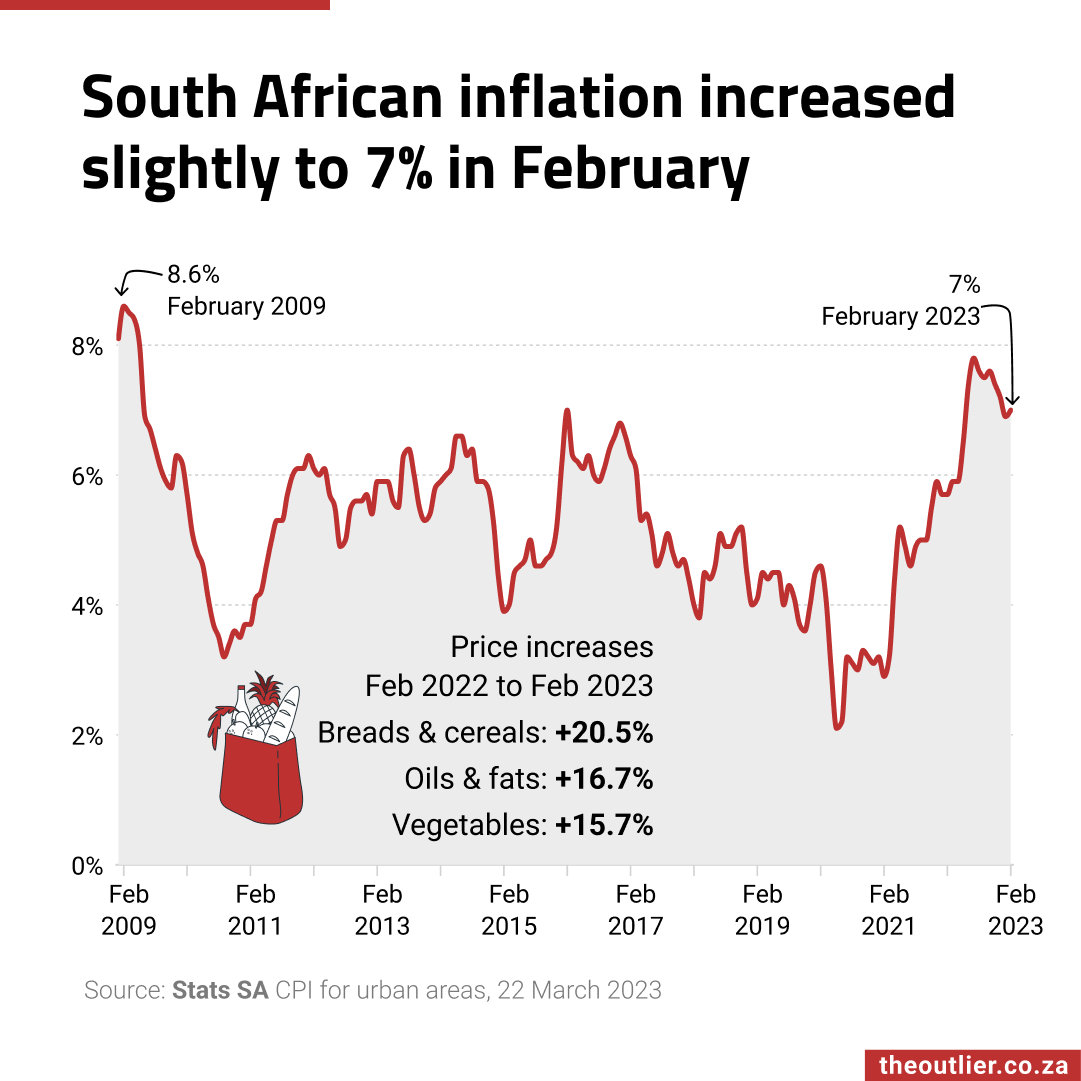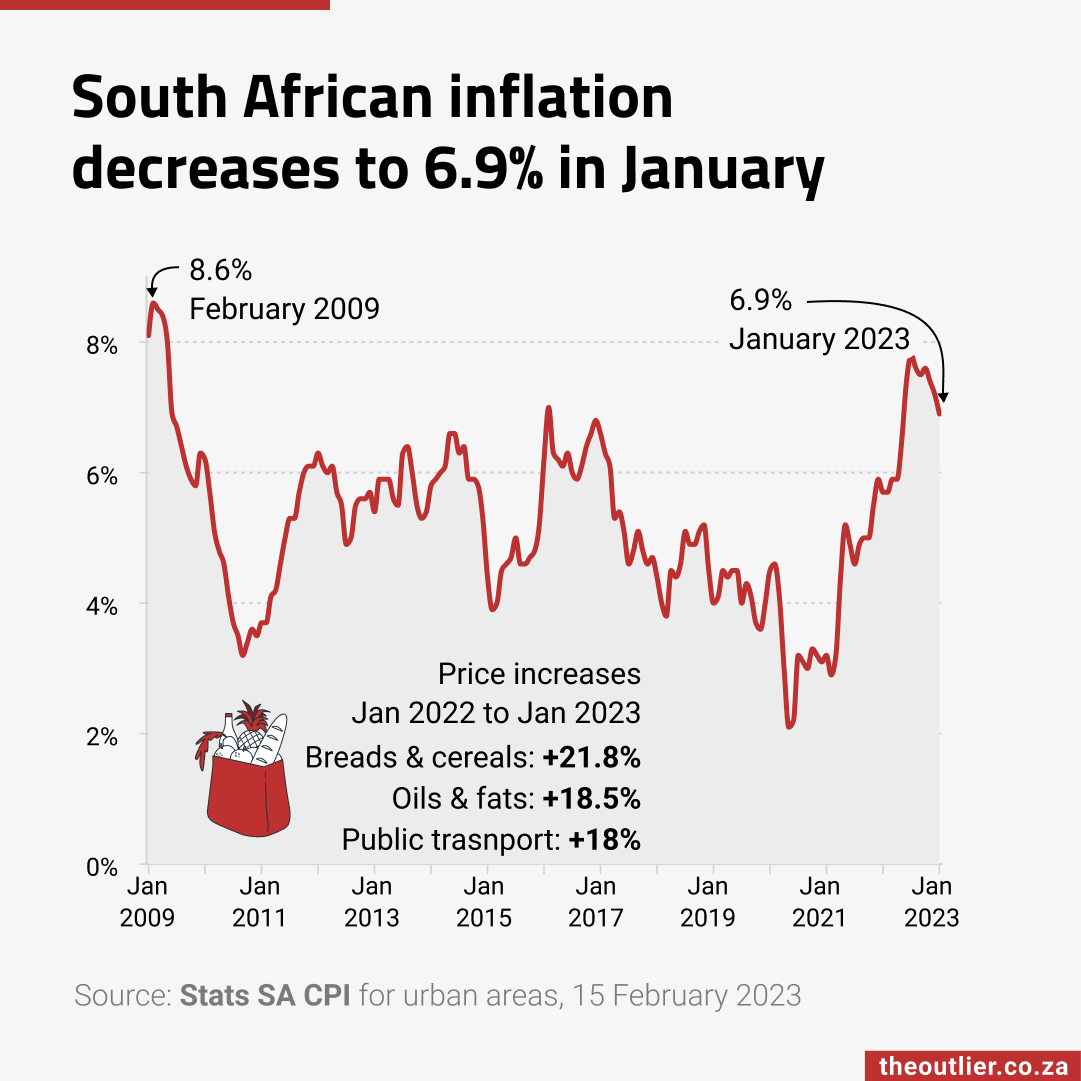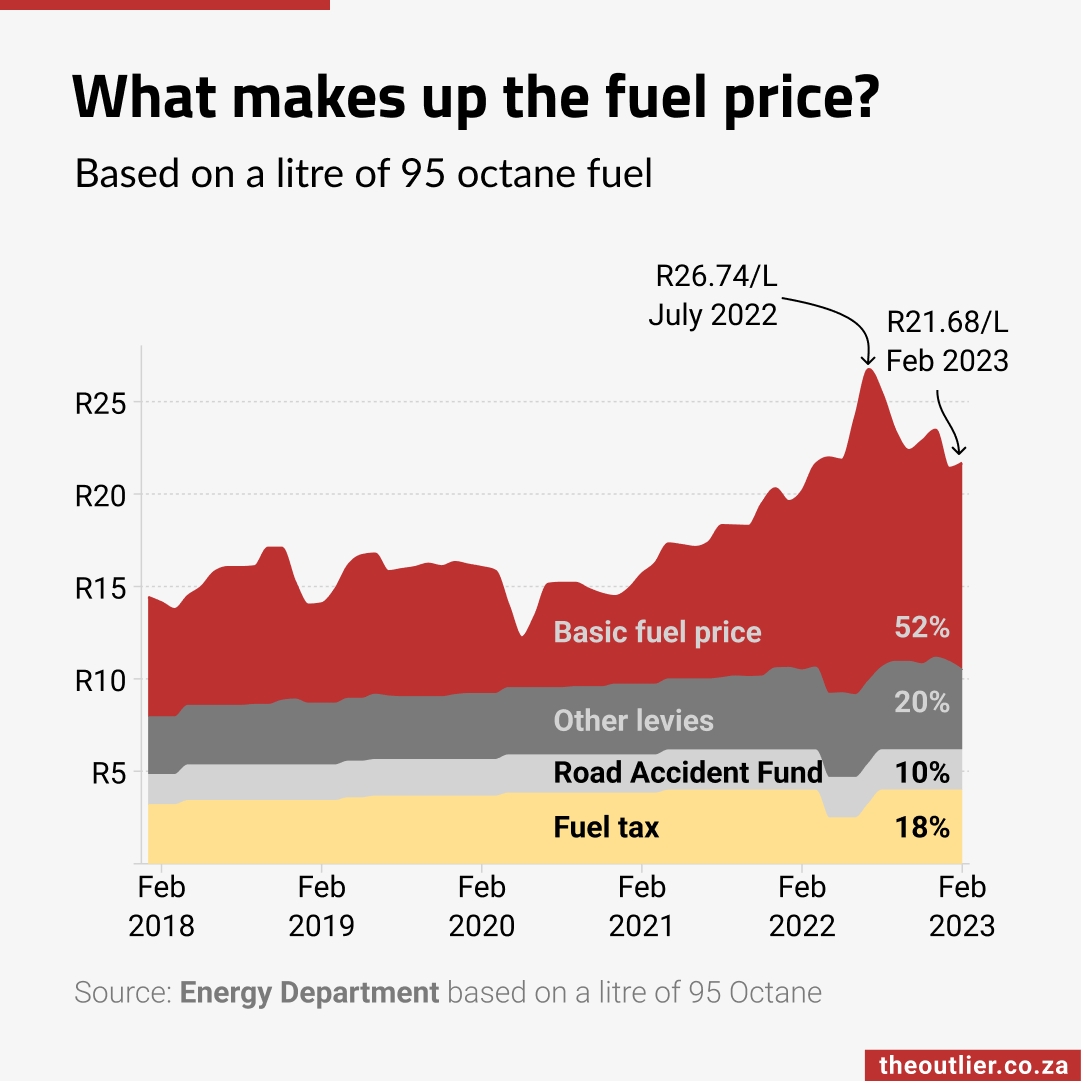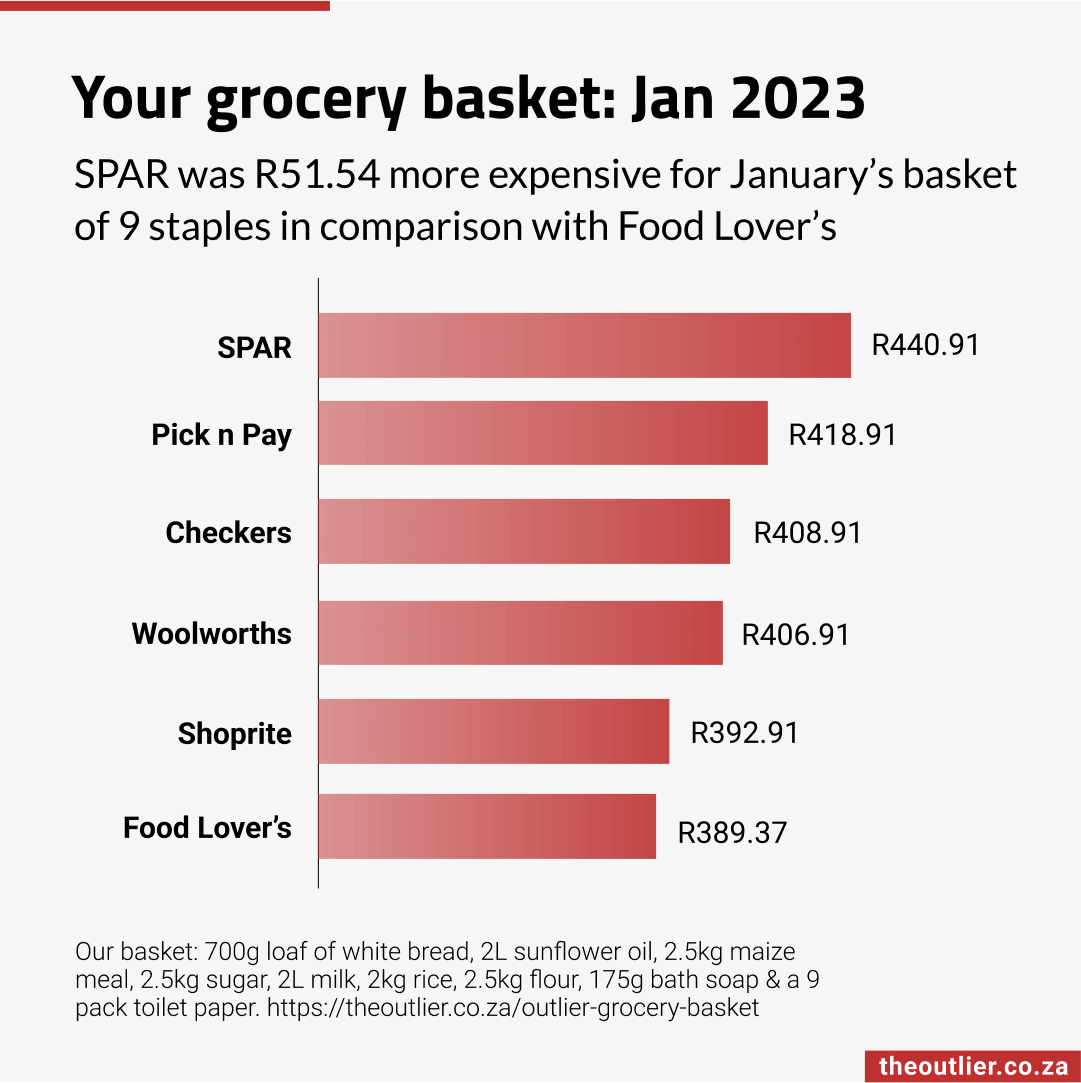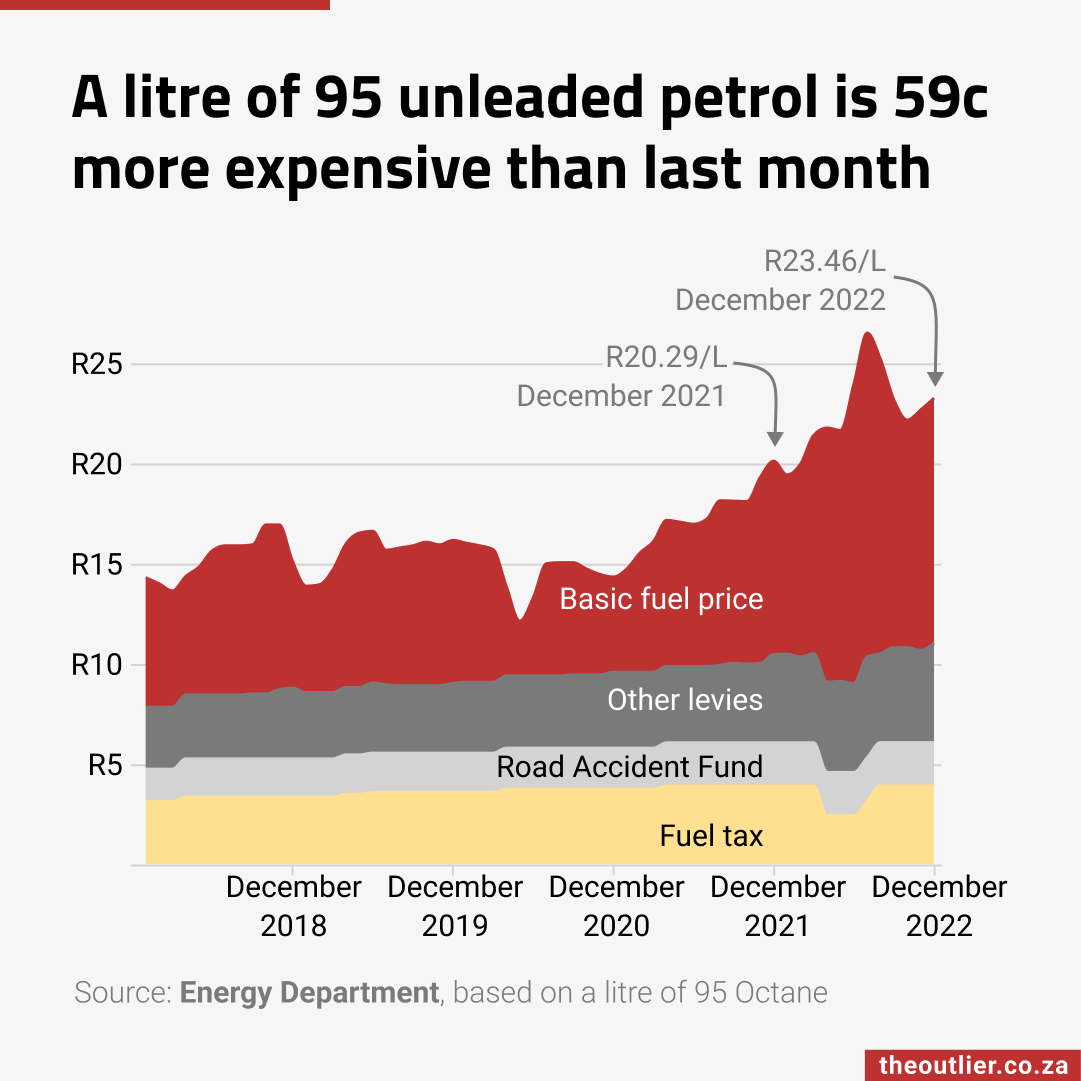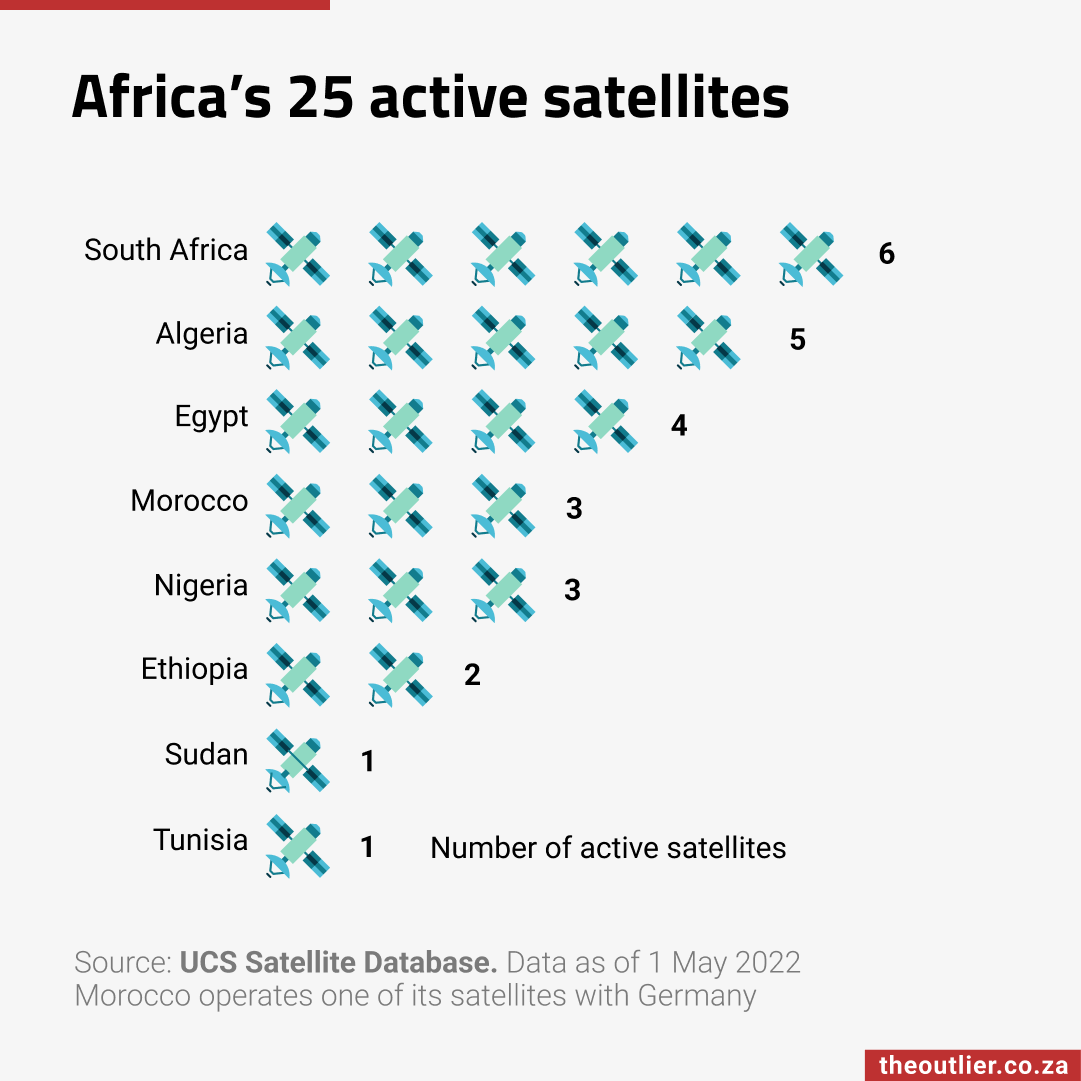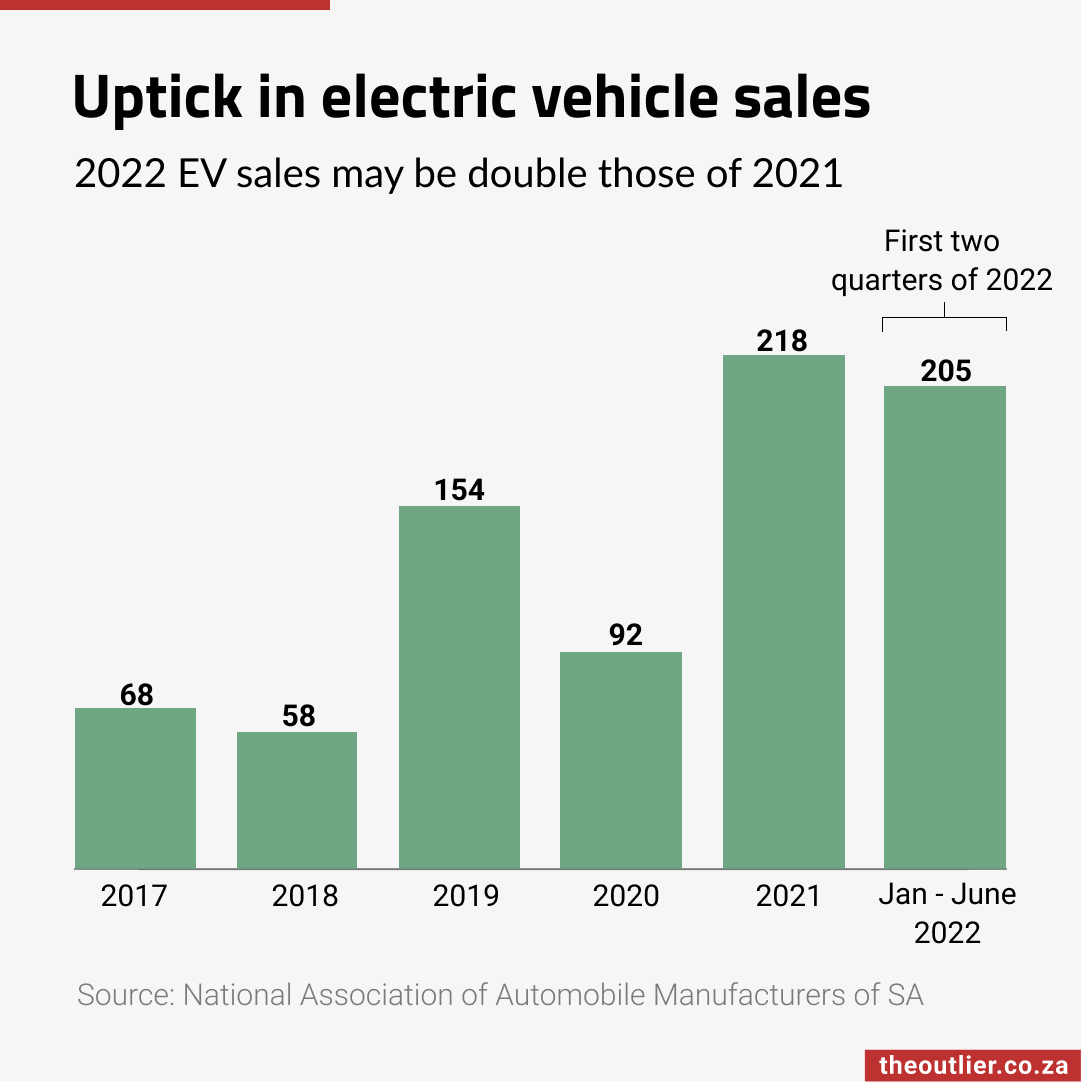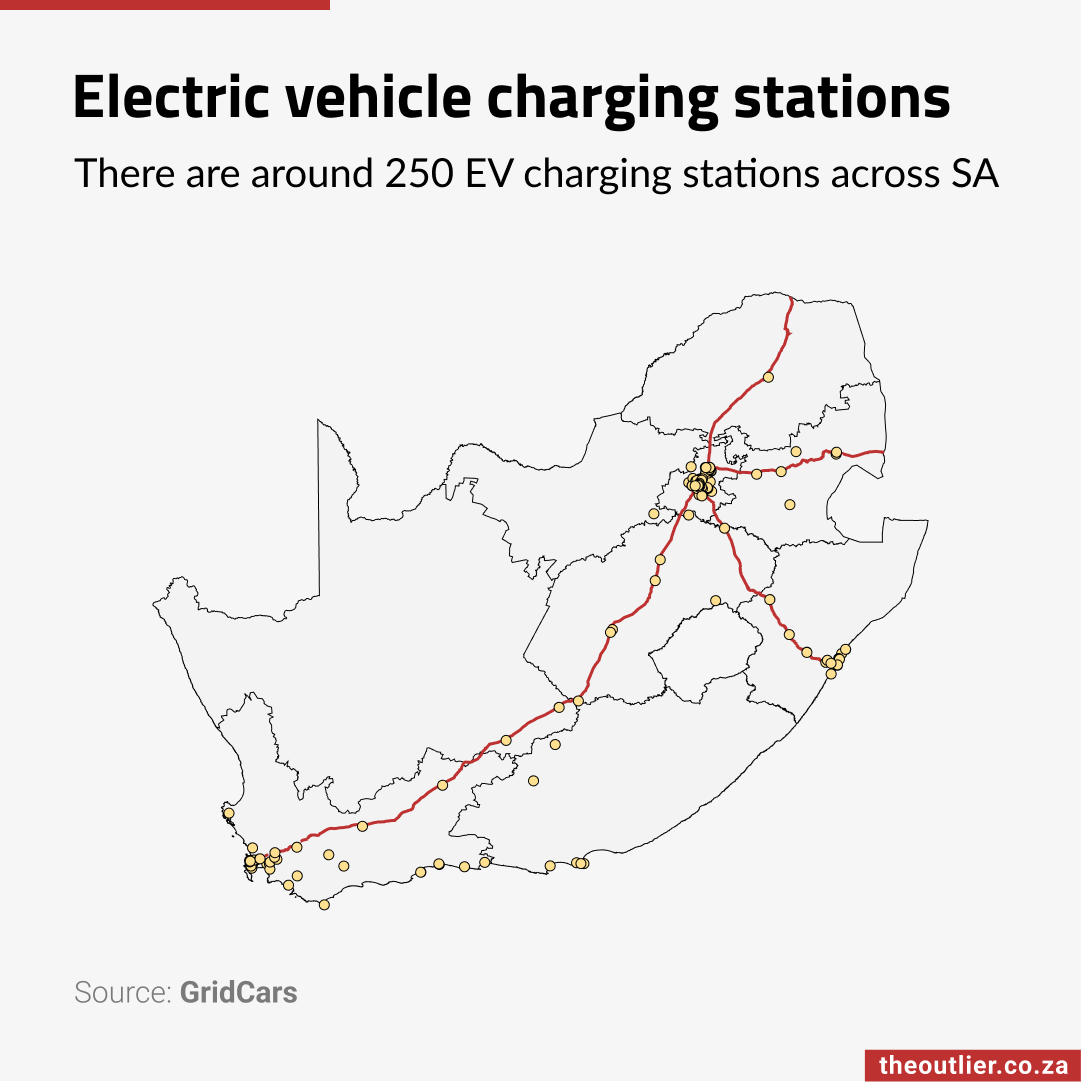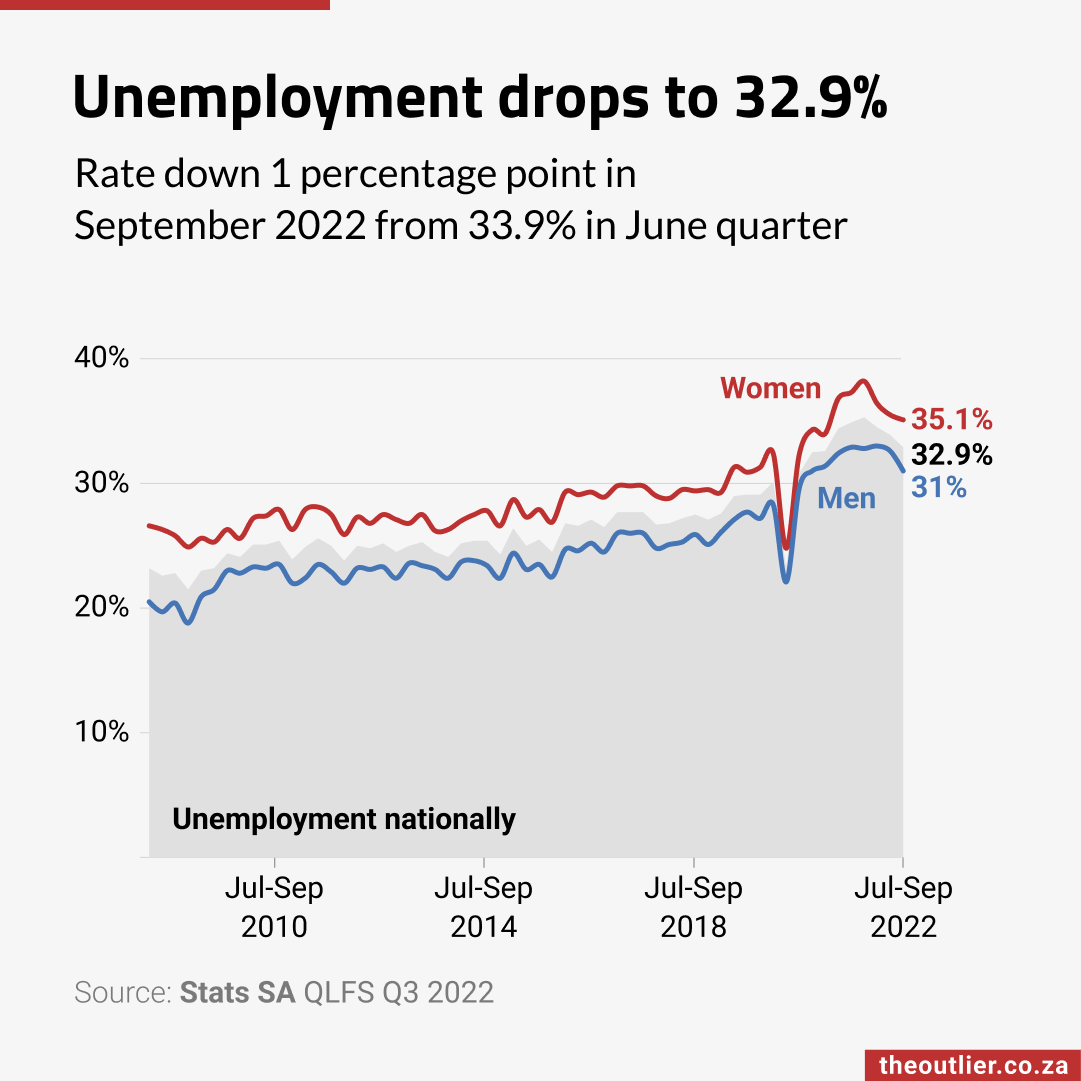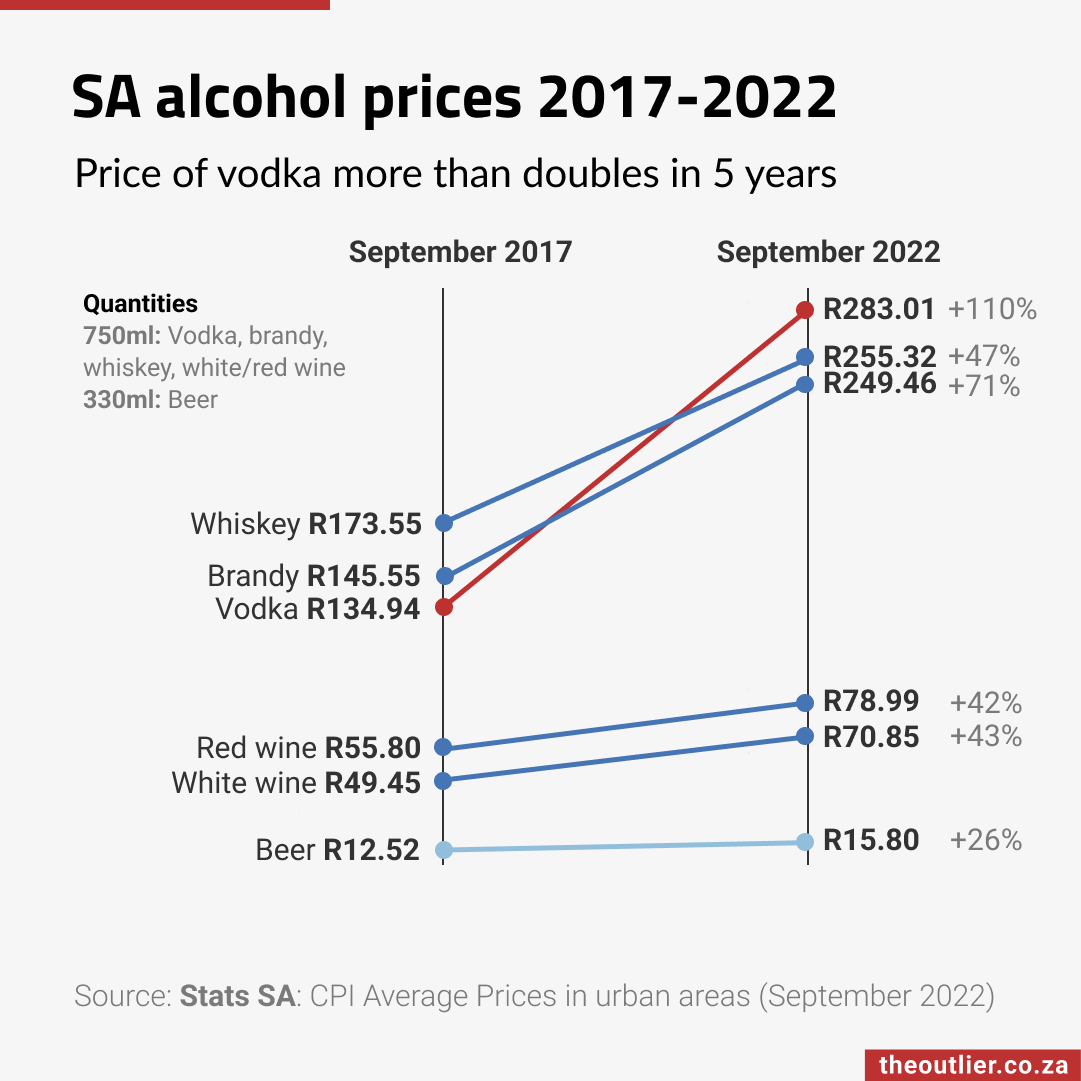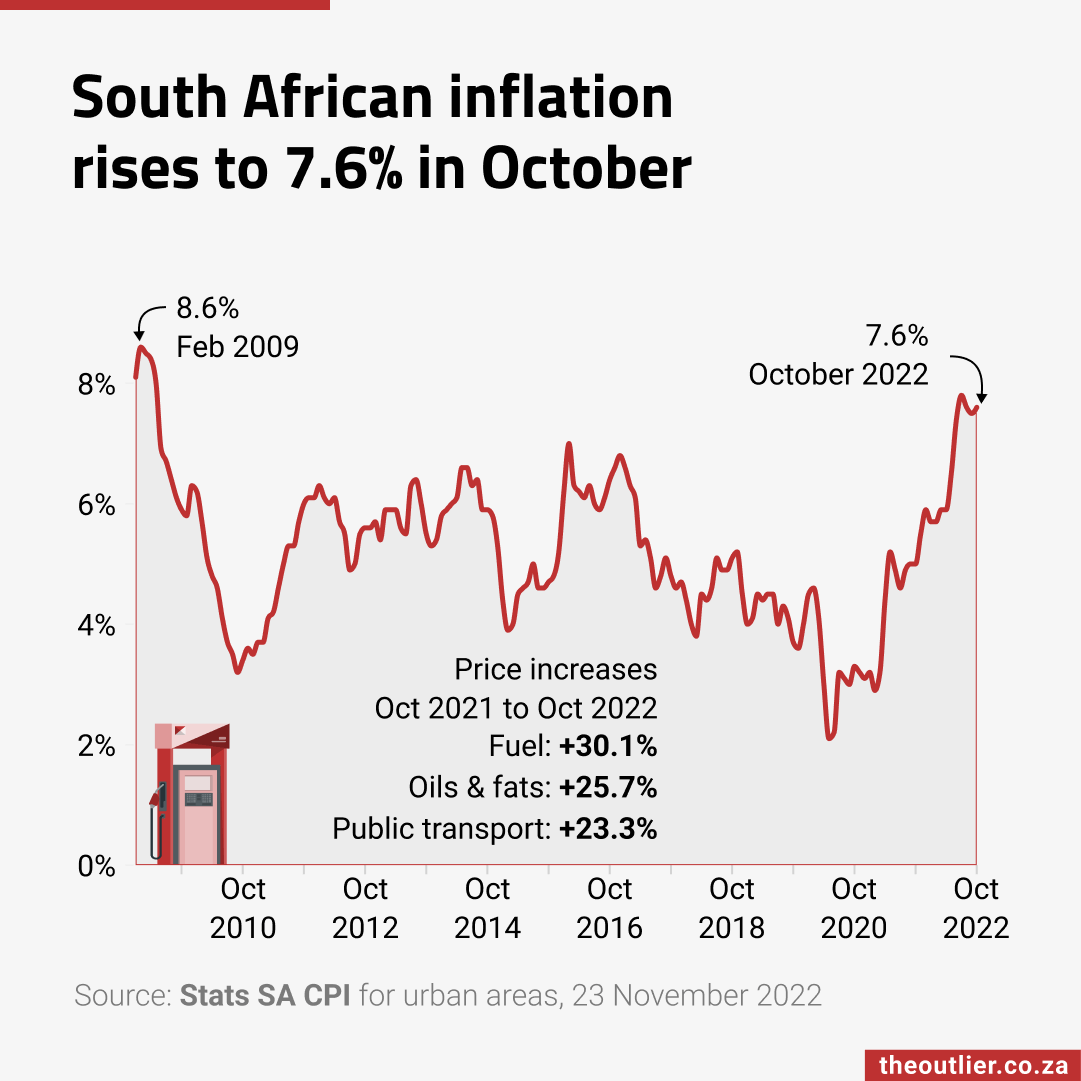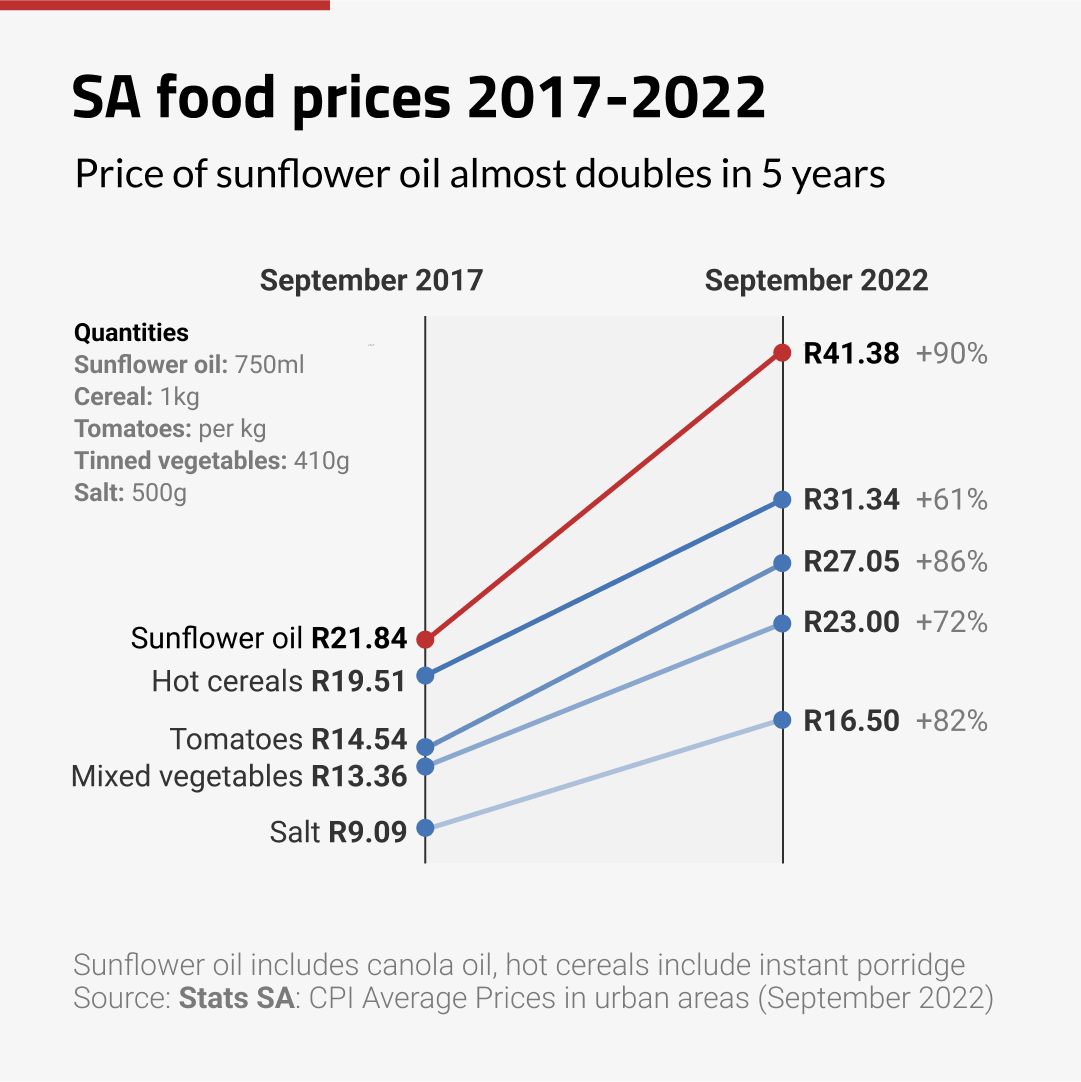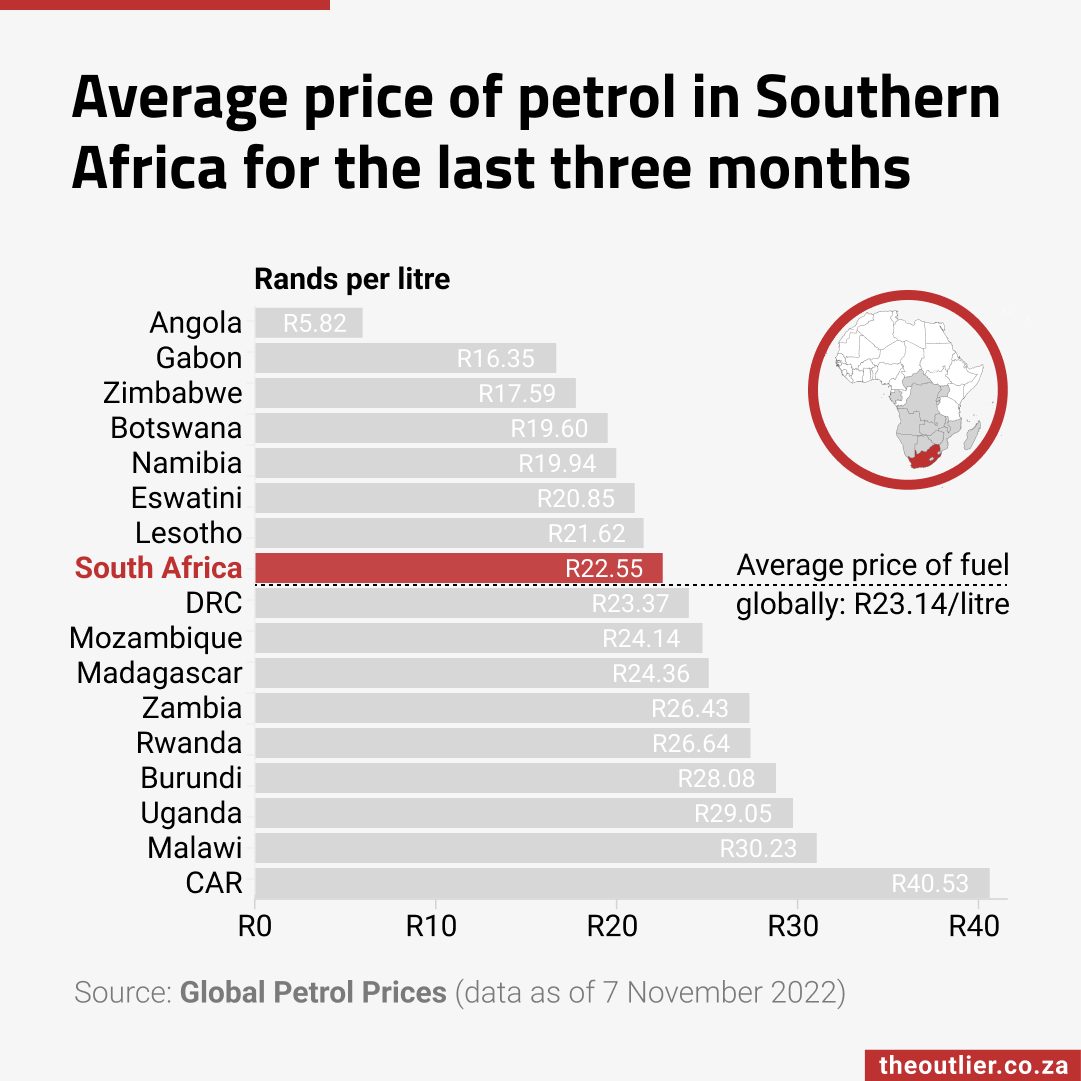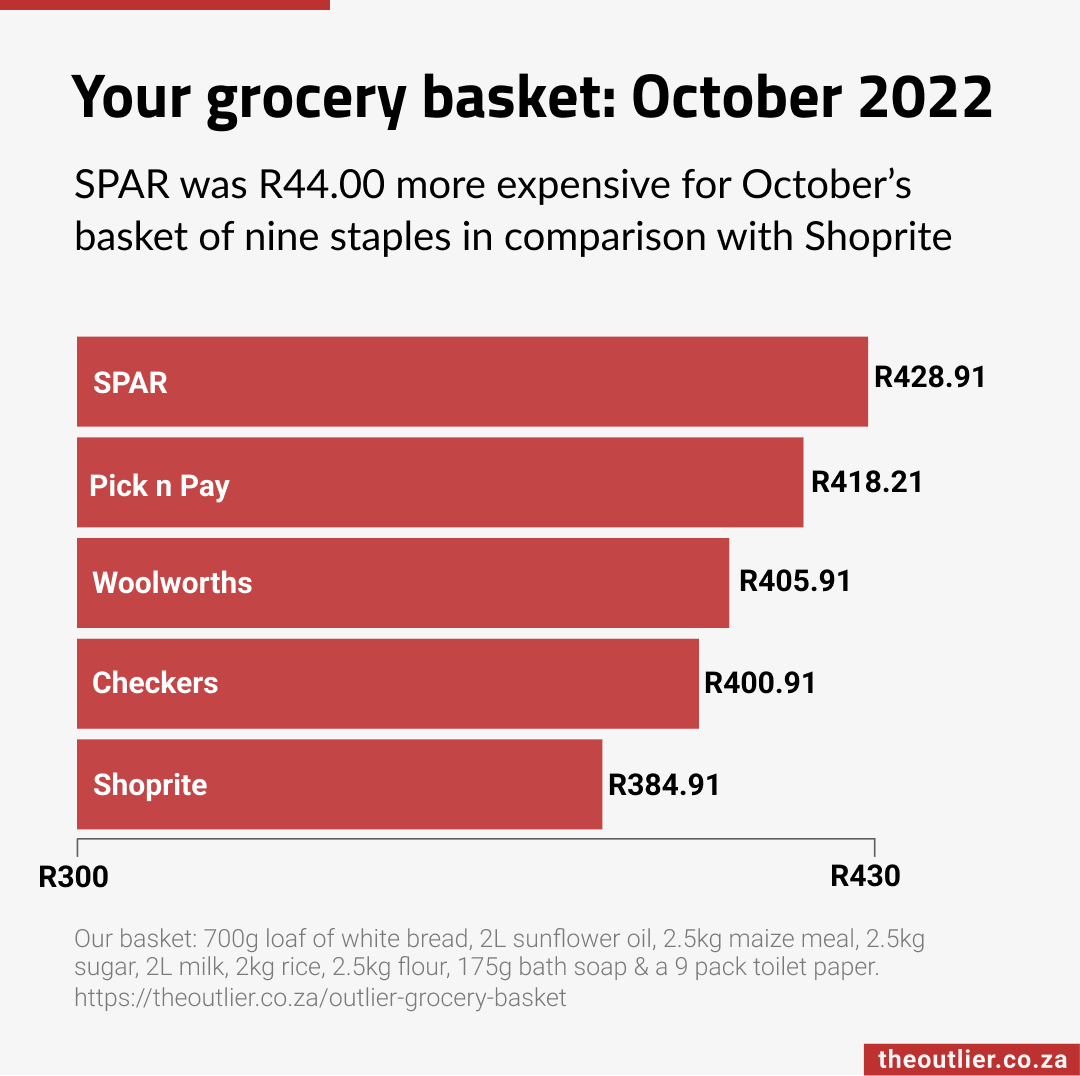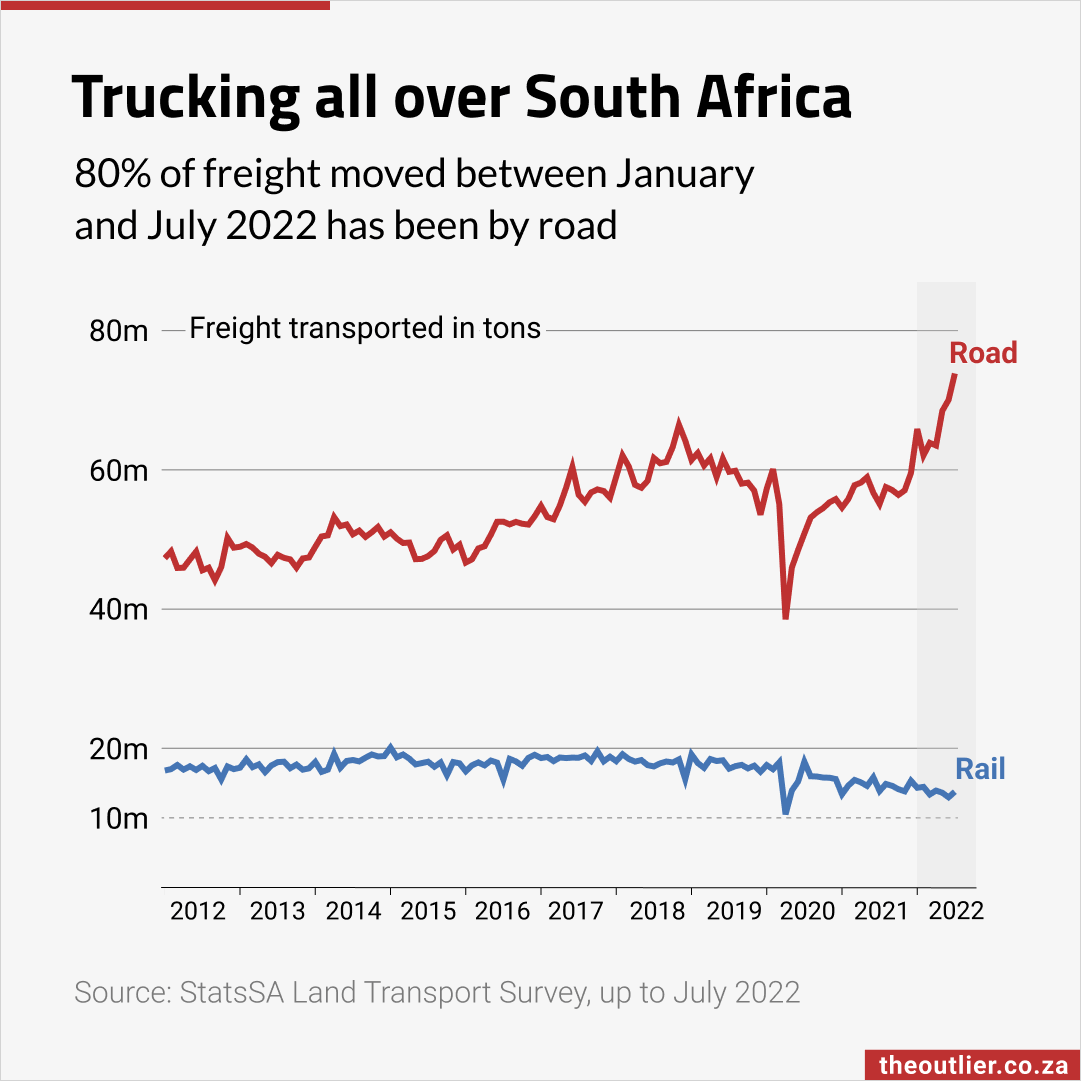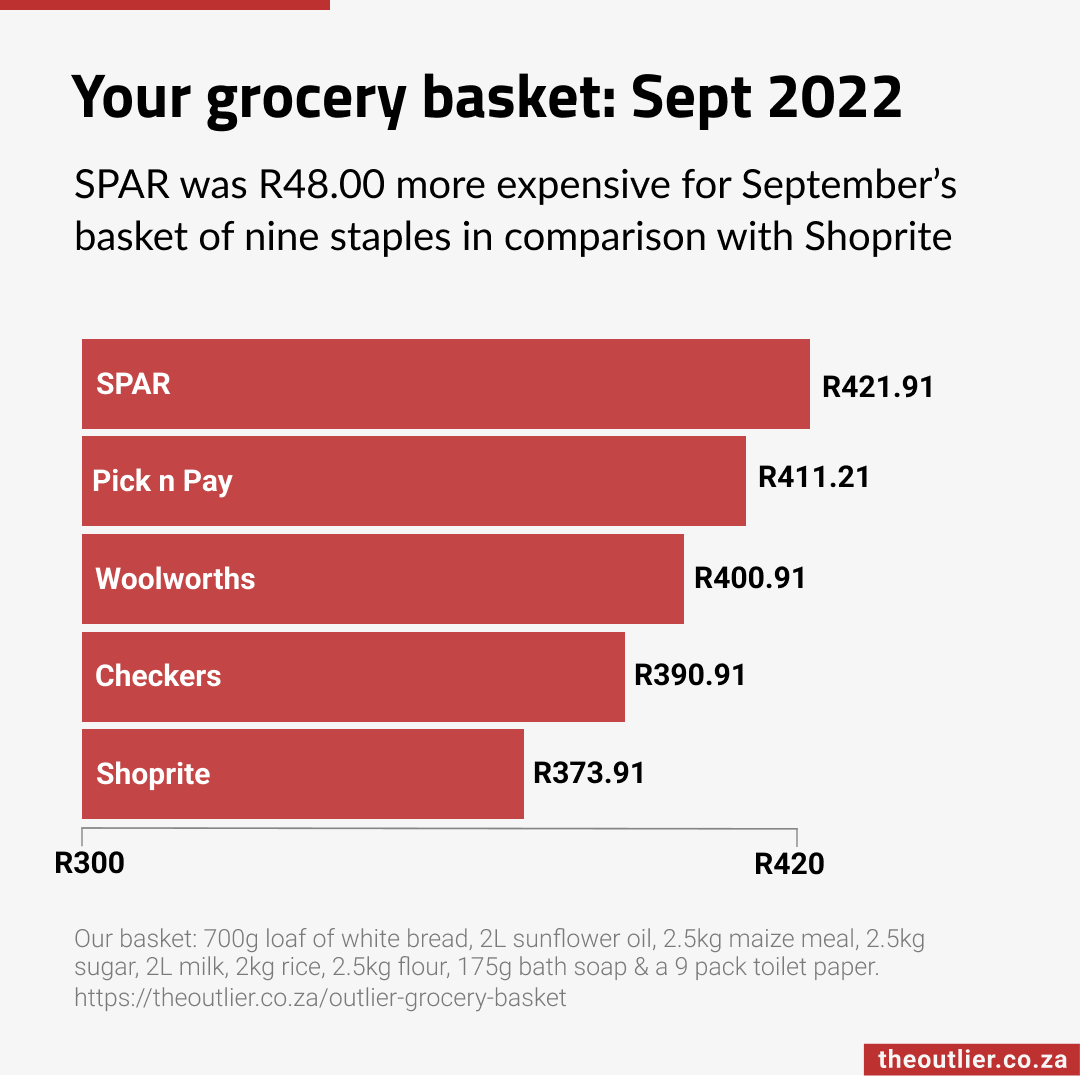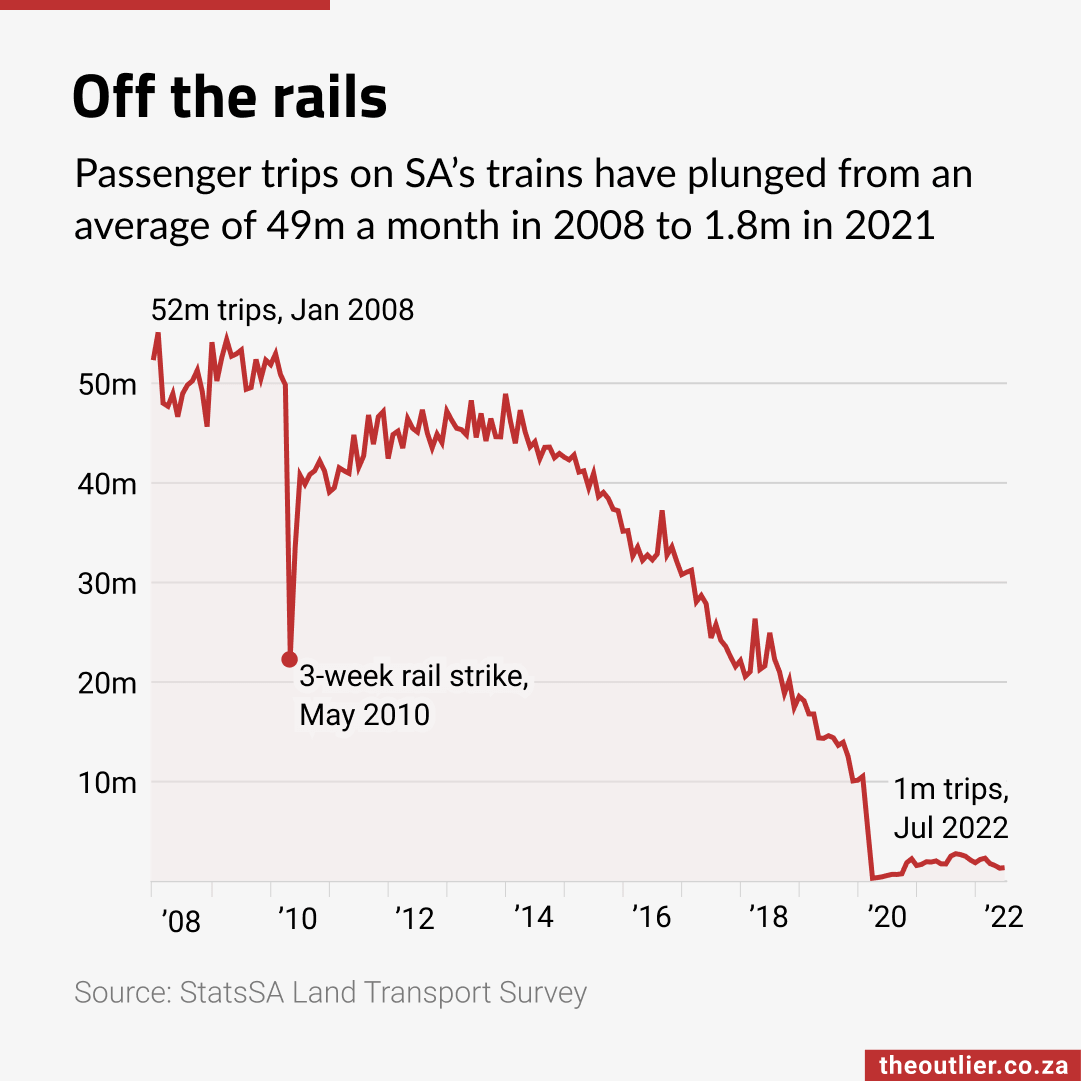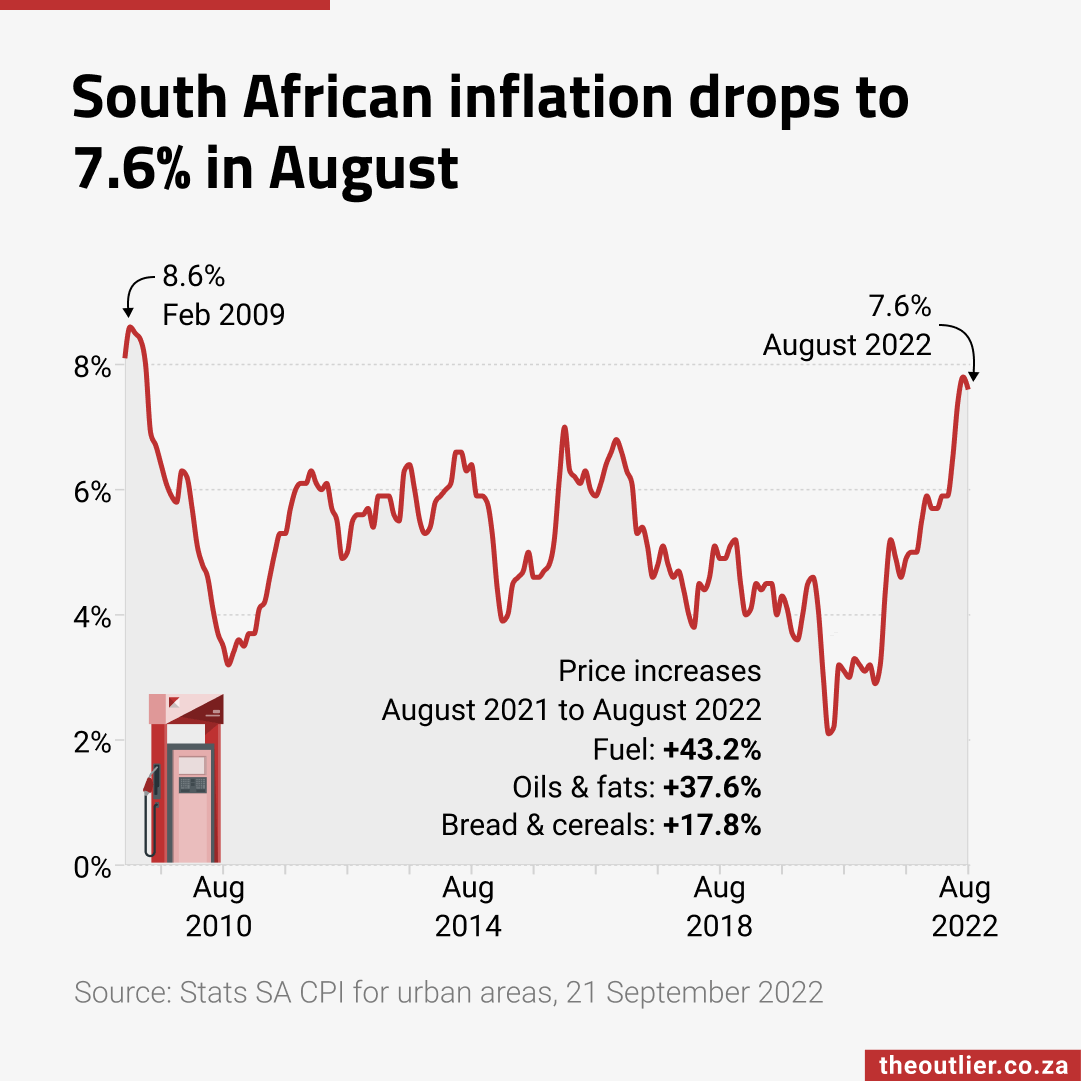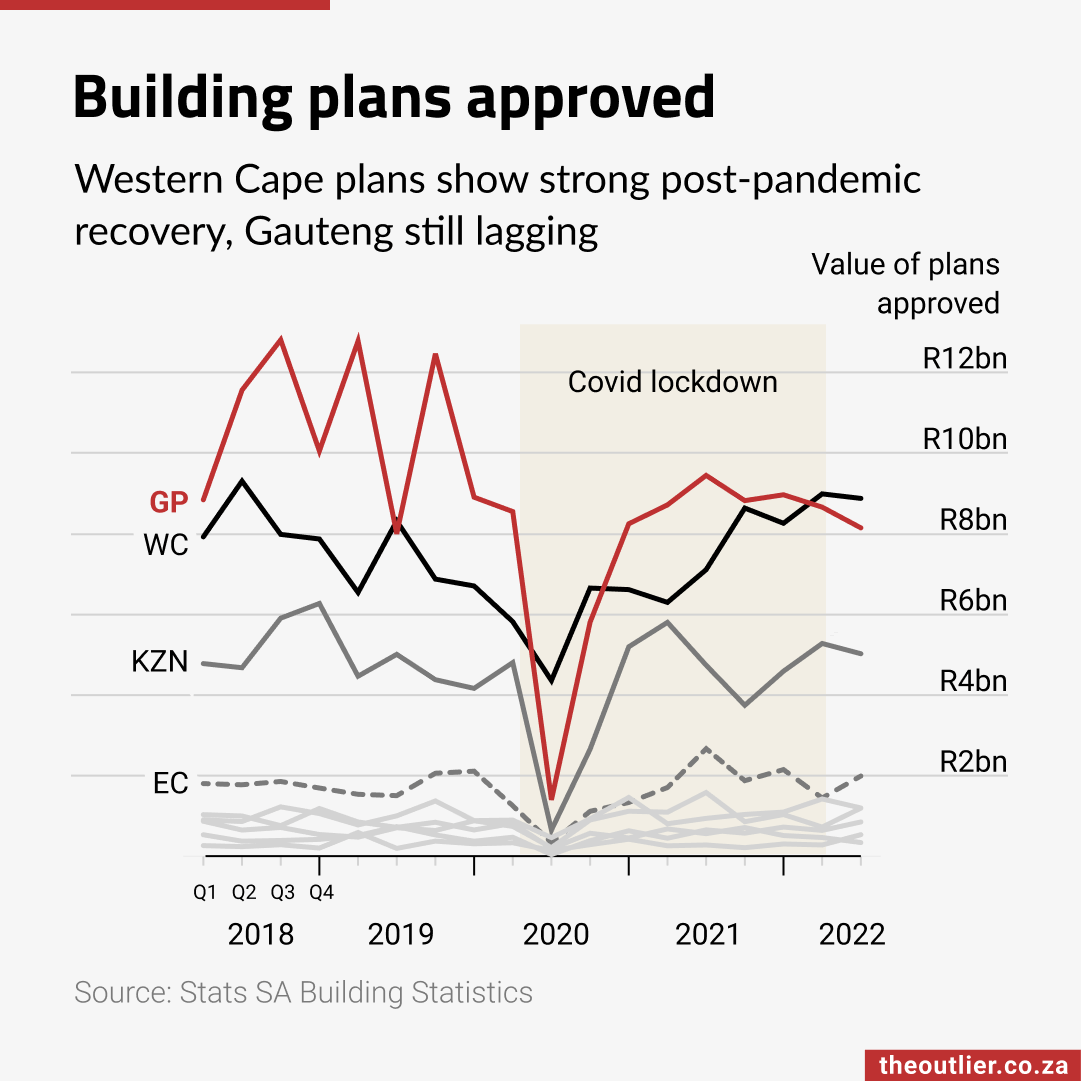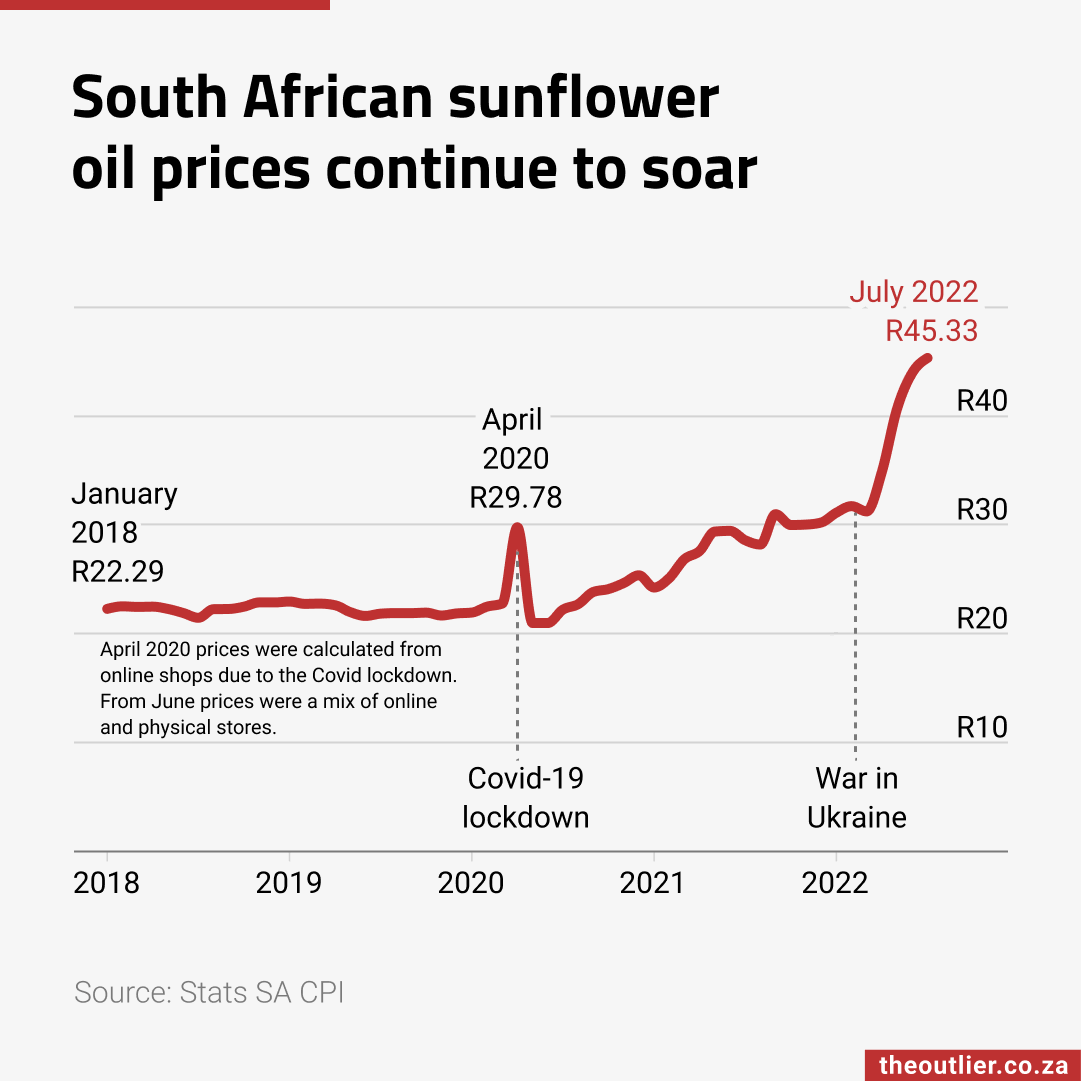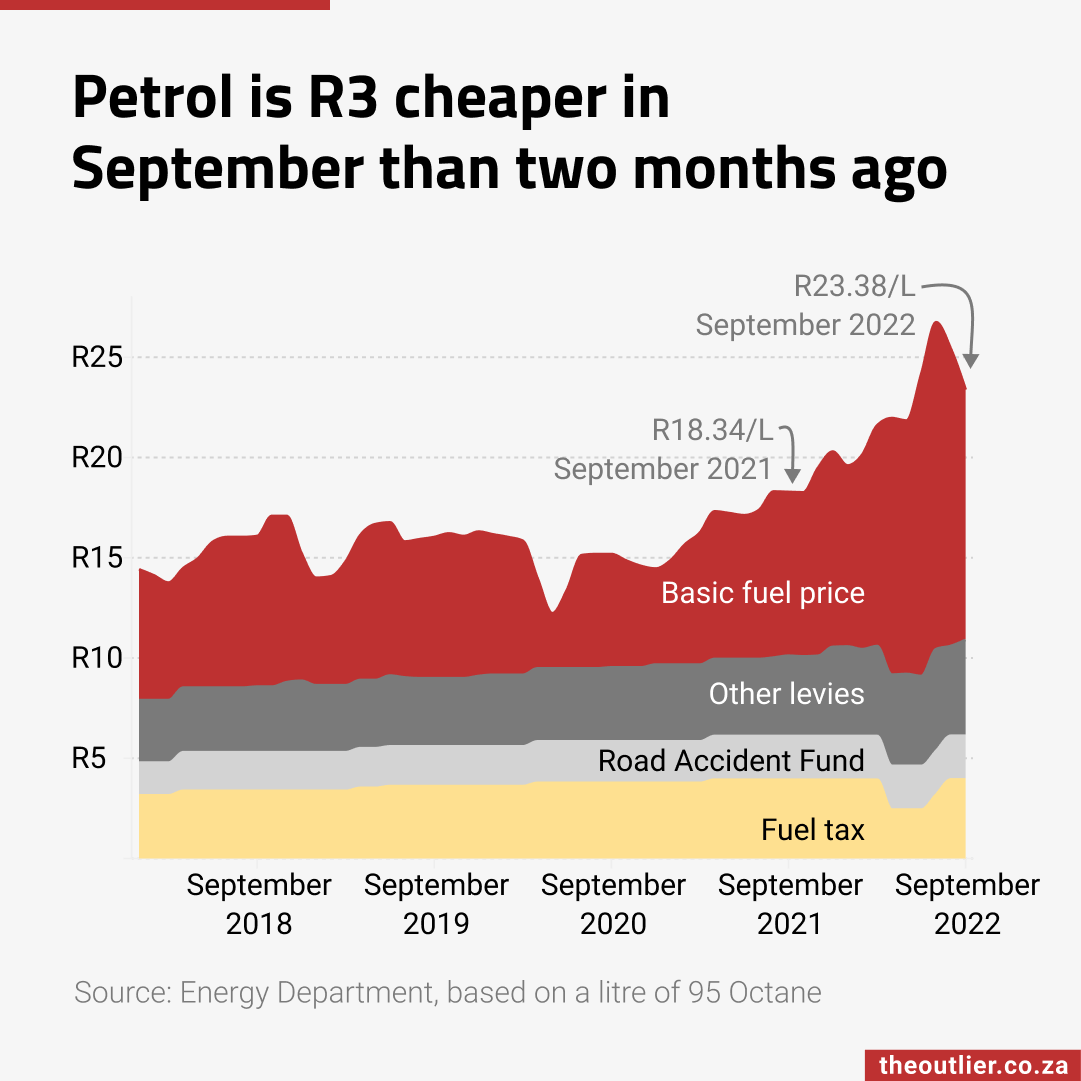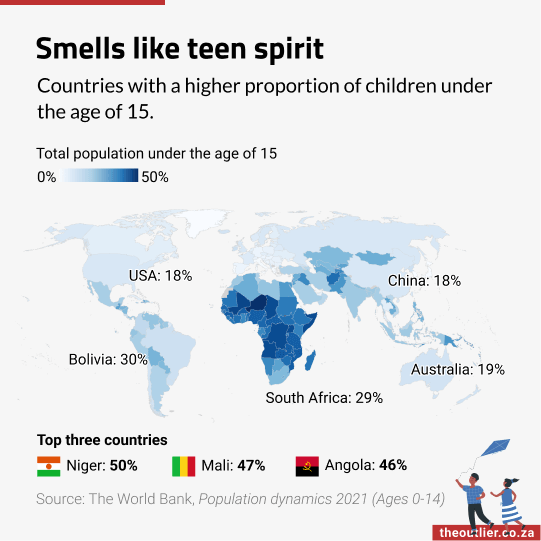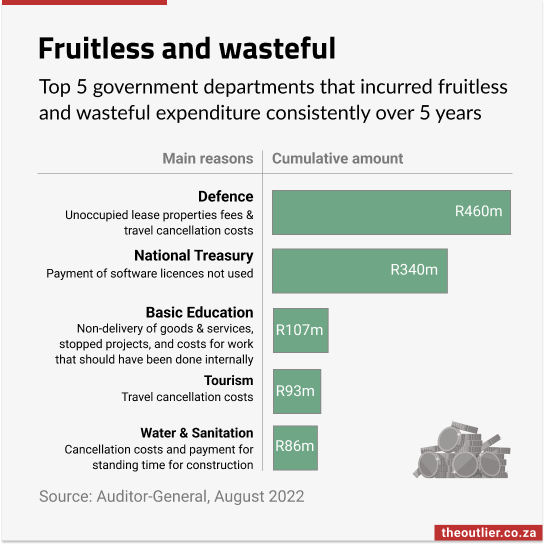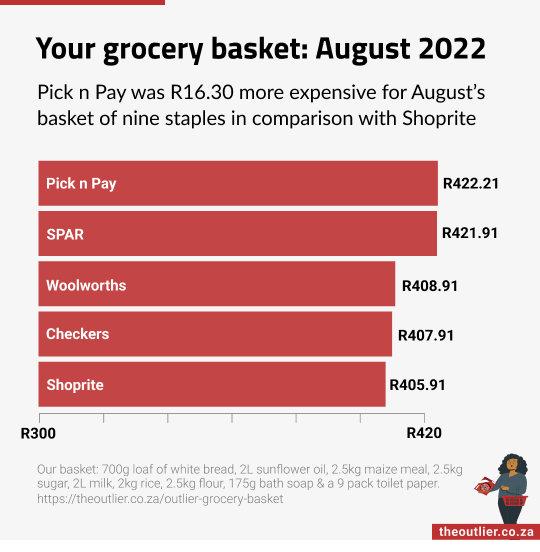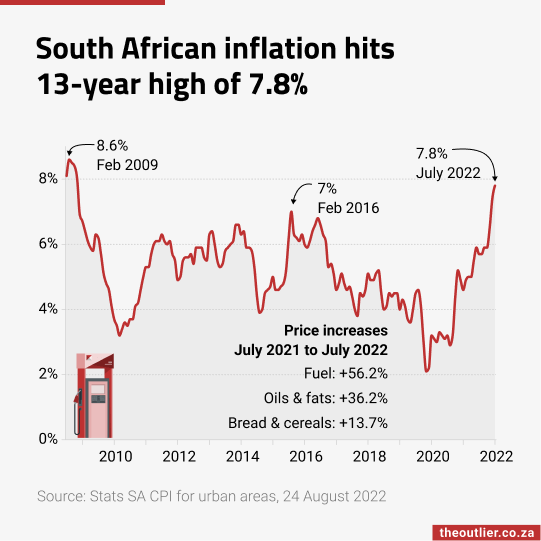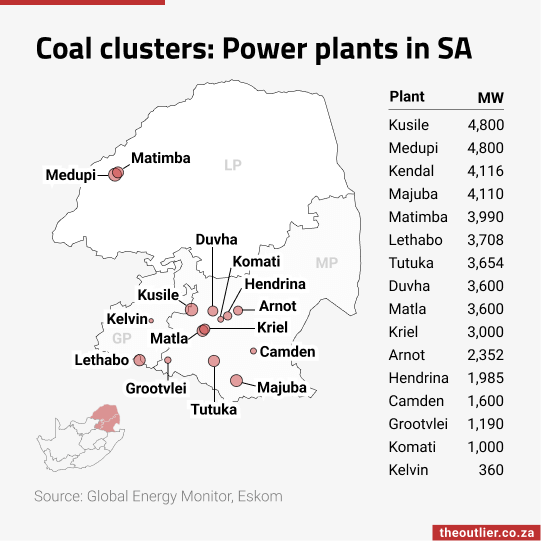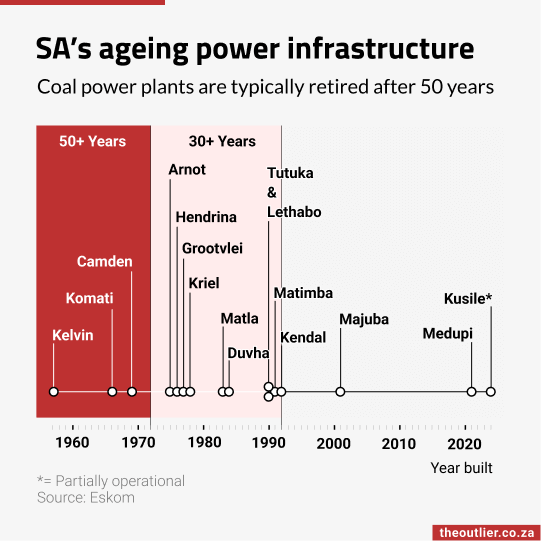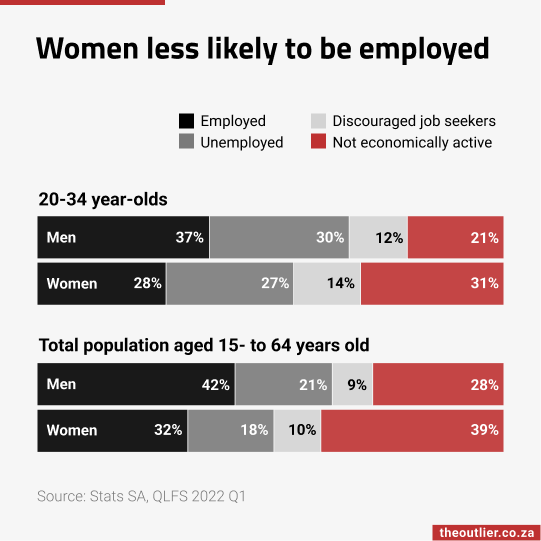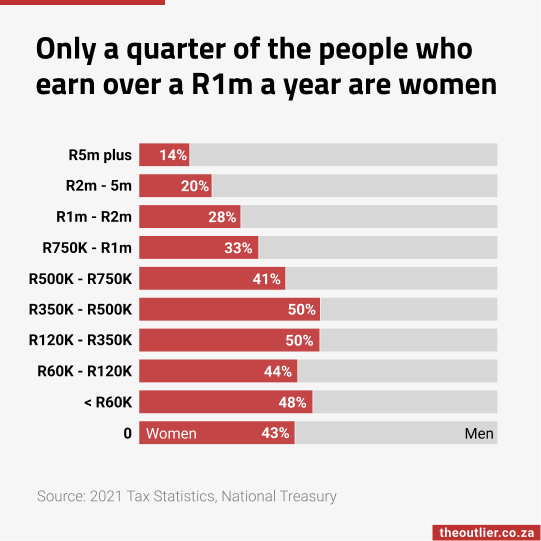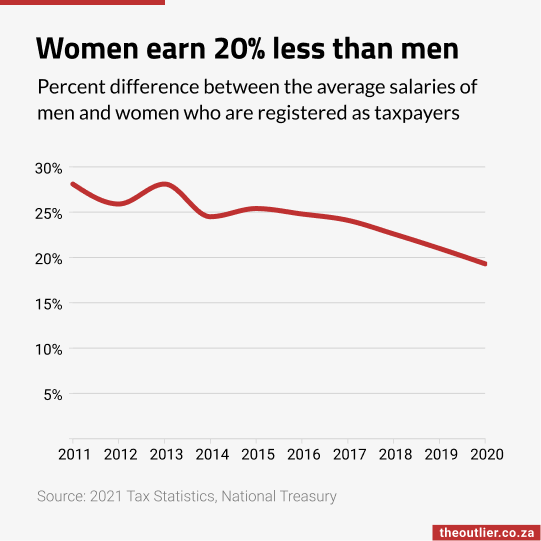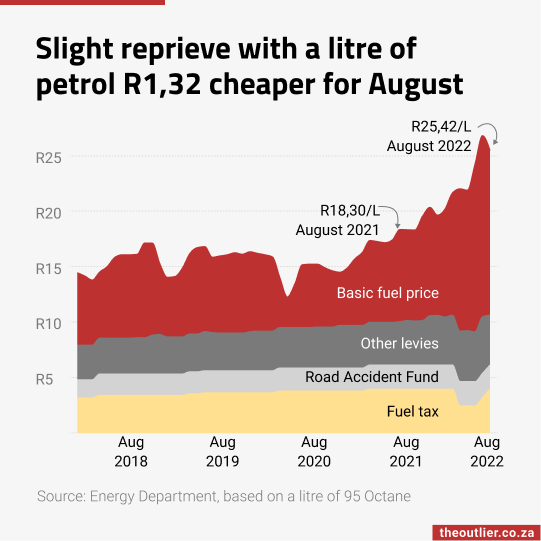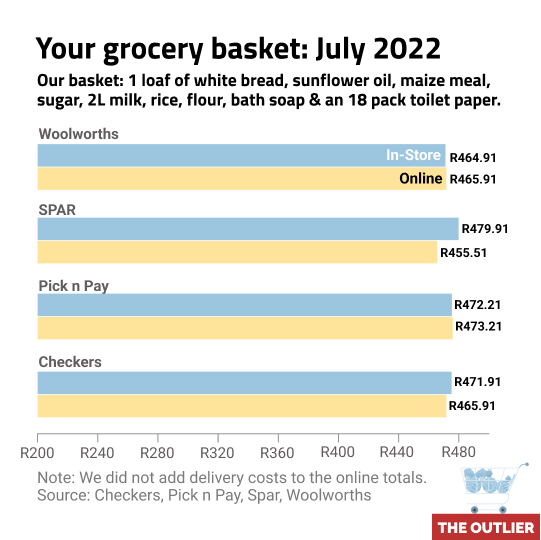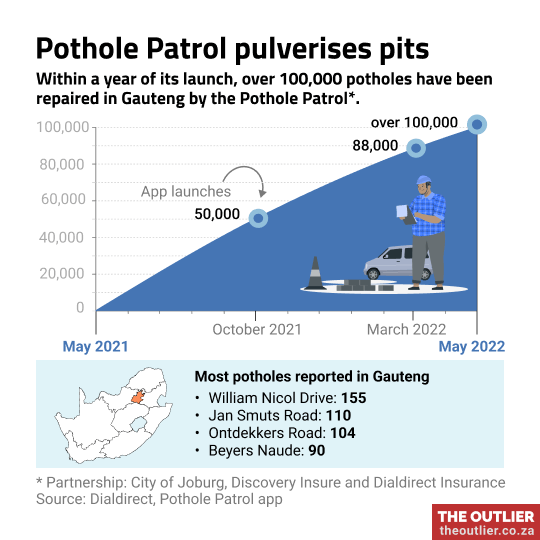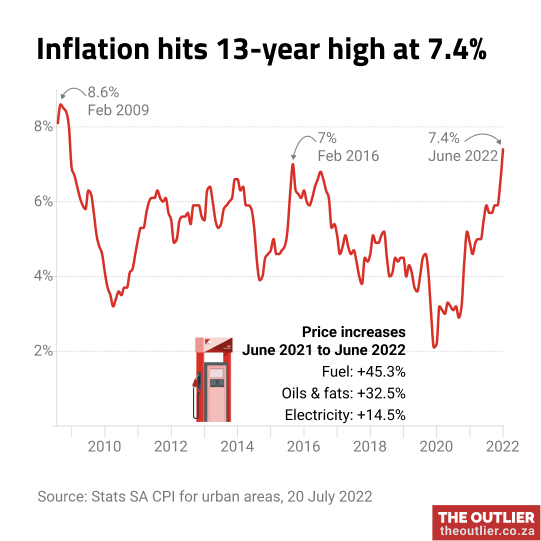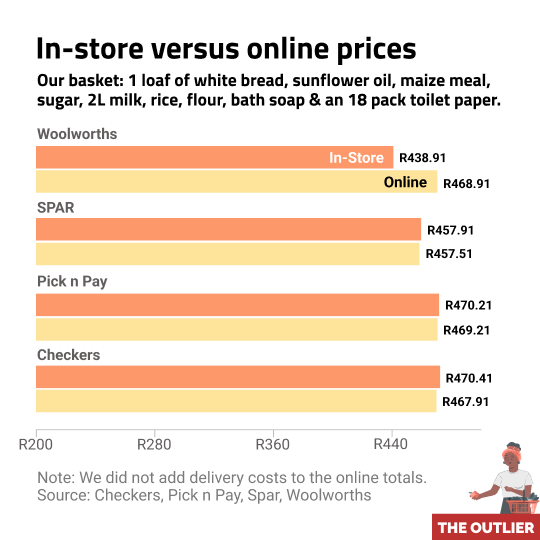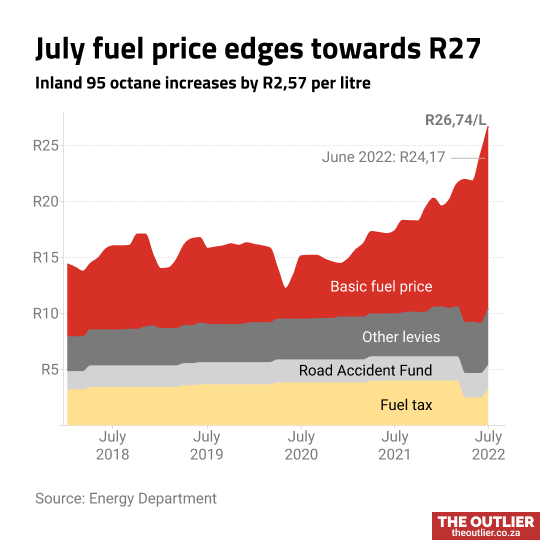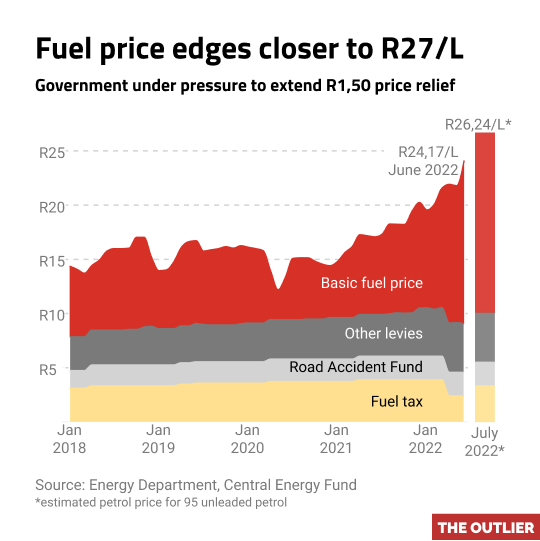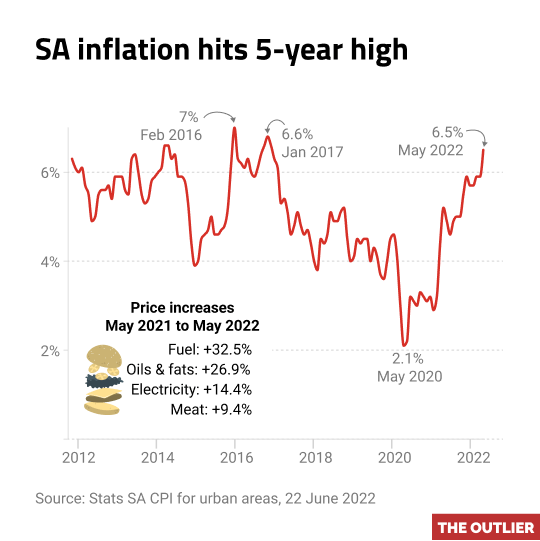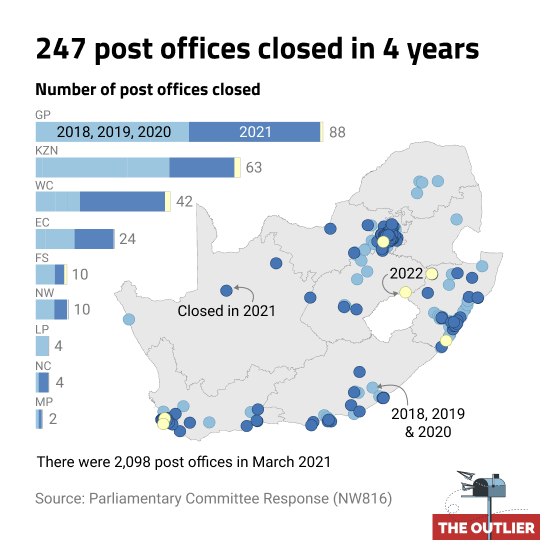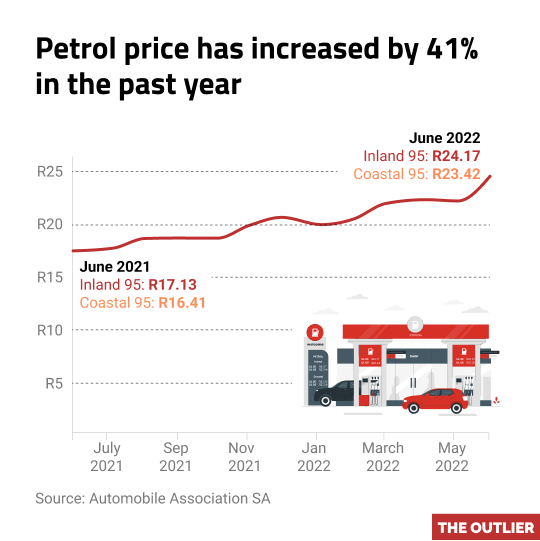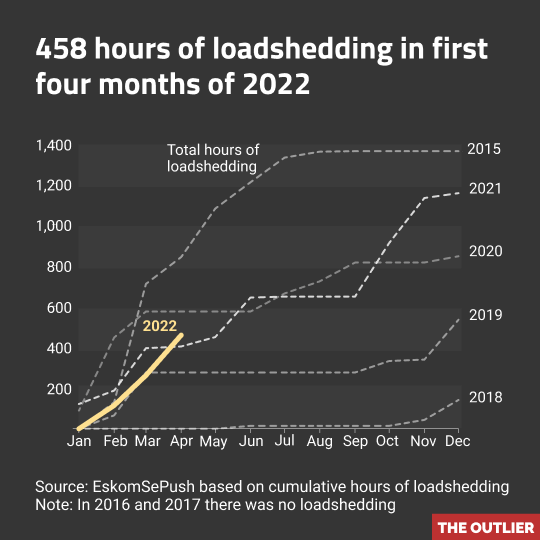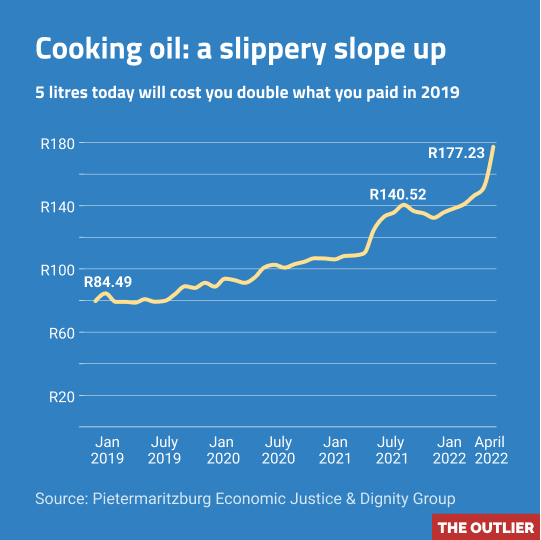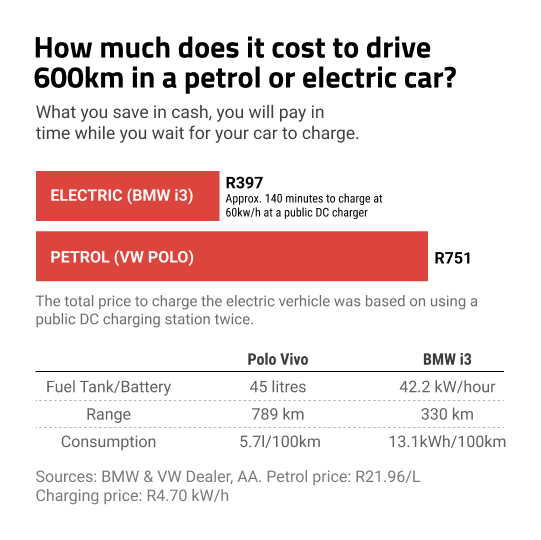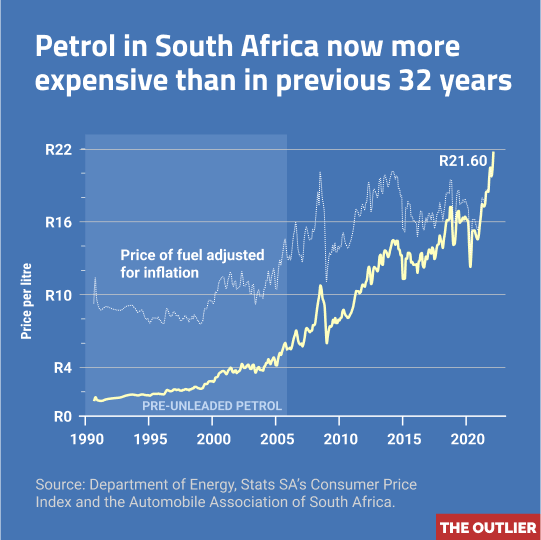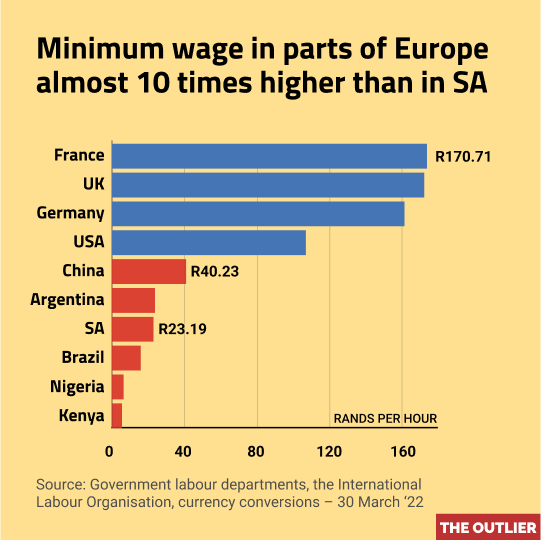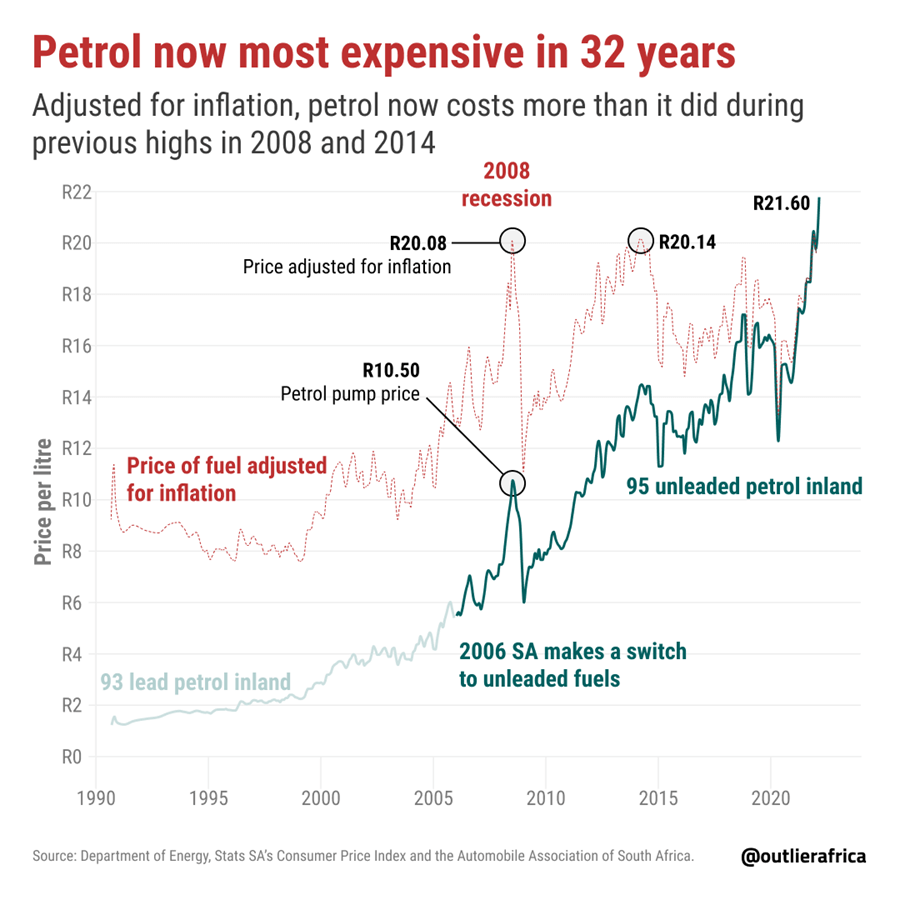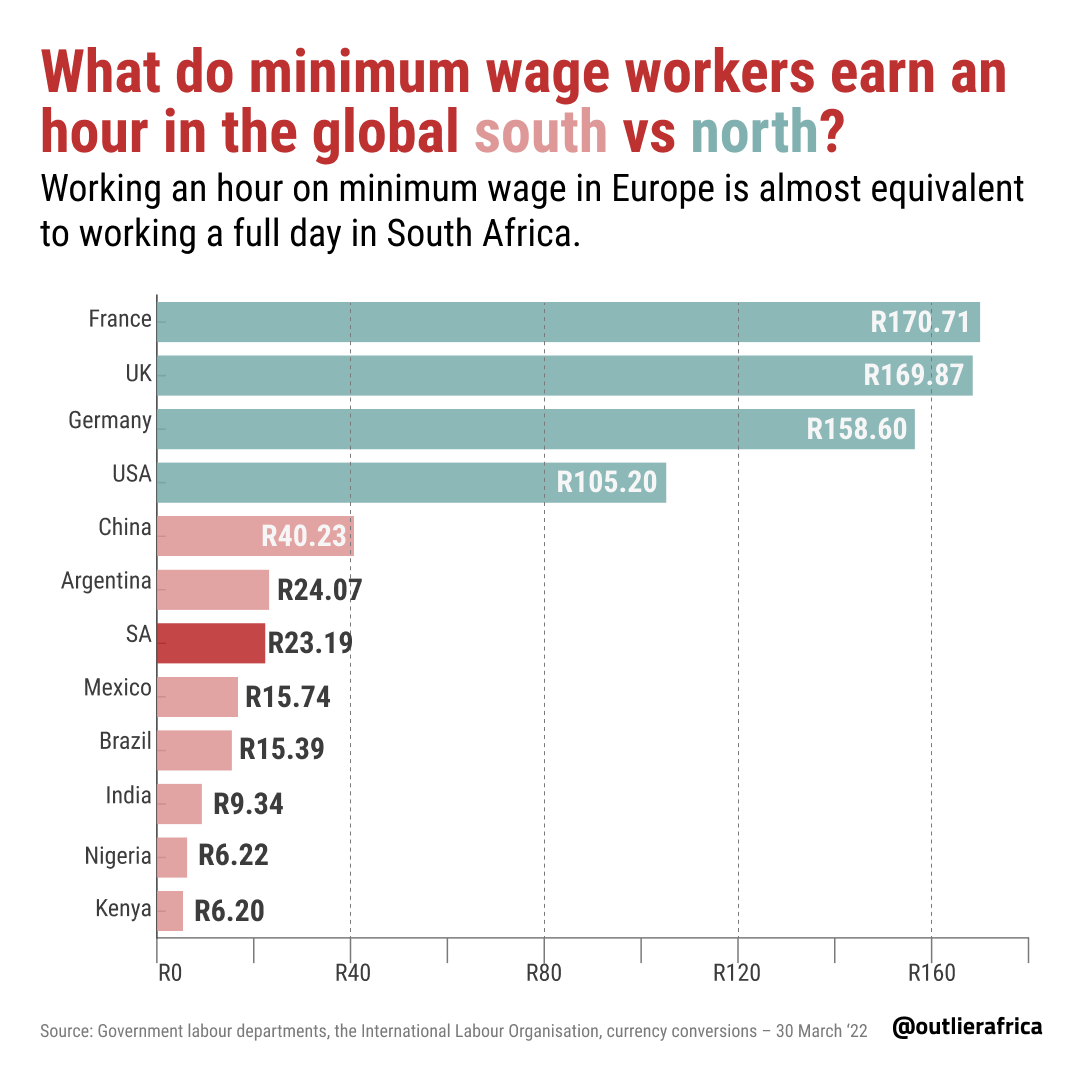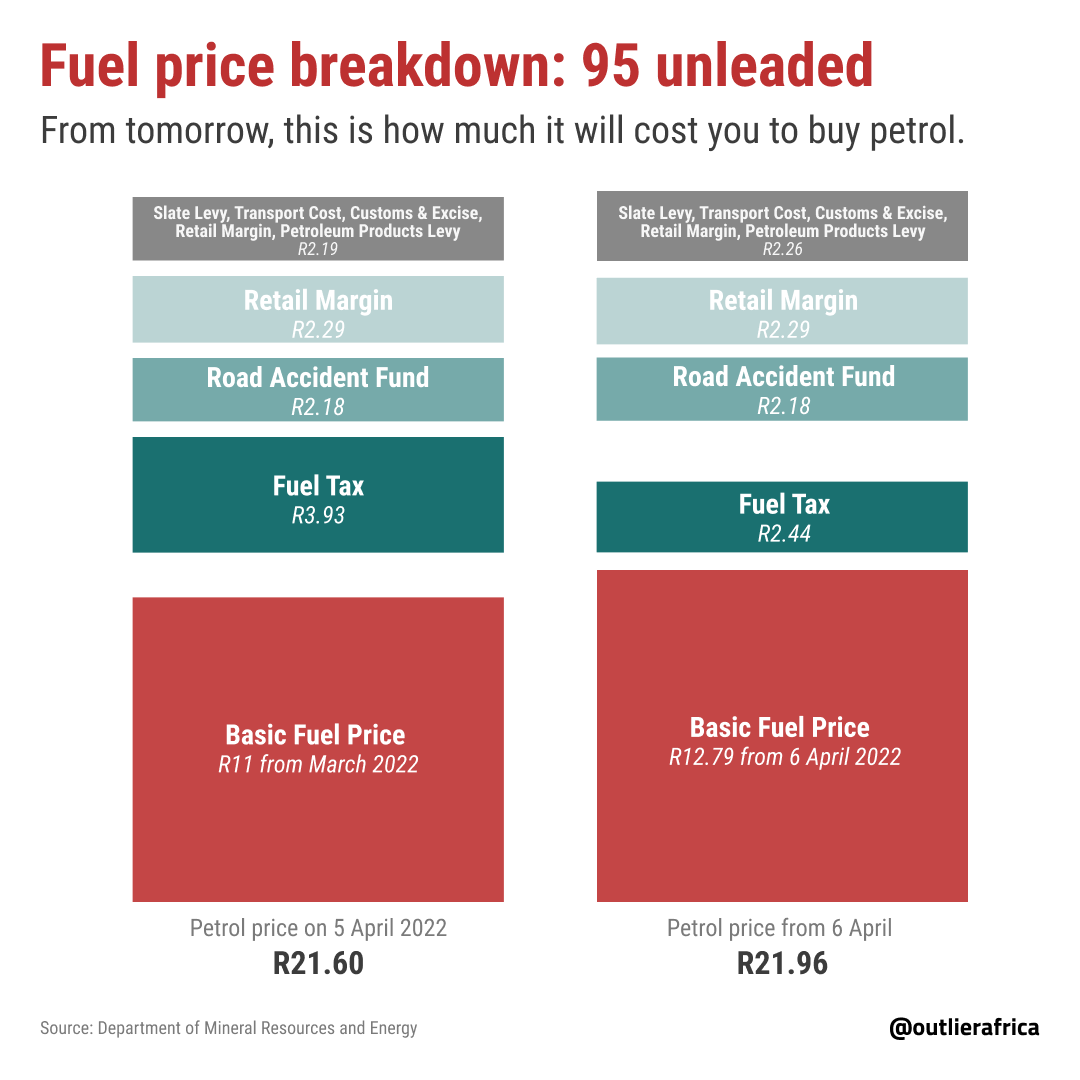
There were 3.6-million new entrants to the job market among the unemployed in Statistics South Africa’s Quarterly Labour Force Survey for April to June this year. These are people who have never worked before but are currently looking for jobs, most of them likely young and searching for their first opportunity.
As the population grows, more young people enter the labour market every year. But the share of new entrants among the unemployed has also risen, from 41% a decade ago to 43% today. That small percentage shift translates into a massive jump in numbers: from 1.9-million to 3.6-million. It’s a clear sign that South Africa is not creating enough entry-level jobs for people without work experience.
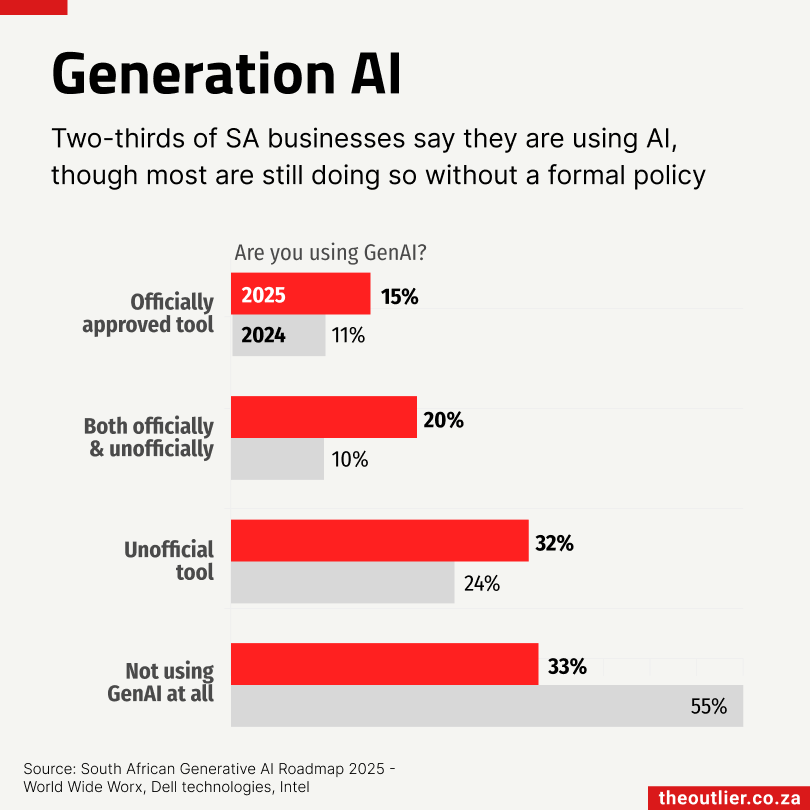
South African enterprises are integrating Generative AI (GenAI) into their operations fairly quickly, but most are doing so without formal strategies, says Arthur Goldstuck from World Wide Worx.
In the latest South African Generative AI Roadmap 2025, Goldstuck says that GenAI usage in large enterprises has increased from 45% in 2024 to 67% in 2025.
The GenAI report surveyed over 100 mid-sized and large enterprises across industry sectors.
From a benefit point of view, most users cited an increase in competitiveness (86%) as a reason for using AI, followed by improved productivity (83%) and enhanced customer service (66%).
But only 14% of the companies surveyed had a formal, company-wide GenAI strategy, according to the report.

In Africa, only one in five of the sources quoted in the news is a woman, according to the most recent Who Makes the News?, Global Media Monitoring Project, a study done every five years.
South African media is better at quoting women than those in Kenya and Nigeria, but still, 75% of those quoted are men.
Quote This Woman+ is working to change this.
QW+ connects journalists from around the world with African women experts. This August, they’re running an #EachOneReachOne campaign to add 100 new experts to their database, which already contains more than 700 woman+ experts in fields ranging from gender rights, politics, economics and crime to AI, tech, education and climate change.
Help them reach that goal by nominating yourself or a woman+ whose expertise you know deserves to be heard.

There are about 13-million vehicles on South Africa’s roads. Less than 1% of them are plug-in electric vehicles, said Hiten Parmar of non-profit Electric Mission in a webinar hosted by EE Publishers on 6 August 2025. That doesn’t sound particularly positive, but car sales data shows that South Africa is on the right track.
Sales of battery electric vehicles in South Africa have accelerated from just 160 in 2019 to 1,200 in 2024. Add plug-in hybrids, and the 2024 total approaches 2,000.
For South Africans, the cost of electric vehicles is a factor. That and anxiety about there being enough charging stations. Eighty to ninety percent of charging takes place at home, says Parmar. Plus, there are 385 charging stations in South Africa at present, according to Plugshare. So, that road trip from Jo’burg to Durban is doable; our highways are covered.

Last year, about one in every five cars sold globally was an electric vehicle. Norway leads the charge, with 92% of new cars sold being electric. China is close to 50%, while the United States sits at 10%. In South Africa, it’s just three in every 500, a small share, but the trend is heading in the right direction.
Sales of battery electric vehicles in South Africa have accelerated from just 160 in 2019 to 1,200 in 2024. Add plug-in hybrids, and the 2024 total approaches 2,000.
Two big hurdles remain: price and concerns about charging infrastructure. Most charging, 80% to 90%, happens at home, says Hiten Parmar of non-profit Electric Mission in a webinar hosted by EE Publishers on 6 August 2025. Still, there are now 385 charging stations in South Africa, according to Plugshare, making road trips from Jo’burg to Durban feasible.

South Africa failed to broker a last-minute deal to avoid the 30% trade tariff imposed by US President Donald Trump, which will come into effect on 7 August 2025. It is a development that has become a source of “great anxiety” for citrus growers in the Western and Northern Cape, according to the Citrus Growers’ Association of Southern Africa (CGA).
The two provinces export around 7-million 15kg cartons of citrus to the US each year. But rerouting that fruit is no simple task.
Diverting fruit to other markets could depress prices in those markets through oversupply, which would negatively impact the entire Southern African citrus industry, explained the CGA.
South Africa is the world’s second-largest exporter of citrus. In the 2024 season, more than 2-million tonnes of oranges, mandarins, grapefruits and lemons were shipped overseas. The two biggest markets are Europe (36%) and the Middle East (19%). North America, which includes the United States and Canada, takes 9% of the exports.
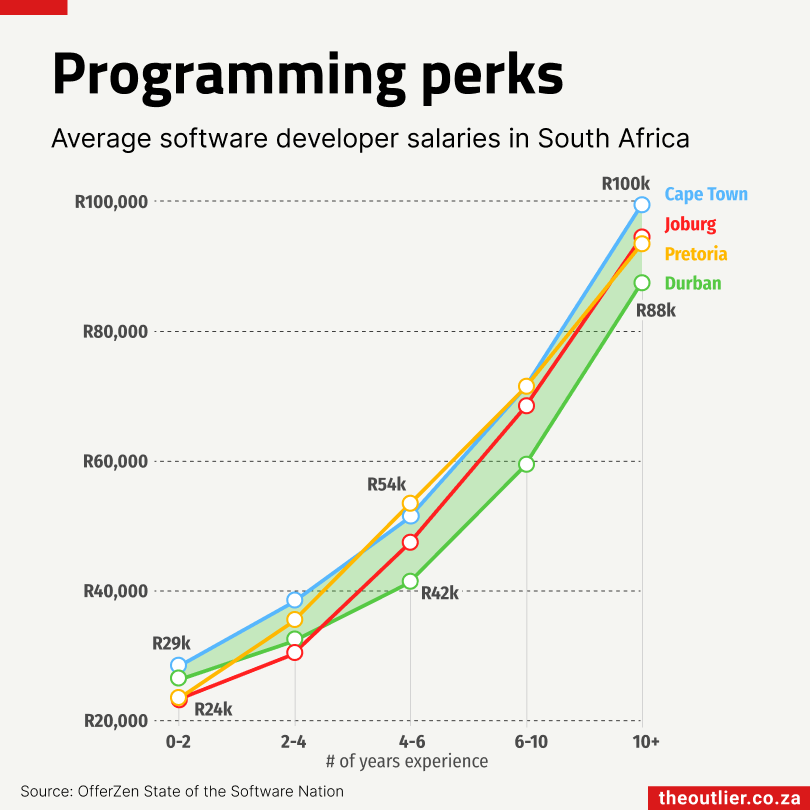
Cape Town developers continue to out-earn their peers in other parts of South Africa. According to the latest OfferZen State of the Software Nation report, experienced developers with more than ten years of experience in Cape Town earn about R100,000 per month. That’s roughly R12,000 more than their coastal counterparts in Durban, who earn around R88,000. In Johannesburg and Pretoria, senior developers earn similar amounts, R95,000 and R94,000, respectively.
Interestingly, Durban developers start strong, with entry-level salaries averaging R27,000 a month, only slightly behind Cape Town’s R29,000. But over time, Durban developers appear to fall behind their peers elsewhere in the country.
For mid-level developers (those with four to six years of experience), Pretoria offers the highest average salary at R54,000 per month, followed by Cape Town at R52,000 and Johannesburg at R48,000.

Beef mince is at its highest price in eight years, according to Statistics South Africa’s Consumer Price Index. It was R14/kg more expensive in June than it was at the beginning of the year.
The increase is largely due to a widespread outbreak of foot-and-mouth disease (FMD), a highly contagious virus that affects cattle, which has caused supply shortages. Infected cattle have been quarantined, and animal movement has been restricted until herds are vaccinated. There have been 270 reported outbreaks of the disease across five provinces.
South Africa currently relies on Botswana to supply its FMD vaccines. The Botswana Vaccine Institute is one of just five FMD vaccine producers in Africa.
At the Foot-and-Mouth Disease Indaba on 21 July 2025, Agriculture Minister John Steenhuisen admitted that South Africa had been unprepared. “The national FMD vaccine bank was depleted,” he said.
“Onderstepoort Biological Products [a state-owned vaccine manufacturer] currently lacks the infrastructure to produce FMD vaccines at the scale and speed required to respond to outbreaks,” said Steenhuisen.

US President Donald Trump’s 30% tariff on South African imports has dealt a blow to the African Growth and Opportunity Act (AGOA), which is set to expire in September 2025. AGOA allows eligible sub-Saharan African countries duty-free access to the US market for thousands of products, aiming to boost economic growth through exports.
In 2024, South Africa accounted for nearly half ($3.8-billion) of the $7.9-billion in US imports under AGOA. The country’s top export under the agreement is transport equipment. That year, South Africa exported 24,681 vehicles to the United States, according to the Automotive Business Council (Naamsa).
“The US tariffs directly threaten thousands of jobs in our sector, disrupt hard-won industrial capabilities, and risk devastating communities such as East London, where the auto sector forms the economic heartbeat of the town,” said Naamsa CEO Mikel Mabasa. “If we cannot retain export markets like the US, we risk turning vibrant industrial hubs into ghost towns.”
South Africa’s automotive industry supports over 110,000 formal sector jobs, according to Naamsa.
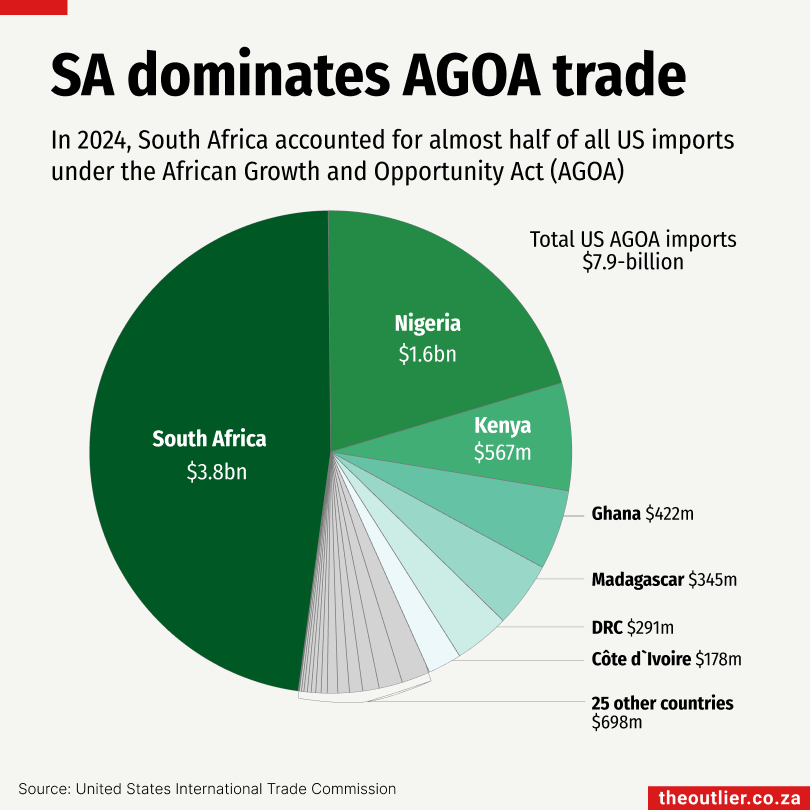
US President Donald Trump’s 30% tariff on South Africa has dealt a blow to the African Growth and Opportunity Act (AGOA), which is due to expire in September 2025. AGOA provides duty-free access to eligible sub-Saharan African countries for thousands of products, aimed at promoting economic growth through exports.
Thirty-two countries are eligible for AGOA.
In 2024, South Africa accounted for almost half ($3.8-billion) of the $7.9-billion in US imports under AGOA, followed by Nigeria ($1.6-billion) and Kenya ($567-million), according to US International Trade Commission data.
Nigeria mainly exports crude oil, while Kenya’s key exports are textiles.
Roughly 25% of South Africa’s total exports to the US fall under AGOA, according to a 2025 Parliamentary Budget Office report.
South Africa’s top AGOA export is transport equipment.
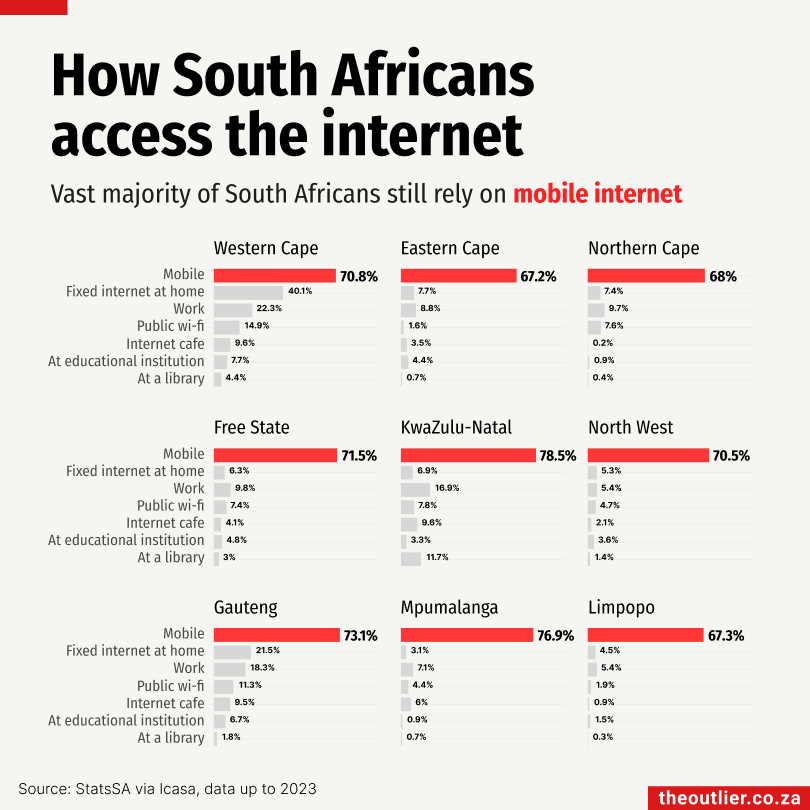
Nearly three-quarters of South Africans go online using a mobile device, with KwaZulu-Natal leading the provinces at 78.5%.
At the other end of the spectrum, just 67.2% of people in the Eastern Cape access the internet via mobile, the lowest rate in the country, reflecting possible challenges in infrastructure or service availability, according to Icasa’s March 2025 State of the ICT Sector in South Africa report.
Access to fixed home internet remains far more limited. Nationally, only 14.5% of South Africans have a home internet connection. The numbers are skewed by relatively high access in the Western Cape (40.1%) and Gauteng (21.5%), while most other provinces are below 10%. In Mpumalanga, just 3.1% of people have fixed home internet.
Beyond the home, South Africans also access the internet through a range of public and workplace options: 14% connect at work, 8% use public Wi-Fi, 6.9% visit internet cafés, 4.6% connect at educational institutions and 3.5% use library networks.

BRICS countries – Brazil, Russia, India, China and South Africa, and new members Egypt, Ethiopia, Indonesia, Iran and the United Arab Emirates – together accounted for half (51%) of global solar electricity generation in 2024, according to energy think tank Ember’s report “Solar BRICS: Emerging economies now lead the world’s clean energy race.”
China alone generated 39% of the world’s solar power in 2024, up from just 12% a decade earlier. South Africa contributed 0.9%.
Five BRICS countries featured among the world’s top 20 solar power producers. China led globally with 839 terawatt-hours (TWh), followed by the United States (303TWh) and India (137TWh). Brazil ranked sixth with 71TWh, and South Africa placed 16th with 20TWh. The United Arab Emirates, which joined BRICS in 2024, was 20th.
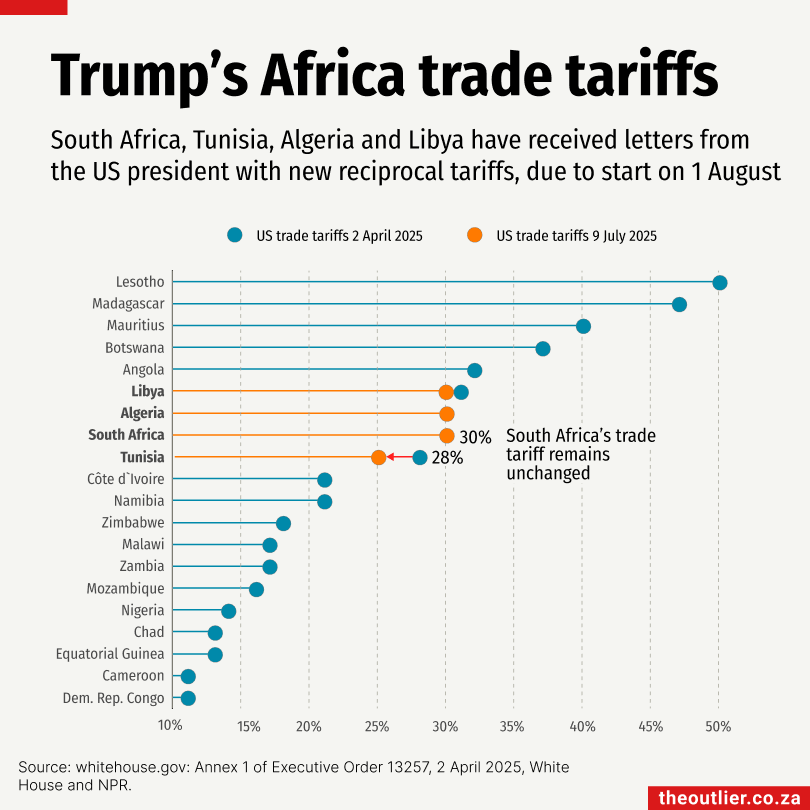
United States President Donald Trump’s reciprocal trade tariffs, first announced on 2 April, were set to take effect on 9 July. However, he extended the 90-day moratorium to 1 August and sent letters to more than 20 countries informing them that their tariffs had been revised. South Africa, Tunisia, Algeria and Libya were the only African countries to receive letters so far.
South Africa and Algeria’s tariffs remain unchanged at 30%. Tunisia’s was slightly reduced from 28% to 25%. Libya’s was marginally reduced from 31% to 30%.
A fact sheet on the White House website, which claims President Trump is “the best trade negotiator in history”, hints at a willingness to pursue further trade talks.
President Cyril Ramaphosa said South Africa would continue its “diplomatic efforts towards a more balanced and mutually beneficial trade relationship”.
South Africa’s platinum, gold, coal, manganese and chrome are among the products that have been excluded from the US tariffs.

Foreign direct investment (FDI) in Africa jumped by a record 75% in 2024, according to UNCTAD’s World Investment Report 2025.
The increase was driven by a $35-billion megaproject backed by the United Arab Emirates, which aims to transform a stretch of the country’s Mediterranean coastline into a major tourism, residential, business and financial hub. The size of the investment made Egypt the top African recipient of foreign direct investment and the ninth-largest globally.
Meanwhile, South Africa, which typically vies with Egypt for the top spot for foreign direct investment, fell to seventh place, behind Ethiopia, Côte d’Ivoire, Mozambique, Uganda and the Democratic Republic of Congo.
South Africa’s strong showing in 2021 was largely due to a one-off share exchange between Prosus NV and Naspers, which inflated its foreign investment figures.
Angola’s FDI has been in negative territory for the past few years due to the repatriation of investments by foreign companies, especially in the oil sector.

Only 32 countries in the world host AI-focused data centres and fewer than 20% of those are in the Southern Hemisphere. The vast majority of data centres are clustered around Europe and the UK, in the United States and China. 90% of the world’s AI data centres are controlled by either the US or China.
A new study from Oxford University has sparked much-needed debates about the future of AI, and who ultimately controls it and who has access to it. The entire continent of Africa, apart from South Africa, and most of South America has none of the infrastructure required to build, train and run AI models.
As University of Pretoria’s ABSA Chair of Data Science Vukosi Marivate says: “This divide isn’t just about technology. It means limited innovation, lost competitiveness, brain drain, lack of data sovereignty, and the economic benefits of AI flowing elsewhere. Access to compute is no longer optional – it’s essential for digital sovereignty and for shaping our own AI future.”

South Africa imports most of its petroleum and crude oil from Nigeria and Saudi Arabia. In 2023, it imported $2.28-billion (46.1%) from Nigeria and $1.62-billion (32.7%) from Saudi Arabia, according to Harvard’s Atlas of Economic Complexity.
In June 2025, Saudi Arabia was exporting 7.2-million barrels of oil per day through the Strait of Hormuz. It is one of six major oil producers – alongside Iran, Iraq, Kuwait, Qatar and Oman – that rely on Hormuz to ship oil, much of it destined for Asian markets.
The Strait of Hormuz is the world’s second-busiest oil transit chokepoint after the Strait of Malacca. In 2023, 20.9-million barrels of crude oil and petroleum products passed through Hormuz each day, compared to 23.7-million through Malacca.
Any blockade or disruption in the strait would likely push up global oil prices – and South Africans would feel it at the pump. Higher fuel costs would ripple through the economy, raising the transport prices, food, and other essentials.

Iran is one of the world’s top crude oil producers, averaging 5.1-million barrels per day in 2024. When Israel launched its war with Iran, oil prices spiked amid fears of supply disruptions.
Part of that anxiety stems from geography: Iran borders the Strait of Hormuz, a critical maritime chokepoint through which a fifth of the world’s oil supply passes en route from the Persian Gulf to the Gulf of Oman.
Six of the world’s biggest oil producers – Saudi Arabia, Iran, Iraq, Kuwait, Qatar and Oman – rely on Hormuz to export their oil, most of it bound for Asian markets.
Tensions escalated further when the United States bombed Iran’s nuclear facilities on 22 June 2025. Fears mounted that Iran would retaliate by blocking the strait.
The Strait of Hormuz is the second-busiest oil transit route in the world, after the Strait of Malacca. In 2023, 20.9-million barrels of crude oil and petroleum products moved through Hormuz daily, compared to 23.7-million through Malacca.

Iran is one of the world’s top crude oil producers, averaging 5.1-million barrels per day in 2024. When Israel launched its war with Iran, oil prices spiked amid fears of supply disruptions.
Part of that anxiety stems from geography: Iran borders the Strait of Hormuz, a critical maritime chokepoint through which a fifth of the world’s oil supply passes en route from the Persian Gulf to the Gulf of Oman.
Six of the world’s biggest oil producers – Saudi Arabia, Iran, Iraq, Kuwait, Qatar and Oman – rely on Hormuz to export their oil, most of it bound for Asian markets.
Tensions escalated further when the United States bombed Iran’s nuclear facilities on 22 June 2025. Fears mounted that Iran would retaliate by blocking the strait.
The Strait of Hormuz is the second-busiest oil transit route in the world, after the Strait of Malacca. In 2023, 20.9-million barrels of crude oil and petroleum products moved through Hormuz daily, compared to 23.7-million through Malacca.

State salaries are under fresh scrutiny as budget pressures mount and government debt soars – but the pay at state-owned enterprises is particularly staggering. The Development Bank of South Africa CEO tops the list, earning R15.5-million a year, nearly R1.3-million a month. The next highest earners are Transnet’s CEO at R8.5-million a year, closely followed by South African Revenue Services’ CEO at R8.2-million.
We’ve compiled the remuneration packages of the 122 state-owned enterprises CEOs using responses from 18 government ministers to parliamentary questions. The electricity and energy minister’s response was incomplete due to a broken link, so Eskom’s financials were used to estimate its CEO’s pay.
The top 15 earners all take home R6-million a year or more – not including performance bonuses. None of the 122 CEOs earns less than R1-million a year.

It won’t come as a surprise that the five richest people in the world are tech billionaires based in the United States, according to Bloomberg’s Billionaires Index.
At number one – as of the close of business on 5 June 2025 – is Elon Musk (yes, born in South Africa, but now an American citizen), with a net worth of $368-billion. To put that in perspective, only two African countries have economies larger than Musk’s fortune – South Africa, with a GDP of $400-billion, and Egypt, at $383-billion.
The graphic above compares the net worth of the world’s top five richest men to the GDPs of Africa’s five largest economies, based on the IMF’s World Economic Outlook (April 2025).
Altogether, the combined net worth of the top 10 on Bloomberg’s latest billionaires index stands at $1.97-trillion – exceeding the entire GDP of Sub-Saharan Africa, which the IMF estimates at $1.88-trillion for 2024.

The number of people using South Africa’s trains is slowly recovering, driven by improvements in the commuter rail service network.
In March 2024, Statistics South Africa recorded 4.7-million train journeys. A year later, that figure had risen to 7.4-million. But this is still nowhere near the highs of 2009, when there was an average of 52-million journeys per month.
Over the past year, the Passenger Rail Agency of South Africa (PRASA) has significantly expanded the number of operational lines. By March 2025, 34 of PRASA’s 40 commuter service lines were running – up dramatically from just four in the aftermath of the Covid-19 pandemic.
Train services ground to a halt in late March 2020 during the country’s initial hard lockdown. Although operations resumed as restrictions eased, the recovery was hampered by widespread vandalism and theft at rail stations and along the tracks. The revival of the rail network is a critical step in restoring affordable public transport.

In 2024, over 695,000 Schengen visa applications from across Africa were denied, resulting in more than $70-million lost in non-refundable fees. West Africans bore the brunt of these visa rejections.
A Schengen visa, which allows short stays in 29 European countries, costs €90 (about R1,800) per application and is non-refundable, even if the visa is denied.
Nigeria was hit the hardest, with 45.3% of its 111,201 applications rejected. Only 58,808 were approved – meaning Nigerians lost over $5-million in fees for unsuccessful applications.
Other West African countries followed closely:
– Senegal: $3.3-million lost
– Côte d’Ivoire: $2.6-million
– Ghana: $2.5-million
In East Africa, 28.5% of Kenyan applications were rejected, resulting in $1.9-million in lost fees.
South Africans fared far better, with just 5.6% of 193,768 applications rejected. Still, that relatively low rate translated into more than $1-million in lost fees.

Africans lost over $70-million in rejected Schengen visa fees in 2024. Nigerians were hit hardest, with 45.3% of applications denied, followed closely by Ghanaian applicants at 44.5%.
A Schengen visa, which allows short stays in 29 European countries, costs €90 (around R1,800) and is non-refundable.
Data from the European Commission shows that there were 111,201 applications by Nigerians for Schengen visas in 2024, and only 58,808 of those were granted. That means that over $5-million was spent (and lost) by Nigerians whose visa applications were turned down.
South Africans fared much better, only 5.6% of the 193,768 applications were rejected. Still, that translates to over $1-million (or R19.7-million) in lost fees. People travelling from the United States and China had 4% and 4.5% of their Schengen visas rejected.
The average rejection rate for Schengen visas for all countries is 16.9% while the rejection rate for African applications is 27%.

Mozambique is South Africa’s largest African trade partner, with exports reaching nearly R120-billion in 2024. According to the South African Revenue Service, it ranks among the top five destinations for South African exports. Key goods include chromium ore (26%), ferroalloys (17%), iron ore (8.5%), coal (7%), electrical energy (5%), and cleaning products (2%), along with motor vehicles, corn, cereals, and soya beans.
Trade with Mozambique has grown significantly over the past 14 years, rising from just R13.8-billion in 2010 to nearly R120-billion in 2024. While Mozambique leads among African trade partners, it still lags behind global export destinations such as China (R220-billion), the United States (R157-billion) and Germany (R154-billion).
South Africa’s other major African trade partners are, unsurprisingly, its immediate neighbours: Botswana (R78.9-billion), Namibia (R70.4-billion), Zimbabwe (R69.2-billion), and Zambia (R55.6-billion).
On the import side, Nigeria is South Africa’s largest African source, with imports totalling R46.7-billion in 2024 – comprising almost exclusively crude petroleum, according to the Observatory of Economic Complexity.

The petrol levy is now R4.01 per litre, its first increase since 2021/22, when it rose from R3.70 to R3.85. The fuel levy had remained unchanged for three years after it was last raised from R3.70 to R3.85 in the 2021/22 financial year. According to the May 2025 Treasury Budget Overview, the freeze was intended “to provide consumers with relief from high fuel price inflation.”
The latest hike – 16c for petrol and 15c for diesel – may seem minor to some, but it hits poorer communities hardest.
When fuel prices rise, so do transport costs. According to the Pietermaritzburg Economic Justice & Dignity Group, a person earning minimum wage and taking two taxis to and from work can spend more than a third of their monthly income on transport.
Higher fuel costs also push up the price of goods and services across the economy, meaning the impact goes far beyond the pump.
The only silver lining? Despite the levy and carbon tax increases, June’s petrol price decreased – thanks to a lower basic fuel price.

The fuel levy hike is expected to bring in R23-billion by 2028, following increases of 16c for petrol and 15c for diesel. This comes after Treasury opted not to raise value-added tax to 15.5%. In his May 2025 budget speech, Finance Minister Enoch Godongwana said the levy hike was the only new tax proposal being introduced.
The fuel levy had remained unchanged since the 2021/22 financial year when it rose from R3.70 to R3.85. Treasury said the pause was intended to ease pressure from high fuel price inflation.
But the latest increase hits low-income South Africans hardest. Rising fuel prices drive up transport costs – a major expense for the working class. According to the Pietermaritzburg Economic Justice & Dignity Group, someone earning minimum wage and taking two taxis to and from work can spend more than a third of their income on transport alone.

South Africa’s consumer price index (CPI) rose slightly from 2.7% in March to 2.8% in April 2025. The main contributors to the uptick were housing and utilities, food, beverages, tobacco, and restaurant and accommodation services.
The rise in food prices was “mainly due to higher meat prices, particularly for beef products such as stewing beef, mince, and steak,” according to Statistics South Africa.
Over the past year, the prices of several everyday items have increased significantly. A kilogram of apples is up 22.4%, rising from R22.46 in April 2024 to R27.48 in April 2025. Instant coffee increased by almost 18%, from R61.99 for 250g to R73.09. Other hot beverages also saw price hikes: Ceylon tea rose by 13.6%, while rooibos tea was up 6.9%.
Not all prices rose, however. A six-pack of eggs, for example, is now 5.3% cheaper than a year ago, down from R25.25 to R23.92.

The United States is South Africa’s second-largest export market, after China. In 2024, South Africa exported goods worth R157-billion to the US, compared to R220-billion to China. Germany, the third-largest export destination (R154-billion), is steadily closing the gap with the US.
In 2021, South Africa exported a record R193-billion in goods to the US, driven by a surge in platinum group metal prices. Nearly half of South Africa’s exports to the US are precious metals and stones. South Africa’s trade delegation is lobbying the US for more favourable terms ahead of a July deadline when a 90-day freeze on the proposed 31% tariff is set to expire. However, according to Minister of Trade, Industry and Competition Parks Tau, some critical minerals have been exempted from tariffs. The existing 10% tariff applies to vehicles, machinery, and agricultural products.

Precious metals and stones are South Africa’s largest exports to the US, making up nearly half of total exports. Notably, platinum group metals – platinum, palladium, rhodium, ruthenium, iridium, and osmium – account for 25% of exports. In the chart above, these are broken down into smaller subcategories. Vehicles make up 13% of exports, with petrol and diesel cars contributing 10%. Base metals follow at 12%, then chemicals (7%), agriculture (6%), and machinery (3%). Among agricultural exports, citrus fruits are the biggest agricultural exports to the US.
South Africa’s trade delegation is lobbying the US for more favourable terms ahead of a July deadline when a 90-day freeze on the proposed 31% tariff is set to expire. However, according to Minister of Trade, Industry and Competition Parks Tau, some critical minerals have been exempted from these tariffs. The existing 10% tariff applies to vehicles, machinery, and agricultural products.
The data used in this chart can be downloaded from Atlas of Economic Complexity, Harvard Growth Lab.
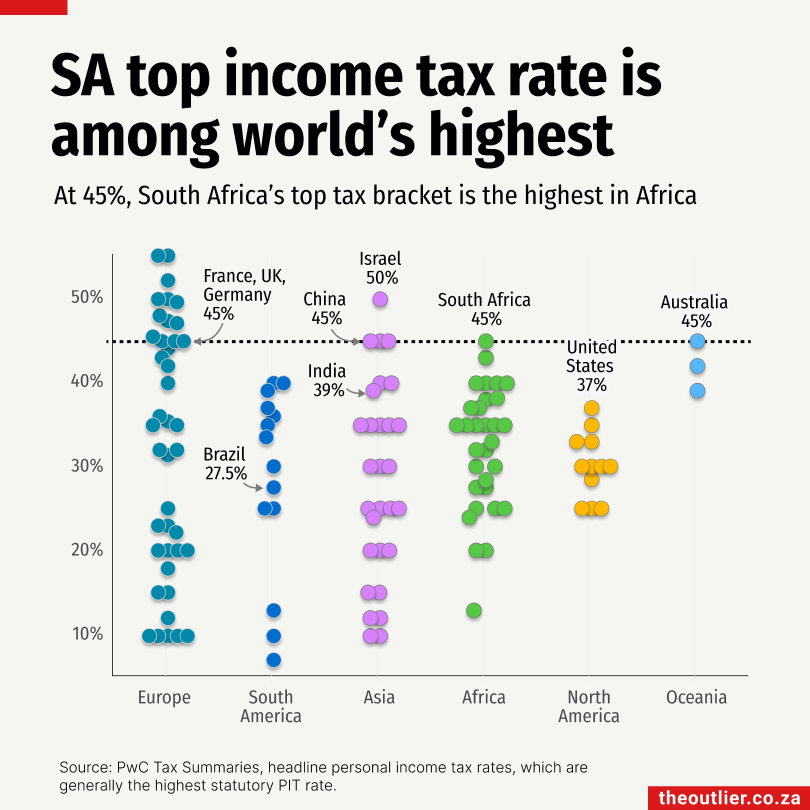
Finance Minister Enoch Godongwana avoided raising the personal income tax rate in his 2025 budget. Personal income tax collections as a percentage of gross domestic product are already higher than most developing countries, he said.
A comparison of the top income tax brackets across 132 countries, shown in the chart, shows that South Africa’s top rate of 45% ranks among the highest in the world. It’s the highest of the African countries, listed by PwC in its tax summaries.
The government introduced the 45% tax bracket in the 2017/18 financial year for individuals with an income of R1.5-million or more. That has since increased to R1.8-million or more.
Ninety-eight percent of South Africa’s revenue comes from taxes, with personal income tax accounting for 40% of the total tax collected.
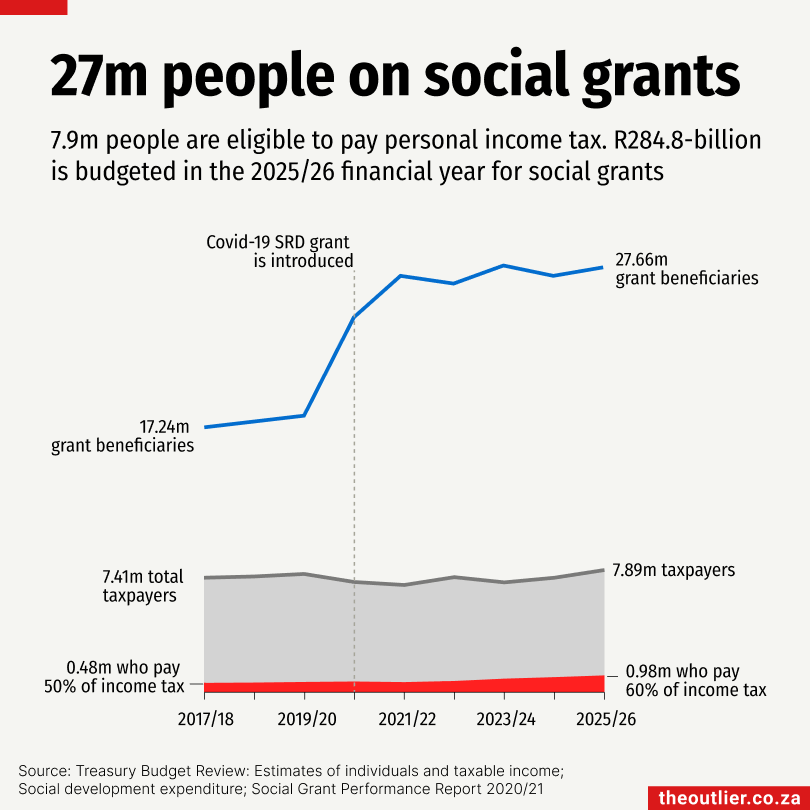
At the end of December 2024, 26-million people received social grants from the South African government, according to the South African Social Security Agency.
Half of them — 13.5-million — were for child support, care dependency and foster care. Another 4.1-million went to pensioners, and 6.9-million were Covid-19 Social Relief of Distress (SRD) grants, which were introduced during the pandemic.
The Treasury estimates there will be 27.7-million grant beneficiaries in the 2025/26 financial year.
Over the past eight years the number of social grant beneficiaries has increased by 60%, largely driven by the Covid-19 SRD grant. The increase in the 2020/21 financial year can be seen in the chart.
Finance Minister Enoch Godongwana said the SRD grant will continue, as it ‘serves as a basis for the introduction of a sustainable form of income support for unemployed people’.
Ninety-eight percent of the government’s revenue comes from taxes, with personal income tax contributing 40% of that.
The number of people eligible to pay tax has remained relatively stable at around 7-million over the eight-year period.
There are now roughly four grant beneficiaries for every taxpayer.
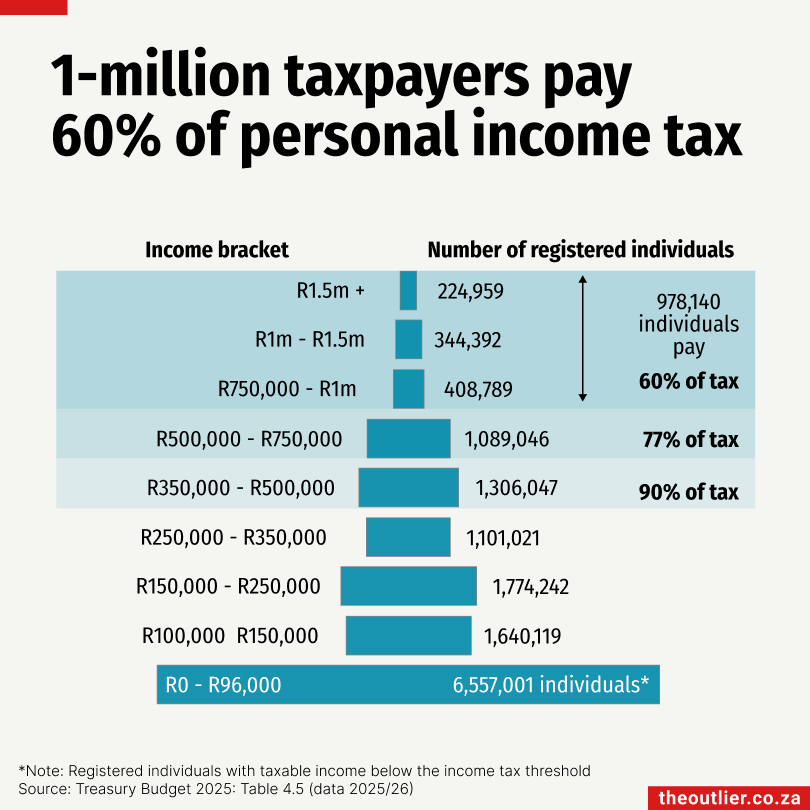
There are 14.45-million registered taxpayers in South Africa. They are divided into nine income categories by the National Treasury.
Only 7.89-million of those registered have income high enough to be eligible to pay personal income tax – on the chart that’s everyone except those in the lowest income category of R0 – R96,000.
The taxpayers in the top three income brackets – which is fewer than 1-million people – contribute 60% of the total personal income tax revenue collected by the government. Those are people with income of R750,000 and above. Among them are 224,959 individuals with incomes of R1.5-million or more, who account for nearly 33% of the personal income tax revenue collected.
Overall, 98% of South Africa’s revenue comes from taxes, with personal income tax contributing 40%.
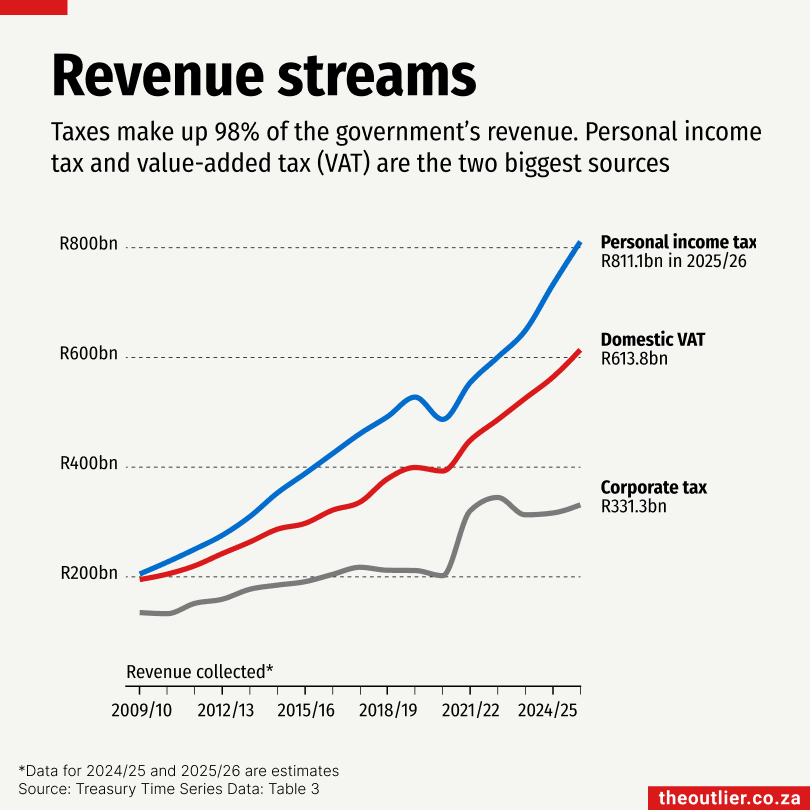
In his 2025 budget, South Africa’s Finance Minister Enoch Godongwana increased the value-added tax rate by 1 percentage point, split over two years, despite widespread criticism that a VAT hike will be hard on poor people.
The minister had little room to manoeuvre with this year’s budget. Corporate tax collections have decreased over the past few years, which he blamed on falling profits and ‘a trading environment worsened by logistics constraints and rising electricity costs’.
South Africa’s top personal income tax rate is already high. ‘Our personal income tax collections as a percentage of gross domestic product (GDP) are far higher than those of most developing countries,’ he said.
The government expects to collect an estimated R811.1-billion in personal income tax revenue and R613.8-billion from domestic VAT in the 2025/26 financial year, according to the Treasury. This is a significant chunk of its total revenue.
Ninety-eight percent of the government’s revenue is from taxes. Personal income tax contributes 40%, VAT accounts for 25%, and corporate income tax 17%.
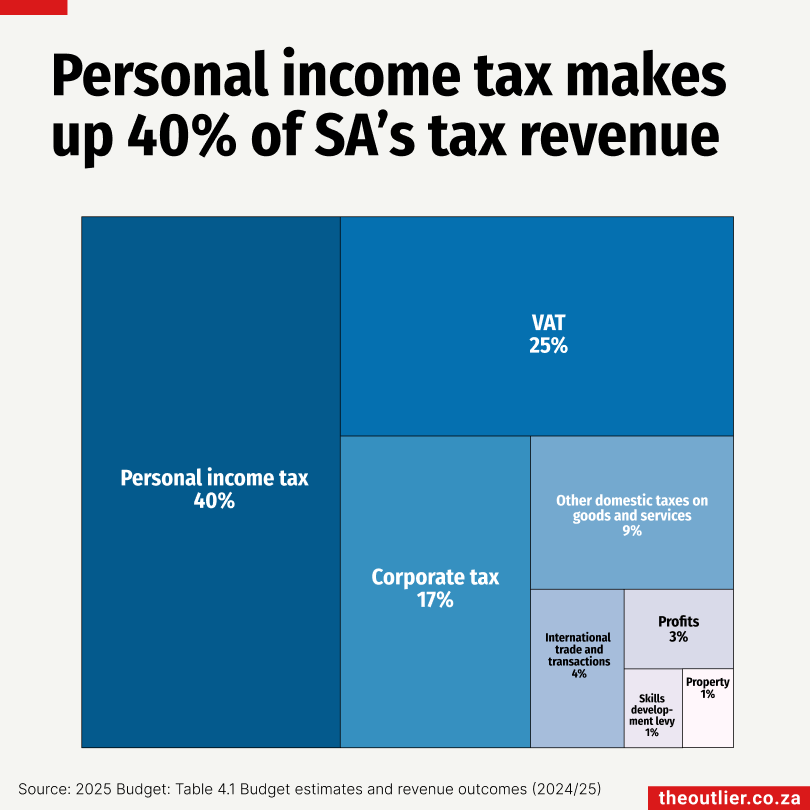
Almost all of South Africa’s revenue — 98% — comes from taxes. Personal income tax contributes 40%, followed by value-added tax (VAT) at 25% and corporate income tax at 17%.
In his 2025 budget, Finance Minister Enoch Godongwana announced an unpopular increase in the VAT rate. He had to adjust it down from an initial 2 percentage point rise – which would have raised VAT from 15% to 17% – to a compromise 1 percentage point, split over two years.
‘Increasing corporate or personal income tax rates would generate less revenue, while potentially harming investment, job creation and economic growth,’ he explained.
VAT is seen as a tax on the poor. ‘Dropping the proposed VAT-rate increase from 2% to 0.5% [the increase for 2025] still hurts people and still hurts the economy,’ said Mervyn Abrahams of the Pietermaritzburg Economic Justice & Dignity Group, which monitors low-income families’ household expenses.
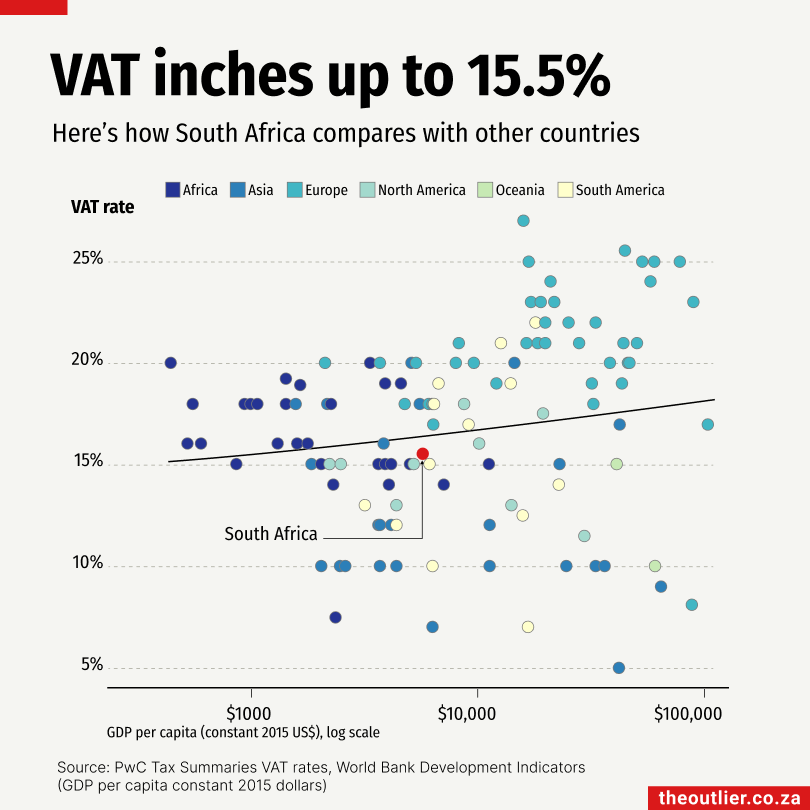
South Africa’s Finance Minister Enoch Godongwana increased value-added tax (VAT) by 1 percentage point over two years in his 2025 budget — from 15% to 15.5% in 2025 and then to 16% in 2026. It was a controversial move. VAT is seen as a tax on the poor.
He had initially proposed a 2 percentage point VAT increase, which was rejected. The lower compromise amount is still unpopular.
‘Dropping the proposed VAT rate increase from 2% to 0.5% still hurts people and still hurts the economy,’ said Mervyn Abrahams of the Pietermaritzburg Economic Justice & Dignity Group, which monitors the household expenses of low-income families.
South Africa’s VAT rate is not particularly high in comparison with countries with economies of a similar size, the chart shows.
Although VAT is generally higher in richer European countries, there are a number of African countries with higher VAT rates that South Africa. For example, Rwanda, Uganda, Tanzania, Côte d’Ivoire and Senegal have VAT of 18%, according to PwC data. Nigeria’s is a relatively low 7.5%.
VAT contributes 25% to the South African government’s revenue, according to the National Treasury.
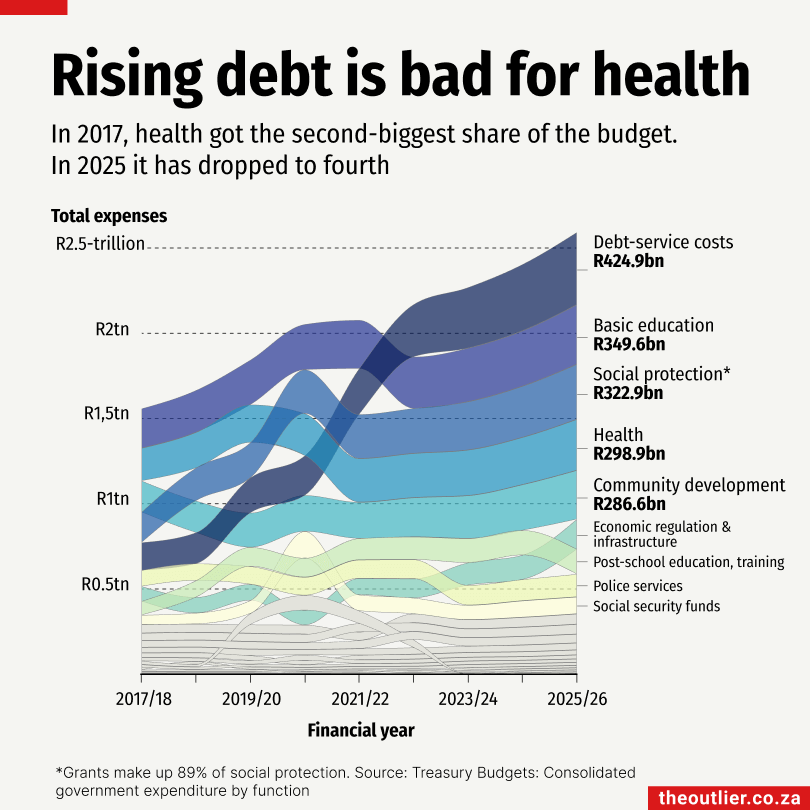
The biggest chunk of South Africa’s 2025/26 budget is going towards servicing debt — no surprise there; it’s been that way since the 2022/23 budget.
As Finance Minister Enoch Godongwana noted in his budget speech, 22 cents of every rand raised in revenue is spent on debt repayments. ‘It is more than what we spend on health, the police, and basic education,’ he said.
Back in 2017, health received the second-biggest share of the national budget. Now, it’s slipped to fourth place. This year, health received a 7.8% increase on last year’s allocation — slightly more than basic education (7.6%).
A ‘significant portion’ of the health budget goes towards salaries and wages. Yet over the past year, the public health system lost nearly 9,000 health workers. ‘We did not have the money to retain or replace them, even after reprioritising funds budgeted for consumables and medicines,’ Godongwana said.
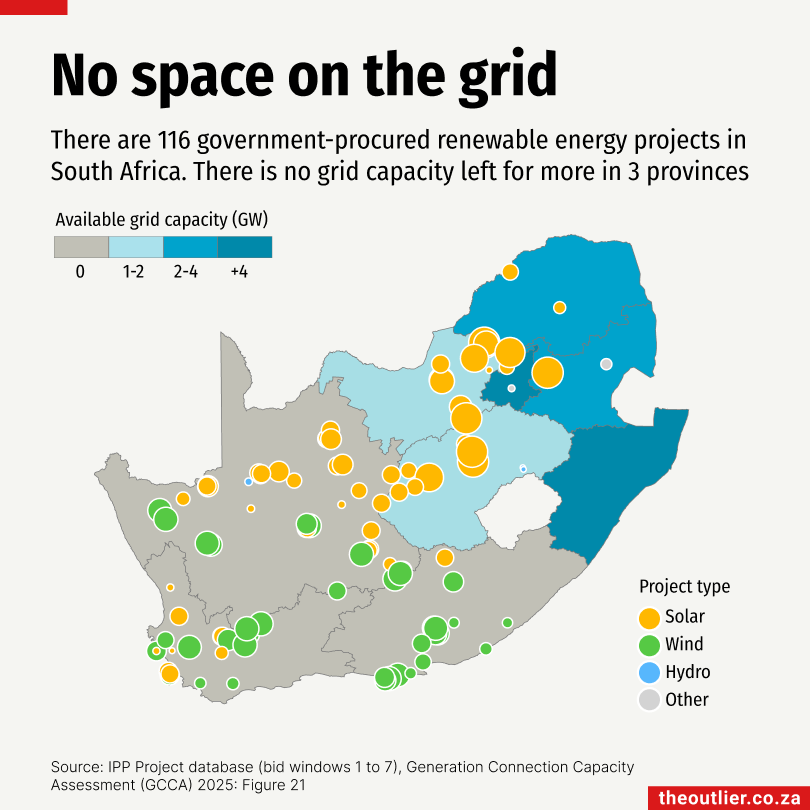
South Africa has 6,505MW of installed renewable energy capacity that generates power for the national electricity grid, according to [Eskom](https://www.ntcsa.co.za/wp-content/uploads/2025/03/Weekly_System_Status_Report_2025_w09.pdf). A key driver of renewable energy capacity has been the government’s Renewable Energy Independent Power Producer Procurement Programme (REIPPPP). Launched in 2011, it was designed to facilitate private sector investment in renewable energy projects that connect to the national grid through a competitive tender process. Since its inception, 116 projects have been approved, in seven bid windows. Ninety-one of these projects are operational.Forty REIPPPP projects are wind farms. Although there are more solar projects than wind projects, at present the wind farms are generating more electricity for the grid.But there’s a snag. The areas that are rich in solar and wind resources – the Northern Cape, Eastern Cape and Western Cape – have run out of grid capacity, according to Eskom’s Generation Connection Capacity Assessment: 2025.Get the data used in this chart on DataDesk
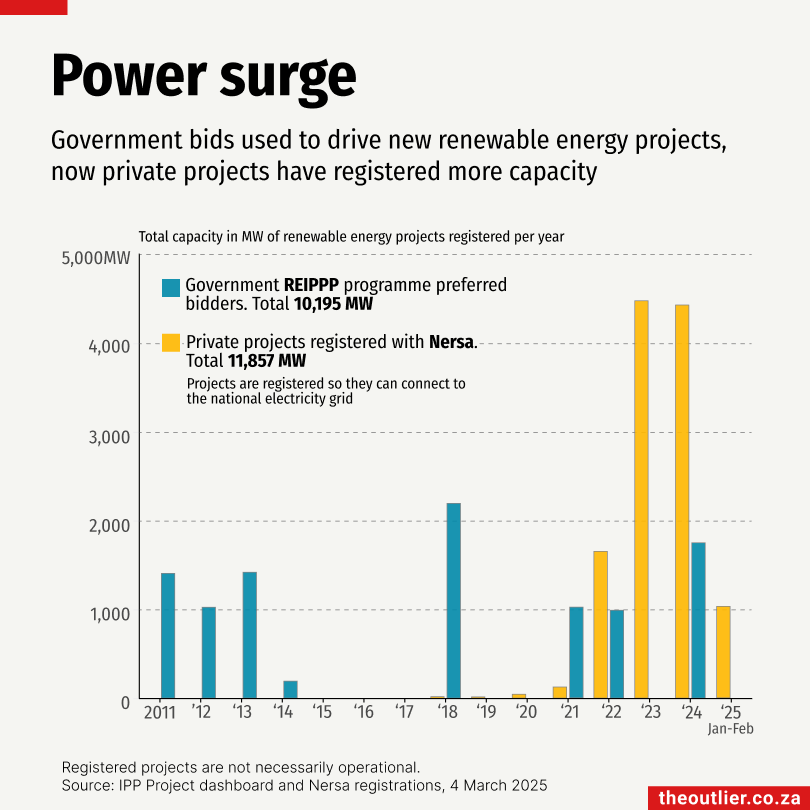
Since 2011, renewable energy projects with an installed capacity of 22,000MW have been registered as part of either the government’s Renewable Energy Independent Power Producer Procurement Programme (REIPPPP) or with the National Energy Regulator of SA (Nersa) by private operators. The REIPPP programme, launched in 2011, was designed to facilitate private sector investment in renewable energy projects that connect to the national electricity grid through a competitive tender process. Since its inception, 116 projects have been approved, in seven bid windows. Ninety-one projects are operational.Thanks to years of loadshedding, private businesses and residents have invested in solar and other energy alternatives, to compensate for the unreliable electricity supply. By February 2025, Nersa had registered projects with a total installed capacity of 11,857MW – most of it solar. Nersa doesn’t provide information about whether these projects are operational.Get the data used in this chart on DataDesk
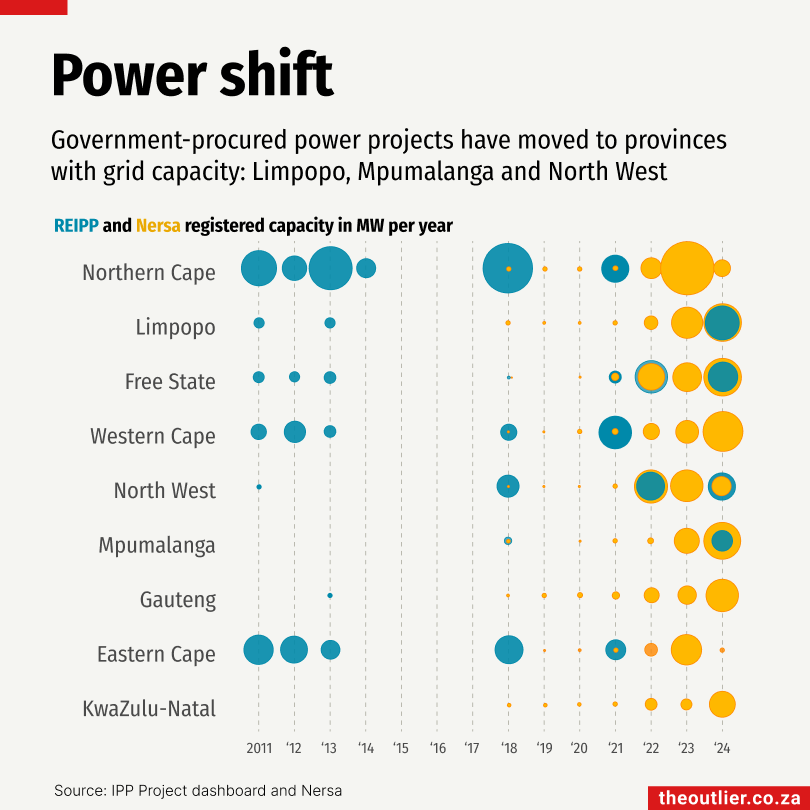
The South African government’s Renewable Energy Independent Power Producer Procurement Programme (REIPPPP) has been a key driver of the growth of renewable electricity projects in South Africa. It was designed to facilitate private sector investment in renewable energy projects that connect to the national electricity grid through a competitive tender process. Since its inception, 116 projects have been approved, in seven bid windows (blue circles on the chart). The Northern Cape and Eastern Cape are rich in solar and wind energy potential and are the site of many of the earlier REIPPPP projects, but there’s been a big drop in registrations of government projects in those provinces because of the shortage of grid capacity. The bigger energy projects are now being registered in Limpopo and the Free State, where there is still grid capacity.Thanks to years of loadshedding, private businesses and residents have also started to invest in solar and other energy generation alternatives. A project must be registered with the National Energy Regulator of SA (Nersa) if it is to be connected to the electricity grid. By February 2025, Nersa had registrations with a total installed capacity of 11,857MW (see yellow circles) – most of it is solar.
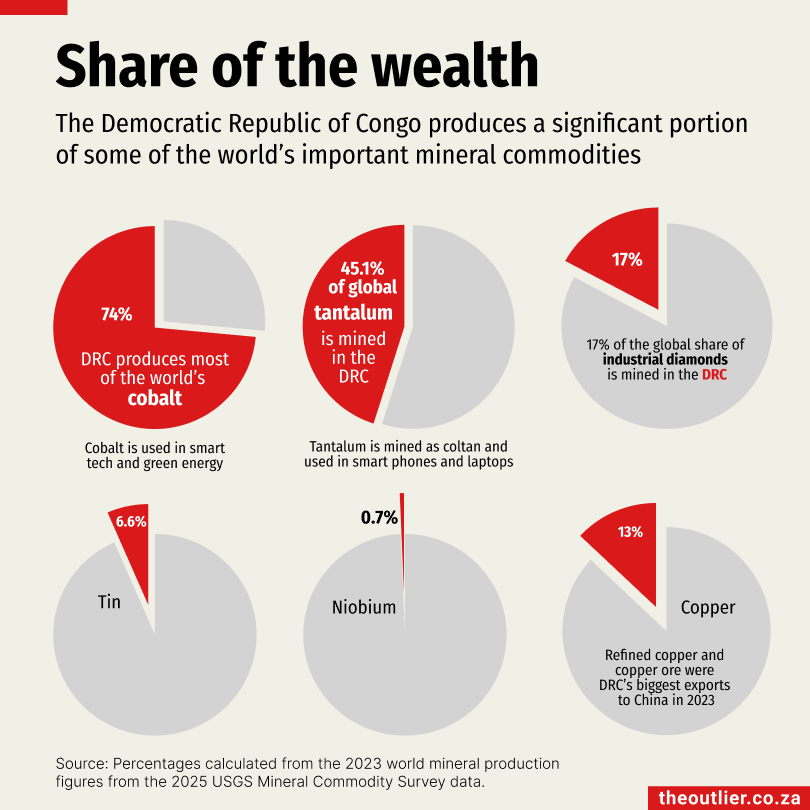
The Democratic Republic of Congo (DRC) produces substantial slices of critical minerals used in clean energy and other tech, particularly cobalt and coltan. It produces three-quarters of the world’s cobalt, according to data from the United States Geological Survey (USGS).
‘Coltan’ is the term used to describe columbite-tantalite, which contains tantalum and niobium. Small amounts of tantalum powder are used to make the heat-resistant capacitors in almost all smart technology that we use, like cellphones and laptops. Nearly half of global tantalum is mined in the DRC, USGS data shows.
Despite its mineral wealth, millions of people in the DRC live in extreme poverty. Artisanal mining (small scale, subsistence) is still predominant and much of the conflict in the DRC reportedly relates to control and movement of these resources.
China is the DRC’s biggest mineral export partner. It refines most of the DRC’s cobalt, which is used in lithium-ion batteries.
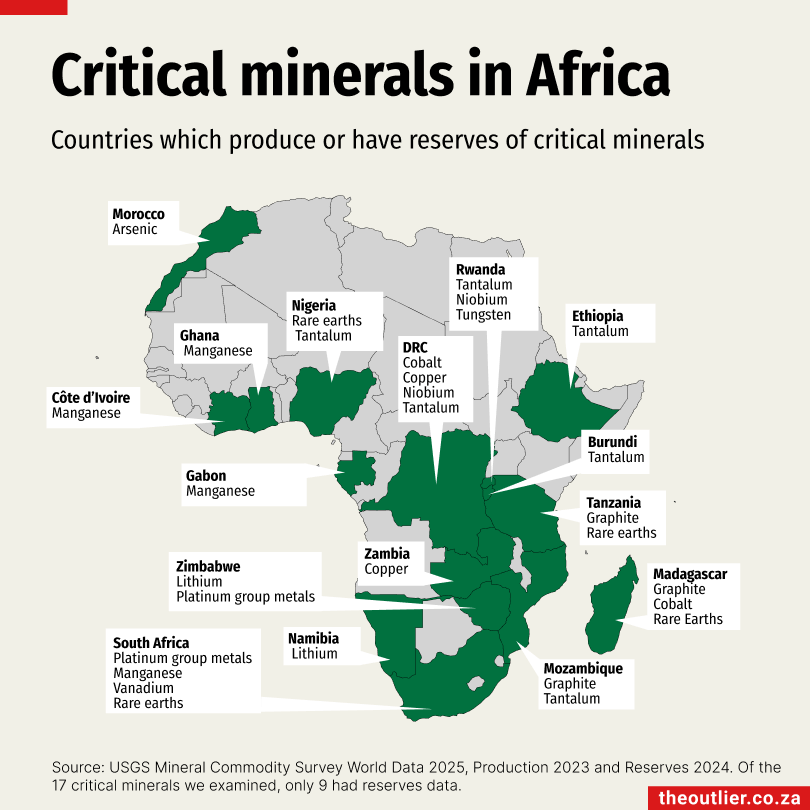
African countries are rich in critical minerals required for clean energy and tech. The map above shows the countries that produce or have reserves of 18 critical minerals, according to the United States Geological Survey (USGS) Mineral Commodity Survey World Data 2025.
The Democratic Republic of Congo (DRC) produces three-quarters of the world’s cobalt. It also has copper, niobium and tantalum.
Eighty percent of the world’s tantalum, which is used in capacitors in cellphones and computers, is produced in three African countries: the DRC, Nigeria and Rwanda. Ethiopia, Burundi and Mozambique have reserves of the mineral.
South Africa produces 70% of the platinum group metals (PGMs) and a third of manganese globally. It also produces vanadium and has reserves of rare earths.
Zimbabwe produces 7% of the world’s lithium, used in rechargeable batteries.
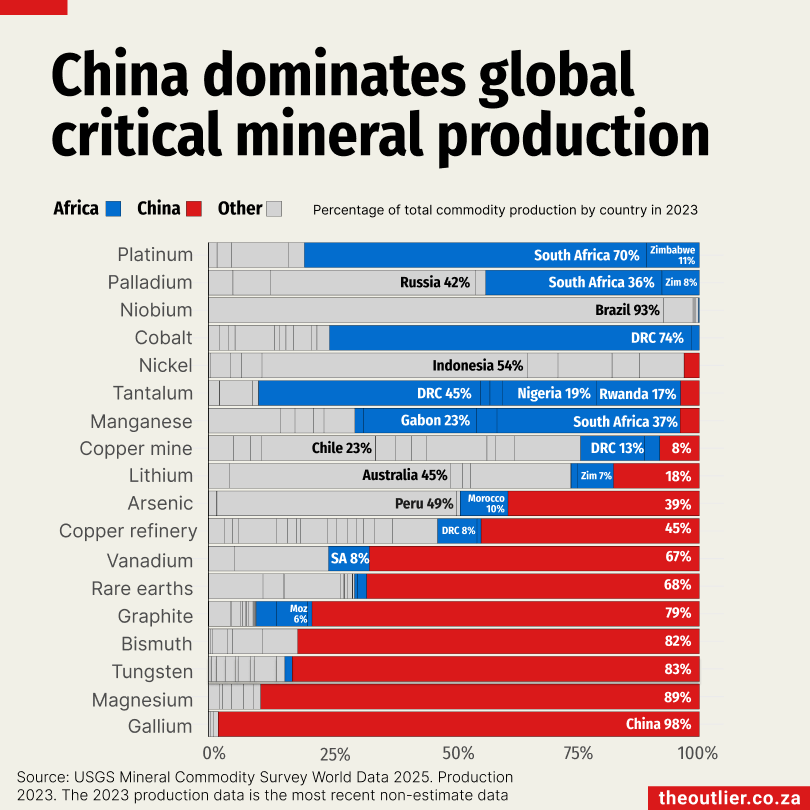
Clean energy systems require critical minerals. There are five core critical minerals, according to the International Energy Agency (IEA): copper, cobalt, lithium, nickel, graphite and rare earths. But there are many others, such as arsenic, bismuth, gallium, germanium, hafnium, magnesium, manganese, niobium, platinum group metals, tantalum, tungsten and vanadium, all of which play different roles in energy tech.
The places on Earth where there are mineral-rich ore deposits that are ‘economically viable’ to mine are becoming increasingly important as countries move away from fossil fuels towards renewable energy, and increasingly advanced tech is created. As the chart above shows, China is a dominant player in the production of critical minerals, producing more than half of the world’s gallium, magnesium, tungsten, bismuth, graphite, rare earths and vanadium. Of the 18 minerals in the chart, South Africa is a major producer of platinum and palladium as well as manganese.
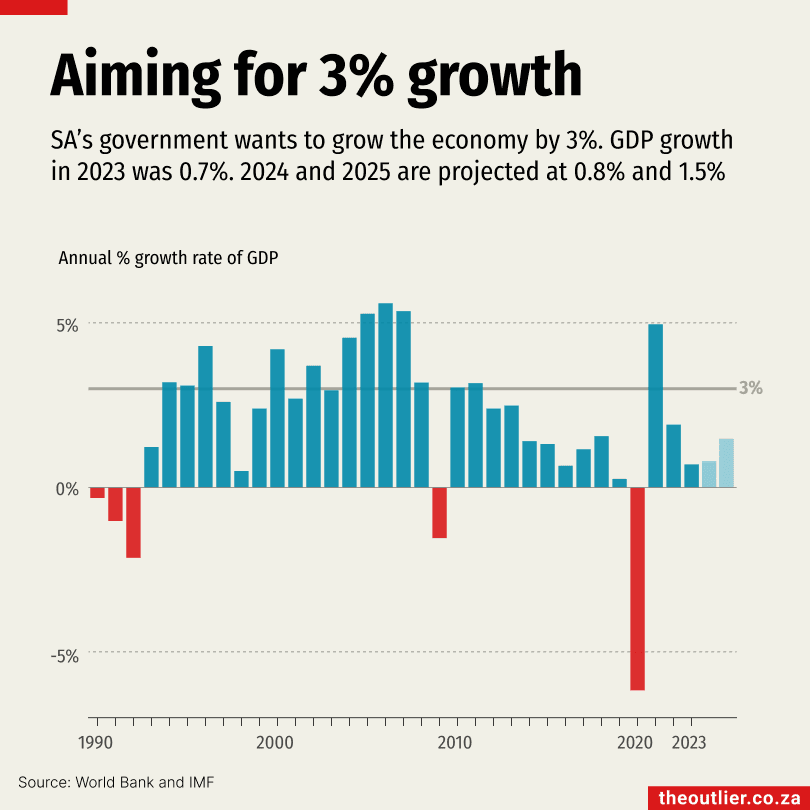
South Africa’s key focus areas for 2025 include energy, transport and logistics, youth unemployment as well as crime and corruption, according to president Cyril Ramaphosa.
These sectors, he said in his state of the nation address in February, have the potential to lift the county’s economic growth to above 3%, helping to create jobs and lift people out of poverty.
The government has set a target to grow GDP by 3%, a level not achieved in recent years. While challenges like energy shortages and inefficiencies in transport and logistics continue to affect economic progress, the outlook for 2025 is more positive.
In 2023, growth was just 0.7%, and the International Monetary Fund has projected a modest 0.8% for 2024. Growth for 2025 is expected to pick up to 1.5%, driven by improvements in electricity generation, relaxed monetary policies and renewed investor and consumer confidence after the 2024 national election.
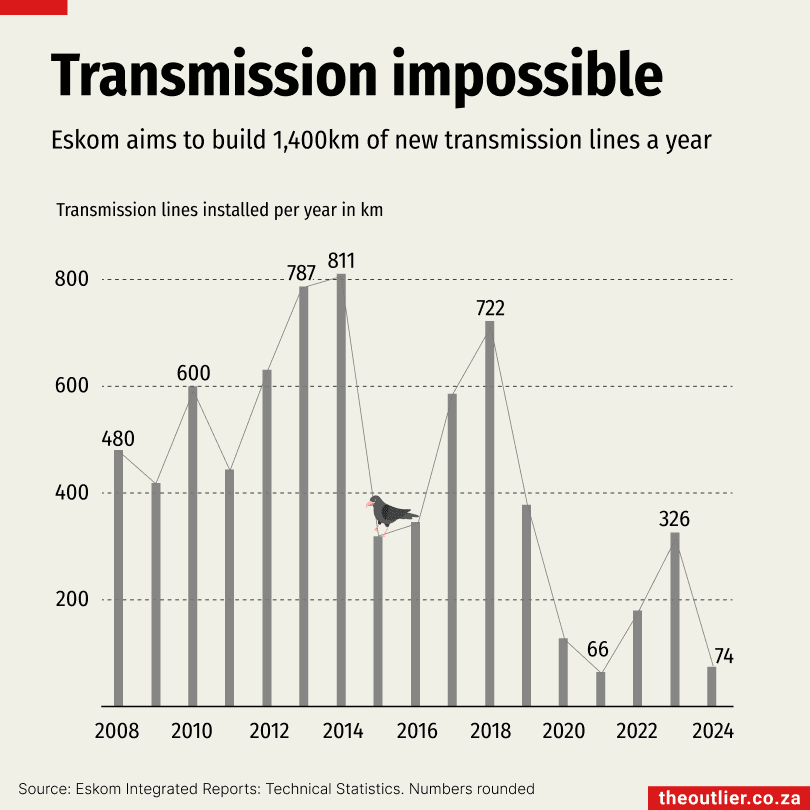
South Africa has a pressing need to increase energy capacity. However, some of the country’s best solar and wind resource areas – the Eastern Cape, Western Cape and Northern Cape – have run out of grid capacity.
To address this, Eskom must expand capacity and build more transmission lines, which transport electricity from where it is generated to where it is needed.
In its 2024 annual report, the power utility stated that it wants to accelerate its transmission line construction rate to 1,400km a year. However, reaching this target will require a significant increase in efforts. In 2024, for instance, only 74km of lines were built.
Eskom’s Transmission Development Plan aims to install more than 14,000km of transmission lines over the next decade. However, the utility acknowledges that this will have to be done at an ‘unprecedented pace.’
The highest installation since 2008 was in 2014, when 811km of lines were added.
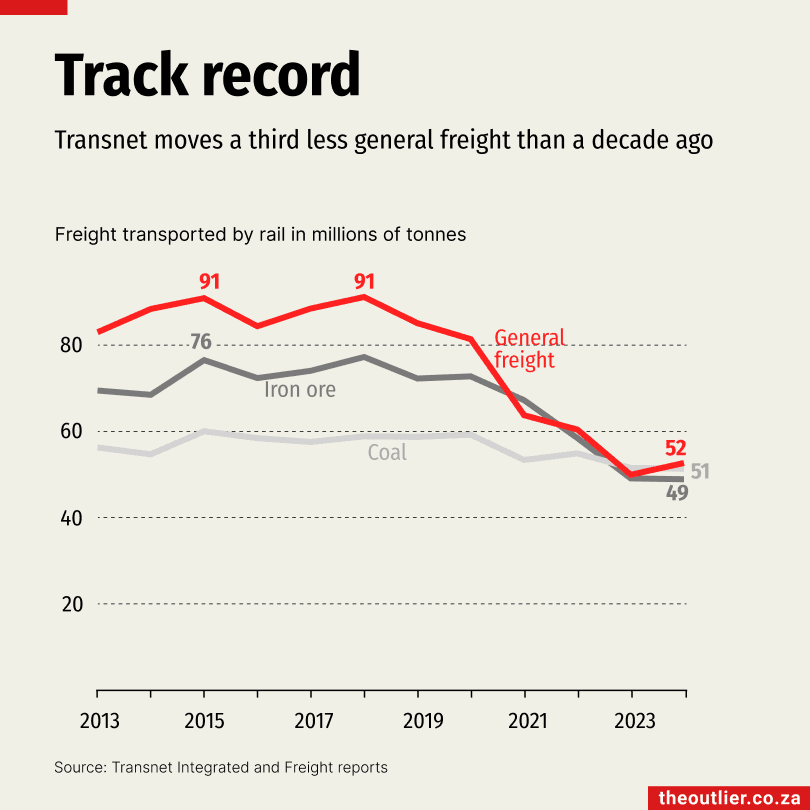
The collapse of South Africa’s freight rail network has placed a significant strain on the economy. In 2013, Transnet moved 208-million tonnes of freight, but by 2024, this had dropped to 152-million tonnes.
General freight, which includes all goods except iron ore and coal, has been hardest hit, declining by one-third over the past decade from 83-million tonnes to 52-million tonnes.
Coal transport has also suffered, with Transnet moving 30% less coal in 2024 than in 2013.
In his 2025 state of the nation address, president Cyril Ramaphosa highlighted a key reform: private rail operators are now allowed access to the freight rail network, which allows them to increase the volume of goods transported by train.
While the infrastructure remains state-owned, Ramaphosa said wider access will help ensure that South African ‘minerals, vehicles and agricultural produce reach international markets, securing jobs and generating much-needed revenue for our fiscus’.
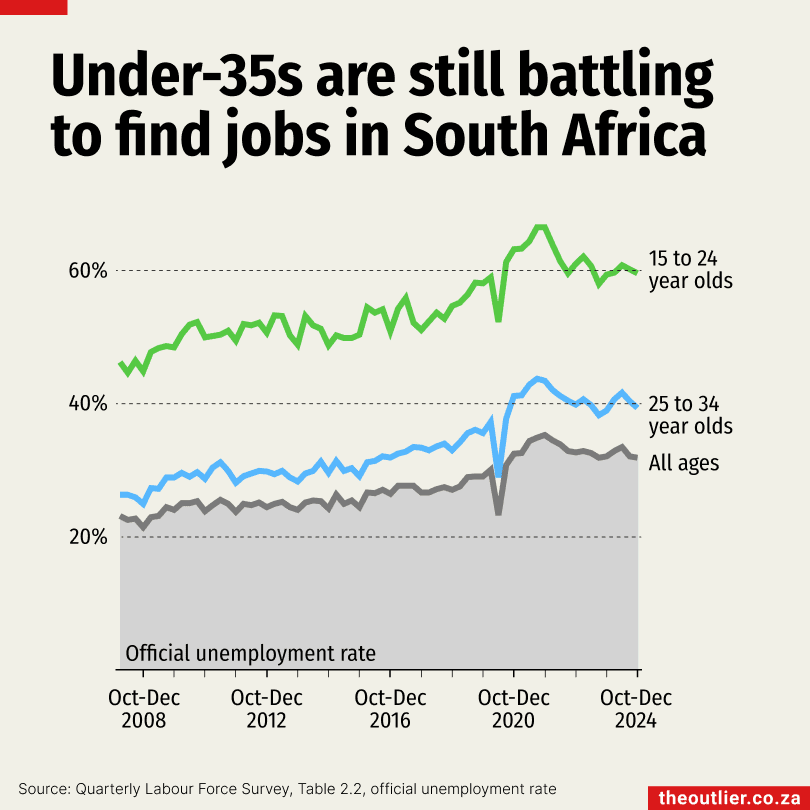
South Africa’s unemployment rate in the last quarter of 2024 stood at 31.9%, slightly lower than the 32.1% recorded in the same period in 2023. However, it remains alarmingly high, particularly among young people.
Youth unemployment is particularly severe, with 59.6% of the labour force aged 15 to 24 unemployed. Many in this group are likely searching for their first job but struggling to find one. Among those aged 25 to 34, the unemployment rate is also high at 39.4%. Recognising this crisis, the Presidency has launched several initiatives to provide unemployed young people with work experience. Statistics South Africa noted last year that ‘initiatives such as experiential learning, apprenticeships, or other forms of exposure to the workplace have far-reaching implications in addressing the scourge of youth unemployment.’
President Cyril Ramaphosa has also called on the private sector to create opportunities for young people to gain work experience.
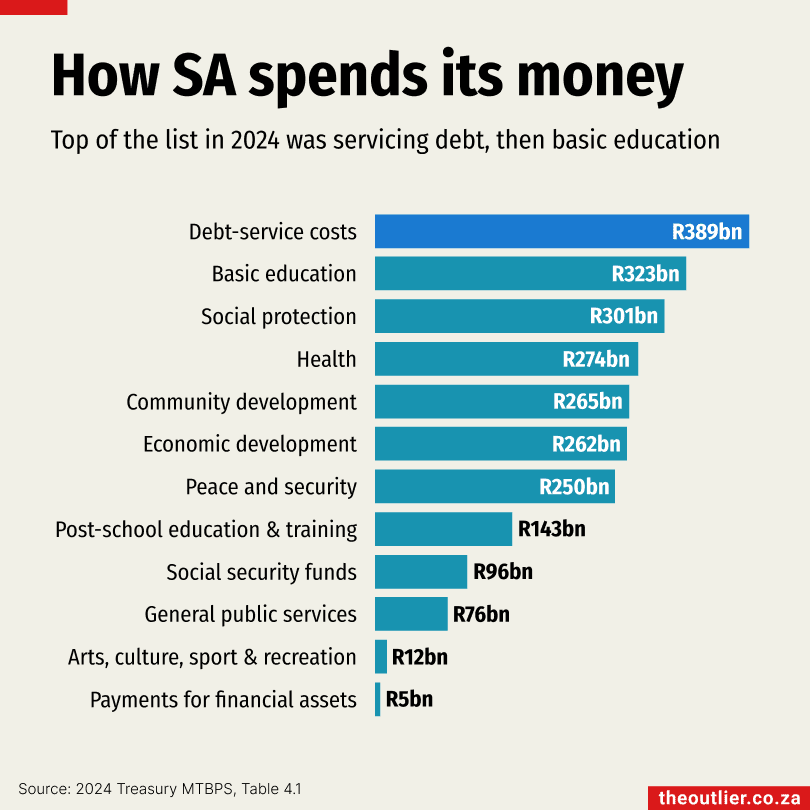
A significant portion of South Africa’s budget is spent on servicing debt – R389-billion in 2024, according to the National Treasury. This exceeds allocations for basic education (R323-billion), health (R274-billion) and peace and security (R250-billion).
Debt service costs surpassed basic education spending after the 2021/22 financial year. The year before, debt repayment was the government’s fourth biggest expense after basic education, social protection and health.
South Africa’s debt-to-GDP ratio stood at 74.7% in 2024/25, far above the government’s original goal set in 2014 of keeping it below 40%. This ratio, which measures total debt as a percentage of GDP, reflects a country’s ability to meet its obligations.
Since democracy, government spending has exceeded revenue every year except for two (2006/07 and 2007/08). With slow economic growth and ongoing budget deficits, fiscal pressure is high, raising concerns about the South Africa’s ability to manage its debt in the long term.
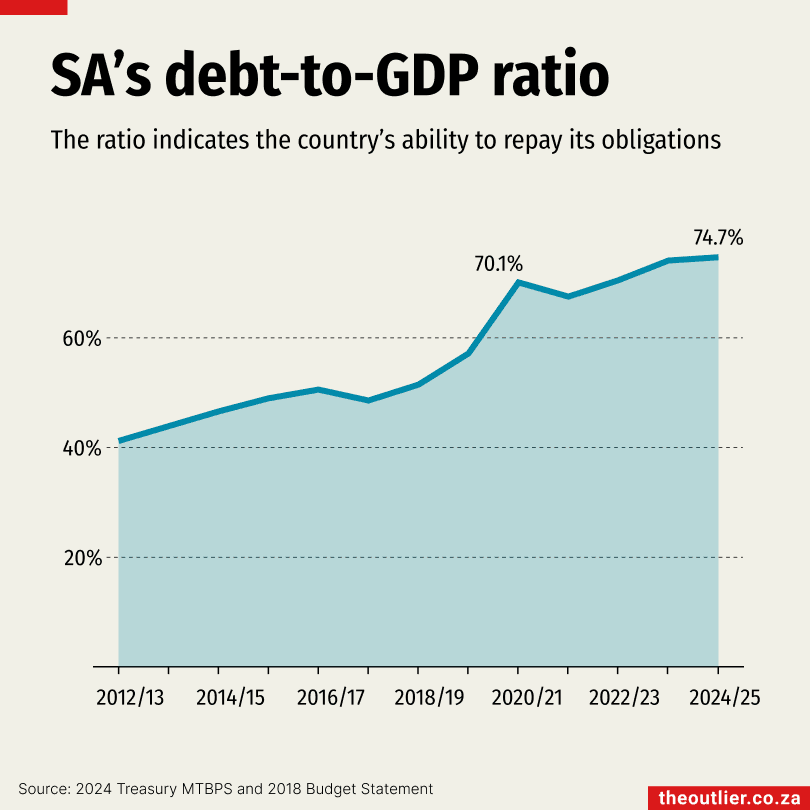
A significant portion of South Africa’s budget is spent on servicing debt – R389-billion in 2024, according to the National Treasury. This exceeds allocations for basic education (R323-billion), health (R274-billion) and peace and security (R250-billion).
Debt service costs surpassed basic education spending after the 2021/22 financial year. The year before, debt repayment was the government’s fourth biggest expense after basic education, social protection and health.
South Africa’s debt-to-GDP ratio stood at 74.7% in 2024/25, far above the government’s original goal set in 2014 of keeping it below 40%. This ratio, which measures total debt as a percentage of GDP, reflects a country’s ability to meet its obligations.
Since democracy, government spending has exceeded revenue every year except for two (2006/07 and 2007/08). With slow economic growth and ongoing budget deficits, fiscal pressure is high, raising concerns about the South Africa’s ability to manage its debt in the long term.
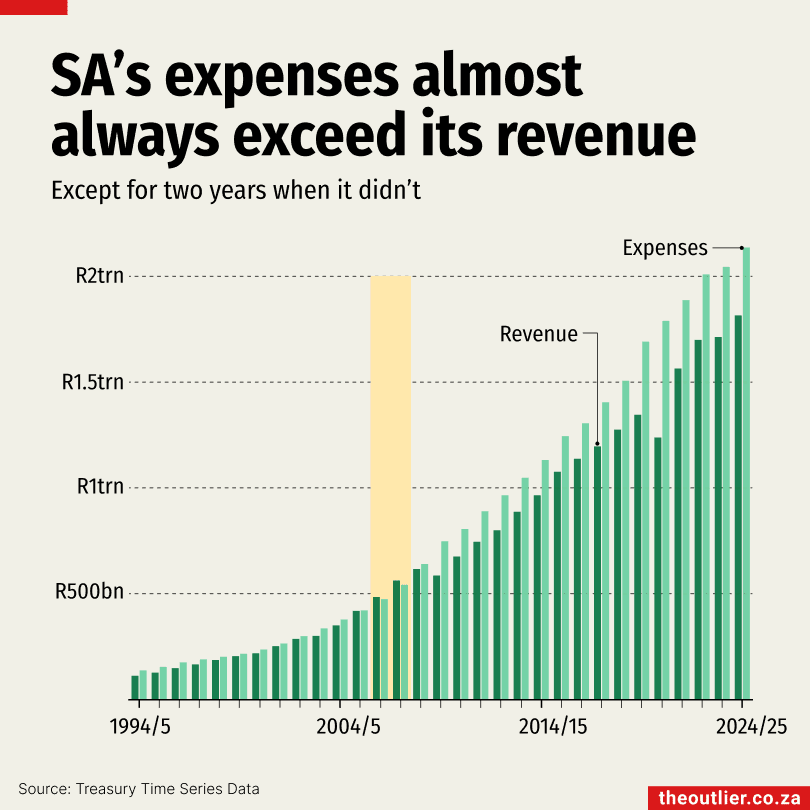
A significant portion of South Africa’s budget is spent on servicing debt – R389-billion in 2024, according to the National Treasury. This exceeds allocations for basic education (R323-billion), health (R274-billion) and peace and security (R250-billion).
Debt service costs surpassed basic education spending after the 2021/22 financial year. The year before, debt repayment was the government’s fourth biggest expense after basic education, social protection and health.
South Africa’s debt-to-GDP ratio stood at 74.7% in 2024/25, far above the government’s original goal set in 2014 of keeping it below 40%. This ratio, which measures total debt as a percentage of GDP, reflects a country’s ability to meet its obligations.
Since democracy, government spending has exceeded revenue every year except for two (2006/07 and 2007/08). With slow economic growth and ongoing budget deficits, fiscal pressure is high, raising concerns about the South Africa’s ability to manage its debt in the long term.
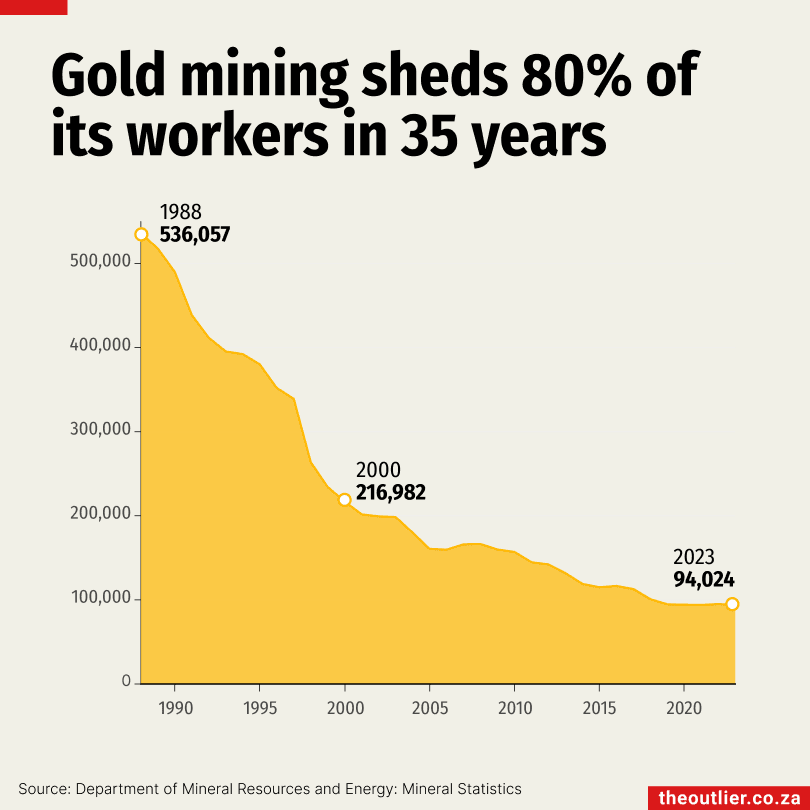
South Africa’s gold mining industry has shed 80% of its workforce over the past three-and-a-half decades. In 1988, more than 536,000 people worked in the sector. By 2000, that number had more than halved to 217,000; by 2023, it had fallen to 94,000.
Several factors have driven this decline. Many gold mines have closed as accessible reserves became depleted, forcing miners to dig ever deeper and at greater costs. Global economic shifts and competition from other gold-producing nations have put pressure on South African mines.
Gold has been overtaken by platinum and coal in terms of employment numbers. The number of people working in platinum mining has doubled from 85,000 in 1988 to 183,000 in 2023. Just over 96,000 people were employed in coal mining in 2023.
Mining was once a pillar of SA’s economy. In the early 1980s, it contributed about 20% to the GDP; by 2023, its contribution had dropped to 6.3%.
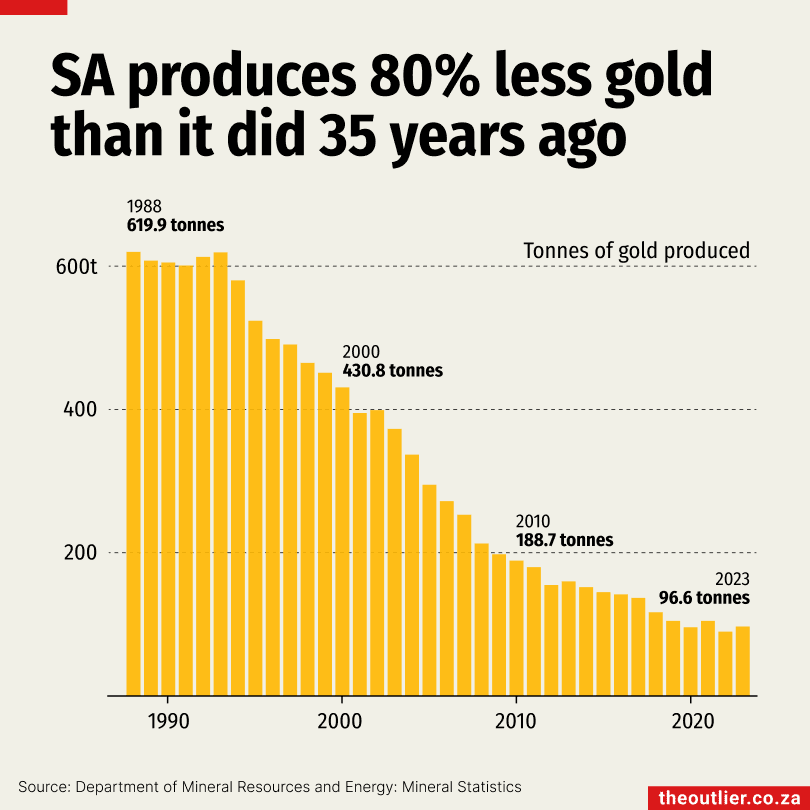
The amount of gold produced by South Africa has fallen by 80%, plunging from 620 tonnes in 1988 to 97 tonnes in 2023.
This doesn’t mean there’s no gold left in the ground. PwC reported in 2023 that South Africa still had 68-million troy ounces of gold reserves, the equivalent of 27 years of production.
However, extraction has become punishingly expensive as mines have become deeper to reach remaining deposits.
As a result, hundreds of gold mines have been closed. The Auditor-General said in 2022 that of the estimated 6,100 closed mines in SA, at least 700 were old gold mines.
Although the mines are supposed to be sealed, many are not. An informal economy has grown around them, with former miners and other workers extracting residual gold under hazardous conditions. Many of these miners, known as zama zamas, operate without permits.
Mining minister Gwede Mantashe said in January that SA lost R60-billion to illicit trade in 2024.

Platinum and coal have outpaced gold in terms of people employed in South Africa. The country has more than 80% of the world’s platinum group metal deposits and the number of people working in platinum mining has doubled from 85,000 in 1988 to 183,000 in 2023. Just over 96,000 people were employed in coal mining in 2023.
Gold is now the third largest employer in South Africa’s mining sector, having shed 80% of its workforce over the past 35 years. In 1988, more than half-a-million people worked in gold mining. By 2000, that number had plunged to less than half at 217,000. By 2023, it had fallen to 94,000 employees.
Chrome and manganese mining have seen significant growth in their employee numbers, with both industries tripling their workforce over the past three decades. These two minerals will continue to grow in importance as they are critical for renewable energy-related products.
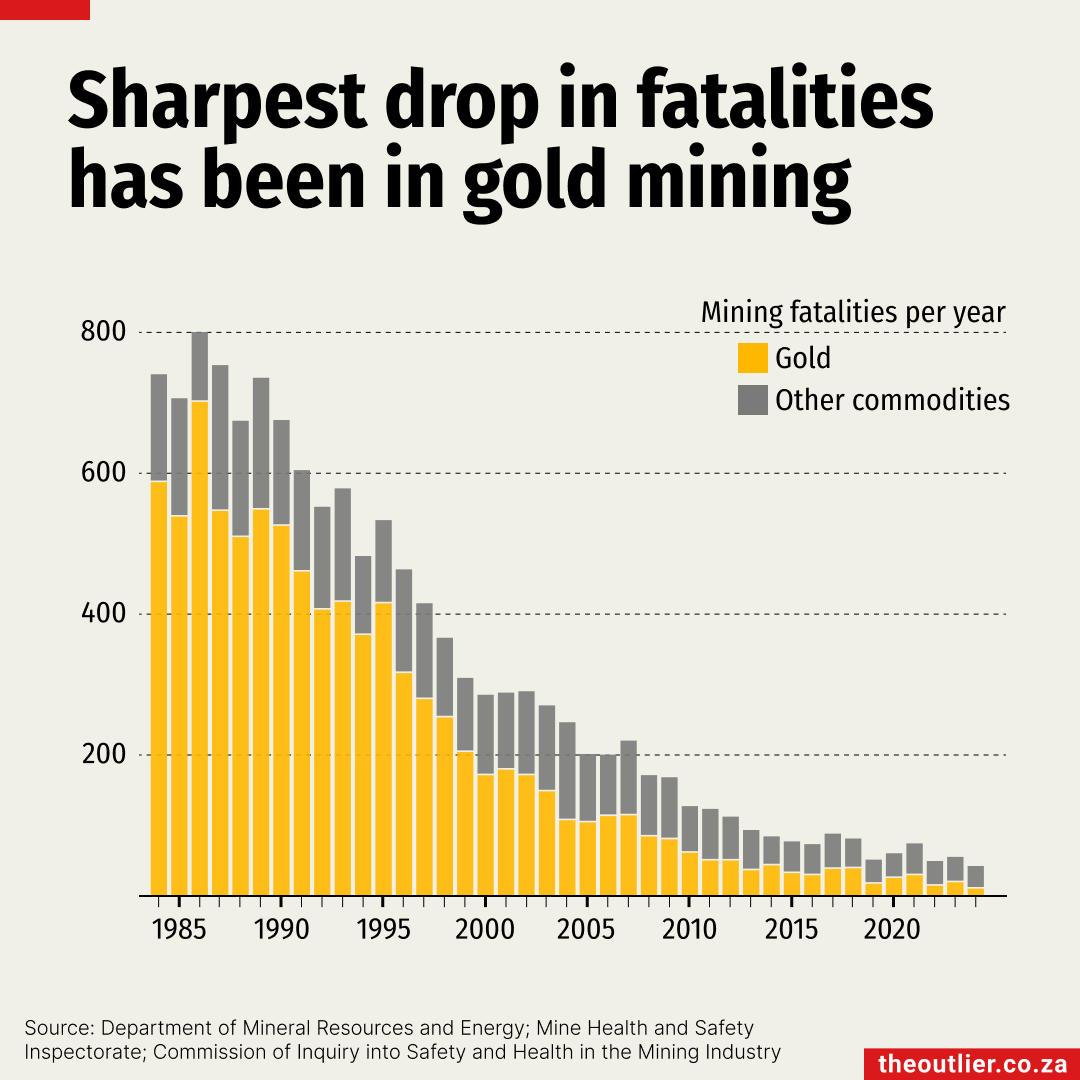
In 2024, South Africa recorded its lowest-ever number of mining fatalities: 42 deaths. That’s a significant improvement on previous decades.
During the 1980s, when mining contributed about 20% to South Africa’s economy, more than 700 deaths were recorded by the industry a year.
At that time, about 80% of the fatalities were in the gold sector, according to statistics from the department of mineral resources and energy. By 2024, only 26% of mining fatalities were linked to gold mining.
Mining’s contribution to the country’s GDP has fallen to around 6% and gold is no longer the country’s biggest employer in the mining sector. In fact, the sharp drop in gold mining fatalities mirrors the decrease in the number of people employed by the sector. In 1988, gold mining employed just over 536,000 people. By 2000, that number had more than halved to 217,000; by 2023, it had fallen to 94,000.
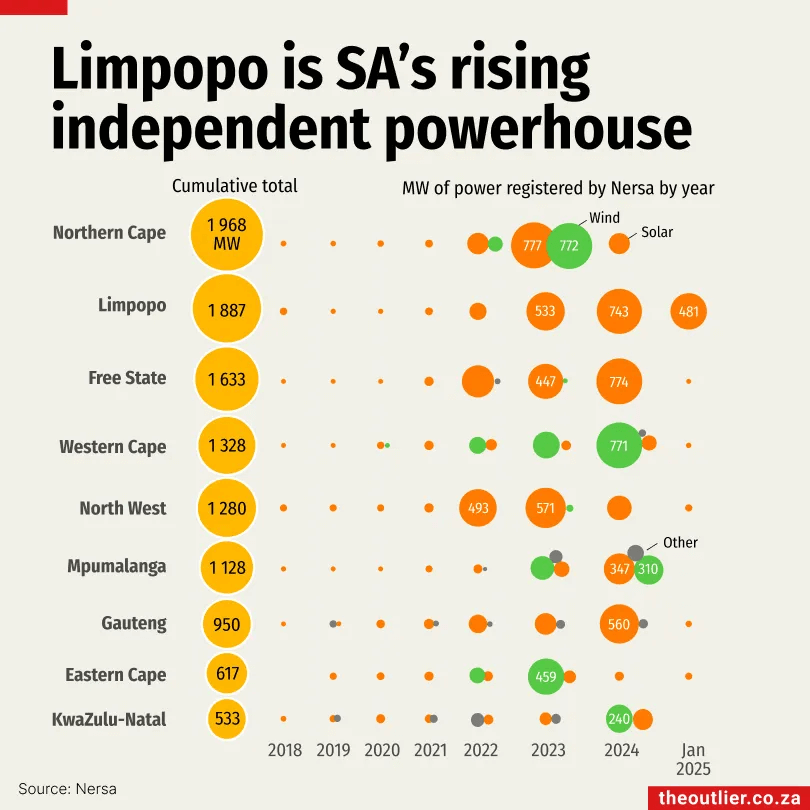
The number of private electricity generation projects in Limpopo is growing rapidly, making the province second only to the Northern Cape in capacity registered with Nersa, South Africa’s energy regulator. Two major solar projects added in January brought Limpopo’s total to 1,887MW, overtaking the Free State.
Three large solar projects were registered in Limpopo in 2024, including a 475MW facility. It is one of the two largest private solar projects on Nersa’s list, with the other located in the Free State.
The Western Cape registered three large wind projects last year, including the 380MW FE Overberg wind farm. No new wind registrations have been added since August.
Large private projects (100MW or more) began registering with Nersa in 2022 after licensing regulations were relaxed. These projects are independent of the government’s Renewable Energy Independent Power Producer Procurement Programme. Registration doesn’t mean they are operational.
Two-thirds of the 11,324MW registered by Nersa since 2018 is solar.
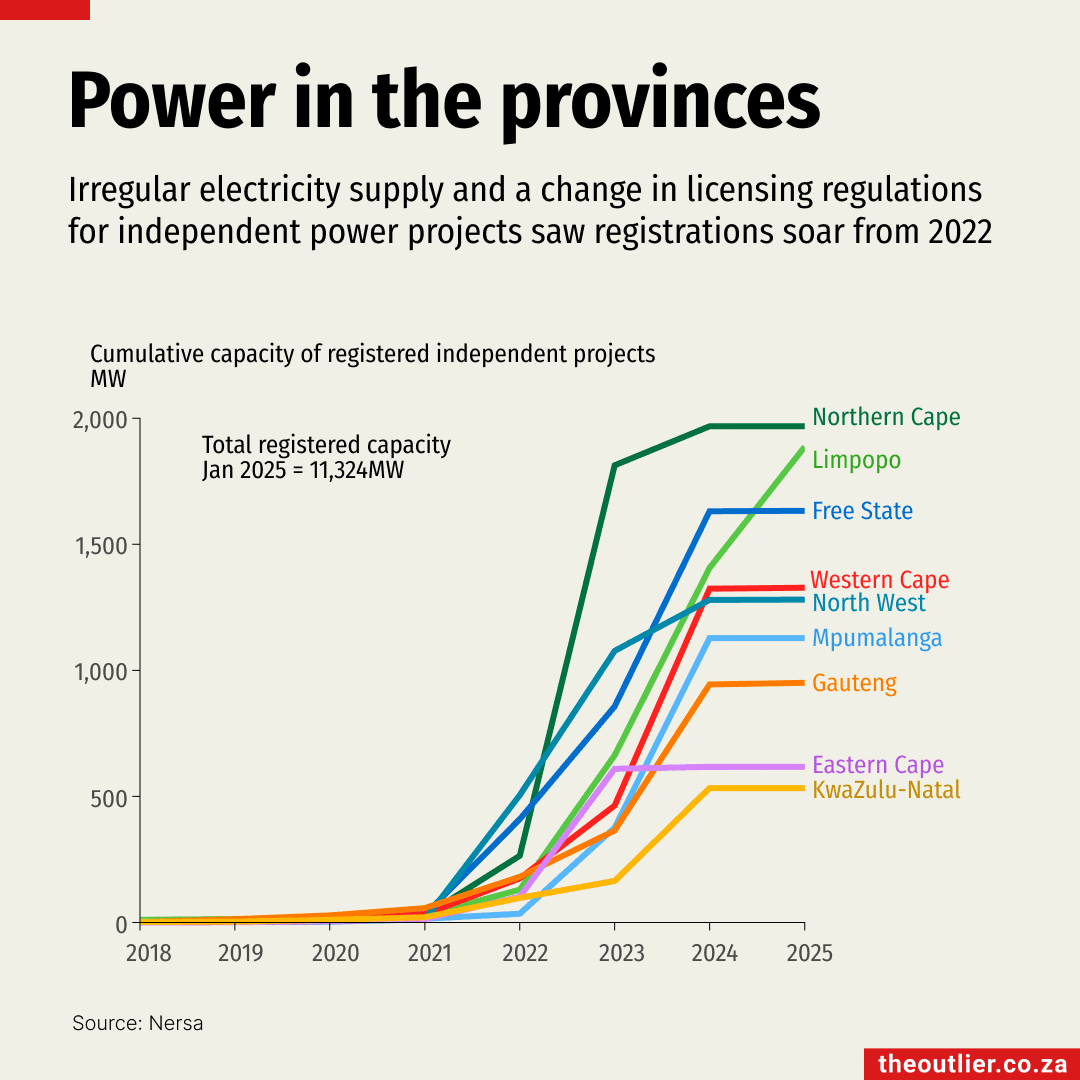
The number of private electricity generation projects in Limpopo is growing rapidly, making the province second only to the Northern Cape in capacity registered with Nersa, South Africa’s energy regulator. Two major solar projects added in January brought Limpopo’s total to 1,887MW, overtaking the Free State.
Three large solar projects were registered in Limpopo in 2024, including a 475MW facility. It is one of the two largest private solar projects on Nersa’s list, with the other located in the Free State.
The Western Cape registered three large wind projects last year, including the 380MW FE Overberg wind farm. No new wind registrations have been added since August.
Large private projects (100MW or more) began registering with Nersa in 2022 after licensing regulations were relaxed. These projects are independent of the government’s Renewable Energy Independent Power Producer Procurement Programme. Registration doesn’t mean they are operational.
Two-thirds of the 11,324MW registered by Nersa since 2018 is solar.
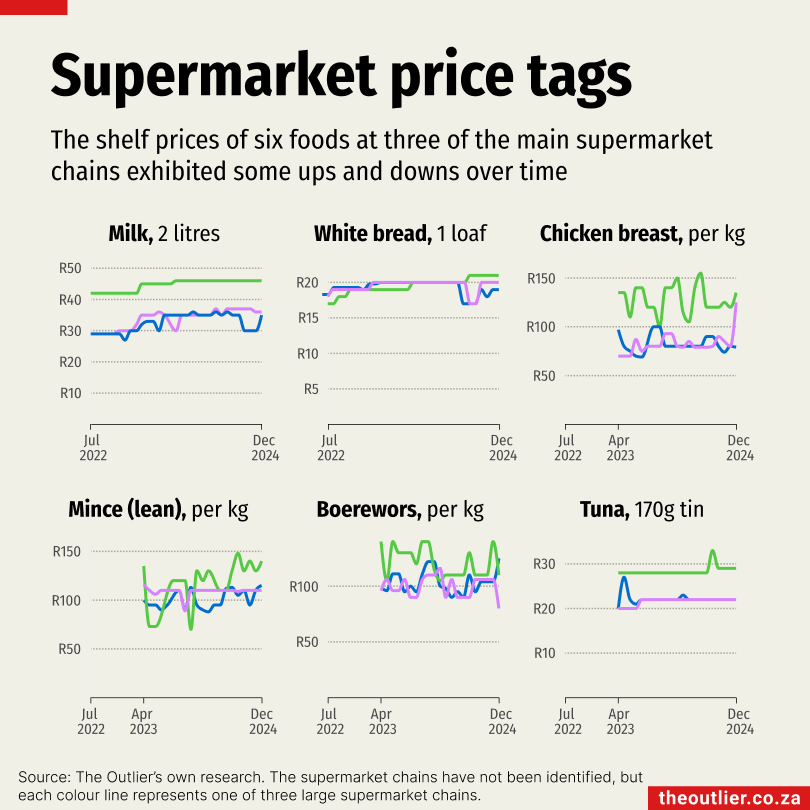
Since July 2022, The Outlier has tracked the prices of goods at six of South Africa’s major supermarket chains. We have collected the shelf prices of a set list of goods every month from Checkers, Pick n Pay, Food Lovers Market, Spar and Woolworths.
This chart highlights the prices of six food items commonly bought by middle-class shoppers: milk, white bread, chicken breast, mince, boerewors and tinned tuna. Each coloured line represents one of three unnamed national retailers, highlighting the fluctuating nature of prices over time.
While supermarket pricing often depends on seasonality and supply chains, it is also affected by brand-specific promotions, loyalty programmes and bulk discounts. These pricing strategies have complicated efforts to capture consistent data over time.
The Outlier’s data does not extend back far enough to show the pandemic-related price jumps over 2020 and 2021, but it does underscore how supermarket pricing can vary widely for the same item.
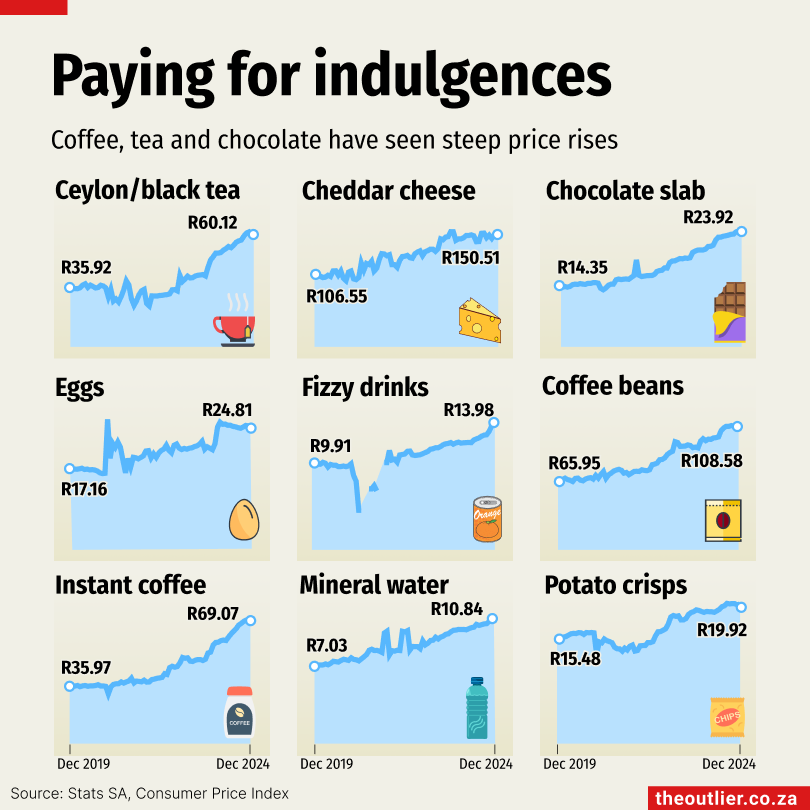
South Africa’s inflation rate is easing, with 2024 recording an average inflation of 4.4%, down from 2023’s average of 6%, according to Statistics SA.
However, inflation measures the change in the cost of goods, not their actual cost. Prices always rise over time, but when inflation cools, price hikes slow down.
Stats SA data show that in the past five years the price of bread has increased by 41%, milk by 29%, cooking oil by 62%, peanut butter by 54% and sugar by 56%.
Indulgent treats have also seen steep increases. The price of Ceylon tea nearly doubled between December 2019 and December 2024. And a global shortage of cocoa beans has driven up the price of chocolate (+66.7%) and instant coffee (+92%).
To calculate the Consumer Price Index, Stats SA uses the cost of services and goods, including food items and non-alcoholic beverages bought by the average household each month.
- Check out The Outlier’s Consumer Price Dashboard for more
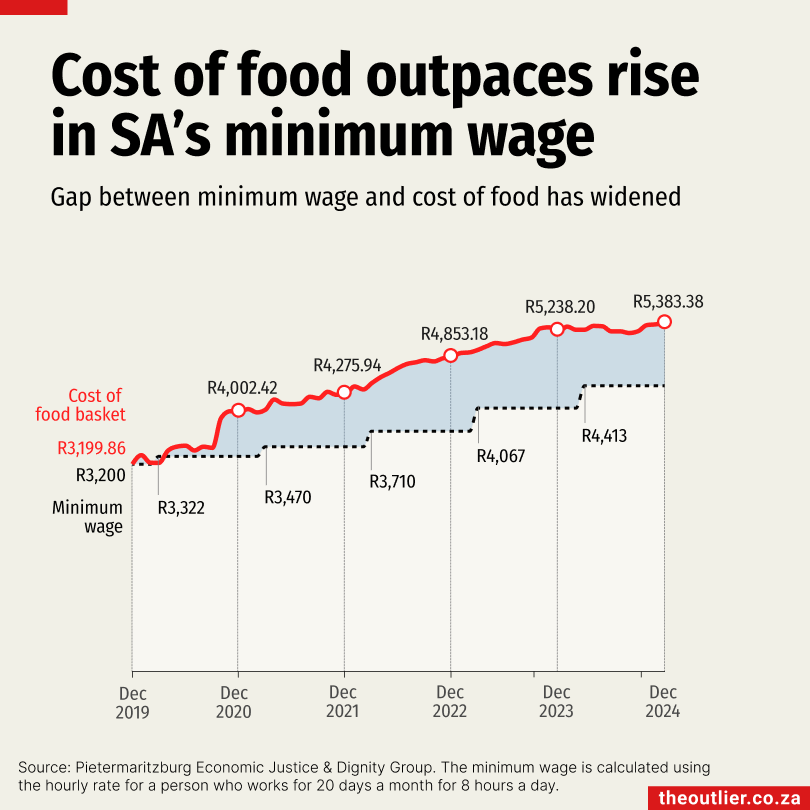
The gap between what minimum wage workers earn in South Africa and the cost of a basic food basket is widening.
The
The cost of this basket shot up during the Covid-19 pandemic in 2020 – and has never really recovered. Over the past five years, the cost of the same basket has increased by R2,183.
Over the same period, the minimum wage has risen by roughly R1,200 – a 38% increase compared with the 68% increase in the price of the food basket.
In December 2024, minimum wage was around R4,400 a month for full-time work (20 days a month). According to Statistics SA, half of the country’s 13-million ‘employees’ earned R5,414 or less a month in 2022.
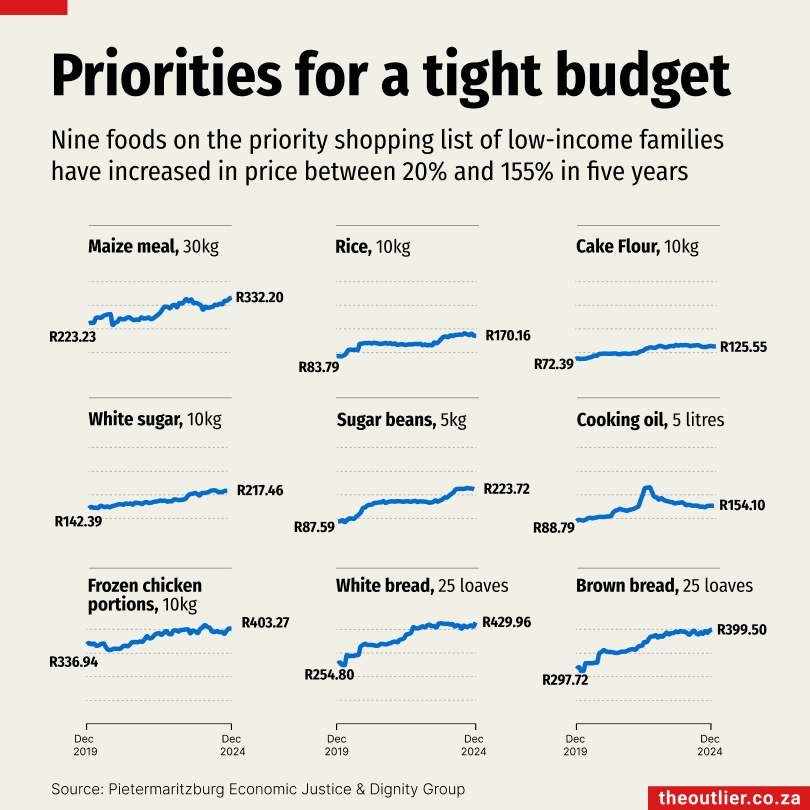
People living on limited budgets have to prioritise what they buy. For their Household Affordability Index, the Pietermaritzburg Economic Justice & Dignity Group (PMBEJD) tracks the prices of 44 items that are typically bought by women in low-income households of seven members.
The data includes items that women buy first to ensure their families are fed. The charts above highlight the price changes over five years for nine items considered essential, such as maize meal, rice and bread.
To buy just these items costs R2,900 a month. The price of sugar beans, a key staple, has risen by 155% in the past five years.
The priority foods may be filling, but include only two vegetables. Adding diversity to the meals with vegetables, proteins and other nutrients would cost an additional R2,475 a month. Prices of fruits and vegetables also tend to fluctuate seasonally, which can strain budgets even further.
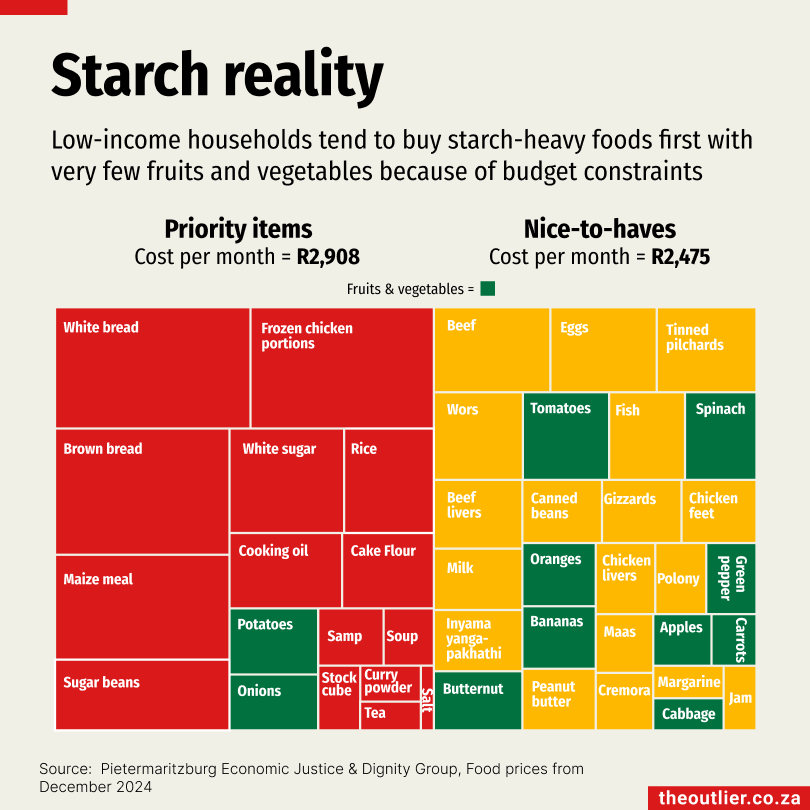
People living on limited budgets have to prioritise what they buy. For their Household Affordability Index, the Pietermaritzburg Economic Justice & Dignity Group (PMBEJD) tracks the prices of 44 items that are typically bought by women in low-income households of seven members.
The data includes items that women buy first to ensure their families are fed. The charts above highlight the price changes over five years for nine items considered essential, such as maize meal, rice and bread.
To buy just these items costs R2,900 a month. The price of sugar beans, a key staple, has risen by 155% in the past five years.
The priority foods may be filling, but include only two vegetables. Adding diversity to the meals with vegetables, proteins and other nutrients would cost an additional R2,475 a month. Prices of fruits and vegetables also tend to fluctuate seasonally, which can strain budgets even further.
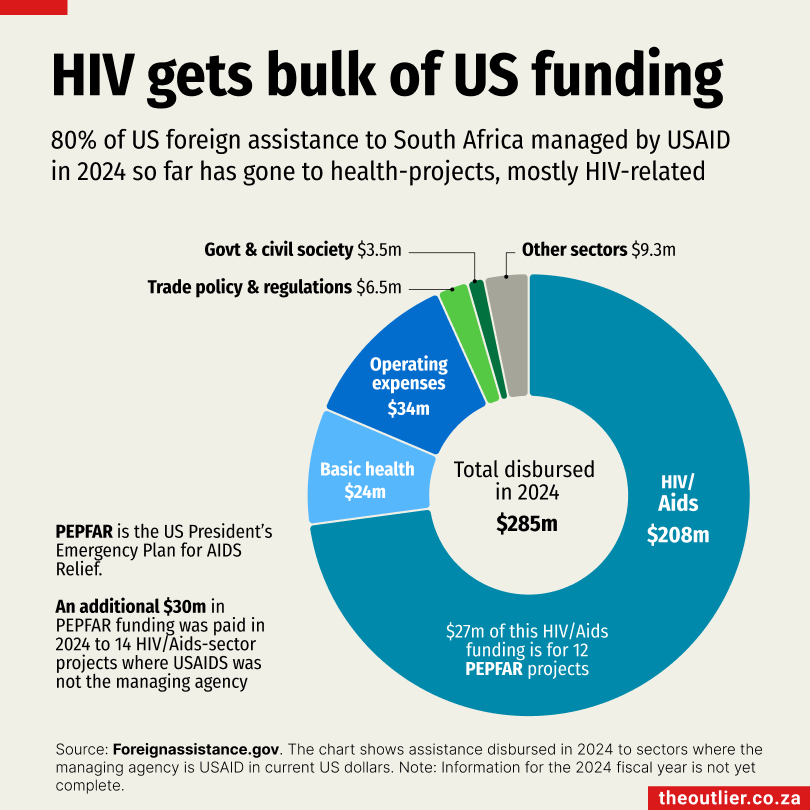
South Africa receives millions of dollars in aid from the US government, primarily for HIV/Aids programmes. On his first day as US president, Donald Trump froze all US foreign aid for 90 days, halting international programmes, causing layoffs and confusion.
According to ForeignAssistance.gov, the US paid out $72-billion in aid in 2023 and $41-billion so far in 2024. Programmes in SA received $545-million in 2023 and $335-million this year, mostly for health-related projects, like the President’s Emergency Plan for Aids Relief (Pepfar).
Pepfar was granted a waiver on 1 February to continue ‘urgent life-saving HIV treatment services’. But activities involving family planning, abortions, gender, diversity or inclusion programmes remain excluded.
USAID has managed 85% of this year’s payouts, including $27-million in Pepfar funds. A further $30-million was disbursed to Pepfar projects managed by other US agencies.
The six ‘top implementing partners’ are Wits University, Anova Health Institute, Right to Care, the TB/HIV Care Association, Aurum Institute and Health Systems Trust.
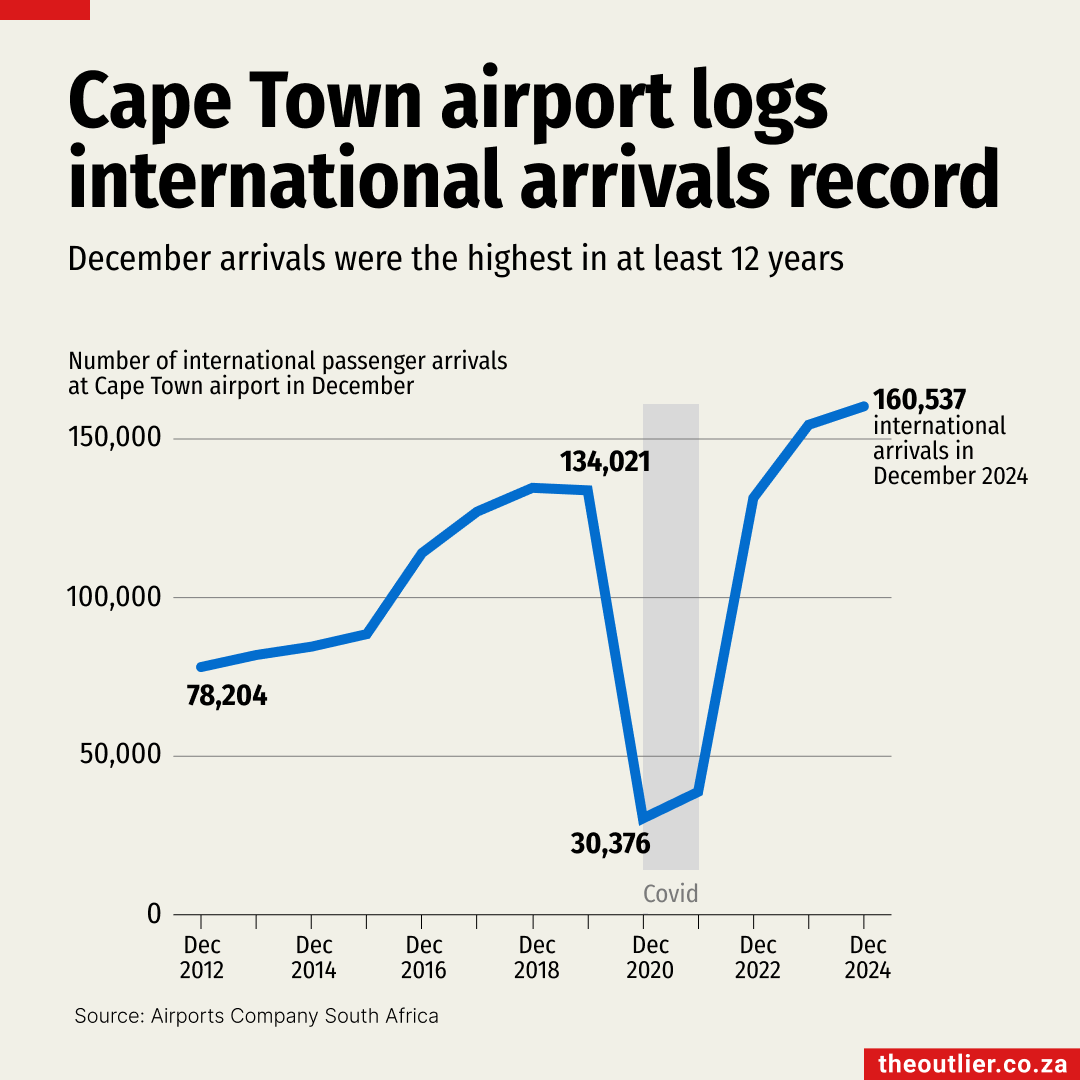
International flights carried more than 160,000 passengers to Cape Town International Airport in December 2024 – the highest number recorded for at least 12 years. December is the city’s busiest month for international arrivals, followed by January.
Overall, 2024 was a good year for Cape Town, with just over 1.4-million foreign visitors flying in, 120,000 more than 2023.
Cape Town airport’s international arrivals have clearly recovered from the Covid pandemic slump, unlike OR Tambo International in Johannesburg, South Africa’s busiest airport. Between 2017 and 2019, before pandemic travel restrictions were imposed, more than 4.5-million international passengers landed in Joburg a year. In 2024, just under 3.8-million arrivals were logged.
Direct flights from Europe appear to be driving the increase in arrivals in Cape Town. Three European airlines are set to offer more flights in 2025, according to Wesgro, the Western Cape’s tourism, trade and investment promotion agency.
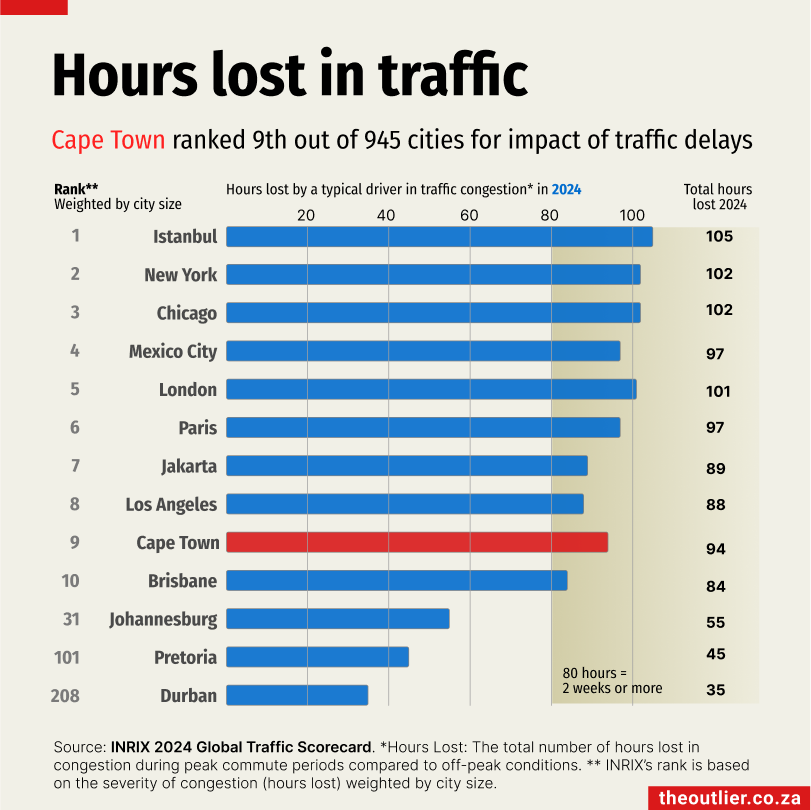
Cape Town was ranked ninth for traffic congestion out of more than 945 cities in the world in 2024. A typical driver lost 94 hours sitting in traffic, according to INRIX, a company that provides mobility data, in its 2024 Traffic Scorecard. That’s over two weeks lost just sitting in traffic.
Cape Town’s congestion appears to be worse than it was in 2023, when a typical driver lost 83 hours, according to INRIX’s calculations. Johannesburg ranks 31st on the INRIX scale, with drivers losing 55 hours to traffic congestion in 2024.
INRIX describes the total time lost as “the difference between driving during commute hours versus driving at night with little traffic”. Cities are ranked based on the severity of congestion (hours lost) weighted by city size.
Unfortunately, the 2024 Traffic Scorecard doesn’t include any African urban centres outside of South Africa, which is a pity because it would be interesting to see how Lagos, Nairobi and even Harare compare to Cape Town.
Istanbul was ranked as the city most-impacted by congestion in 2024, with 105 hours lost.
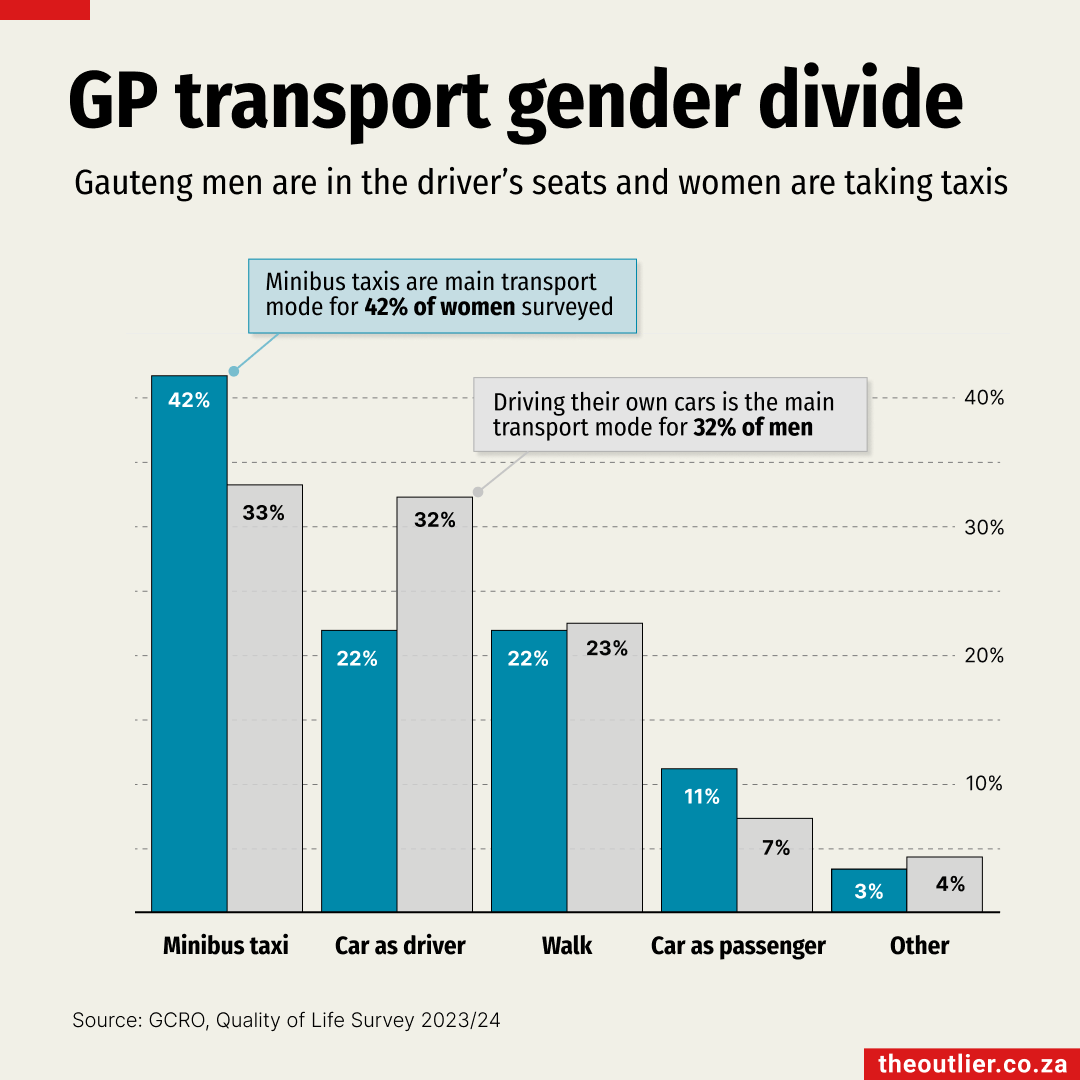
- 42% of women in Gauteng take minibus taxis, 33% of men
- Almost one-third of men in GP drive cars to get around
- Women are more likely to be passengers than men
A striking gender divide in transport choices is highlighted by the latest Gauteng-City Region Observatory’s Quality of Life survey: women are more reliant on minibus taxis than men, and men are more likely to drive cars as their main mode of transport.
Of the more than 3,700 people interviewed, 42% of the women said they primarily travelled by minibus taxi compared with 33% of men; whereas 32% of men said driving was their main way of getting around, against just 22% of women.
Women are also more likely to be passengers in private cars than men. Passengers include people getting a ride with someone they know or paying for a ride in a private car, but excludes e-hailing and meter taxis.
The 2017/18 survey showed that 51% of women relied on minibus taxis, while only 16% drove cars. There has also been an increase in men driving cars – only 27% were driving in 2017.
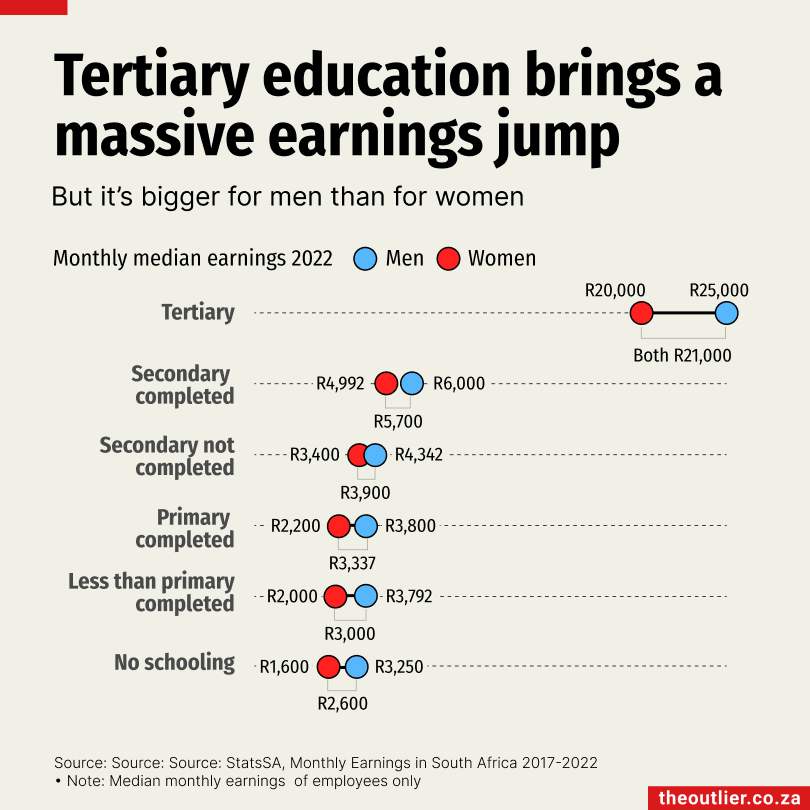
- Employees with tertiary qualification earn higher salaries
- Post-school education results in +R15,000 gap in median monthly earnings
- Women with tertiary education earn 25% less than men
Education has a big effect on earnings. Employees with tertiary education earn a lot more than people who are less educated, but regardless of the level of education, men still earn more than women, according to Statistics SA’s Monthly Earnings in South Africa 2017-2022 report.
The median monthly earnings of people with tertiary education who work for an employer were R21,000. This is R15,583 (or 288%) higher than the national median earnings of R5,417 for all employees.
For those who completed high school, median earnings were R5,700, slightly above the national median, but still far below those who carried on studying to obtain a post-school qualification.
For female employees with tertiary education, however, the median earnings were R5,000 (or 25%) lower than for male employees. Female employees who completed high school had median earnings of R4,992 a month, while male employees’ earnings were R6,000 a month, a 20% pay gap.
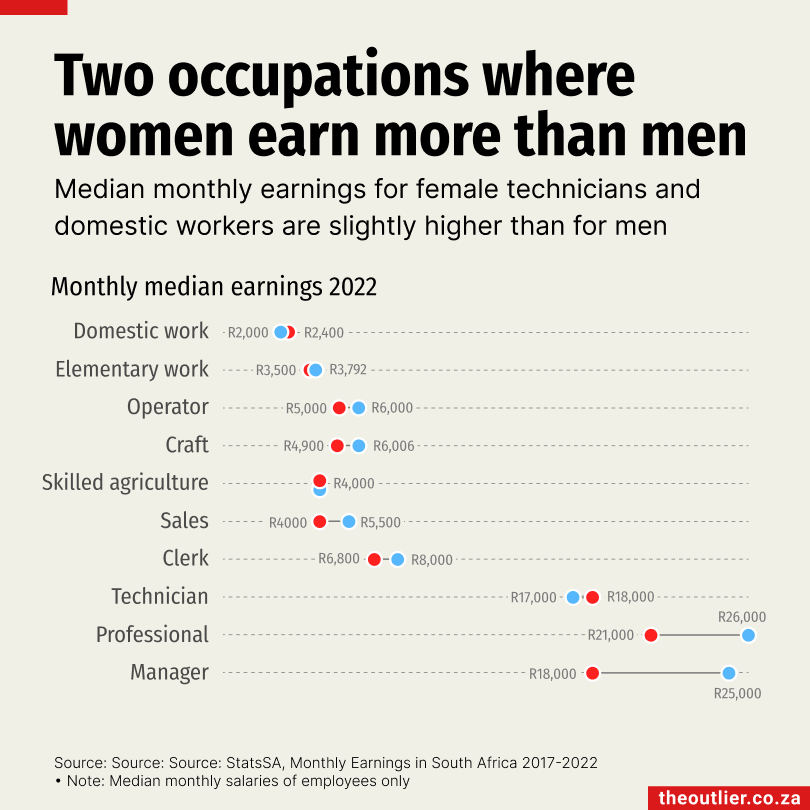
- The gender pay gap in SA grows wider in higher-paying roles
- Male managers earn R7,000 a month more than female managers
- Female technicians and domestic workers earn more than men
Women in South Africa earn 25% less a month than men, according to Statistics SA. Its report on monthly earnings between 2017 and 2022 shows that the median earnings for female employees were R4,800 a month, while the median for men was R6,000.
This gender pay gap typically grows wider in higher-paying roles, with men consistently earning more than women in most occupations. Male managers earned a median of R25,000, R7,000 more than female managers’ R18,000. Among professionals, the gap was R5,000, with men earning R26,000 compared with R21,000 for women in the same role.
There are, however, two exceptions where women’s median monthly earnings surpass those of men. Female technicians earned R18,000 a month in 2022, slightly higher than male technicians’ median of R17,000. Domestic work also saw women earning more, with female domestic workers earning a median of R2,400 compared with R2,000 for men.
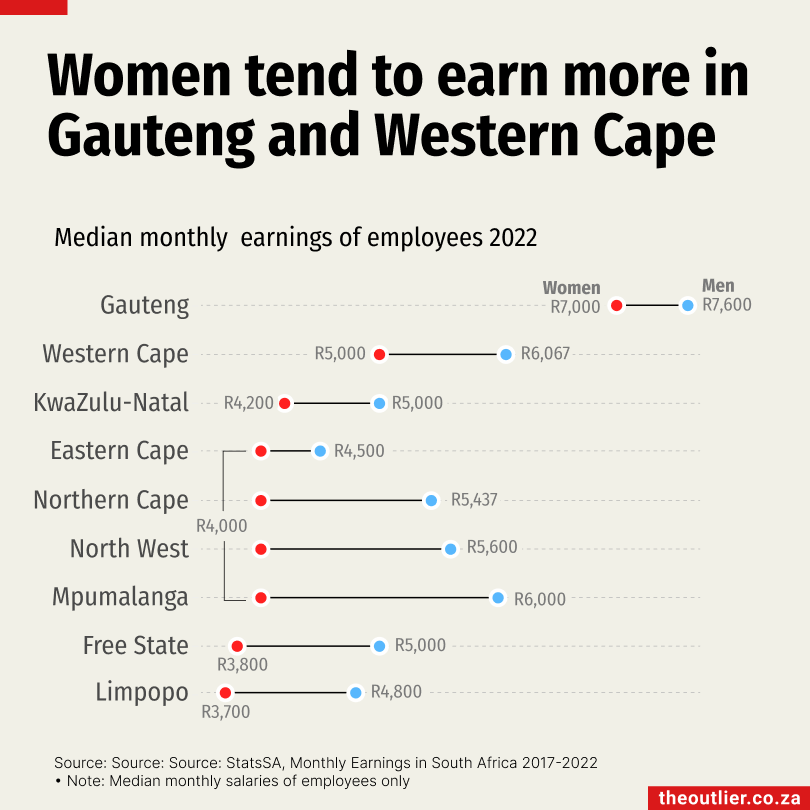
- Women generally earn more in Gauteng and the Western Cape
- Gauteng’s median earnings are R2,000 higher than national median
- Earnings growth is slower in provinces such as Limpopo and KZN
There are significant regional differences in women’s median earnings across the country, according to a Statistics SA report which tracks South Africans’ earnings between 2017 to 2022.
Women in Gauteng and the Western Cape consistently earned higher salaries compared with other provinces, with Gauteng’s median earnings reaching R7,000 by 2022 – higher than the national median for men (R6,000 a month). In contrast, provinces such as Limpopo and KwaZulu-Natal saw slower growth, with women in Limpopo earning a median R3,700 a month and R4,200 in KwaZulu-Natal. The national median for both sexes is R5,417 a month.
Other provinces such as the Eastern Cape and Free State have seen slower salary increases over time, with the median earnings of women in the Eastern Cape reaching just R4,000 by 2022.
In general, all employees earn more in Gauteng than anywhere else in the country. Overall median earnings are R2,000 higher there than the national median.
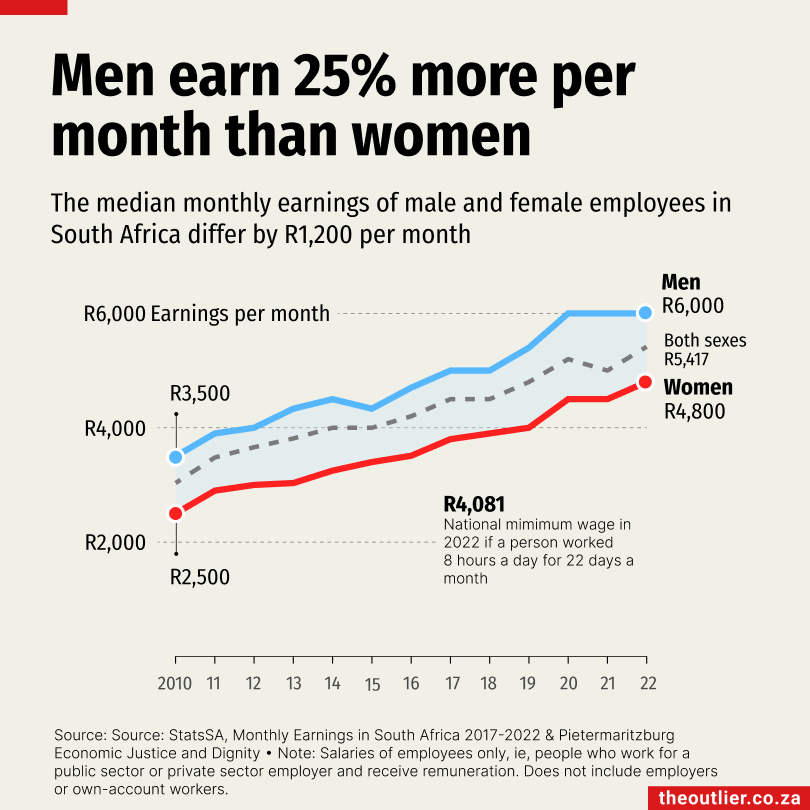
- Female employees earn 25% less than men in South Africa
- Their median monthly earnings in 2022 were R1,200 lower than men’s
- Women’s median earnings were R800 higher than the minimum wage
The median earnings of female employees in 2022 was R4,800 a month, 25% lower than R6,000 median for men.
There were 13-million employees in SA in 2022 – people who ‘work for an employer and receive payment’. Their median monthly earnings were R5,417 a month, according to a new Statistics SA report. Of those employees, 7.5-million were male with half earning less than R6,000 a month and half earning more than that. Of the 6-million female employees, half earned more than R4,800 and half earned less.
Women’s median earnings were slightly above the national minimum wage, which was about R4,000 a month in 2022 (based on working eight hours a day for 22 days). The average food basket for a low-income family cost R4,853.18 in December 2022, according to the Pietermaritzburg Economic Justice & Dignity Group.
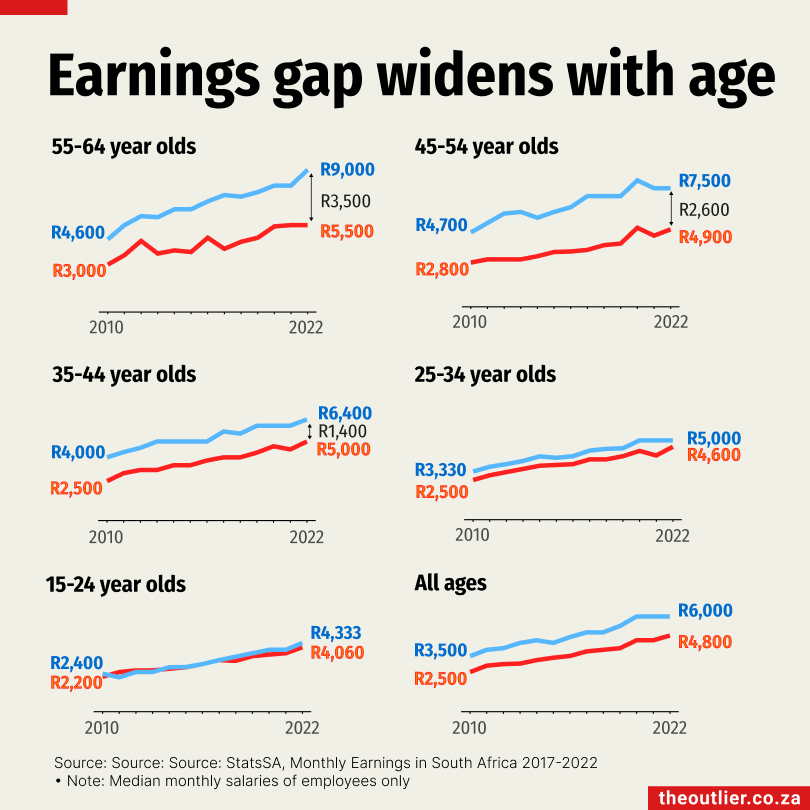
- Median earnings of women aged 55 to 64 are R3,500 less than men of same age
- Those women are out-earned by all men except by those under 34
- Experience rewards men more than women in earnings growth
The gender pay gap in South Africa not only persists but grows wider as employees age. According to Statistics SA’s Monthly Earnings in South Africa 2017-2022 report, women aged between 35 and 44 had median monthly earnings of R5,000 in 2022. This is R1,400 less than their male counterparts, whose median earnings were R6,400.
For women aged 45 to 54, the gap widened to R2,600, with women earning R4,900 compared with R7,500 for men. Among employees aged 55 to 64, the disparity was even greater: women earned a median of R5,500 a month, while men earned R9,000 – a difference of R3,500.
Despite earning more than younger women, women in the oldest age group were out-earned by men in all age groups except the two youngest (15- to 34-year-olds). This trend highlights the unequal value placed on experience and seniority between the sexes, with men seeing greater financial rewards as they age.
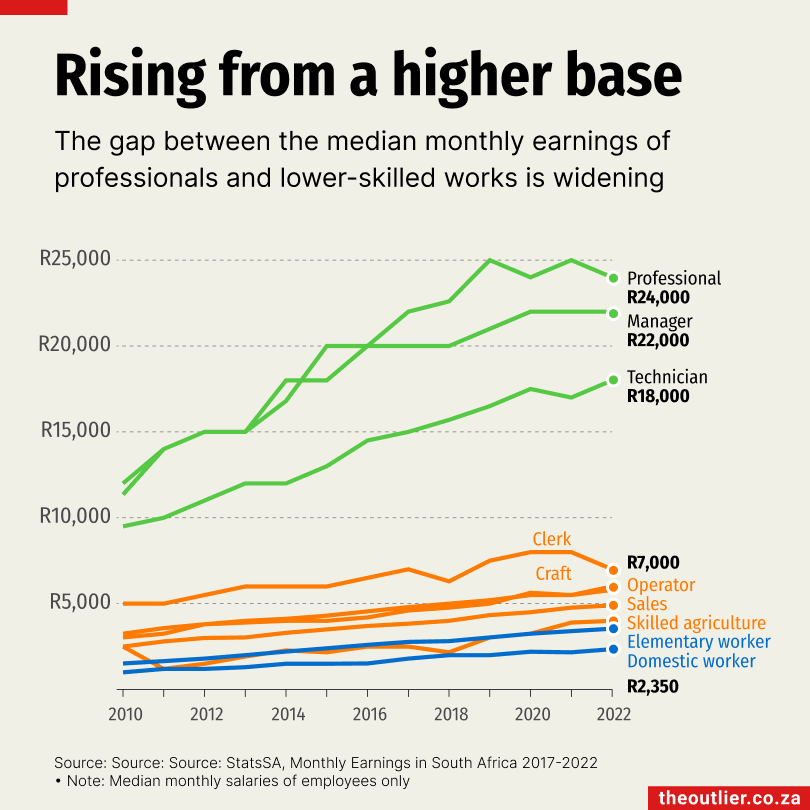
- Earnings gap between skilled and lower-skilled workers is widening
- Professionals’ earnings rise faster than those in lower-skilled jobs
- Managers’ earnings have increased by 83% since 2010, clerks’ by 40%
The gap between the median monthly earnings of skilled and less-skilled workers in South Africa is widening, according to a report on earnings compiled by Statistics SA.
The data, which covers the period 2017 to 2022, shows that professionals, managers and technicians consistently earn far more than employees in less-skilled occupations. By 2022, professionals were earning a median of R24,000 a month, followed by managers at R22,000 and technicians at R18,000. In contrast, workers in less-skilled roles, such as clerks (R7,000), craft workers (R5,000) and domestic workers (R2,350), earn significantly lower wages.
This growing disparity is evident when looking at the rate of increase in earnings over time. While skilled occupations (green lines) have seen steady growth, those in less-skilled roles (blue and orange lines) have experienced much slower growth. Managers earn 83% more than they did in 2010, while clerks’ earnings have increased by 40%.
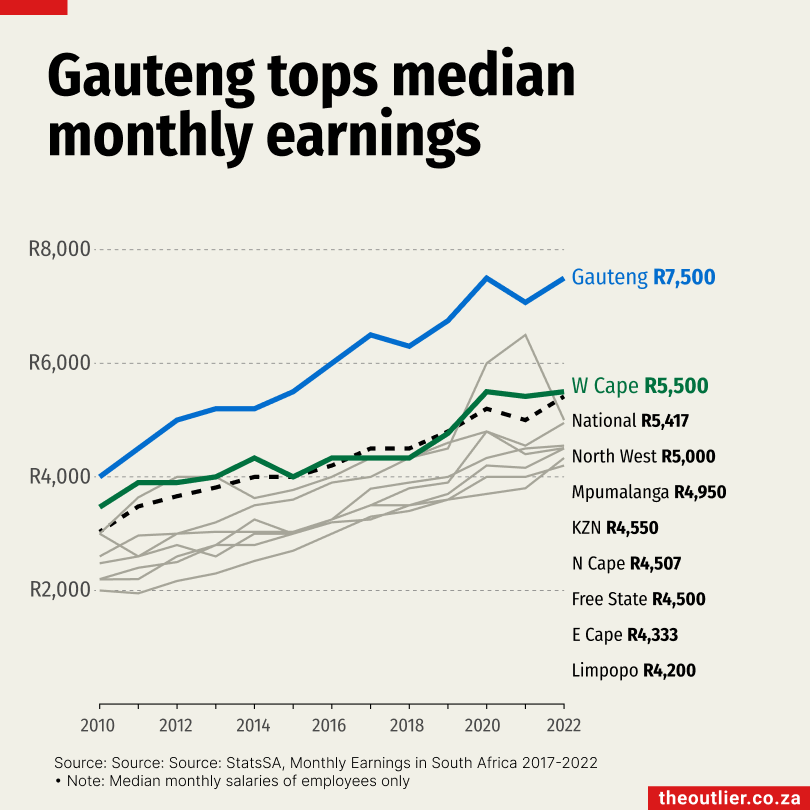
- Employees in Gauteng earn more than those in other provinces
- Median earnings in Gauteng were R7,500 a month in 2022
- This was R2,000 more than the median in the Western Cape
Where you live in South Africa influences what you earn. Employees – people who work for an employer and receive payment – earn more in Gauteng than anywhere else in the country. The median monthly earnings in Gauteng were R7,500 a month, R2,000 higher than the Western Cape, which had the second-highest median at R5,500, according to StatsSA’s Monthly Earnings in SA 2017-2022 report.
Median earnings represent the middle point in the range, so 50% of employees earn less than the median and 50% earn more. The national median in 2022 was R5,417. Gauteng and the Western Cape were the only two provinces with median earnings higher than the national median.
The two provinces with the lowest median earnings were the Eastern Cape and Limpopo, both of which were more than R3,000 lower than Gauteng.
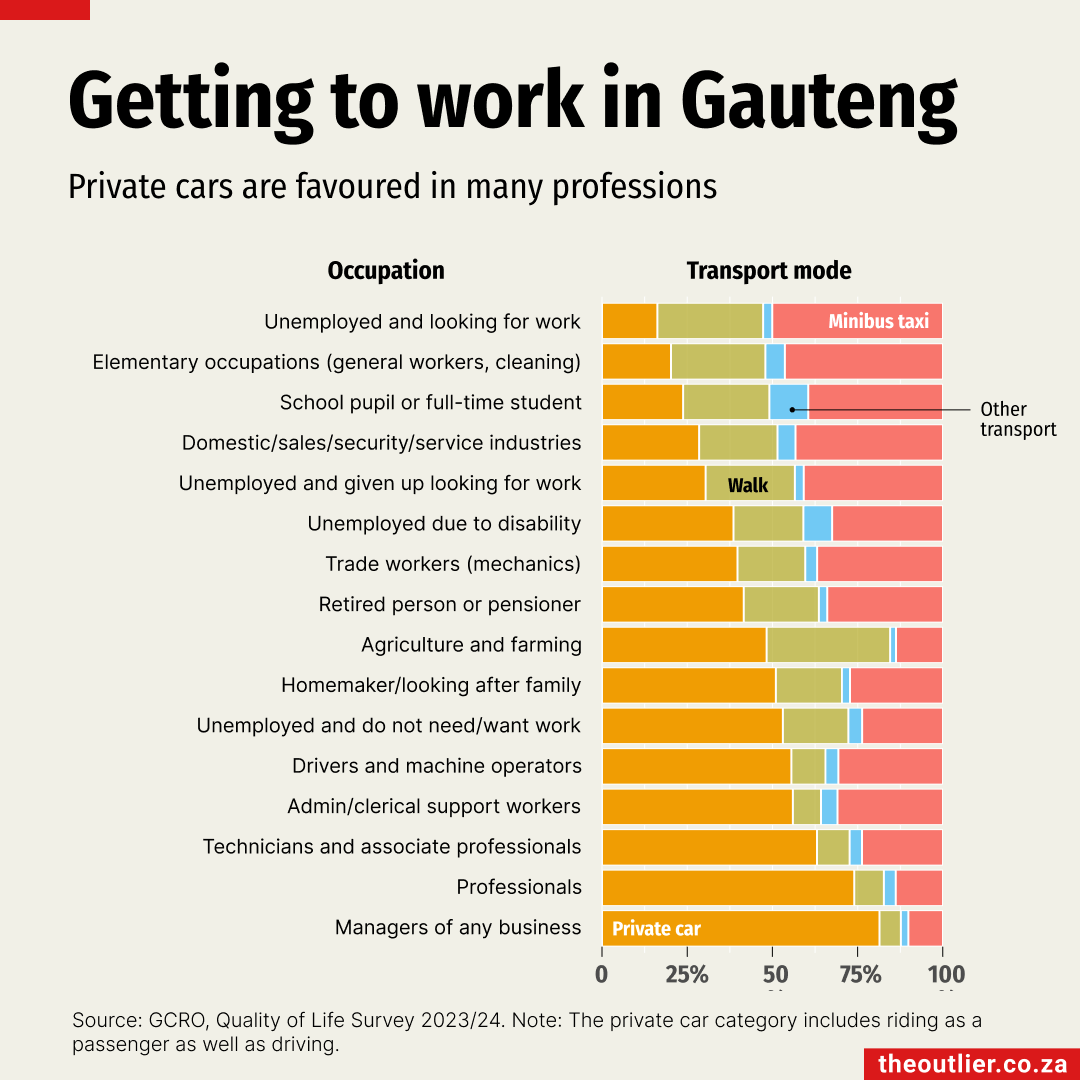
- Seven out of 10 GP residents in higher-income jobs use private cars
- More than a quarter of lower-income workers also rely on cars
- 50% of the job seekers surveyed say they rely on minibus taxis
Minibus taxis and private cars are the two primary modes of transport for people living in Gauteng, according to a province-wide survey conducted by the Gauteng-City Region Observatory (GCRO).
Of the 13,700 respondents, 36% said they relied on private cars and 38% said they used minibus taxis, with the choice differing according to their primary occupation.
More than 70% of respondents in professions generally associated with higher incomes, such as managers and professionals, use private cars, which includes driving as well as riding as a passenger. Even among employed people in lower-income roles, more than a quarter use private cars.
In contrast, car usage drops significantly for students, job seekers and those in elementary occupations (gardeners, general workers and cleaners). For these groups, less than 25% said they used private cars.
Half of the survey’s respondents who are unemployed and looking for work said they relied on minibus taxis.
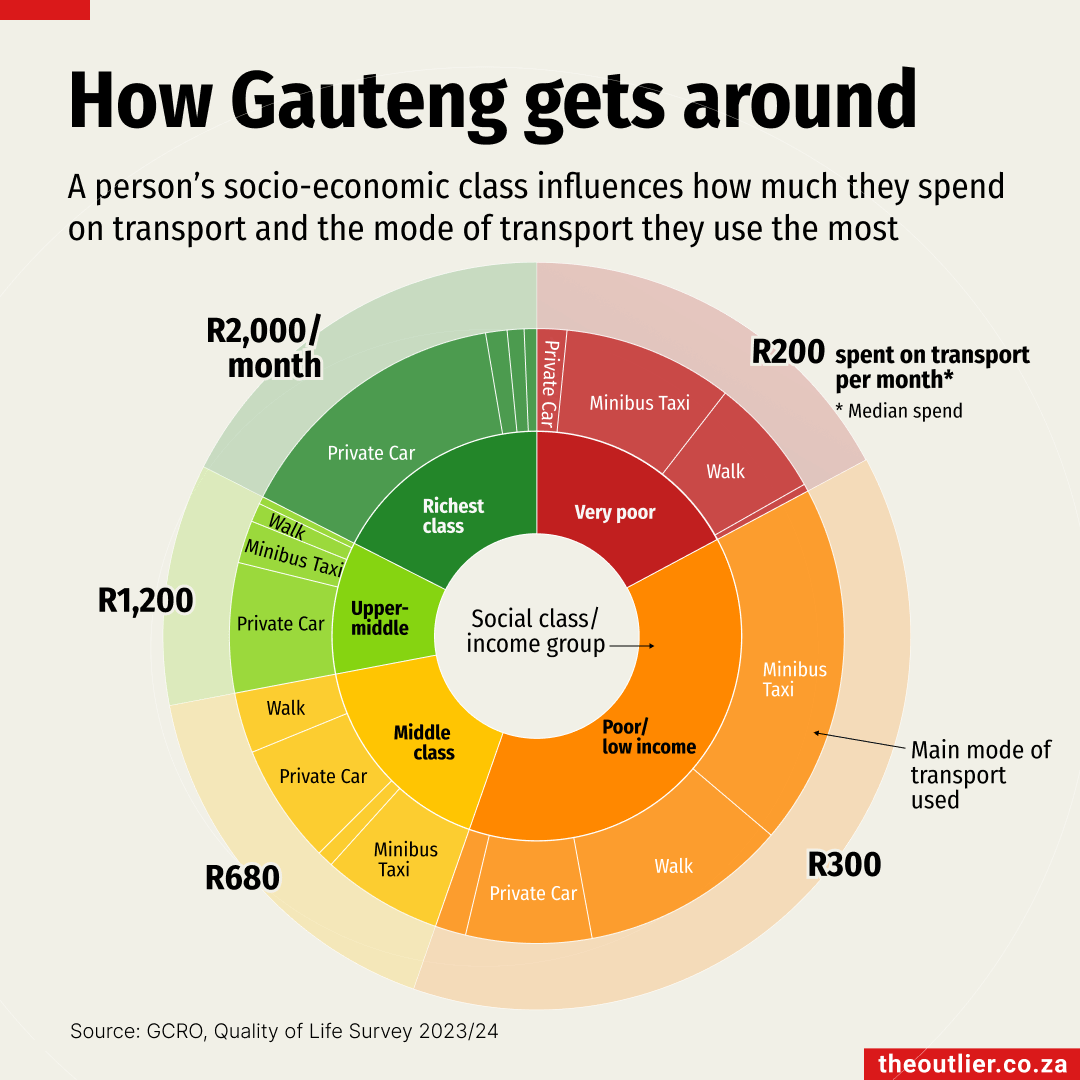
- Wealthier Gauteng residents are increasingly using private cars for transport
- They spend between R1,200 to R2,000 a month on getting around
- Transport spend for the province’s poorest is R200 to R300 a month
Most Gauteng residents fall in the lower socioeconomic class brackets and rely mostly on minibus taxis to get around. However, many say they opt for private cars when they can – either as drivers or passengers, according to the data from the Gauteng-City Region Observatory.
The GCRO’s 2023/24 Quality of Life survey shows that despite private cars being one of the most expensive options, the proportion of people driving has increased from 17% to 27% in the past 10 years.
The survey measures socioeconomic class on a one-to-10 scale based on factors such as household income, employment, education, medical aid membership and internet access. In general, the ratio of cars to other modes of transport increases with each wealth bracket: the higher the class, the more people use cars.
The survey also collects monthly transport spend from each respondent. The poorest spend as little as R200 a month on transport, while the wealthiest spend R2,000.
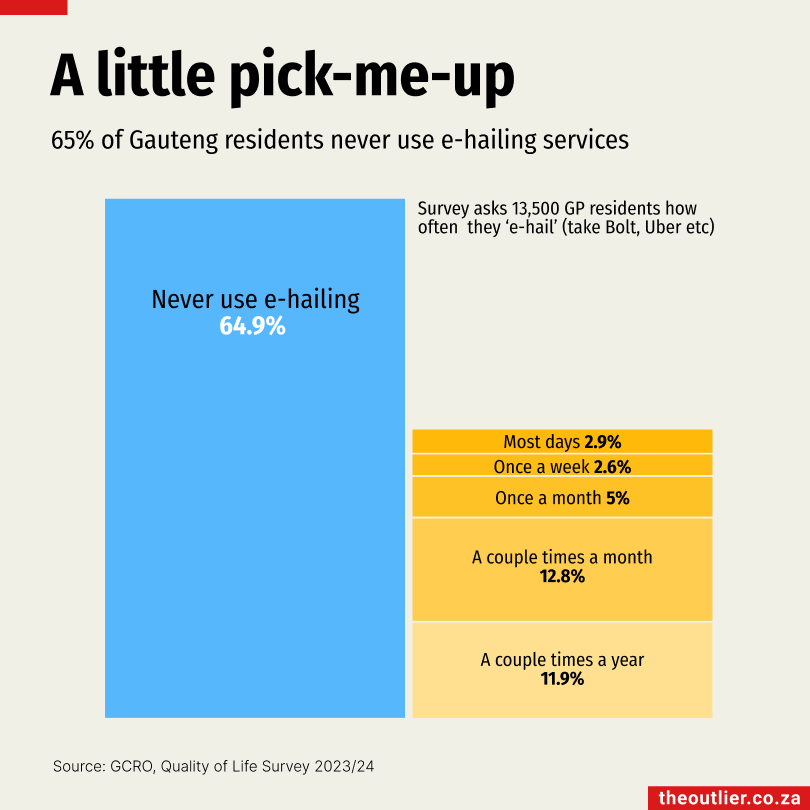
- Almost two-thirds of Gauteng residents never use e-hailing
- Survey shows only 1.2% use e-hailing as primary transport
- More women than men regularly use e-hailing services
Despite Bolt and Uber bringing massive changes to the transport landscape in South Africa’s cities, the Gauteng-City Region Observatory’s 2023/24 Quality of Life survey shows that few Gauteng residents make regular use of e-hailing services.
Of the people 13,700 people surveyed, almost two-thirds said they never use e-hailing services at all. For those who do, most only e-hail a couple of times a month. Only 1.2% said they use ‘e-hailing or metered taxis’ as their main mode of transport.
The GCRO surveyed people across the province, including areas far from the big metros where e-hailing services are primarily available. The 2023/4 survey included a separate question on e-hailing specifically.
The majority of regular e-hailing users rely primarily on minibus taxis. They likely take Ubers when minibus taxis aren’t available. More women than men e-hail, and the majority of e-hailing taxi users are in the lower and middle social class brackets.
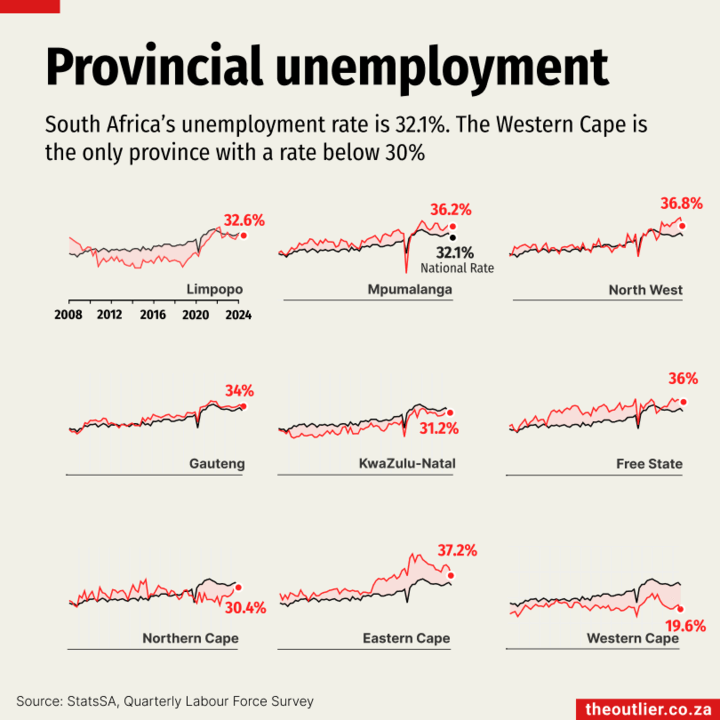
- The Western Cape has the lowest provincial unemployment rate at 19.6%
- Gauteng, which has the largest labour force, has unemployment of 34%
- The Eastern Cape has the highest at 37.2%, but improved since a Covid peak
Unemployment is not evenly distributed across South Africa. The national unemployment rate was 32.1% for the July to September 2024 period, according to Statistics SA’s Quarterly Labour Force Survey.
The Western Cape is the only province with an unemployment rate below 30%. Currently at 19.6%, it has consistently remained below the national average since 2008.
Gauteng, the country’s economic powerhouse with the largest labour force of 7.6-million people, has an unemployment rate of 34%. KwaZulu-Natal, which has the second-largest labour force of 4-million people, has an unemployment rate of 31.2%. Its employment rate has been slightly below the national rate for more than a decade.
The Eastern Cape has the highest provincial unemployment rate at 37.2%, but the good news is that is has been improving since it peaked during the Covid pandemic.

- Half of South Africa’s working-age population is under 35
- Only 6-million people under the age of 35 are employed
- Unemployment rate for 15- to 24-year-olds is 60%. Global rate is 13%
Young people under the age of 35 make up half of South Africa’s working-age population. Yet only an estimated 6-million young people out of a potential 21-million are employed, according to Stats SA’s Quarterly Labour Force Survey for July to September 2024.
The 60.2% unemployment rate for those aged 15 to 24 is far higher than the global average, which the International Labour Organization estimates at 13%.
The unemployment rate is the percentage of the labour force that is unemployed. But the labour force excludes people classified as not economically active – including students, home-makers, people who are ill or have disabilities, people too young or old to work as well as discouraged work seekers.
In the 15 to 24 age group, 73% are not economically active, which is expected as many are still in the education system. In the 25 to 34 age group, where the unemployment rate is 40%, about one in four are classified as not economically active.
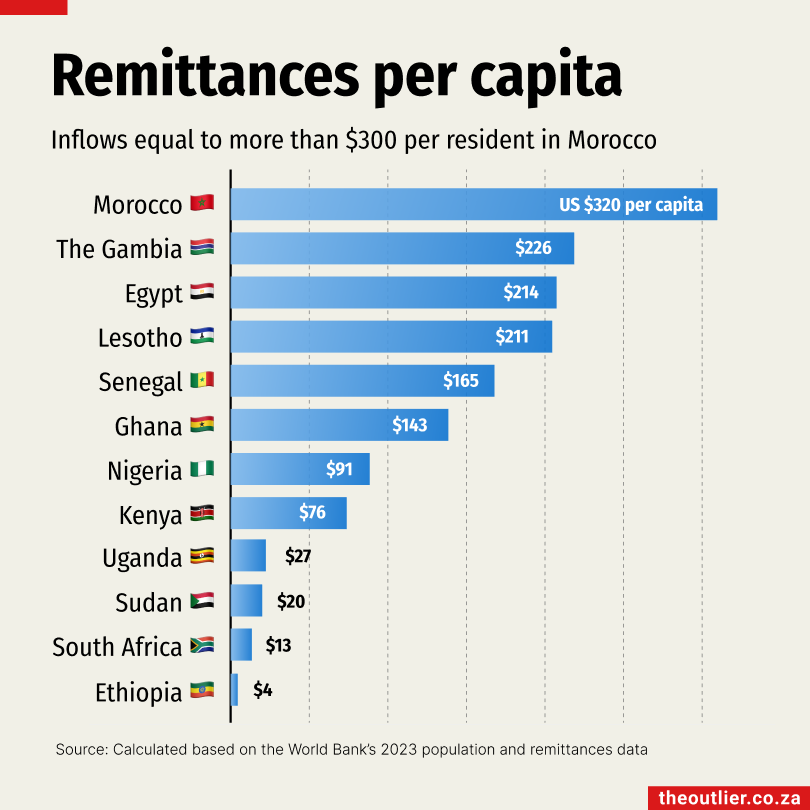
- In Morocco, remittances are worth $320 a person a year
- Ethiopia’s large population dilutes remittances to $4 a person
- Remittances in at least 13 African nations equate to +$100 a person
Remittance per capita highlights the effect of population size on how far incoming funds stretch. What would it look like if the total money sent home every year by citizens working abroad were divided equally among everyone in the country?
Nigeria, Africa’s second-largest remittance recipient in 2023, received $20-billion. But as the most-populous African nation, this amounts to just $91 a person – about R4 a day or R1,600 for the year.
For the 126-million people in Ethiopia, the remittance of $591-million only comes to $4 per citizen for the year. But in at least 13 countries including Ghana, Senegal, Lesotho, Egypt and The Gambia, remittances equate come to more than $100 a person, which gives us insight into the impact of sending money home.
In this thought experiment, Moroccans are the real winners. In a country with a population of 38-million, the $12-billion sent home last year equates to $320 a citizen.
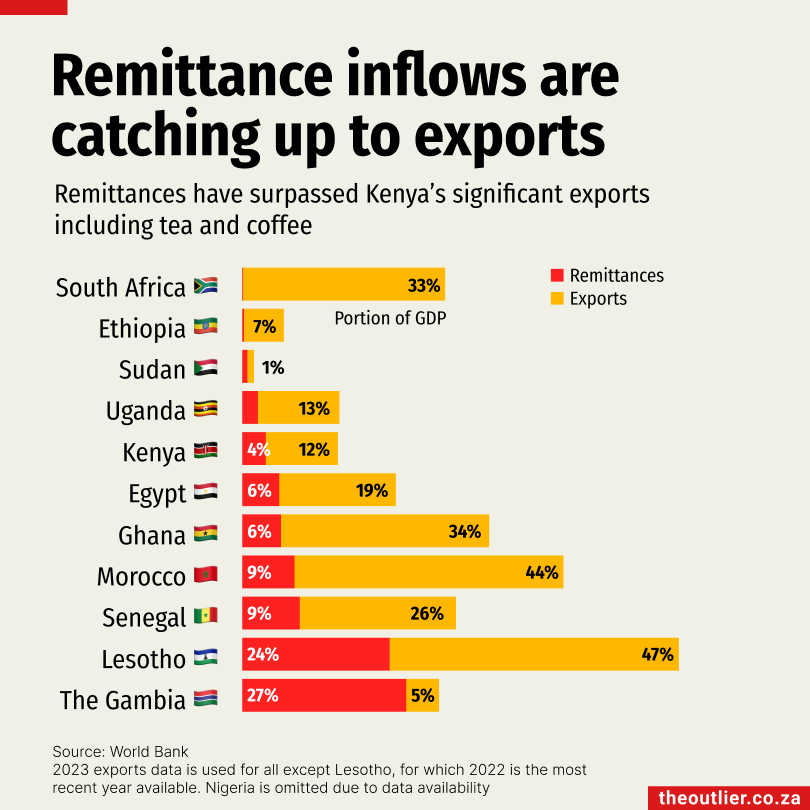
- Remittances form significant portion of GDP for many African countries
- Exports still lead, but remittance contributions catching up
- Remittance value is more than double Kenya’s main export: coffee and tea
Although exports still contribute more to the GDP of most African states, remittances are beginning to surpass some major export categories.
Kenya’s biggest goods export category – coffee, tea, mate and spices – makes up almost 25% of all its exports and is valued at $1.6-billion, according to 2023 UN Comtrade data.
Although Kenya’s exports constitute a significantly larger portion of its economy than remittances, the gap is narrowing, with remittances reaching $4-billion in 2023.
In Senegal, the $2.9-billion it received in remittances contributed the equivalent of one-third of the country’s export value to GDP.
Kenya’s central bank accounts for the ‘steady and resilient flow’ of remittances as a result of the development of mobile money platforms, internet-based channels of remittances and supportive policy.
The only African countries where remittances exceed total export value are Comoros and The Gambia.
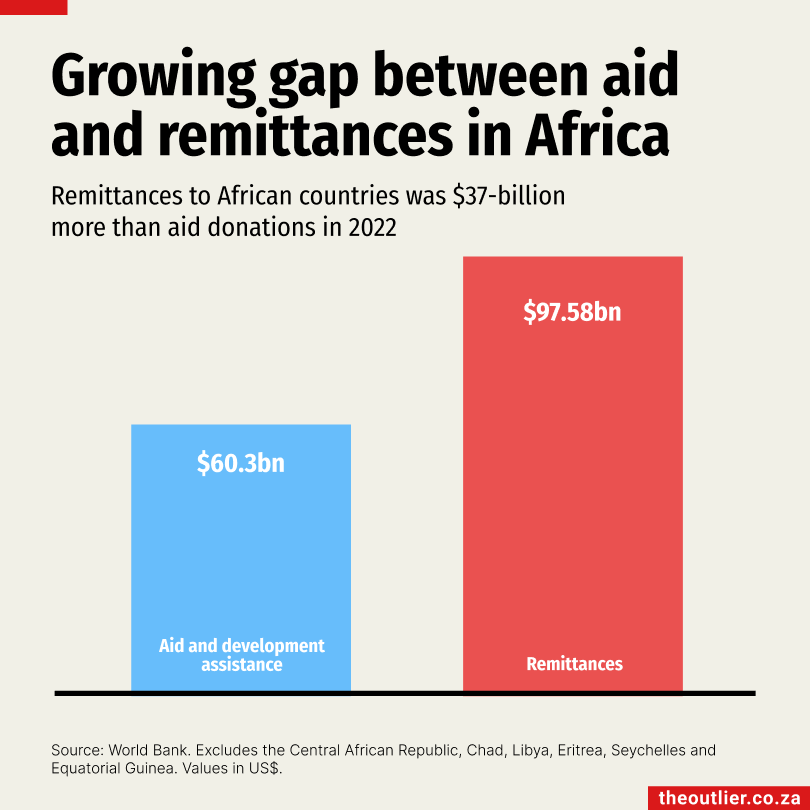
- African states receive more money from citizens abroad than from aid
- Families in rural areas are particularly reliant on remittances
- Remittances in 2022 surpassed development assistance by $37-billion
There is a perception that charity, donations and development aid given by the Global North is what is keeping African citizens and economies afloat. Yet the combined totals of foreign aid and development assistance to Africa in 2022 was $37-billion less than formal remittances from the African diaspora.
Because remittance money is often directly sent to people in rural areas who may have no other sources of income, the decrease in aid to African countries likely means that family members working abroad have been bearing the cost of everyday necessities normally associated with foreign aid, such as medical care. The Covid pandemic illustrated recipients’ reliance on remittances when other finance flows declined.
Note: 2022 is the most recent year the World Bank has aid data for. As informal remittance channels are not accounted for, the data likely only represents a fraction of the actual value received.
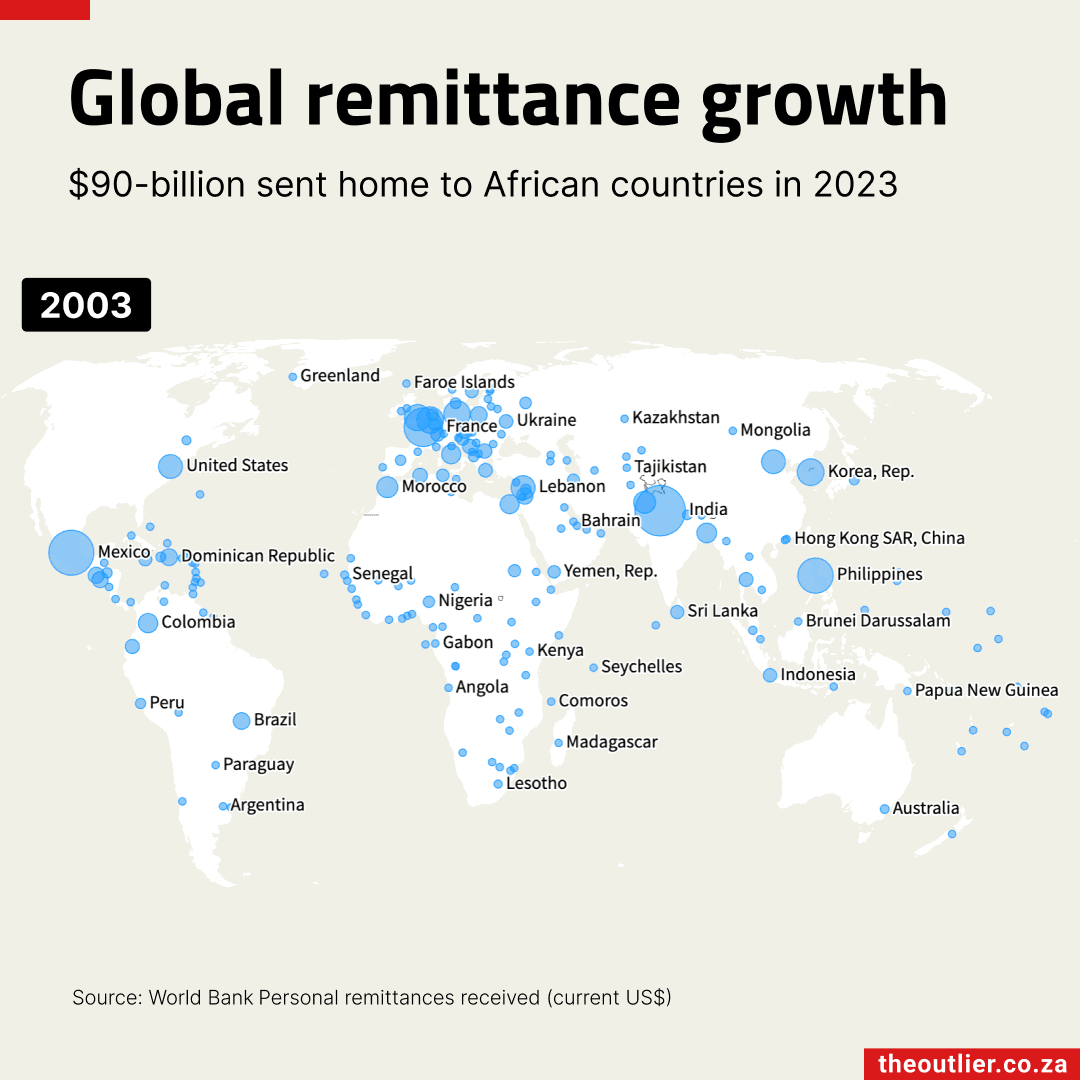
- Global remits are surging, benefitting major economics like India, Mexico
- In Africa, Egypt and Nigeria are two of the biggest beneficiaries
- Remittances are becoming key for some countries’ economic development
Over the past two decades, global remittances have grown significantly. India, Mexico, China, the Philippines and France were the top five recipients of remittances last year, according to the World Bank.
African countries recorded more than $90-billion, with Egypt ranked the seventh-largest recipient worldwide, and Nigeria ninth.
Remittances are important for economic development, and the UN has identified them as key to achieving its Sustainable Development Goals. Countries are developing policies to encourage remittances, which support households and local economies.
The growth reflects not only how much easier it has become to send money ‘back home’, but also suggests a growing focus on data collection. While the World Bank’s figures, based on the IMF’s balance of payments guidelines, offer a window into global transfers, informal channels remain unaccounted for, suggesting the true scale of remits may be even larger.
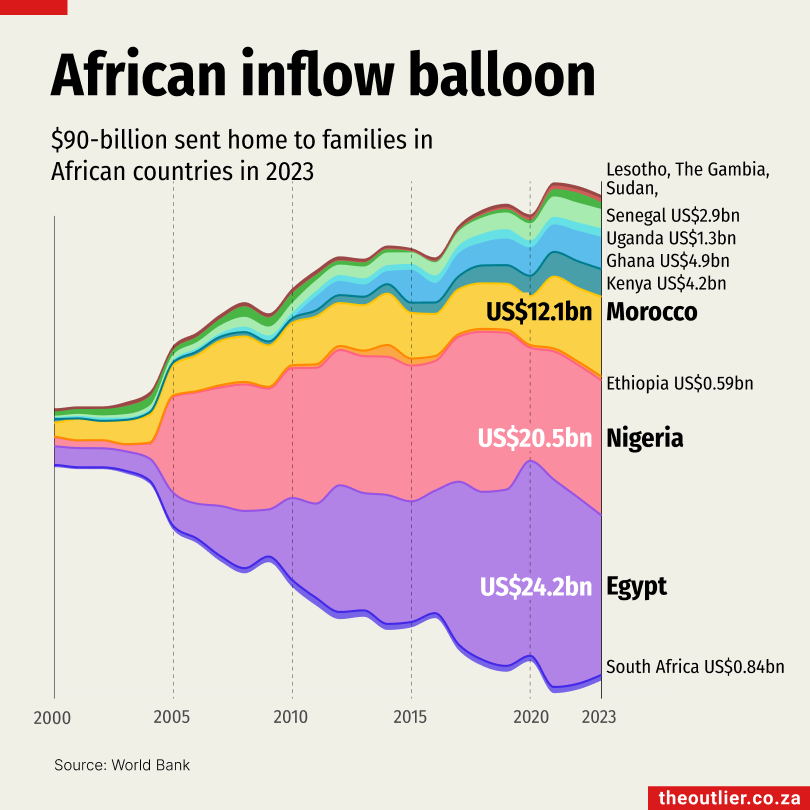
- Africa overall received $90-billion in remittances in 2023
- Egypt received $24.2-billion, which is 6% of its GDP
- Nigeria’s $20.5-billion equates to $90 per citizen
Remittances to African countries surpassed $90-billion in 2023, according to data from the World Bank.
Citizens working in foreign countries often send a portion of their earnings ‘back home’ to family members. These funds are playing an increasingly important role in their home countries’ economies.
Egypt and Nigeria, two of Africa’s biggest economies and most-populous countries, each receive more than $20-billion a year in remittances. Egypt has a population of 112-million people while Nigeria has double that.
Nigeria’s $20-billion amounts to the equivalent of $90 per citizen, and remittances make up more than 5% of the country’s GDP.
Even though Egypt’s remittance amount has been falling since 2021, remittances still account for more than $200 per citizen and 6% of the country’s GDP. The Egyptian government has been developing policies to encourage and support its citizens working abroad to remit.
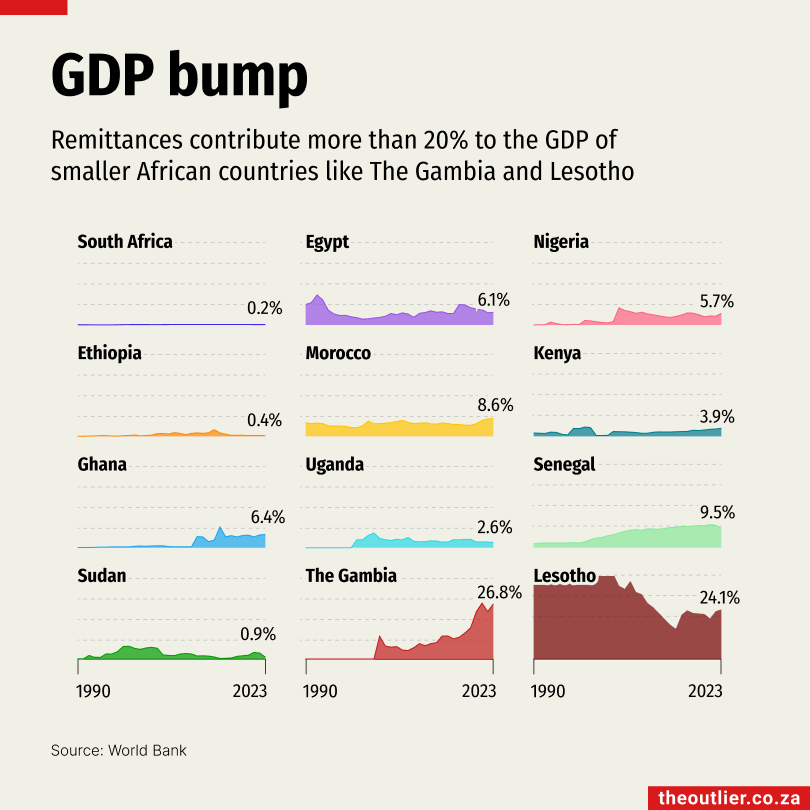
- Diaspora populations support national economies by sending money home
- Remittances account for over 20% of the GDP in Lesotho and The Gambia
- Governments are developing policies to encourage remittances
Remittances make up more than 5% of the national GDP of several larger African countries, including Morocco, Ghana, Egypt and Nigeria.
The funds workers send back to their families are especially significant for the small countries of Lesotho and The Gambia, which both have populations of below 3-million people.
In Lesotho, remittances made up nearly a quarter of the national GDP last year. However, this contribution has been decreasing in recent years due to the country’s growing diamond export industry.
In The Gambia, which has an agriculture-based economy, remittances accounted for nearly 27% of the GDP last year.
Governments have begun to take the contributions made by diaspora populations to their country’s economies seriously.
The central banks of Kenya, Uganda and The Gambia, for example, are improving data collection and reporting on remittance channels. Other countries are creating policy reforms to encourage sending money back home.
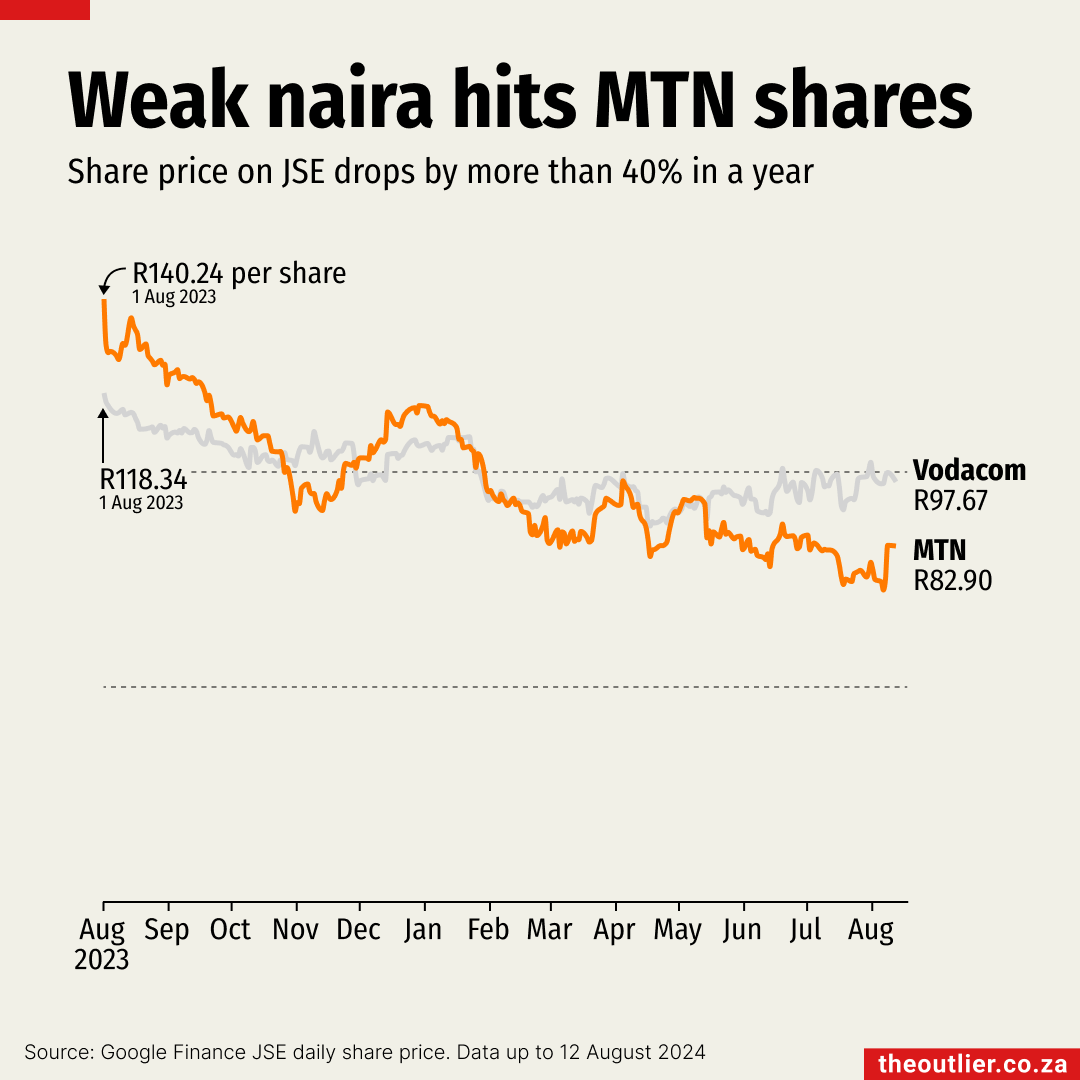
- MTN’s shares fall from R140 to R83 in the past year
- Nigerian subsidiary’s performance hit hard by naira devaluation
- MTN drops to a low of R72.70 on 6 August, before ticking upward
MTN shares have fallen by more than 40% over the past year, while its competitor Vodacom has seen only a modest decline on the Johannesburg Stock Exchange.
On 6 August, MTN’s share price fell to R72.70, sharply down from R140 on 1 August last year.
The decline in the share price can largely be attributed to the poor performance of its Nigerian subsidiary. The devaluation of the naira against the US dollar has severely affected its financial performance, the group said in its interim financials for 30 June 2024.
Despite improving its active data users and total subscriber numbers, MTN Nigeria reported a loss after tax of 519-billion naira for the six months to end June.
The naira has struggled to stabilise against the dollar since Nigeria ended its regime of regulated exchange rates in June 2023. This has led to its more than doubling against the dollar to around 1,590 naira.
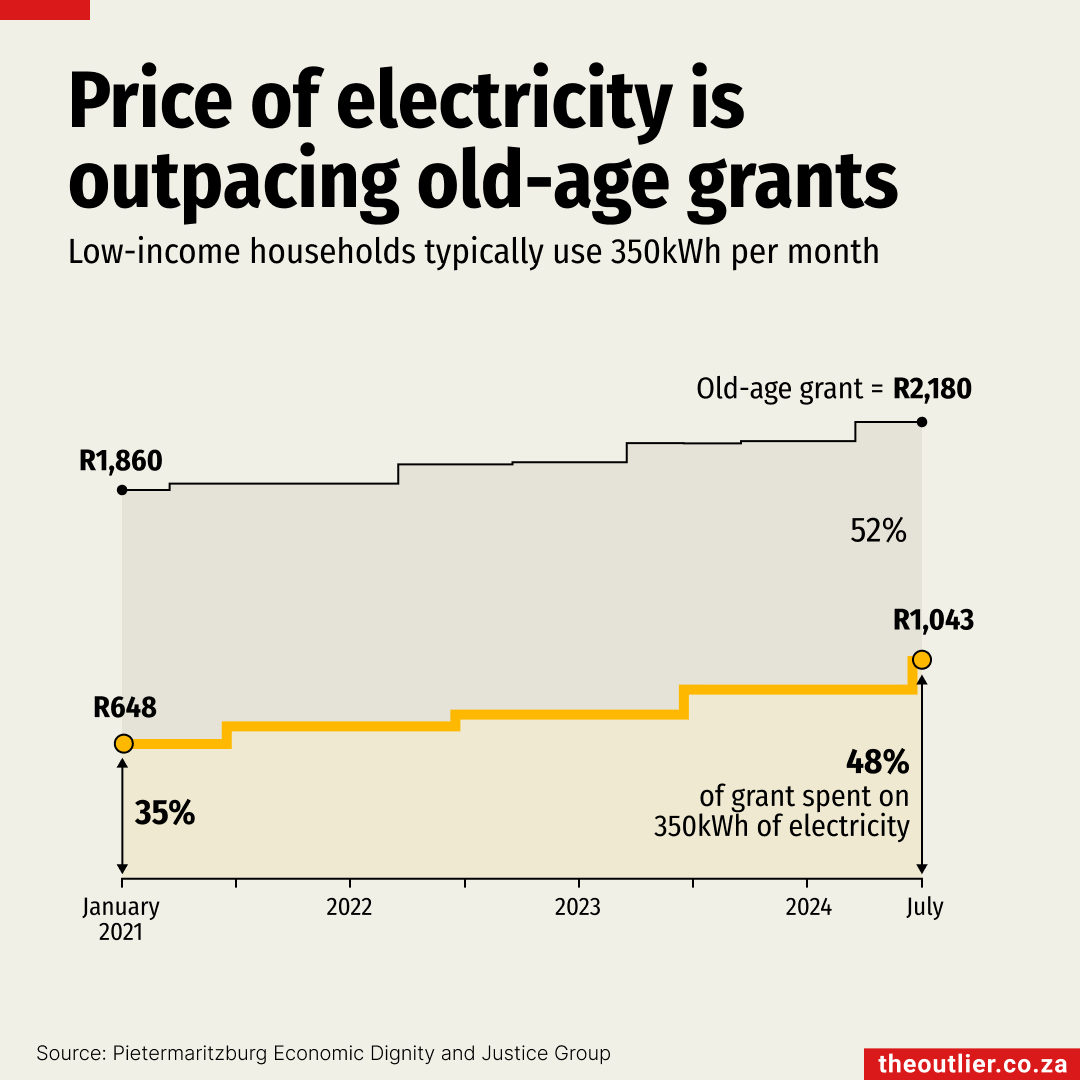
- Electricity consumes almost half of monthly old-age grant
- 350kWh of electricity increased by R136 in July
- The old-age grant rose by R90 to R2,180 a month
Municipalities increased their electricity prices by 12.72% in July, raising the cost of 350kWh of prepaid electricity from R907 in June to R1,043 – an increase of R136.
This basic amount of electricity is enough to run a toaster, kettle, stove, fridge and some lights for a month, according to estimates from the Pietermaritzburg Economic Dignity and Justice Group.
Since January 2021, the price of 350kWh of electricity has increased by almost R400.
Although the old-age social grant has increased by R90 from R2,090 a month last year to R2,180 a month, the increased cost of electricity is tightening the screws for South Africa’s 4.1-million pensioners.
Social grants should improve nutrition and help with the increasing cost of food, but ‘higher electricity costs are likely to remove money prioritised for monthly food purchases’, the NPO says.
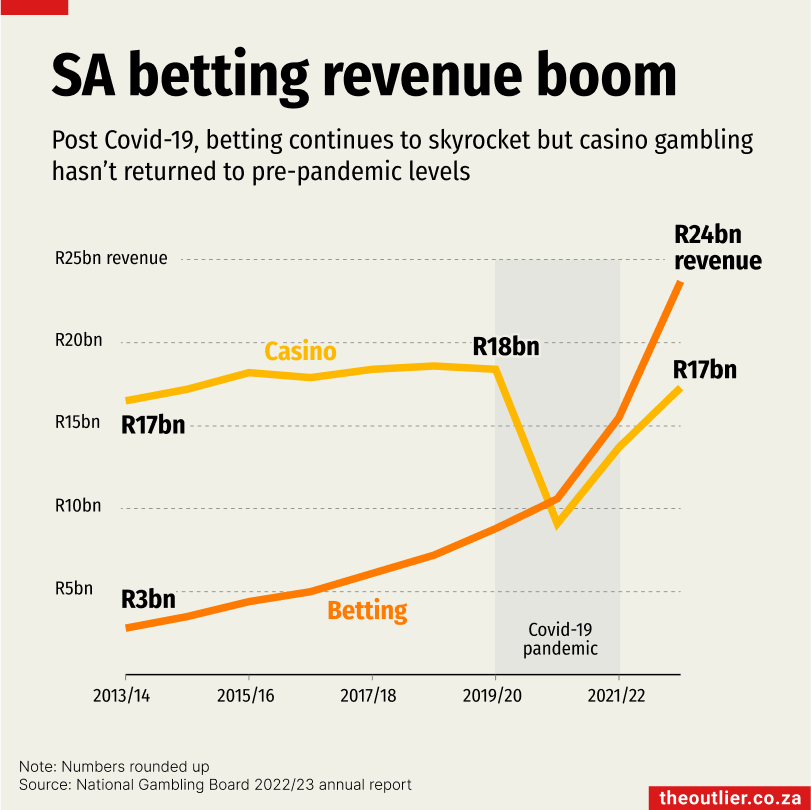
- SA’s gambling industry generated record R47.2bn in 2022/23
- Betting accounted for R24bn, outperforming casinos
- Online betting boosted by Covid-related lockdowns
South Africa’s gambling industry generated R47.2-billion in revenue in the past financial year, the highest amount ever recorded. This rocketing growth is being driven largely by online betting, which accounted for more than half the revenue, according to the National Gambling Board’s 2022/23 annual report.
When casinos closed down because of Covid-related lockdowns, gamblers turned to online gambling, with wagers made in just a couple of clicks on a computer or mobile device. In South Africa, about 80% of sports betting is done online.
Casino gambling, however, hasn’t quite recovered to pre-pandemic levels. In 2019/20, casinos were responsible for R18-billion of gambling revenue. When the pandemic hit that dropped to R9-billion. Last year, casino were still below pre-pandemic levels by about 6% at R17-billion.
More people have access to the internet and smartphones, which means punters no longer have to rely on physical outlets.
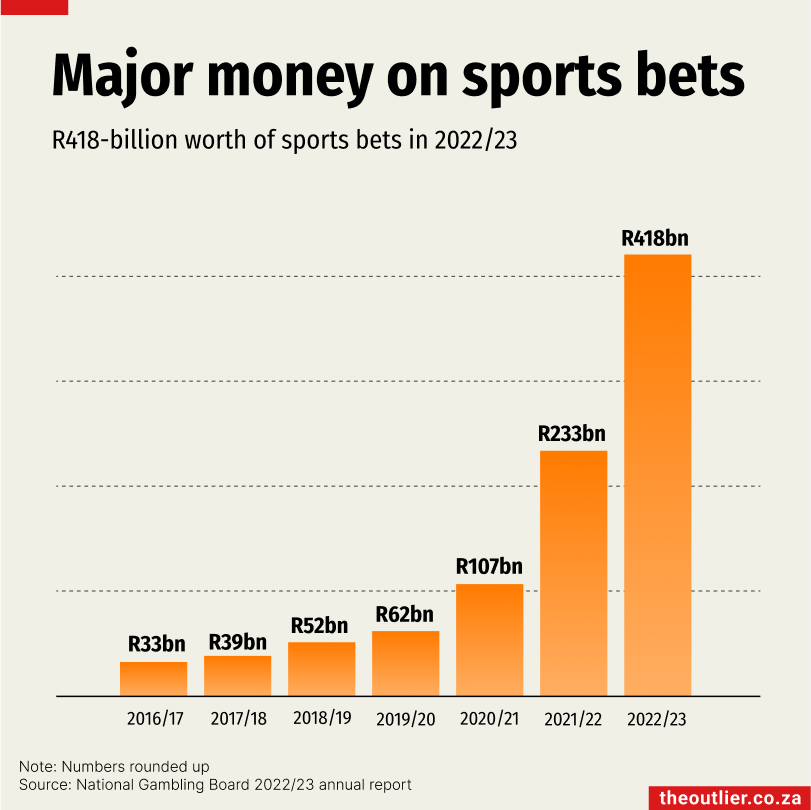
- Money on sports bets increased by 80% in one year
- R418-billion worth of sports bets were placed last year
- Betway, Hollywoodbets remain SA’s online betting giants
South Africans placed R418-billion worth of bets last year, an 80% increase from the R233-billion wagered in 2021/22.
Betting involves placing a wager through a bookmaker like PlayaBets and Easybet on the outcome of a specific event, usually a sports event, and can be done both in person or online.
In South Africa, about 80% of sports betting is done online, with wagers made with just a couple of clicks on a computer or mobile device. The total value of bets is significantly higher than overall revenue because these don’t include payouts and winnings are often ‘recycled’ to place further bets.
Well-known gambling companies such as Betway and Hollywoodbets dominate online betting – as well as advertising and sports sponsorship.
Newcomer SuperSportBet, the result of a partnership between Nigerian betting company KingMakers and MultiChoice, launched in January and is specifically targeting sports fans.
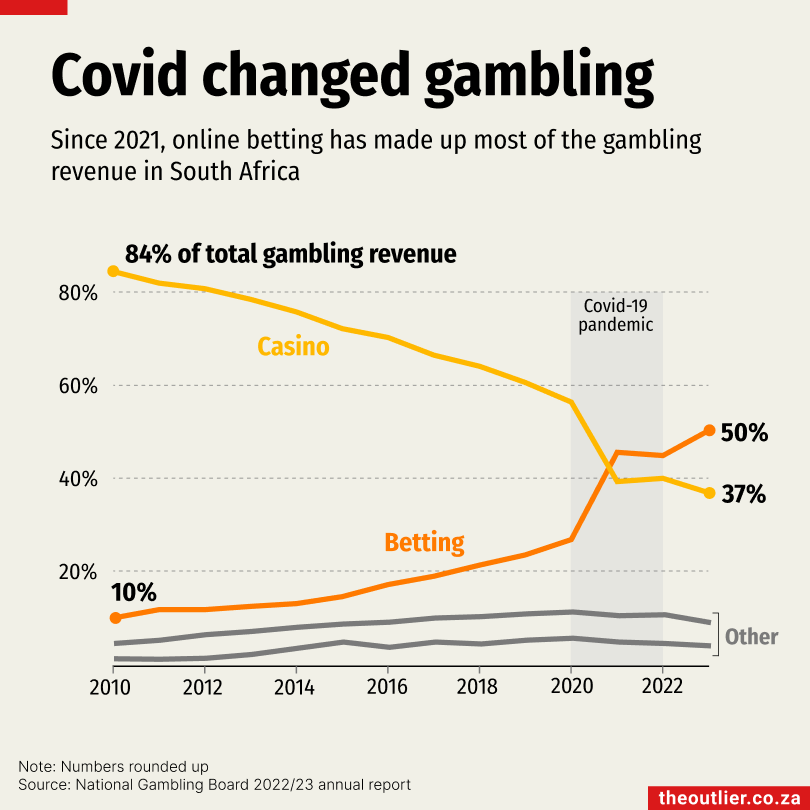
- Betting accounts for half of last year’s R47.3bn revenue
- Online betting has become dominant form of gambling in SA
- Casinos made just 37% of the total revenue in 2022/23
Betting accounted for more than half of South Africa’s gambling revenue of R47.2-billion in the past financial year, according to the National Gambling Board’s most recent annual report.
Casinos, on the other hand, accounted for just 37% of the total revenue in 2022/23, down from 84% in 2010.
Since the Covid-19 pandemic, there has been a shift to online betting and gambling, triggered by pandemic-related shutdowns.
Wider access to the internet and the increase in the number of smartphones means gamblers no longer have to rely on physical outlets and can gamble anywhere and anytime.
Sports betting, which involves placing a wager through bookmakers such as EasyPlay or Yesplay on the outcome of a specific event, is very popular.
South Africans placed R418-billion worth of sports bets last year, an 80% increase from the R233-billion in 2021/22. The total value of bets is significantly higher than overall revenue because winnings are often ‘recycled’ to place further bets.
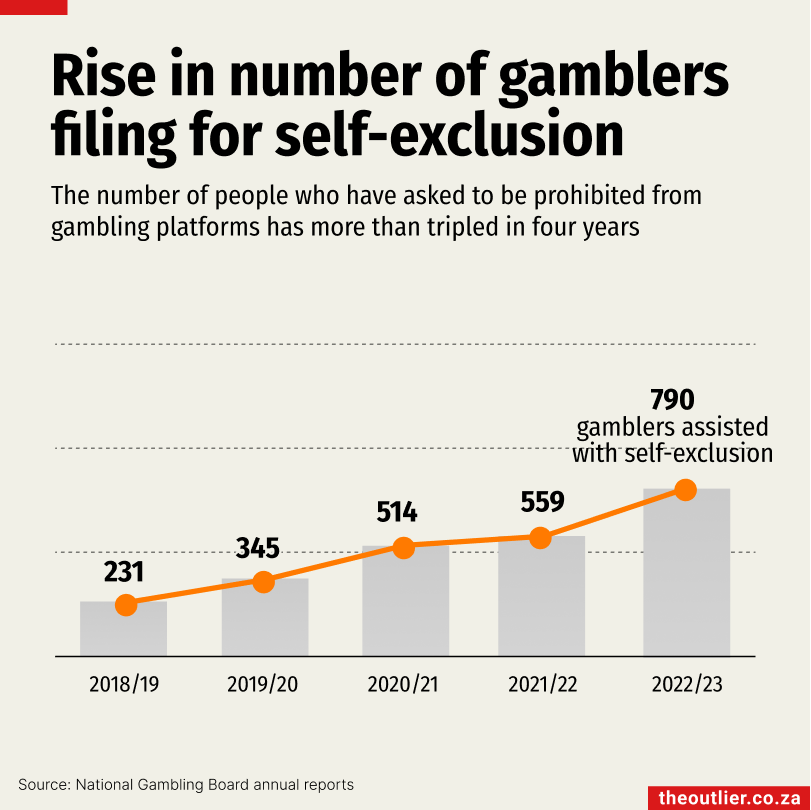
- Online betting is pushing up gambling addiction in SA
- More people asking to be banned from platforms, casinos
- 2,300 people referred by Responsible Gambling for treatment
Online gambling is drawing in new, younger audiences, attracted by the excitement of risk and the prospect of quick gains.
There’s a concomitant rise in gambling addiction and self-exclusions, which is when people request to be banned from gambling venues or online sites. The number of self-exclusions has rocketed by more than 240% in the past four years, according to the National Gambling Board.
The number of people referred by the Responsible Gambling programme for treatment doubled to 2,299 in 2022/23 after a Covid-19 lull. Most of these people were in the 25-to-35-year age group.
More than half of the young adults (those between 18 and 34) surveyed by InfoQuest said they gambled because they needed money. Just under 10% said they gambled because they were depressed, addicted or needed to escape from reality. Almost 40% used their winnings to gamble again.
Among those surveyed, sports betting was the most-often-placed bet, with an average incidence of 12 times a month.
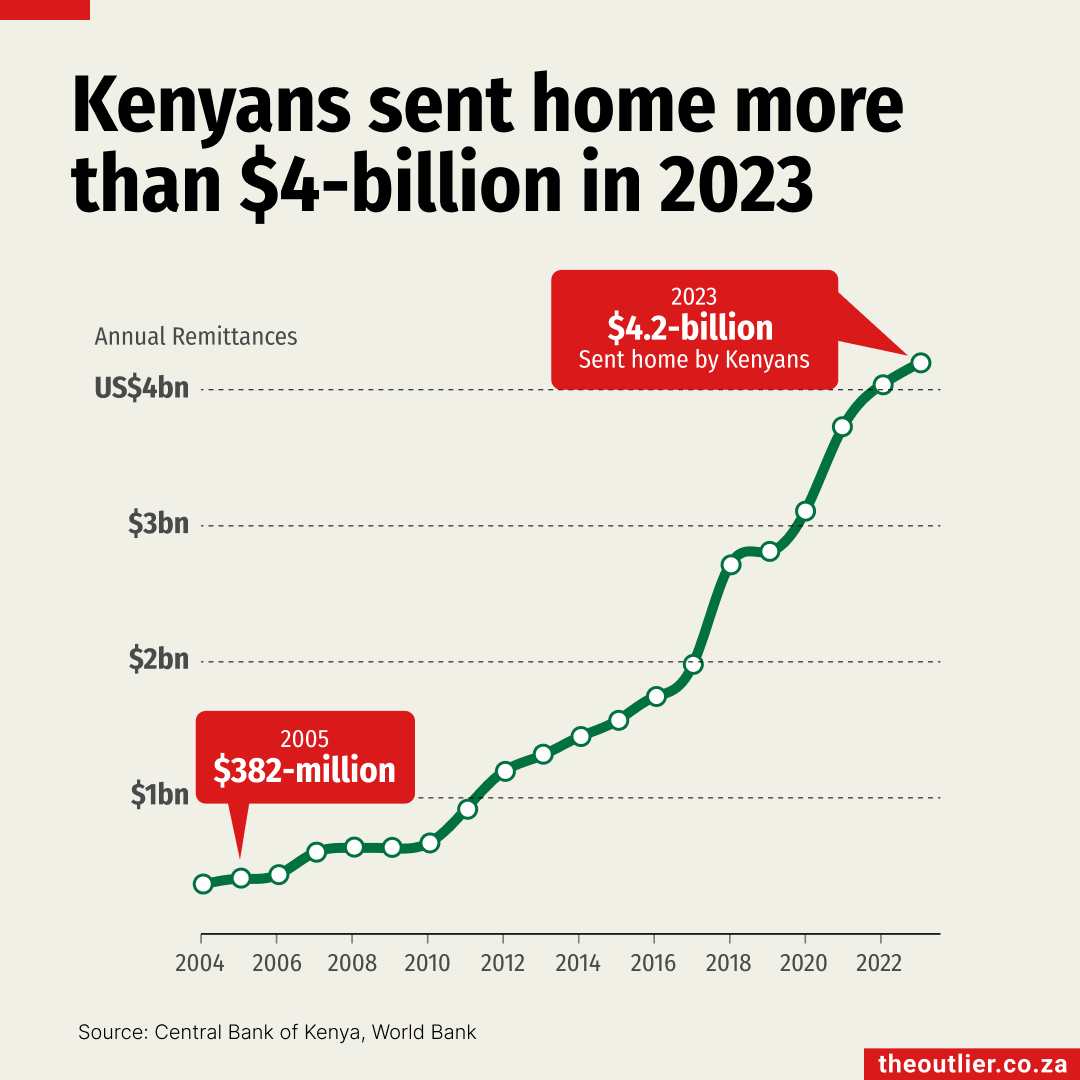
- In May 2024 Kenyans received $400-million from family members abroad
- Remittances are spent on household goods, food and land investments
- In 2023 remittances accounted for almost 4% of Kenya’s GDP
Kenyans living abroad are contributing significantly to Kenya’s GDP by sending money to their families. They sent $4.2-billion home in 2023.
The Central Bank of Kenya says these remittances are an important contributor to the economy and it is developing policies to encourage and regulate this form of investment.
In May 2024, Kenya received just over $400-million in remittances. About half was sent from the US, $35-million from Saudi Arabia and $27-million from the UK. Tanzania ($6.5-million) was the source of the most remittances from other African countries.
Remittances accounted for 2.1% of Kenya’s GDP in 2013. Ten years later, this had increased to 3.9%. Revenue from exports that year accounted for less than 12%.
Most remits are sent to family, who use the money for food and household goods or to invest in land and building.
Mobile money services such as M-Pesa are the preferred way to transfer funds.
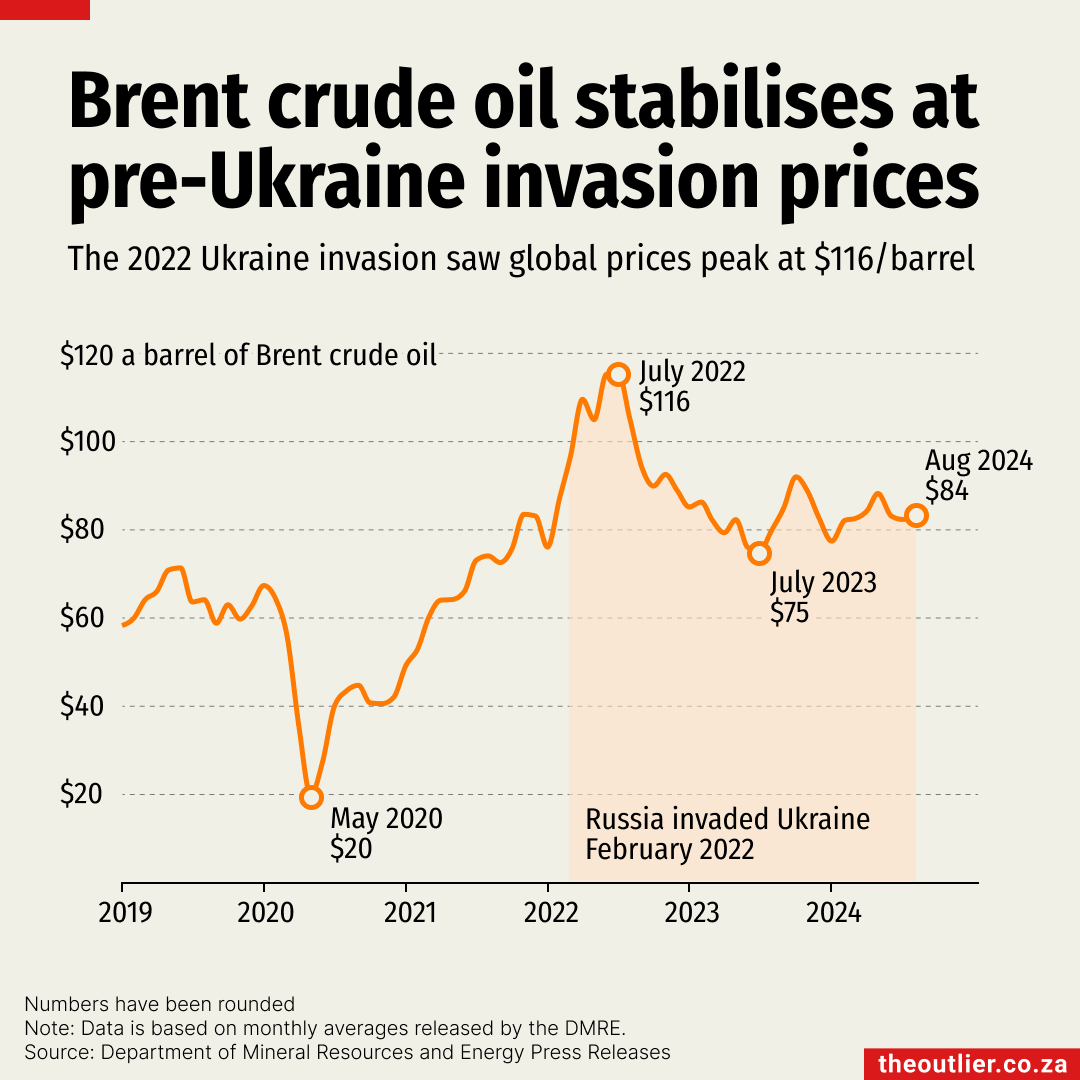
- Brent crude price stabilised since spike caused by Ukraine war
- In August 2024, Brent crude was trading around $84 per barrel
- The previous high was $116 per barrel in July 2022
Prices of Brent crude oil, an international benchmark, have stabilised since the spike caused by Russia’s invasion of Ukraine in February 2022. In August 2024, a barrel of Brent crude oil cost an average of $84, down from a peak average of $116 in July 2022, according to the department of mineral resources and energy.
In 2019, a barrel of Brent crude oil averaged $64. Fears of oil shortages and sanctions against Russia pushed crude oil prices up from February 2022.
The fluctuating Brent crude oil prices affects the cost of fuel in South Africa, where the basic fuel price makes up half the petrol price. The cost of a litre of 95 octane petrol in SA in August 2024 is R23.11, nearly R4 more expensive than it was pre-invasion (R19.62 in January 2022).
South Africa primarily imports Brent crude oil from Angola, Nigeria and Saudi Arabia.
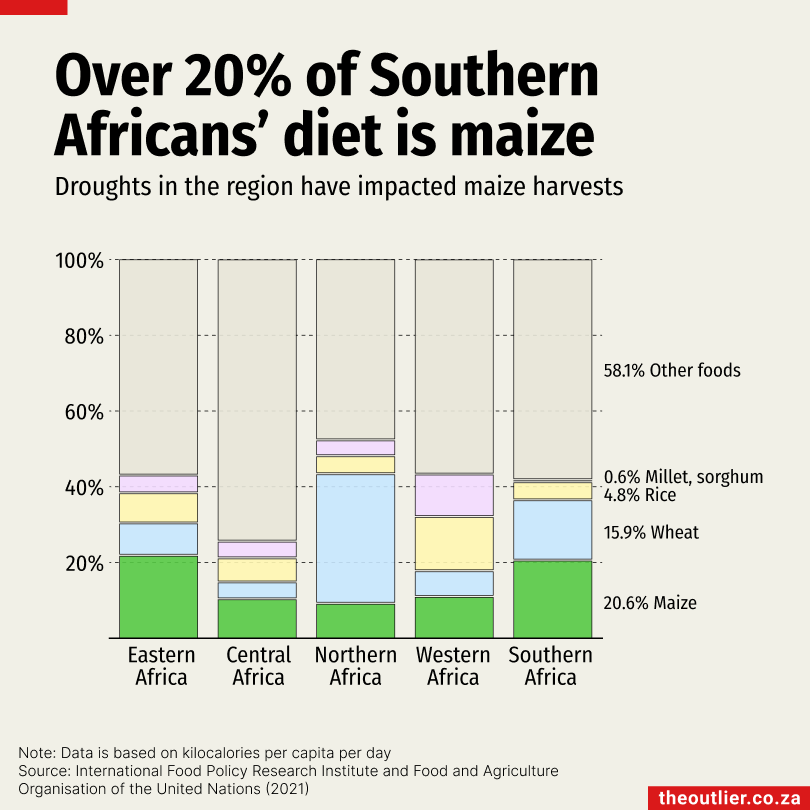
- Maize makes up one-fifth of the average diet in Southern Africa
- El Niño has caused a devastating decline in maize production
- Malawi, Zambia, Zimbabwe declared states of disaster
Maize is critical to food security in Southern Africa, making up more than 20% of the average person’s daily diet (in kilocalories consumed). It’s the most-consumed grain in the region, according to data from the UN’s Food and Agriculture Organisation.
This season’s devastating decline in production of this staple crop is the result of a summer drought, caused by El Niño’s hot and dry weather patterns.
Three countries in the region have already declared a state of disaster: Malawi, Zambia and Zimbabwe.
More than 6.55-million people in Zambia, many of them children and women, now need humanitarian assistance, the UN says.
In Malawi, 4.2-million people are likely to be experiencing ‘high levels of acute food insecurity’ by September, the International Food Policy Research Institute reports.
Zimbabwe expects to produce 55% less maize than usual in 2024. The UN says about half the population is likely to go hungry as a result.
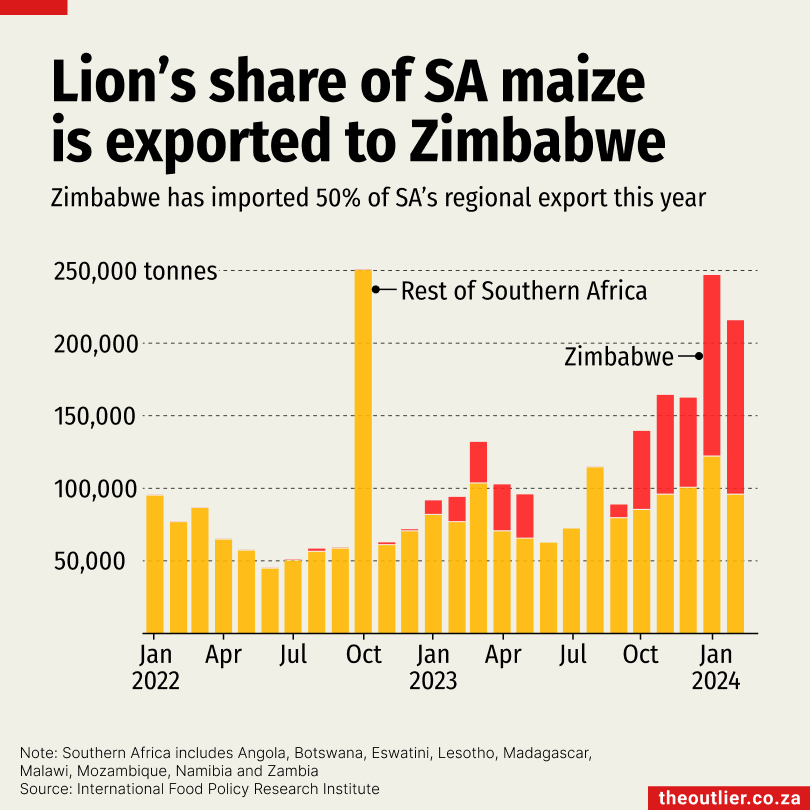
- El Niño-driven drought has hit Southern Africa maize production
- Zimbabwe expects to produce 55% less maize this year
- Zimbabwe imported half of SA’s regional maize export in two months
There has been a devastating decline in the production of maize across Southern Africa because of dry and hot weather caused by El Niño weather patterns.
Zimbabwe was one of three countries to declare a state of disaster. It expects to produce 55% less maize than usual in 2024. About half the population is likely to go hungry as a result, the UN says.
Zimbabwe will need to import 1-million tonnes of maize to make up the shortfall from its harvest, says Wandile Sihlobo, chief economist at the Agricultural Business Chamber of SA. Its imported maize will come from South Africa, which will ‘most likely only have 1.4-million tonnes to export because of its poor harvest’.
In the first two months of 2024, South Africa exported 224,130 tonnes of maize to Zimbabwe, which is almost half its regional export total of 463,000 tonnes.
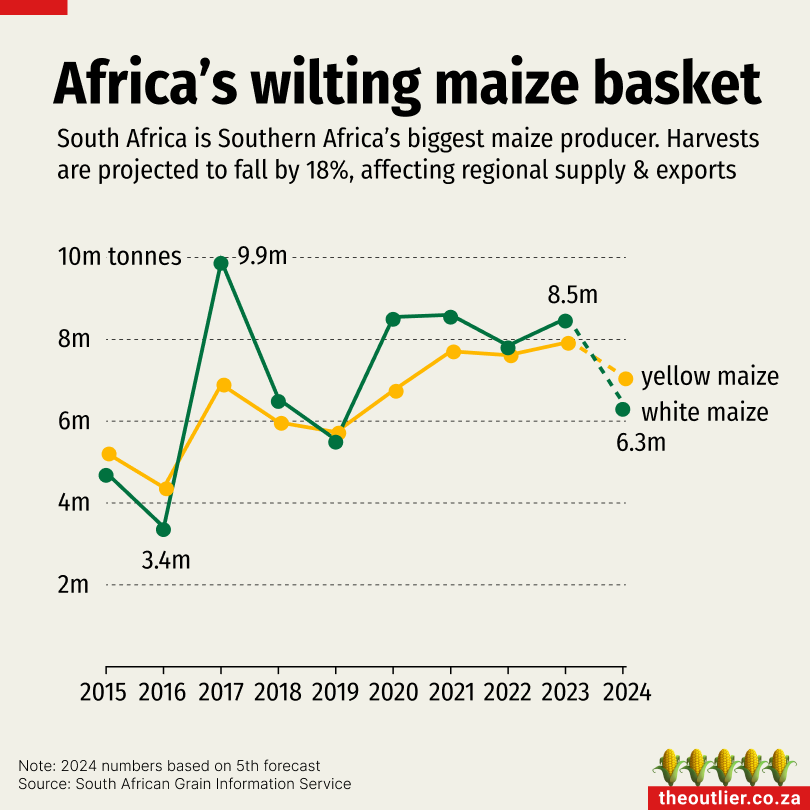
- South Africa is biggest maize producer in southern Africa
- Crop yields in South Africa are expected to drop by 18%
- High-demand white maize yields to drop by 2.2m tonnes
Maize production in South Africa, the biggest maize producer in Southern Africa, is projected to drop by almost one-fifth this year.
The decline in maize production across the region is because of dry and hot weather caused by El Niño weather patterns. In Africa, maize is a staple food for millions of people.
Production of white maize, which is used to make pap, is projected to drop by a quarter and yellow maize yields are expected to fall by 10%.
The projected decrease is not as much as it was in 2016. That year, white and yellow maize yields dropped by an average of 22%, also because of El Niño.
South Africa is better off than its neighbours, Malawi, Zambia and Zimbabwe. All three countries have declared national disasters. This is because of ‘differences in farming practices, better timing of the planting window and the improved seed cultivars’, says Wandile Sihlobo, chief economist at the Agricultural Business Chamber of SA.
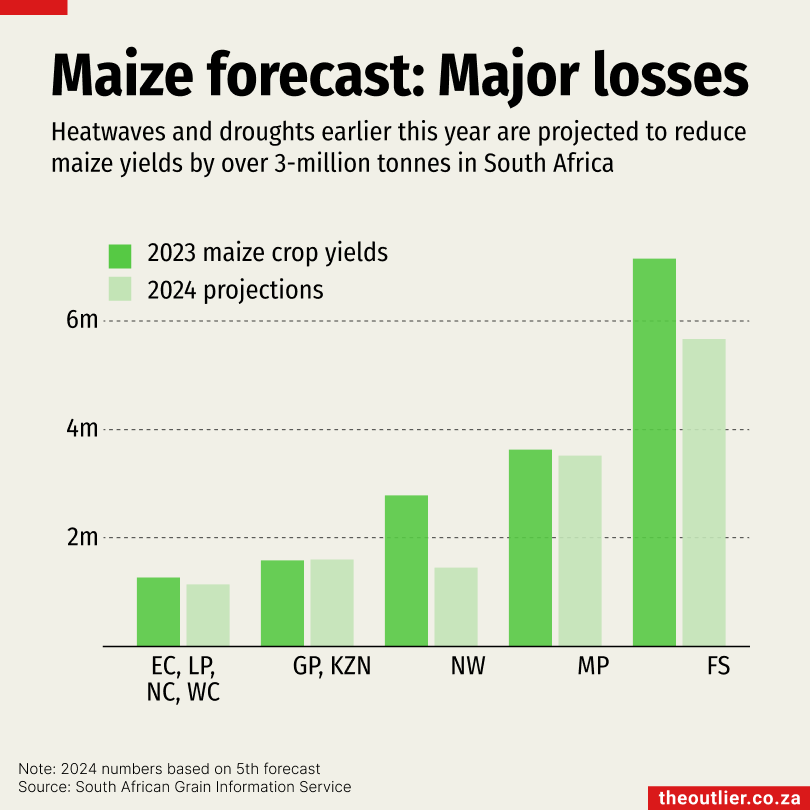
- SA’s maize crop yields projected to drop by almost one-fifth
- Yields in North West are expected to halve after hot, dry summer
- SA’s farming practices have offered some protection from drought
Maize crop yields are expected to drop by 18% in South Africa in 2024 because of heatwaves and droughts brought on by El Niño, a weather phenomenon that can last for months.
In North West, maize harvests are projected to drop by almost half from 2023’s yields. Other significant drops are expected in Limpopo (35%) and Free State (21%), which is South Africa’s main maize-producing province.
The impact of the hotter-than-usual summer months on the maize growing season have been felt across the region. Malawi, Zambia and Zimbabwe declared states of disaster earlier this year.
While still heavily impacted by the drier summer months, South Africa has fared better than its neighbours because of the ‘differences in farming practices, better timing of the planting window, and the improved seed cultivars’, says Wandile Sihlobo, chief economist at the Agricultural Business Chamber of South Africa.
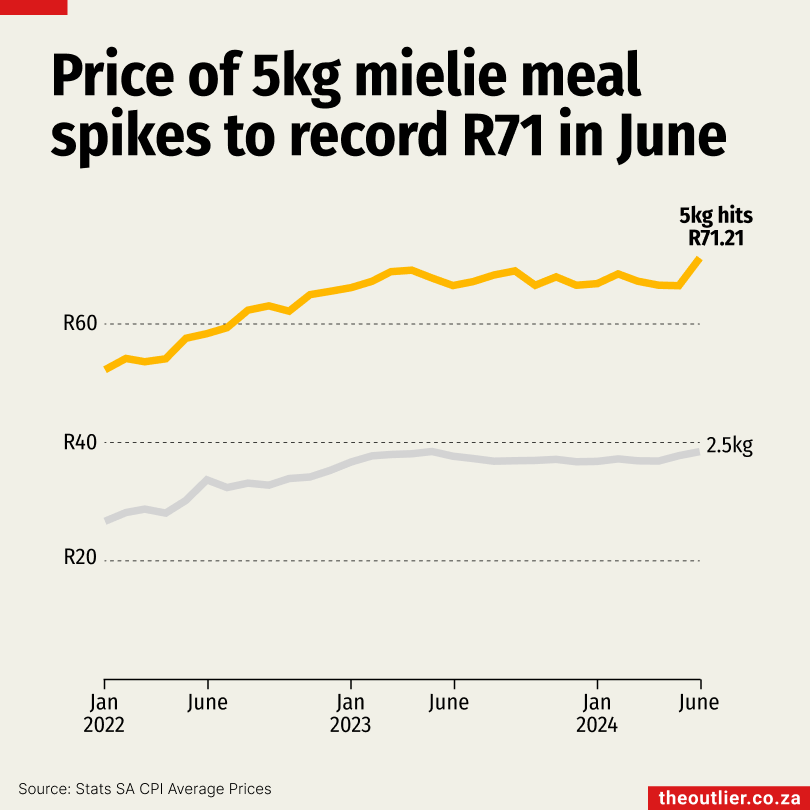
- Cost of 2.5kg bag of maize meal has risen by 44% in two years
- A 5kg bag of maize meal is more expensive than ever at R71.21
- Maize crop yields in South Africa are under pressure
The price of a 2.5kg bag of maize meal in South Africa has increased by R12 since January 2022, which is as far back as Statistics SA’s data goes. That’s a 44% increase on a staple food in just two-and-a-half years. A 5kg bag of maize meal is now the most expensive it has ever been at R71.21.
Other staple foods, such as white bread and tinned fish, increased by half as much over the same time period.
Maize shortages brought on by dry El Niño weather patterns are driving the price increases.
South Africa’s maize yields are projected to drop by 18% this year and in April the country made its first import of yellow maize in five years. The Argentinian imports docked in Cape Town. At the moment, it’s more cost-effective for the country to import maize meal.
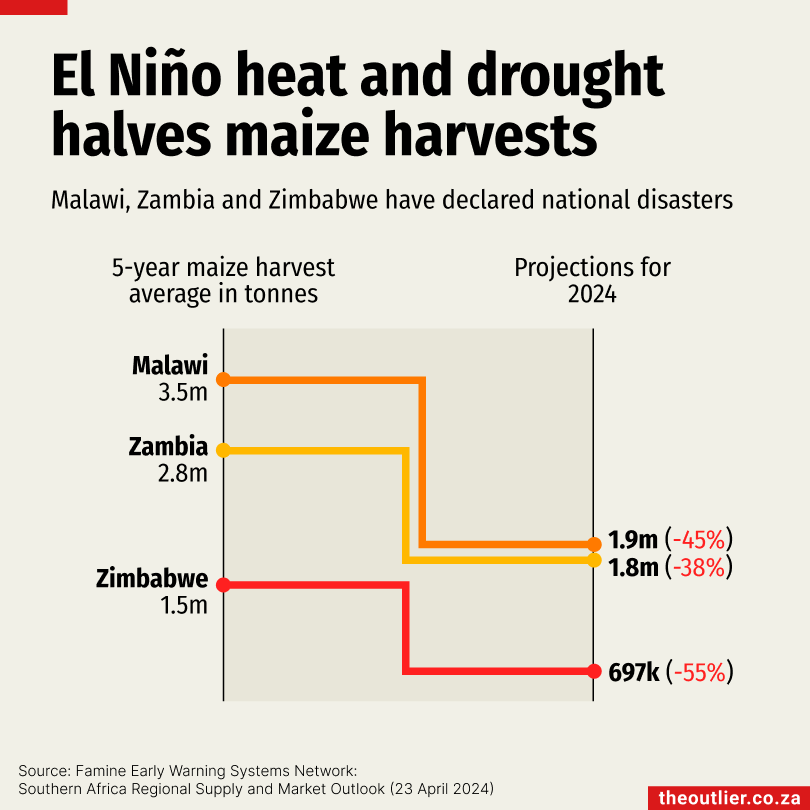
- El Niño conditions have halved maize harvests in southern Africa
- Three countries have declared states of disaster
- Zambia reports ‘total crop failure’ in 2024
In Southern Africa, maize is a staple food for millions of people eaten as pap, sadza and nshima. But dry and hot weather caused by El Niño has led to a devastating decline in production across the region.
El Niño is a weather phenomenon that is the result of the ocean’s surface temperature increasing, leading to a warmer atmosphere. From November to April, it typically brings heatwaves, below-average rainfall and drought to Southern Africa.
Three countries declared a state of disaster earlier this year: Malawi, Zambia and Zimbabwe.
Zambia is experiencing its driest agricultural season in more than 40 years, according to the UN. The country lost almost half of the maize it planted, close to 1-million tonnes, describing it as ‘total crop failure’.
Malawi is likely to produce 45% less maize than usual in 2024, while Zimbabwe projects to produce 55% less. Millions of people across the region are expected to go hungry as a result.
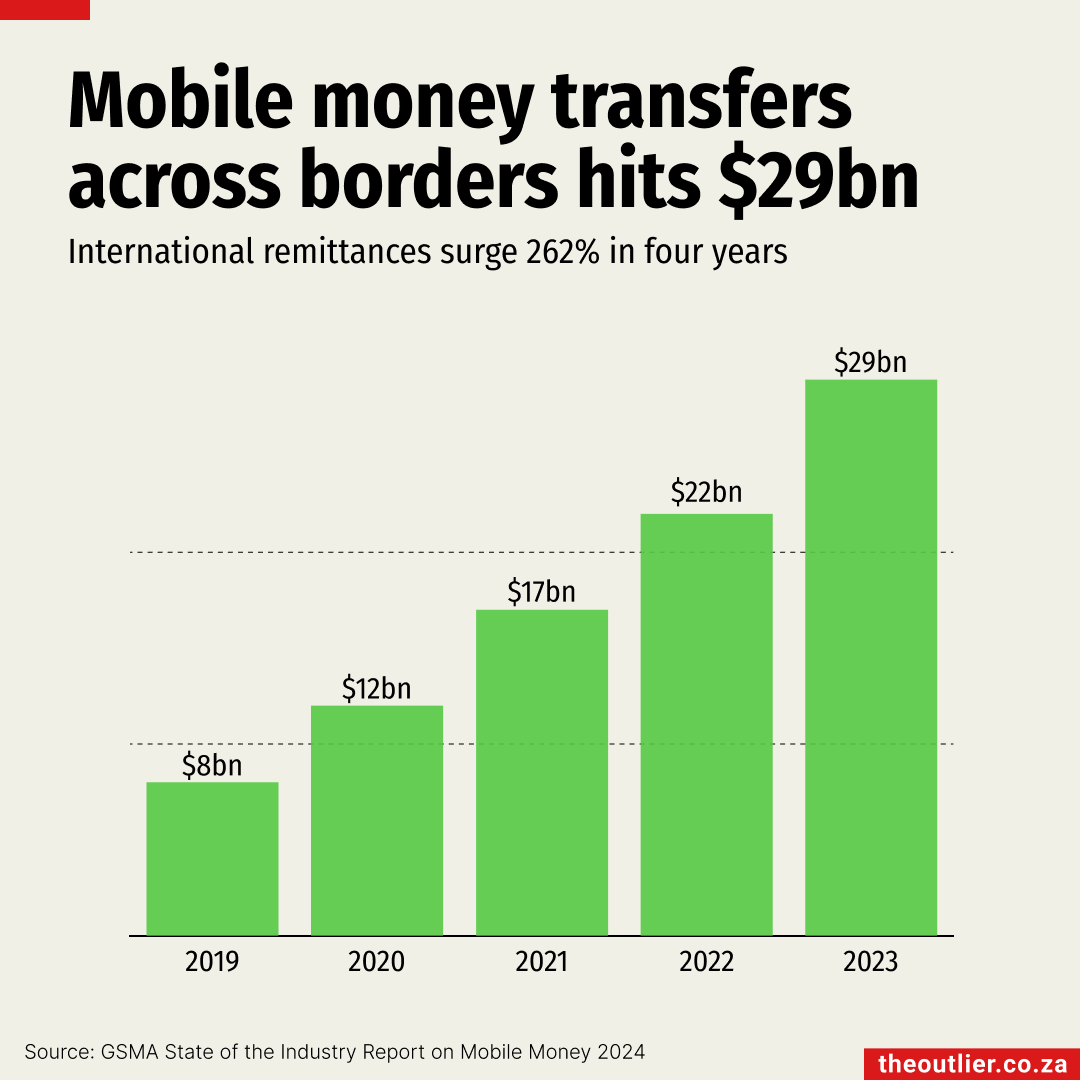
- International remittances using mobile money reached $29-billion in 2023
- The amount of money transferred has grown by 262% in four years
- West Africa is driving growth in international remittances
About $29-billion was transferred across country borders in 2023 using mobile money services, $7-billion more than was sent in 2022, according to the GSM Association’s latest state of the industry report on mobile money.
Mobile money allows people who do not have a bank account to send money safely using a basic mobile phone. International remittances are commonly used by migrant workers to send money home to their families.
The amount of money being transferred has surged 262% in four years, from $8-billion in 2019 to $29-billion in 2023. The growth in international remittances is being driven by West Africa, the GSMA said.
There are about 835-million mobile money account holders in Sub-Saharan Africa, according to the GSMA. Last year, 62-billion transactions were carried out in the region using mobile money. This is two-thirds of the world’s total mobile money transactions.
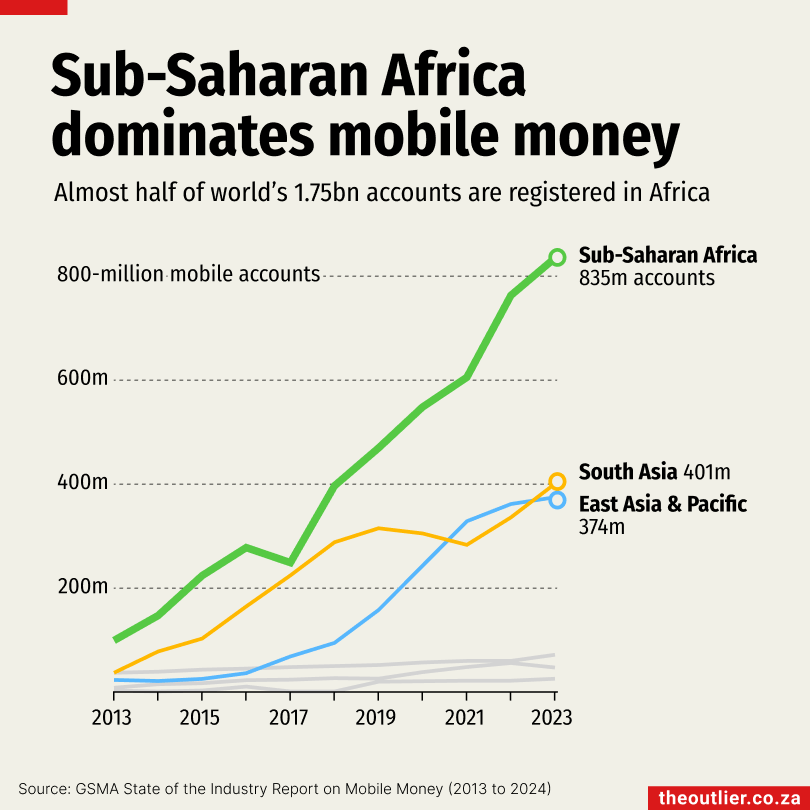
- An estimated 1.4-billion people worldwide are unbanked
- Half of world’s mobile money account holders are in Sub-Saharan Africa
- The region has been leading the sector since 2013
About 1.4-billion people worldwide do not have a bank account, the GSMA estimates. When people are excluded from formal financial services such as banks, transactions that can be conducted with a basic mobile phone offers them a secure way to send money across borders, save and, in some cases, apply for micro-loans and insurance.
The first mobile money providers emerged in the early 2000s in the Philippines. But the service took off once it was introduced in Sub-Saharan Africa with M-Pesa, which was created by a collaboration between Vodafone and Safaricom almost 20 years ago.
Sub-Saharan Africa has dominated the global mobile money landscape since 2013, and now boasts twice as many registered accounts as South and East Asia and the Pacific.
According to the GSMA’s 2024 state of the industry report, the region has 835-million registered mobile money accounts, nearly half of the world’s 1.75-billion accounts.
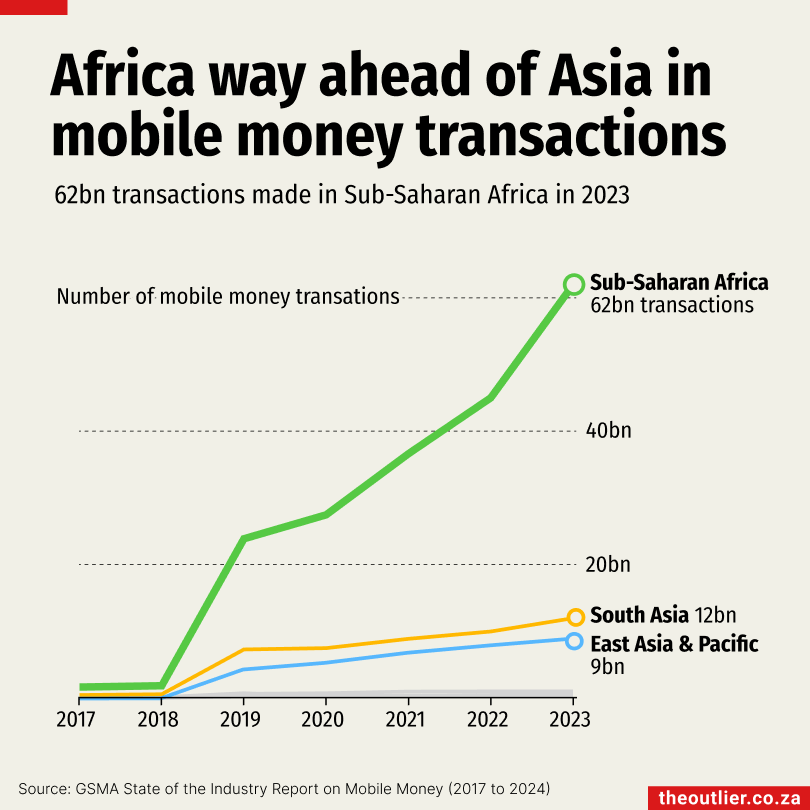
- Sub-Saharan Africa recorded two-thirds of world’s mobile money transactions
- About 62-billion transactions were recorded in the region in 2023
- Majority (61%) of transactions in Africa were made in East Africa
Two-thirds of the world’s mobile money transactions made in 2023 happened in Sub-Saharan Africa. People in the region did 62-billion transactions worth $912-billion. This is an almost 40% increase from 2022, when 45-billion transactions were conducted in the region.
Mobile money allows users to store and exchange money using a basic mobile phone. It differs from mobile banking in that users do not need a bank account to transact.
There are about 1.4-billion people worldwide who do not have a bank account, according to the GSM Association. When people are excluded from formal financial services, mobile money offers them a secure way to send money, including across borders.
The growth in African mobile money transactions has been largely driven by West and East Africa. East Africa accounts for 61% of transactions on the continent, whereas West Africa accounts for almost one-third of Africa’s total transactions.
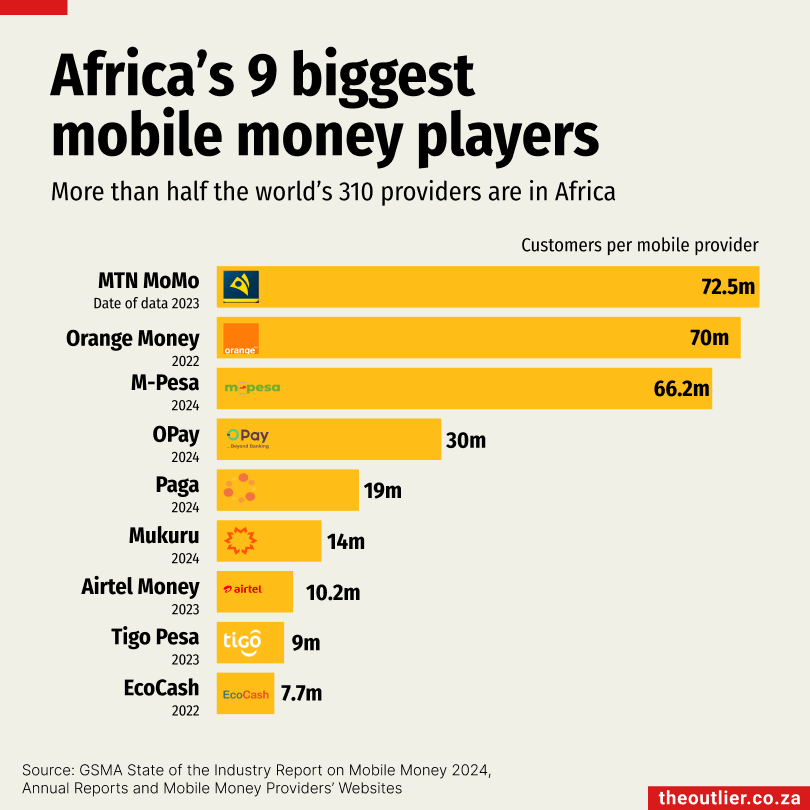
- 169 of world’s 310 mobile money service providers are in Africa
- M-Pesa has 66.2-million customers in six countries
- MTN’s Momo has 72.5-million customers in 16 countries
There are 169 mobile money services in Africa, more than half of the world’s 310 providers, according to the 2024 GSMA state of the industry report.
Mobile money is an e-wallet service that allows users who do not have bank accounts to transact using a basic mobile phone.
M-Pesa, which launched in Kenya in 2007, is one of Africa’s most successful mobile money providers. Its 66.2-million customers in six countries were responsible for 33-billion transactions in the 2023 financial year, according to Vodafone, its owner. Services include payments, microloans and buying airtime.
With 72.5-million customers, MTN’s Momo is the continent’s largest service provider. It started in 2007 in Uganda, and now operates across 16 countries. Orange Money began in 2008 in Côte d’Ivoire. It is available in 17 countries in Africa and the Middle East. In 2022, it had 70-million customers.
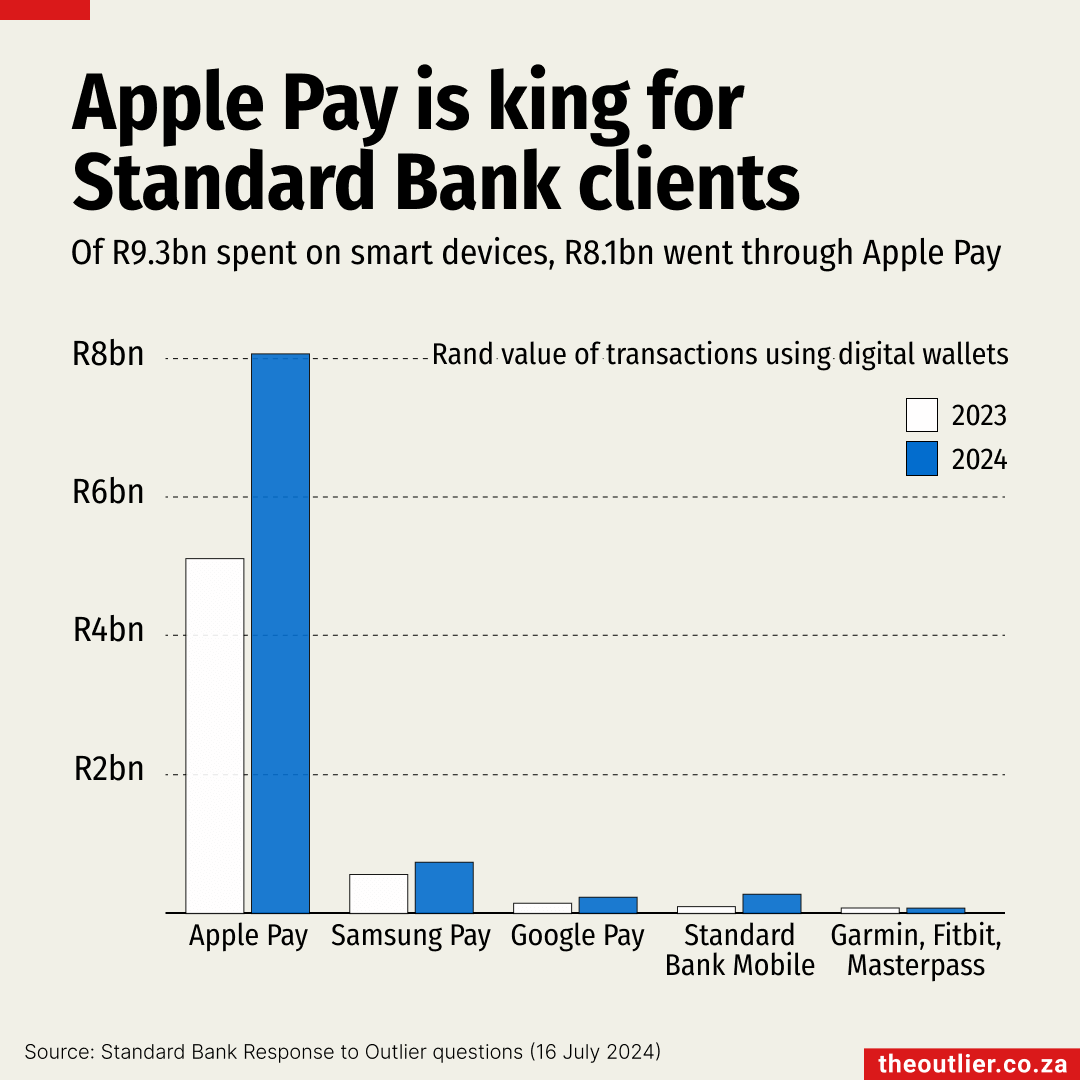
- Standard Bank customers spent R9.3-billion using their digital wallets
- Apple Pay was used in 86% of the transactions
- Spending using digital wallets increased 57.6% from 5.9-billion last year
Standard Bank customers spent R9.3-billion using digital wallets in the current financial year to pay for goods and services, according to data from the bank.
Digital wallets allow people to transact without a physical bank card, using their smartphones, tablets and watches.
Standard Bank customers increased their spending on digital devices by R3.4-billion to R9.3-billion in a year, up 57.6% from 2023.
Apple Pay was the most popular digital wallet for Standard Bank customers in 2024, accounting for 86% of transactions. Far behind were Samsung Pay (8%), Standard Bank Mobile (3%) and Google Pay (2%). Garmin Pay, Fitbit Pay and Masterpass made up the remaining 1%.
Banks are making it easier for customers to use digital wallets, especially as several banks have begun to close ATMs. In FNB’s financial year ending June 2023, FNB customers spent R37.5-billion using digital wallets – six times the value Standard Bank’s customers spent last year.
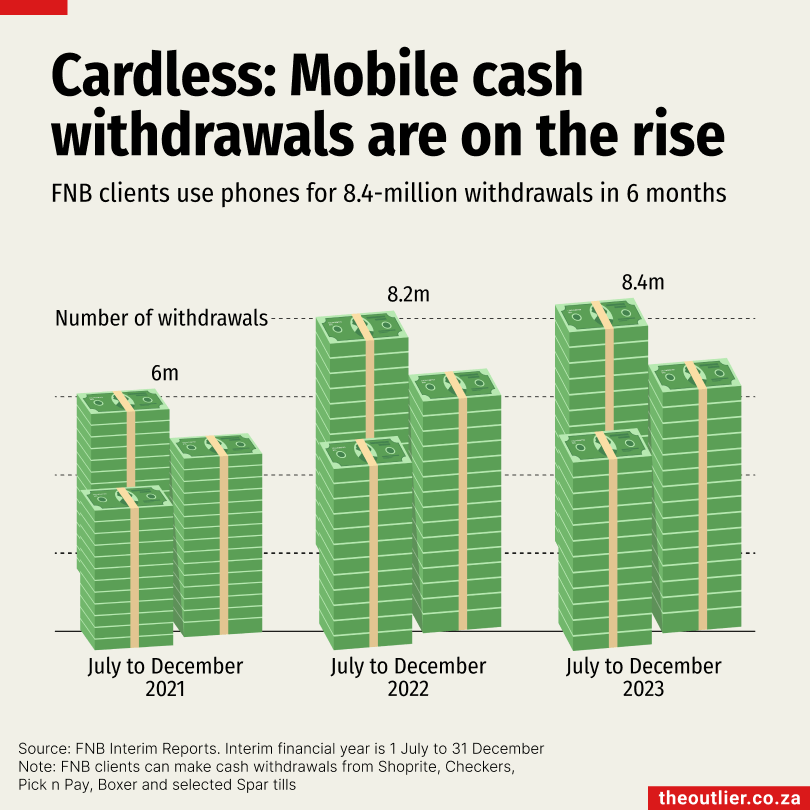
- 8.4-million withdrawals from FNB made via phones in 6 months
- This is an increase from 6-million two years ago
- Money can be withdrawn at ATMs and selected Spar shops
South Africans are increasingly relying on their mobile phones to do their banking. FNB data shows that the number of withdrawals made using mobile phones has increased over two years from 6-million transactions in the last six months of 2021 to 8.4-million in the same period in 2023.
FNB clients can make withdrawals using the banking apps on their phones at ATMs or at selected Spar stores.
Withdrawing cash using a banking app means people do not need to carry a physical bank card. FNB’s default withdrawal limit is R3,000, according to the bank’s website.
Banking apps also make it easier to send money to people without a bank account, as all a person needs to access the cash is the code the bank sends them as an SMS.
Updated: 1 August to specify retailers and withdrawal limit
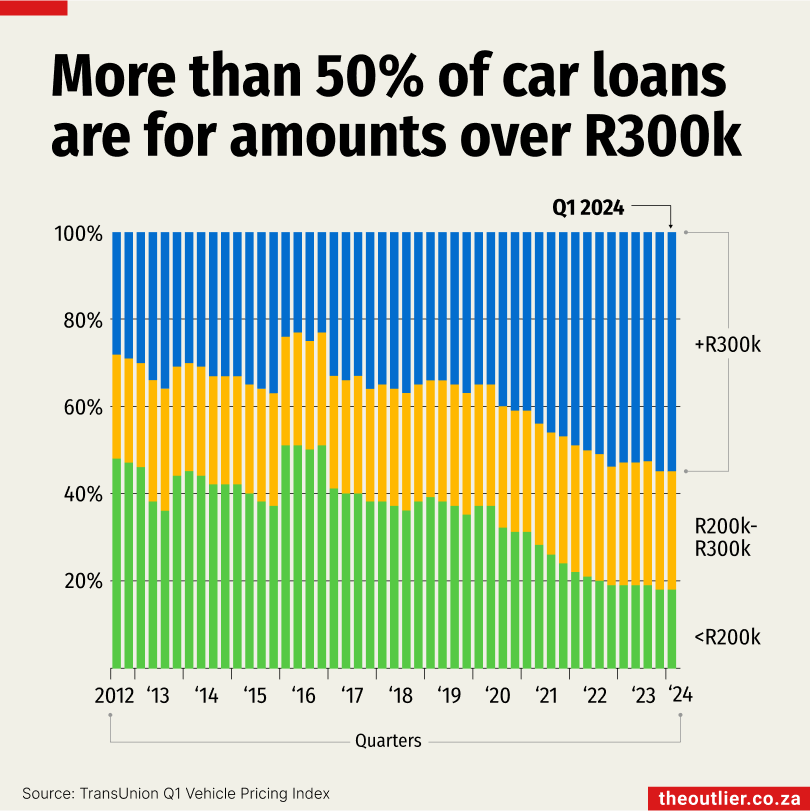
- New cars prices were almost 5% higher in first quarter of 2024 than in Q1 2023
- Average car loan was R391,000 in first quarter of 2024
- Sales have declined by 13,000 (7%) to 161,000 since last year
New car prices were 4.7% higher in the first quarter of 2024 than they were at the same period in 2023, according to data from Transunion, an international credit bureau. Used car prices increased 2.1% over the same period.
The data also shows that the average loan for financed vehicles in the first quarter of 2024 rose to R391,000, up from R387,000 in Q1 2023.
More than half of the deals for vehicle financing are over the R300,000 mark, which has been the case since mid-2022.
The hefty price tag that comes with buying a car seems to be a contributing factor to the decrease in passenger vehicle sales.
Just over 161,000 new passenger vehicles were sold in the first six months of 2024, according to Naamsa. This is about 13,000 fewer vehicles than the 174,000 sold in 2023 (-7%).
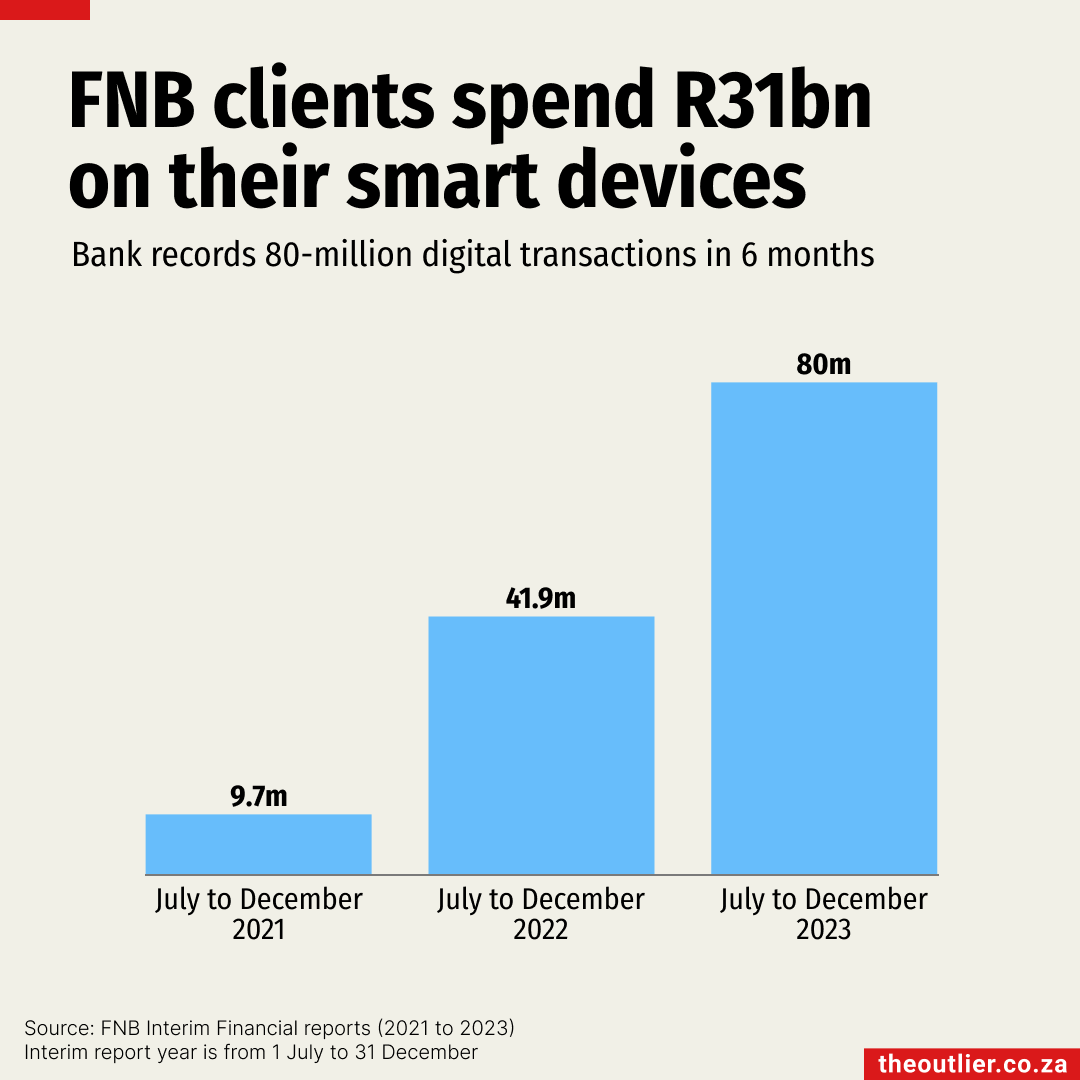
- FNB clients did 80m transactions on smart devices in 6 months
- This is eight times the amount over the same period in 2021
- Transactions totalled R31bn, or R388 per transaction
FNB clients are increasingly using their e-wallets on their Android and Apple devices to pay for goods and services. E-wallets allow people to transact without a physical card, with customers using their smartphones, tablets and watches instead.
In the six months between July and December 2023, FNB account holders made 80-million e-wallet transactions. These were worth R31-billion, or an average of R388 per transaction. This is an eightfold increase from the 9.7-million transactions over the same six months in 2021, when transactions averaged R351 each.
FNB launched its digital cards at the end of July 2020. By December 2023, 5-million virtual cards had been activated. The significant rise in e-wallet transactions in South Africa is in line with a global shift towards more convenient and secure payment options.
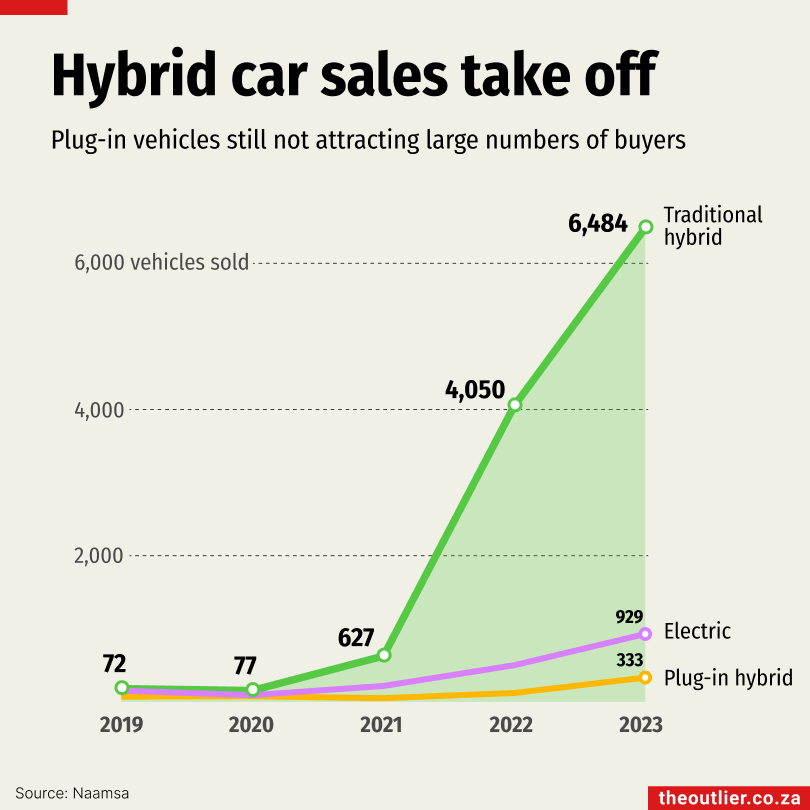
- Traditional hybrids see significant growth in South Africa
- Fully electric and plug-in hybrids remain less popular
- Toyota Corolla Cross hybrid is among the most popular
There has been an increase in South Africans switching to hybrid vehicles, but few choose all-electric or plug-in hybrids.
Traditional hybrid vehicles, like the Toyota Prius, combine an internal combustion engine with a battery that charges while driving. In 2021, just over 600 traditional hybrid vehicles were sold in South Africa. By 2023, this number had increased tenfold to 6,484 vehicles sold.
In comparison, only 1,147 fully electric and plug-in hybrid vehicles were sold in 2023, up from 384 in 2021.
According to AutoTrader, the most popular hybrid cars available in South Africa are the Toyota Corolla Cross Hybrid, the Suzuki Grand Vitara Hybrid, and the Honda Fit HEV.
The local market is far from developed by global standards. Fewer than 1% of vehicle sales in South Africa in 2023 were fully electric or plug-in hybrids (excluding traditional hybrids), while the global average was 18%.
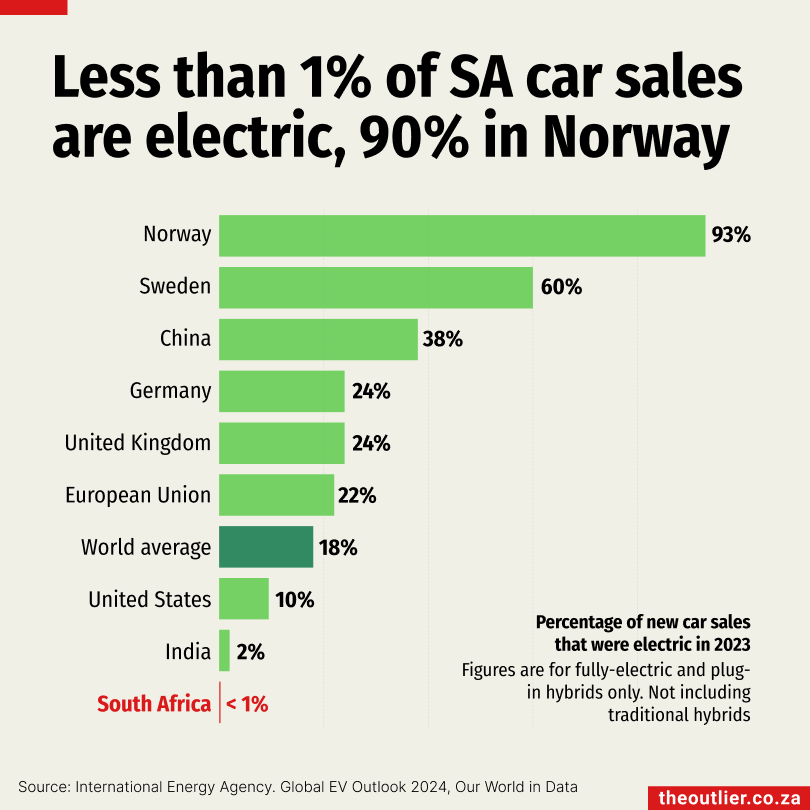
- Fewer than 1% of vehicles are electric in South Africa
- The global average is 18%, with Norway topping 90%
- South Africa has relatively few public charging stations
Fewer than 1% of the vehicles sold in South Africa in 2023 were fully electric or plug-in hybrids, according to the International Energy Agency. In contrast, 93% of vehicles sold in Norway and 60% in Sweden are electric or plug-in hybrids. The global average is 18%.
Fully electric cars are entirely battery-powered and must be charged. Plug-in hybrid electric vehicles rely primarily on the battery for driving, with the combustion engine engaging when the battery is low.
One reason for South Africans’ slow uptake of plug-in and fully electric vehicles is the relatively low number of charging stations. There are at least 400 public charging stations in South Africa, compared to about 4,000 major brand petrol stations.
Despite this, the number of fully electric and plug-in hybrid vehicles in South Africa has increased from 384 in 2021 to 1,147 in 2023.
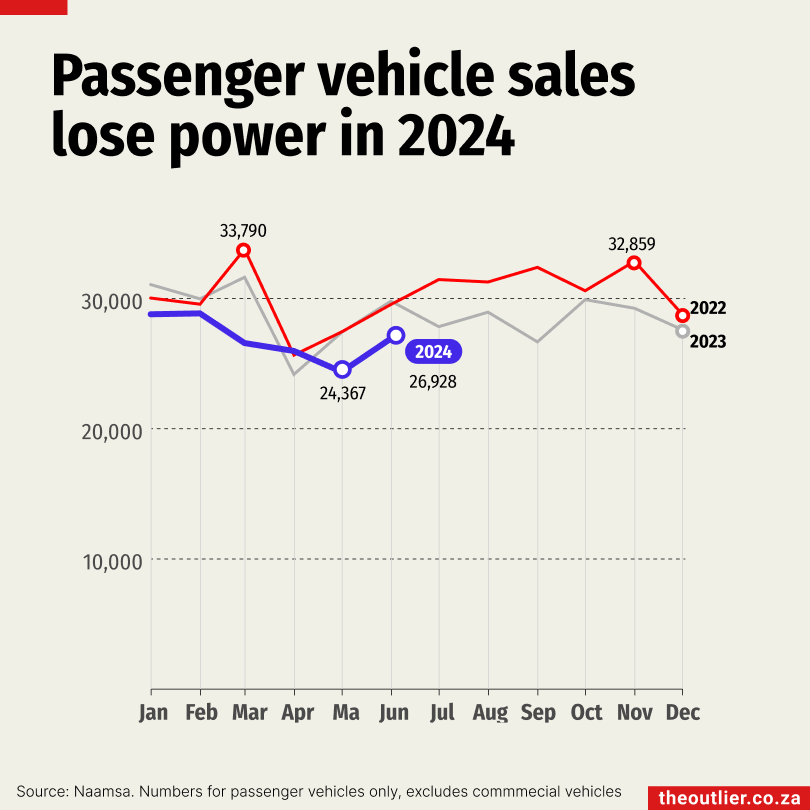
- 161,000 new cars sold in first 6 months of 2024
- About 174,000 were sold in same time period last year
- Rising costs of vehicles are contributing to the decline
Sales of new passenger vehicles are down. Between January and June 2024, around 161,000 of these vehicles were sold.
Last year, more than 174,000 vehicles, or 13,000 more, were sold in the same time period. That’s a 7% decrease on the amount sold in 2023.
A contributing factor to the decrease in passenger vehicle sales is their rising cost. Data from Transunion, an international credit bureau, shows that new car prices were 4.7% higher in the first quarter of 2024 than they were at the same period in 2023. Used-car prices increased 2.1% over the same period.
On the up side, sales of hybrid and electric vehicles are on the increase, despite being a relatively small portion of monthly new vehicle sales.
The Toyota Corolla Cross Hybrid and the Suzuki Grand Vitara Hybrid are among the most popular hybrid cars available in South Africa, according to AutoTrader.
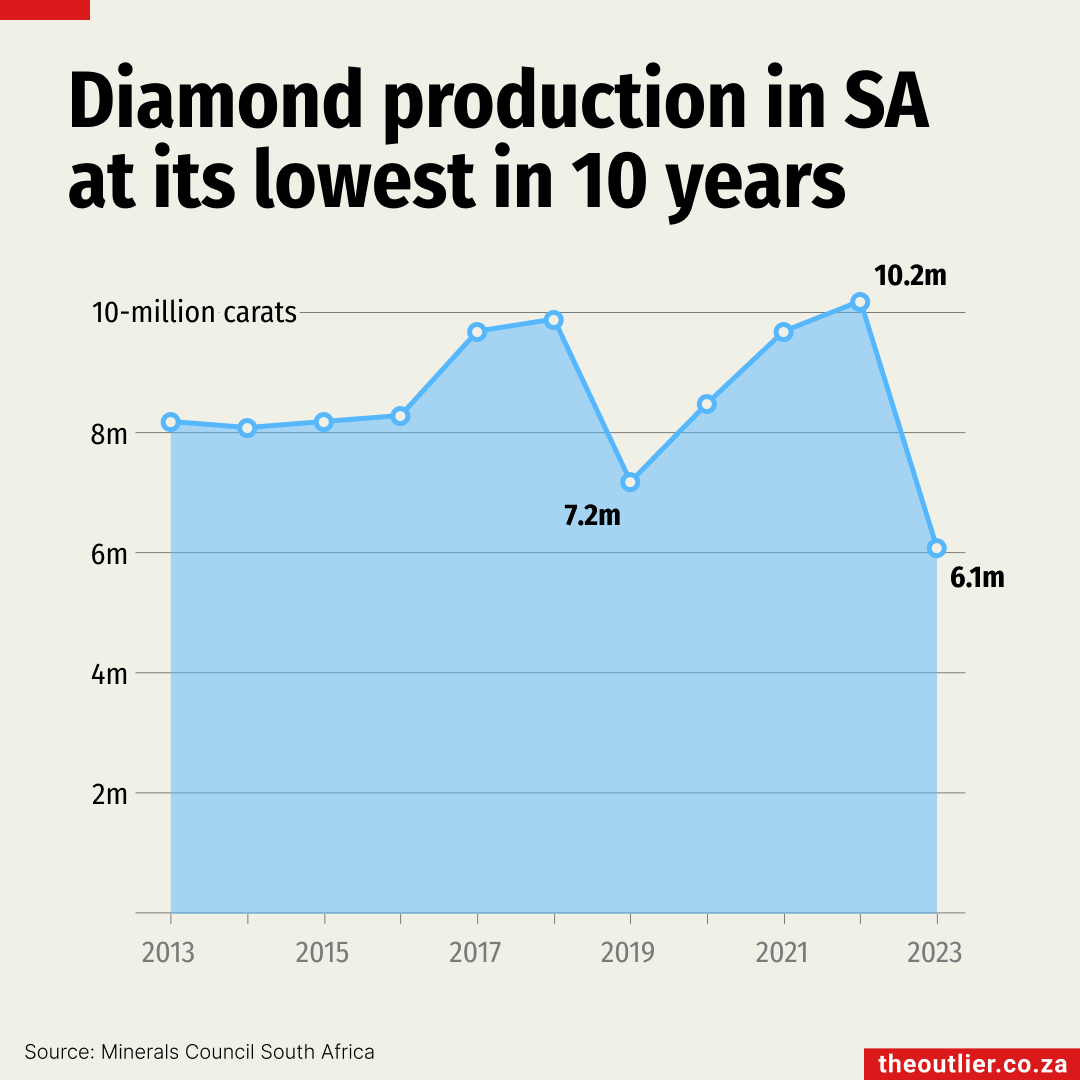
- Diamond production in South Africa is at a 10-year low
- Closure of Venetia diamond mine has led to the drop
- De Beers is transitioning Venetia to underground to extend its life
Diamond mining production in South Africa has hit a 10-year low. Before 2023, the country produced an average of 8.5-million carats a year. By 2023, production had dropped to 6.1-million carats.
The reason for the drop is that De Beers’ Venetia diamond mine reached the end of its open-pit operations in December 2022. The mine accounted for 40% of South Africa’s diamond production, according to the Minerals Council.
South Africa remains among the top 10 diamond-producing countries, contributing 5% of the world’s diamonds. The largest producers are Russia with 37.3-million carats and Botswana, with an output of 25-million carats, according to 2023 Kimberley Process data.
De Beers is developing Venetia as an underground mine to extend its operational life until the 2040s. The company expects to extract 88-million carats from this new phase.
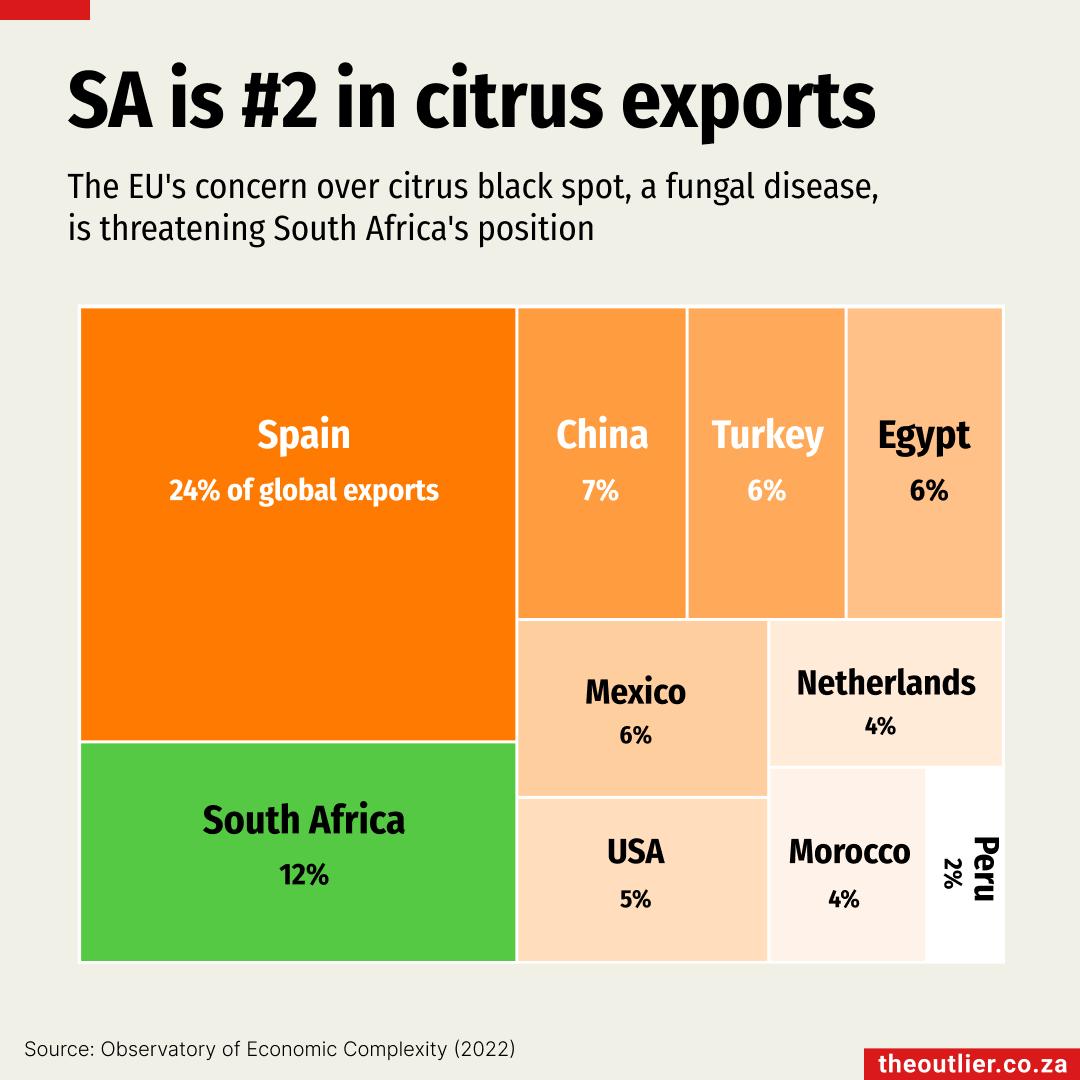
- SA is the second-biggest citrus exporter after Spain
- South African citrus made up 12% of global exports in 2022
- A fungal disease threatens SA’s position as citrus exporter
South Africa exported $1.85-billion worth of citrus, or 12% of the global total, in 2022, making it the world’s second-largest exporter.
But South Africa’s position in the market is being threatened by citrus black spot. This common fungal disease causes superficial blemishes on the skin of the fruit and spreads mostly through fruit-to-fruit contact and rain. Infected fruits are still safe for consumption.
The European Union has imposed legislative measures on fruit imported from SA, which include additional spray programmes and inspections which will cost the country’s citrus farmers and market more money.
The government and the Citrus Growers Association of SA have raised a dispute with the EU at the World Trade Organisation over these measures, which they deem ‘unfounded’ and ‘excessively trade restrictive’.
The citrus market was worth a reported $15.1-billion in 2022, according to the Observatory of Economic Complexity.
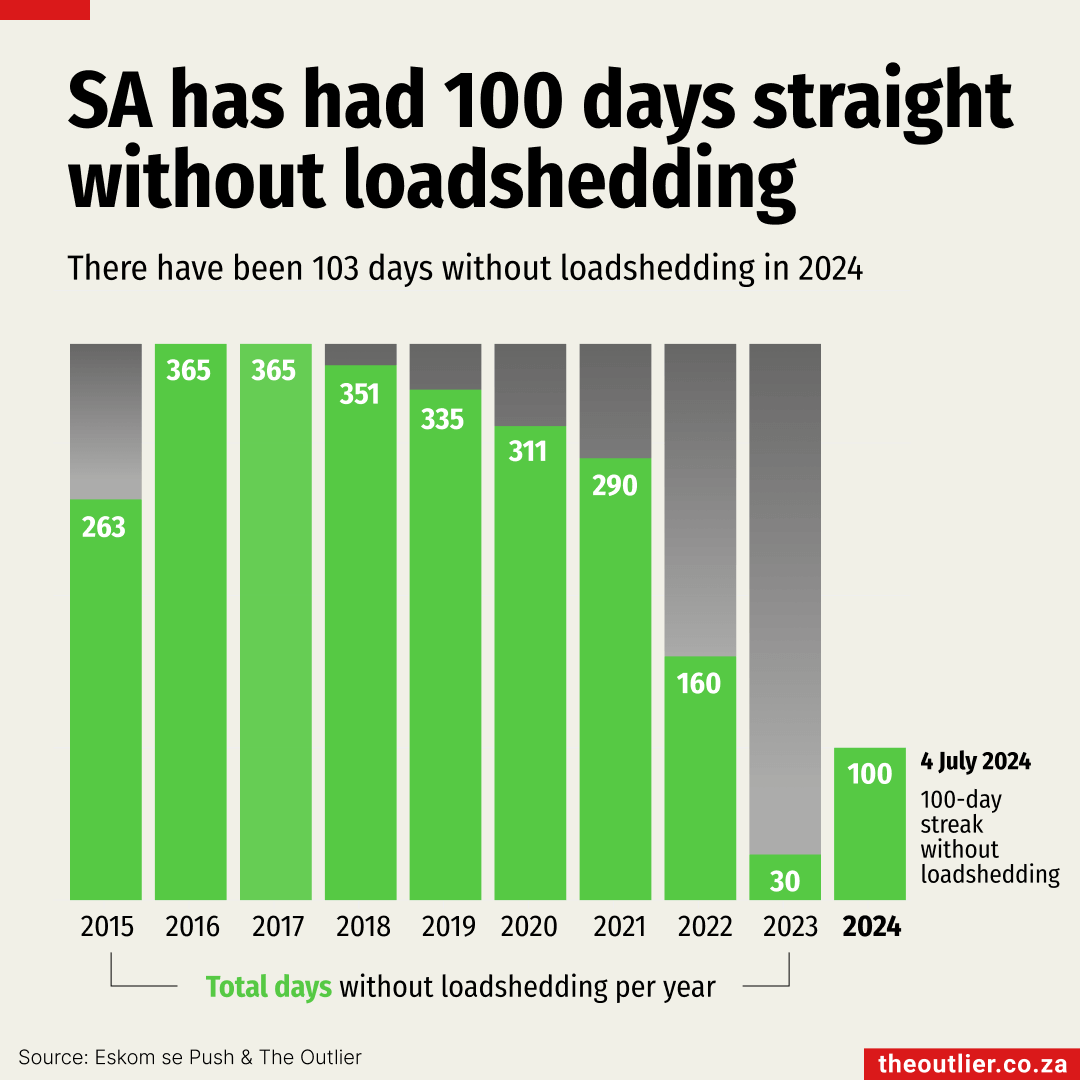
- 100 continuous days without loadshedding this year
- 2023 had 335 days with outages, the worst year yet
- 2024 has had 83 days of loadshedding so far
Today (4 July 2024) marks 100 days without loadshedding in 2024. There have been a total of 103 days without rolling blackouts in South Africa this year, but three of those were in January. The other 100 days have been continuous since 27 March.
Areas of the country including the City of Joburg, however, have been having ‘load rotation’, a localised form of power management.
The 100 days this year is the longest continuous period without scheduled loadshedding since 2020.
Last year was the worst year for loadshedding to date with outages on 335 days.
With just 83 days of loadshedding so far this year, 2024 is on track to be one of the best years for reduced loadshedding.
Fuelling the optimism is the announcement last week that Kusile’s unit 5 was now in operation, adding 800MW to the grid.
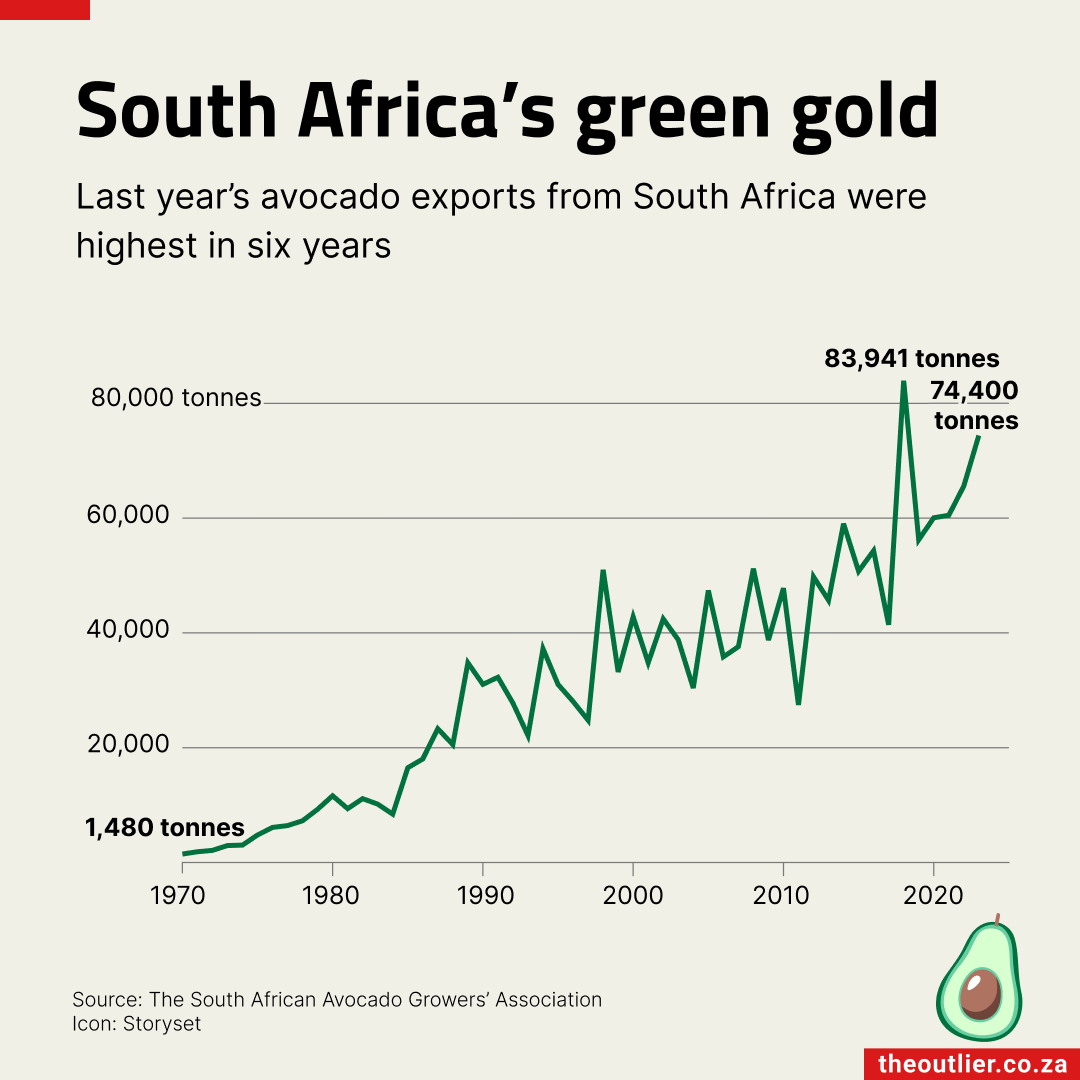
- Global demand is growing for SA avocados
- Exports increased by 63% in the past decade
- New markets opening up, including top 10 importer Japan
The world can’t get enough avocados, and South Africa is stepping up to meet the growing demand.
Exports have increased by 63% over the past decade, according to the SA Avocado Growers’ Association. About 74,4000 tonnes of avos were exported last year, just 9,500 shy of 2018’s record. ITC figures show the value of exports has more than tripled since 2012, reaching R1.63-billion in 2021.
South Africa is one of the top 10 exporters of the fruit globally and the second-biggest in Africa, after Kenya. Africa produces about 12% of the world’s avocados.
Global trade in the green gold is worth R120.3-billion, according to the Observatory of Economic Complexity, which gets its data directly from public customs records.
While Europe is a major importer of SA avocados, other markets are opening up. In the past 10 months, agreements have been put in place with India, China and Japan. Official shipments were expected to start mid-year.
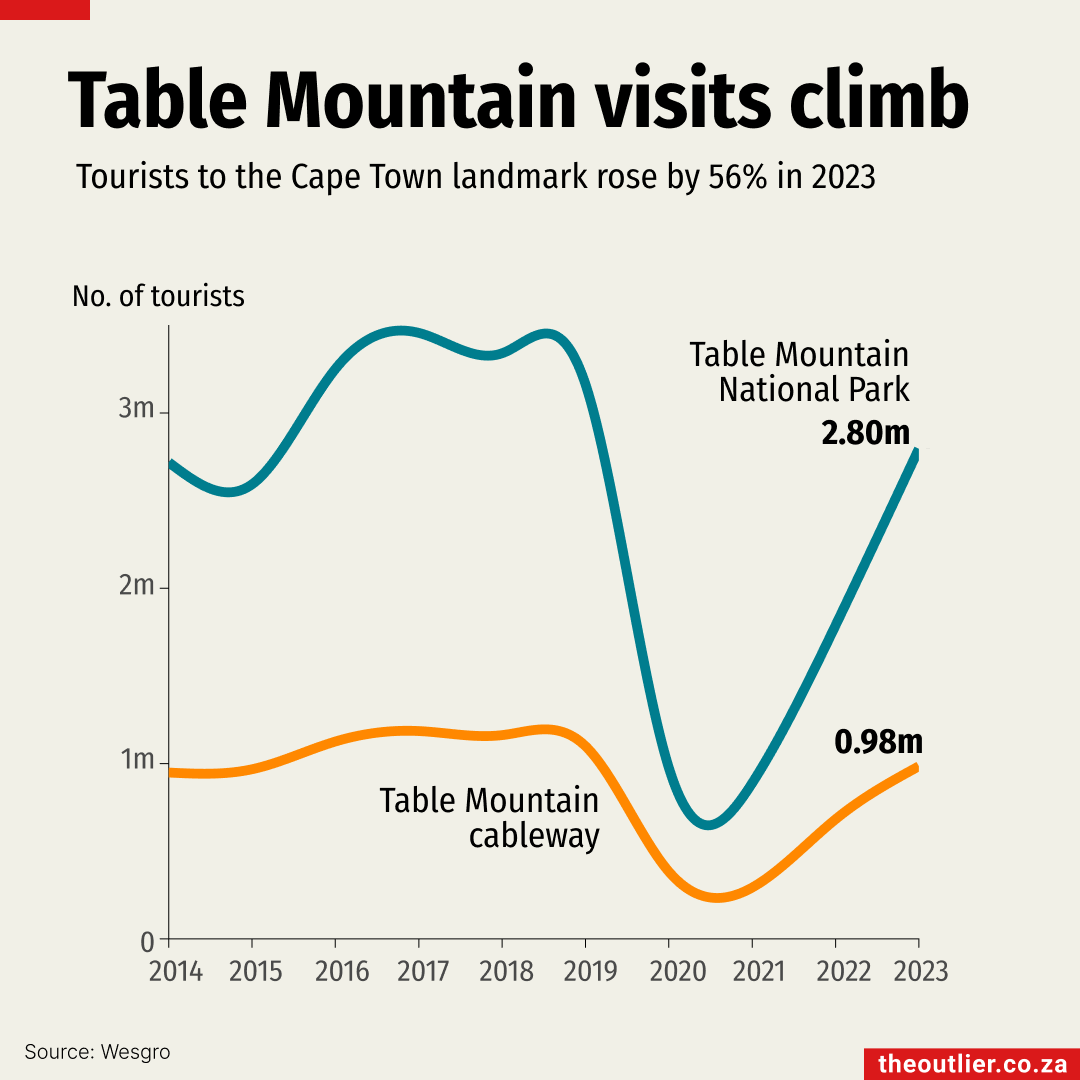
- Table Mountain National Park attracts 2.8-million visitors in 2023
- Almost 1-million people took trips on the mountain’s aerial cableway
- A record 3.46-million visitors visited the iconic landmark in 2017
The number of visitors to the Table Mountain National Park in Cape Town climbed to 2.8-million in 2023. This is a 56% increase on 2022, or an additional 1-million visitors.
The national park is home to Table Mountain and is a Unesco-designated World Heritage site. It had 3.16-million visitors in 2019, close to its record of 3.46-million set in 2017.
Also on the rise are visitors to the Table Mountain Aerial Cableway. Numbers shot up 44% last year to close to 1-million tourists, according to Wesgro, the tourism, trade and investment promotion agency for Cape Town and the Western Cape. The last time visitors to the cableway were over 1-million was in 2019.
This post-pandemic recovery is mirrored elsewhere, with tourist traffic to the rest of the Western Cape growing by more than a third to 7.7-million. Wesgro’s research shows the domestic market is helping to boost numbers.
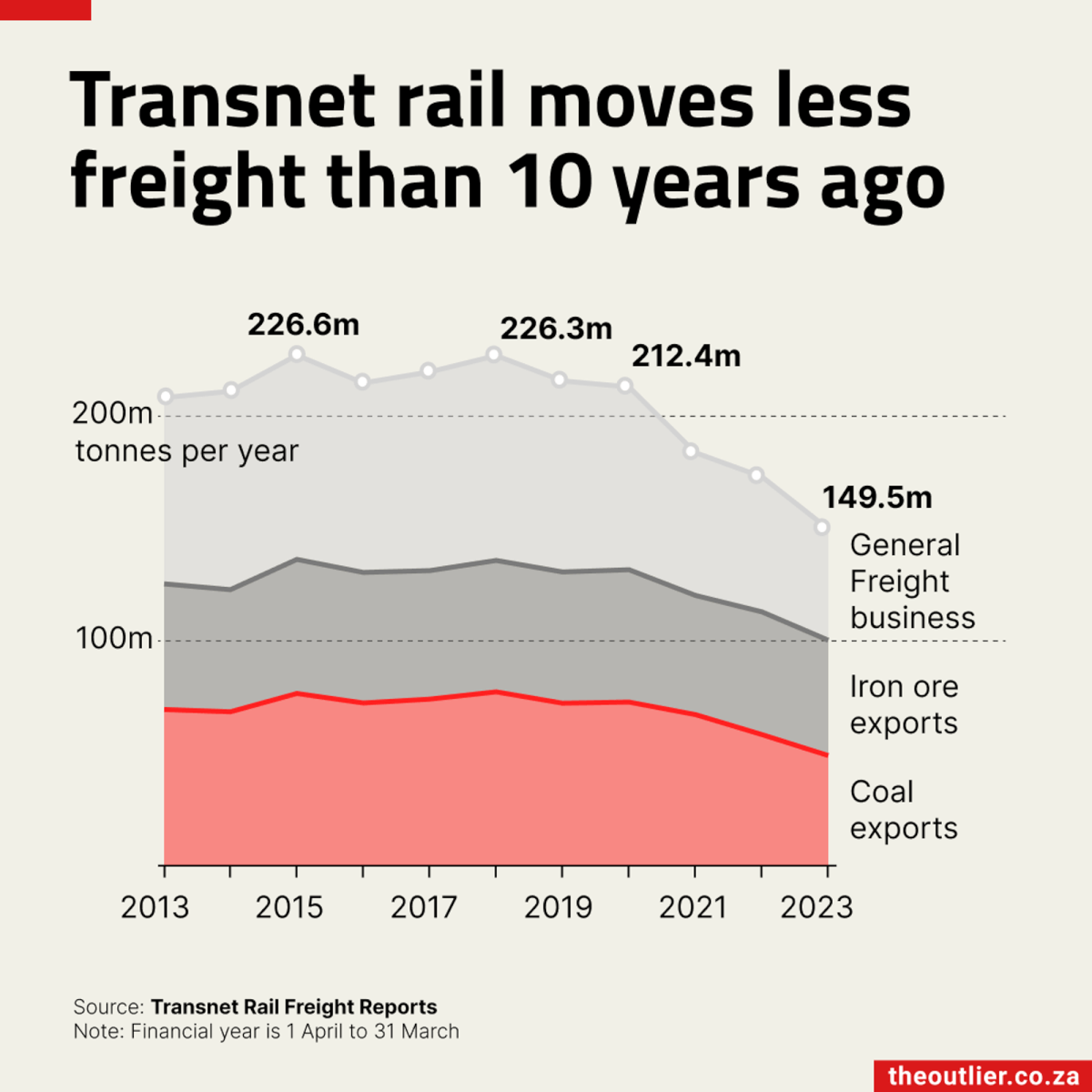
- Transnet transported 58m fewer tonnes in 2023 than in 2013
- Railway capacity issues threaten coal export sale
- South Africa is one of world’s largest coal exporters
Transnet transported 58-million fewer tonnes of coal, iron ore and other commodities in the 2022/3 financial year than it did 10 years ago, with coal making up a third of its freight.
The state-owned entity attributed its reduced rail capacity to underinvestment in network rehabilitation, vandalism, disputes over locomotive contracts, and sabotage.
This capacity issue is a problem for producers like Thungela, which might need to stockpile export-bound coal, resulting in fewer tonnes of coal exported. Such disruptions have severe economic implications for South Africa, a leading coal exporter.
Transnet’s general freight business saw a decrease of 11-million tonnes in 2022/23 compared with 2021/22. This was due to a weak economic climate and ‘operational challenges’.
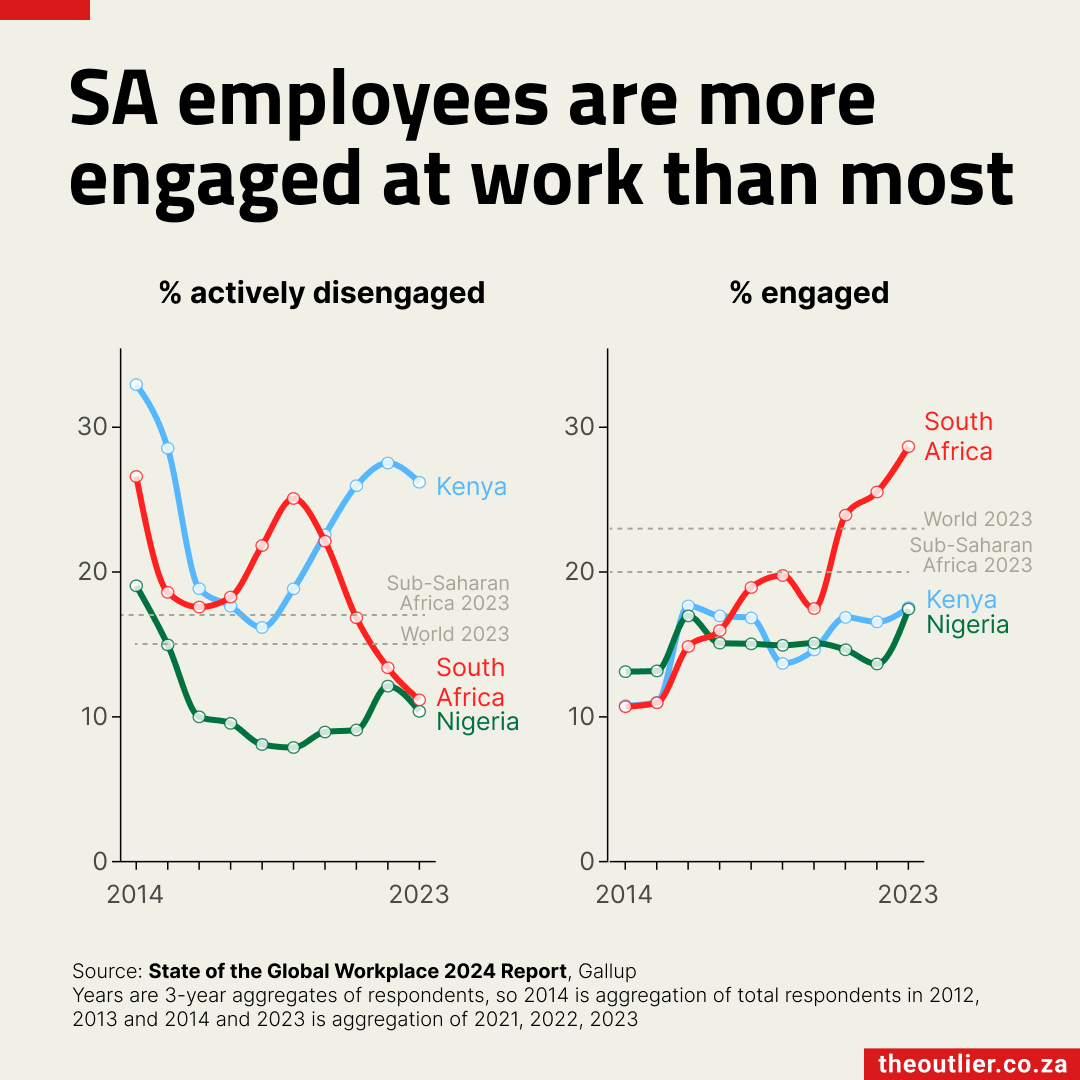
- South Africa’s employee engagement is 29%, above global average (23%)
- 11.7% are miserable, seeking new job. This is below global average (15%)
- High engagement leads to lower absenteeism, increased productivity
More of South Africa’s employees feel involved in and enthusiastic about their work than those in other parts of the world.
According to Gallup’s latest State of the Global Workplace report, 29% of South African employees surveyed are engaged. This percentage has been steadily increasing and is significantly higher than the sub-Saharan Africa (20%) and global (23%) averages. In comparison, about 17% of those surveyed in Kenya and Nigeria were engaged employees.
The proportion of actively disengaged employees in South Africa has been falling over the past few years. These, Gallup explains, are employees who have a miserable job and are actively seeking a new one. At 11.7%, South Africa’s rate is lower than both the global (15%) and regional (17%) averages.
Engaged employees have higher levels of wellbeing, lower absenteeism rates and are more productive, says Gallup.
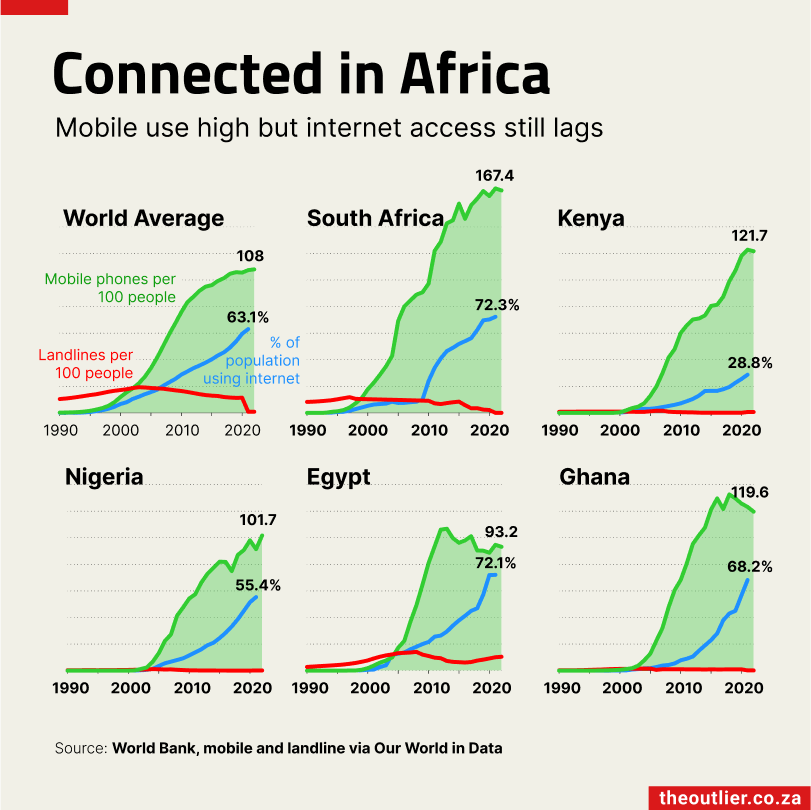
- There are 89 cellphones for every 100 people in Sub-Saharan Africa
- With 167 phones per 100 people, South Africa is well above global average of 108
- Only 36% of people in Africa use the internet. World average is 63%
African countries have leapfrogged fixed-line technology and gone straight to mobile. There are 89 mobile phones for every 100 people living in the countries classified as Sub-Saharan Africa by the World Bank, but fewer than one landline (0.6) per 100 people (2022 figures).
Some African countries, such as South Africa (~167) and Kenya (~122), are well over the world average of 108 mobile phones per 100 people. Nigeria is close with ~102.
But the percentage of people in Africa who use the internet remains low: 36% compared with 92% in the US, according to World Bank 2021 figures. The global average was 63%.
There were 489-million unique mobile subscribers in Sub-Saharan Africa in 2022, according to a recent GSMA report. That’s less than half (43%) of the population.
Only 287-million of them used mobile internet – a penetration rate of 25%. The cost of smartphones is a key reason why.
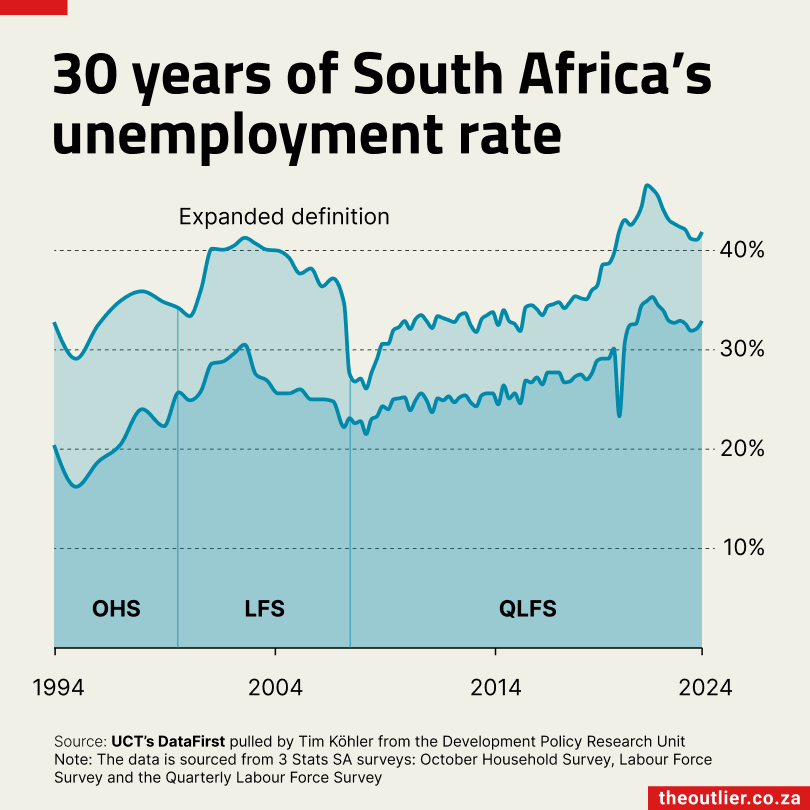
- SA lowest unemployment rate: 16.2% in 1995
- Unemployment rate has remained above 30% since third quarter of 2020
- 30 years: Stats SA developed 3 surveys to collect unemployment data
South Africa’s unemployment rate has become a pressing issue for the country in the 30 years since the transition to democracy. The lowest recorded rate was 16.2% in 1995.
Although the methodology used to track unemployment has been refined over the years, this figure still stands in stark contrast to the highest rate of 35.3%, recorded in the fourth quarter of 2021. The most recent unemployment rate is 32.9%.
Statistics SA defines the unemployment rate as the proportion of people in the labour force between 15 and 64 who were not employed but available for work and actively looking for it. This number first surpassed 30% in 2003 and has consistently stayed above this threshold since the third quarter of 2020.
The so-called expanded unemployment rate, which includes discouraged job seekers, has remained above 40% since mid-2020, highlighting the country’s broader economic challenges.
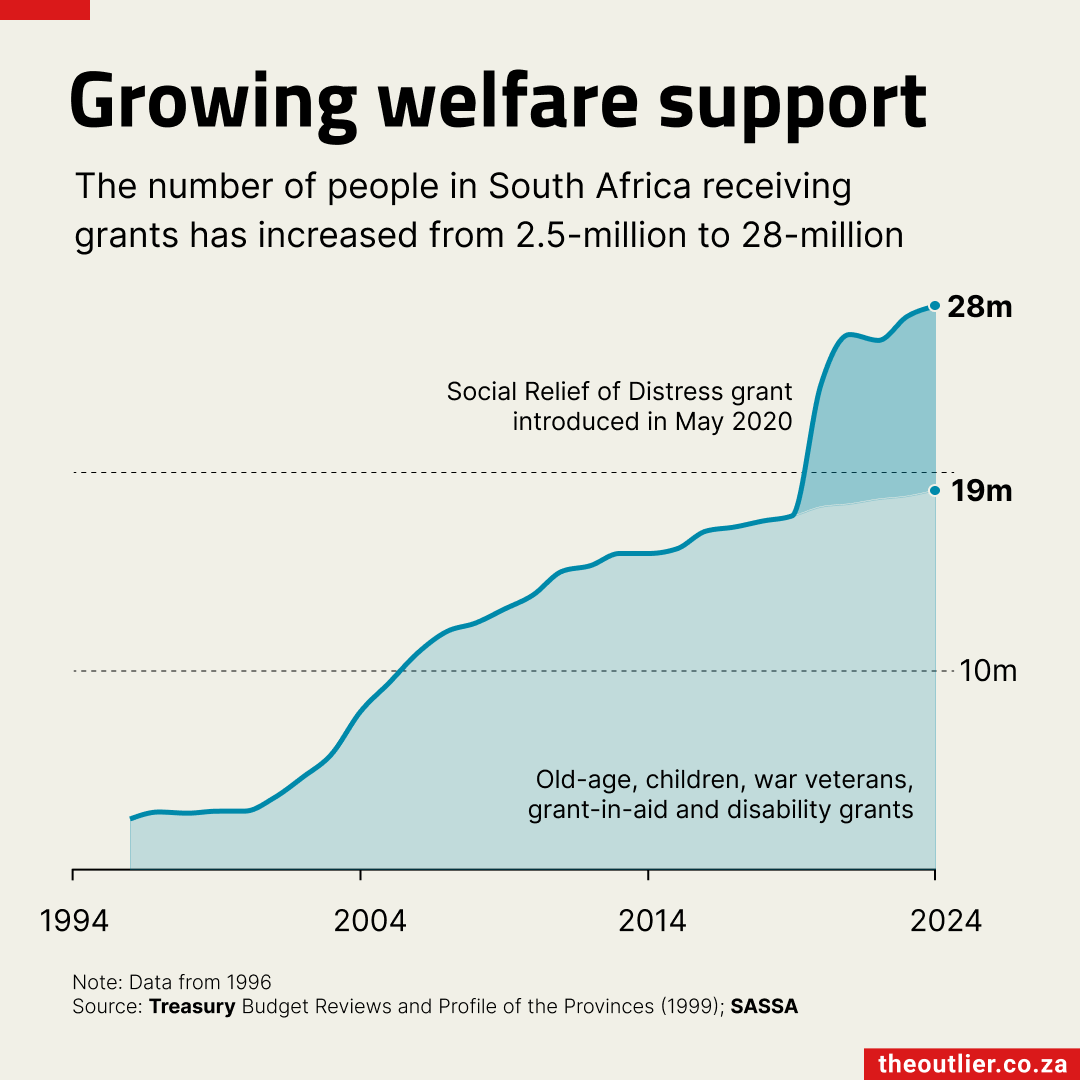
- 28-million people receive grants in 2024 – up from 2.5-million in 1996
- 13.2-million children benefit from the child support grant
- A pandemic relief grant introduced in 2020 extended to 2025
Ten times as many people in South Africa receive grants in 2024 compared with 1996. Almost 30 years ago the largest group of beneficiaries were the elderly; in 2024, it is children.
The gradual rollout of the child support grant from 1998 and the introduction of the temporary Covid-19 SRD grant in 2020 have contributed to the increase in the number of people benefiting from grants rising from 25-million to 28-million.
The government introduced the Covid-19 grant for people between 18 and 60 who required financial support due to government restrictions during the pandemic because they had no work and weren’t benefiting from other grants. This grant’s deadline has been extended to March 2025 and benefits 9-million people. It is considered a test case for the rollout of a basic income grant offering R350 a month – the lowest of the grants. The child support grant and grant-in-aid follow at R530 each.
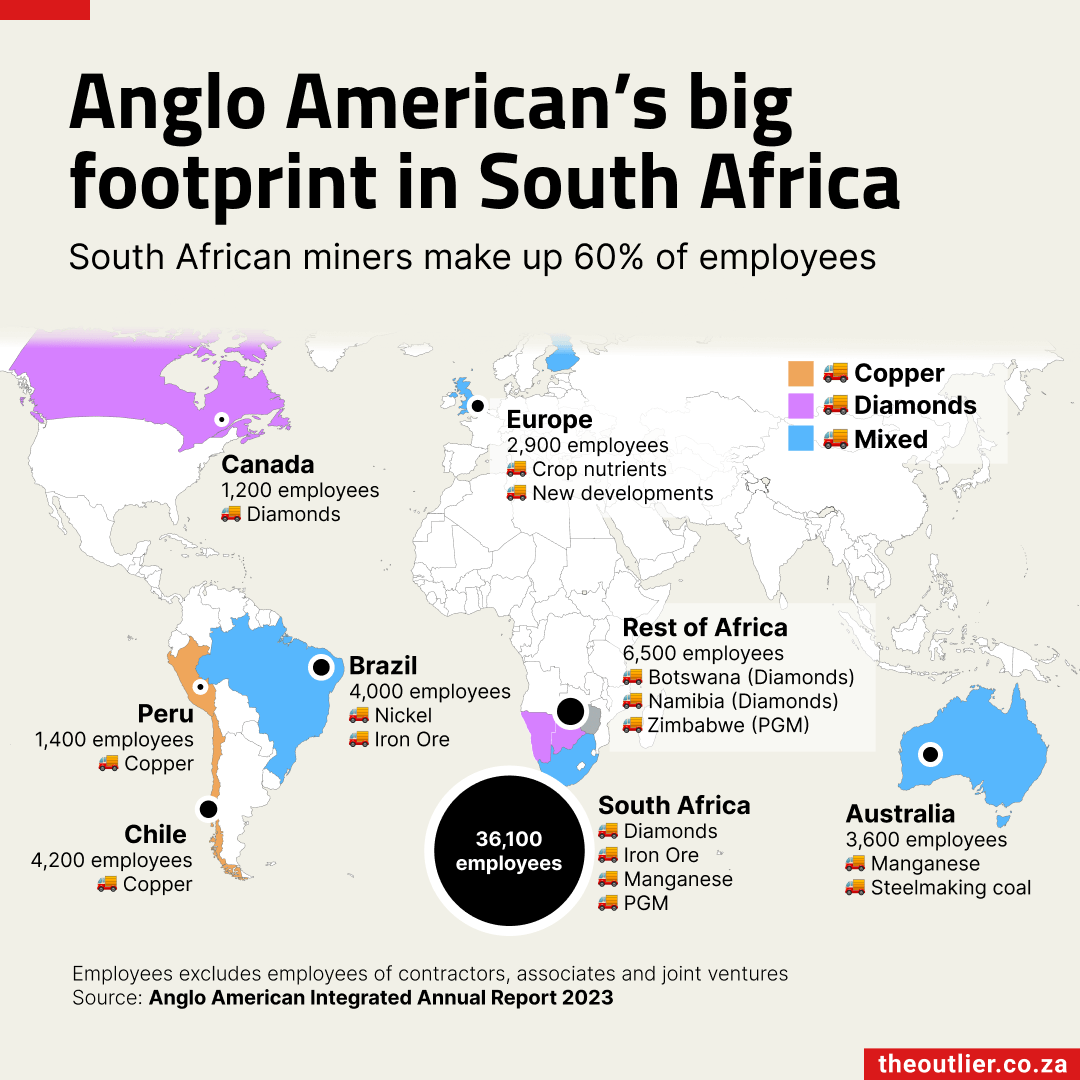
- Anglo American employs almost 60,000 people globally
- South Africa makes up 60% of its workforce
- The miner is now focusing on renewable energy metals
Anglo American employs almost 60,000 people globally, with South Africa accounting for 60% of its workforce.
Founded in South Africa in 1917, the diversified miner is listed in London and has recently been subject to unsuccessful takeover attempts by Australian miner BHP.
Anglo CEO Duncan Wanblad has outlined plans to turn Anglo into a radically simpler business, which include splitting off De Beers, its diamond business, as well as its nickel and platinum assets. It also plans to divest from its steelmaking coal assets.
Over the past year, Anglo American has been focusing on renewable energy metals such as copper and high-quality iron ore.
Anglo first entered Canada in the 1960s and has 1,200 people working on its diamond mines there. It opened its first South American office in the 1970s and still has valuable iron ore assets in Brazil, where its workforce numbers 4,000 employees.

- Companies listed on South Africa’s JSE at 30-year low
- Listings peaked at 669 in 1998, but now at 294
- JSE introducing reforms in attempt to offset losses
The number of companies listed on the JSE, South Africa’s securities exchange, has reached a 30-year low.
Listings peaked at 669 listings in 1998, but the dot-com crash led to 128 companies delisting within 2 years. There was a brief resurgence between 2003 and 2008 with the introduction of AltX, which targets small- and medium-sized enterprises. This was cut short by the global financial crisis.
Delisting is a global phenomenon and not isolated to South Africa, says Sam Mokorosi, JSE’s head of origination and deals.
Companies often delist due to mergers, acquisitions or relocating abroad, but the JSE has struggled to attract enough new listings to offset these losses.
Mokorosi said high IPO activity is typically driven by GDP growth and supportive sector policies.
To boost listings, the JSE is reducing listing bureaucracy, introducing dual-class shares, revising auditor accreditation and allowing secondary listings for companies primarily listed on the Hong Kong Exchanges.
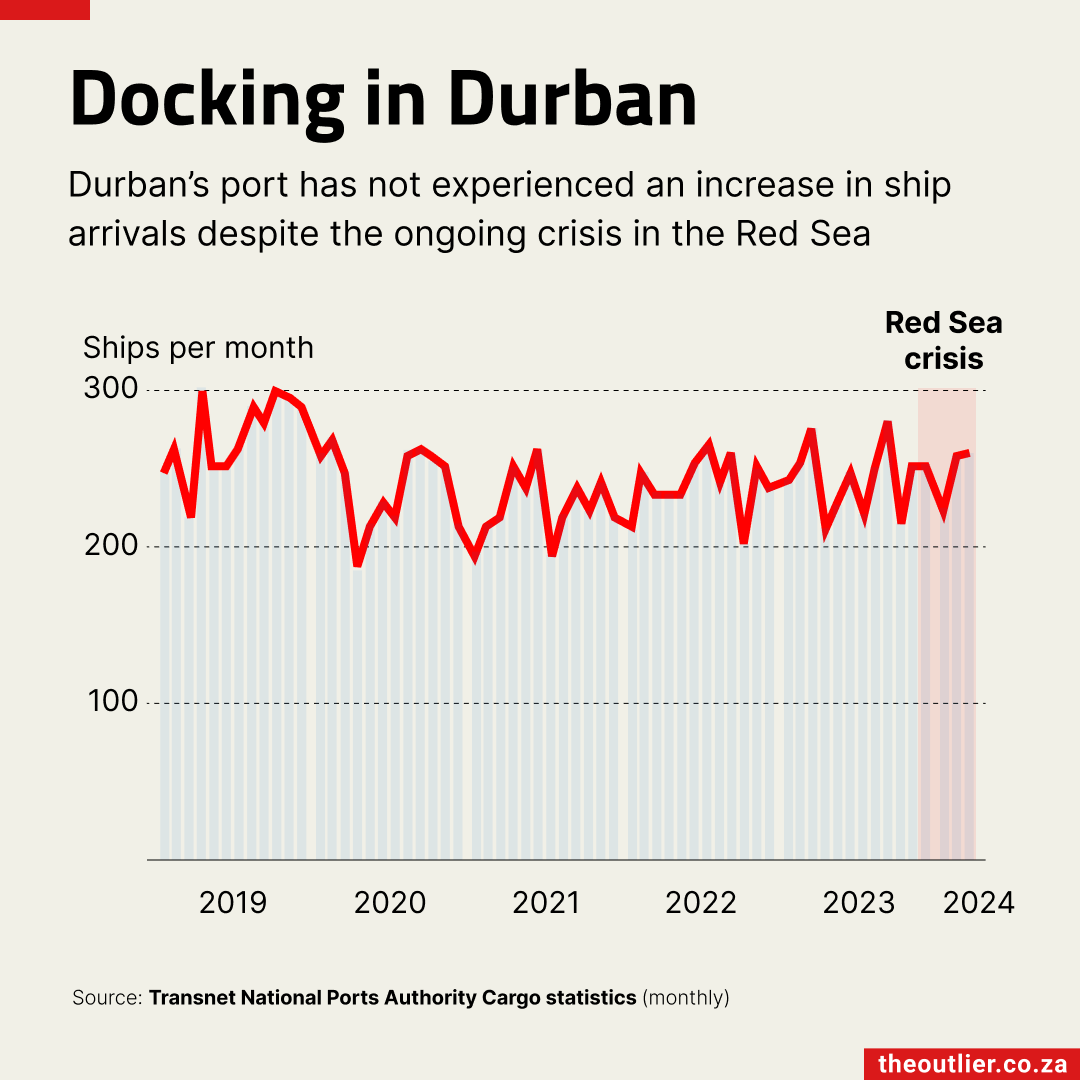
- Durban docking numbers hold steady despite increase in traffic
- Wait time at SA’s busiest port is at least 4 days
- Its container terminal has not been upgraded since 1963
Despite the spike in attacks on shipping vessels in the Red Sea sending more ships along Africa’s coast, traffic at Durban’s port has held steady.
According to Transnet statistics, 744 ships arrived at Durban in the first quarter of this year, which is 29 fewer than the 773 ships that arrived in the same period last year.
A possible reason for this is the time ships have to wait to dock at Durban, South Africa’s busiest port. In mid-April, the wait time was an average of 4 days, according to Portcast’s port congestion dashboard. This was an improvement from March, when the wait time was 7 days.
Durban has long been known to have congestion issues, Transnet chair Andile Sangqu acknowledged at a media briefing in April. He said the Durban container terminal, which handles about 65% of the port’s container cargo, had remained unchanged since 1963.
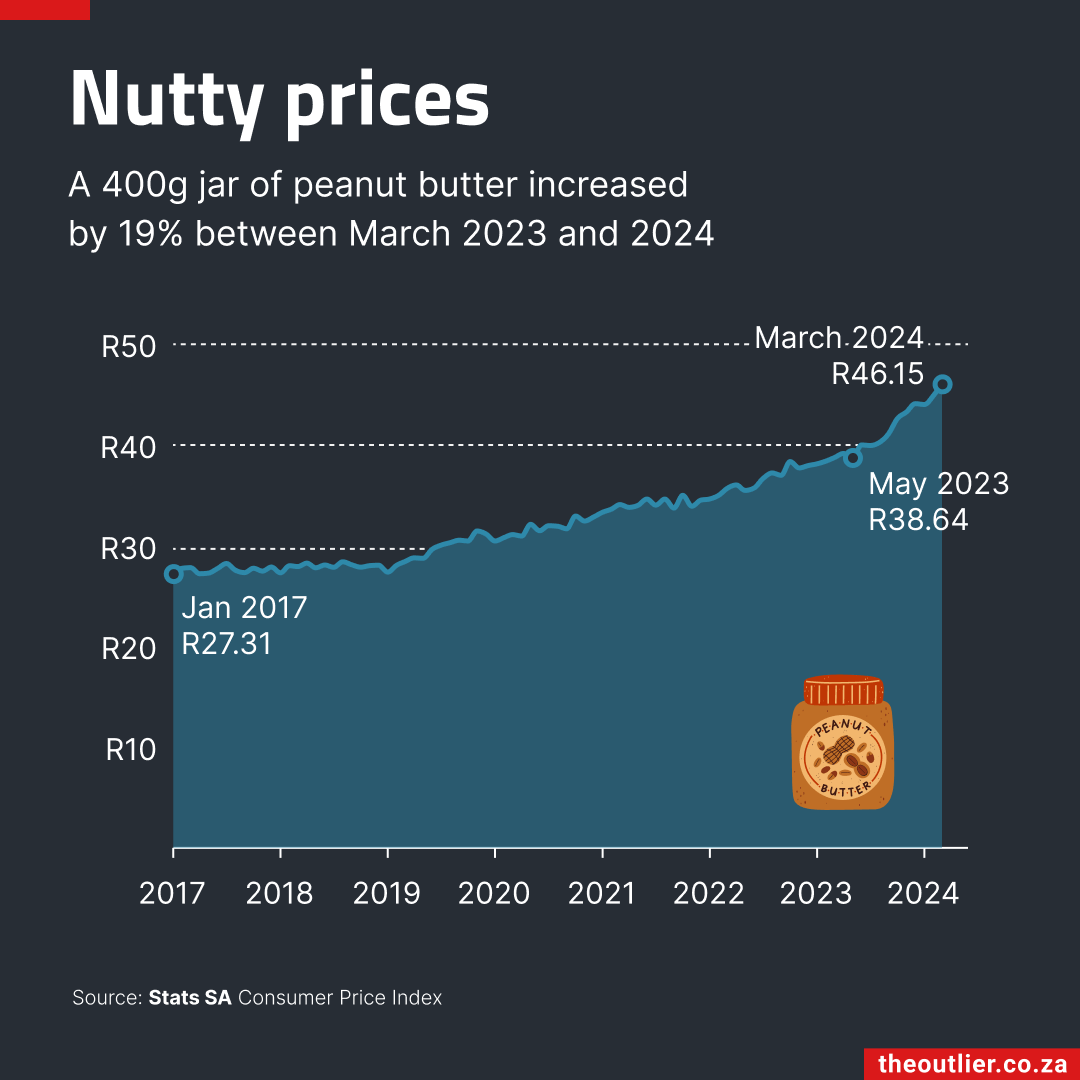
- Price of peanut butter has risen by 19% in a year
- Hike driven by local and global shortage of peanuts
- SA farmers are planting beans over peanut crops
The cost of a 400g jar of peanut butter has increased by 19% in a year, with a shortage of peanuts and high sugar prices contributing to the hike. The average price increased from R38.75 to R46.15 between March 2023 and 2024, according to Statistics SA.
Tiger Brands, which manufactures Black Cat, says 70% of its peanuts are locally sourced. But it says South African farmers are not planting as many peanuts and groundnuts, choosing other in-demand crops such as white beans, sugar beans and soybeans instead.
Drought and floods in South America has also led to pressure on supply and fewer peanuts are being imported. Argentina has had 3 years of drought, while floods in Brazil affected their peanut crops.
Peanuts from other African countries are generally not imported as they have a risk of high aflatoxin levels. Several SA brands of peanut butter were recalled this year after testing found high levels of aflatoxin, a toxin produced by fungi.
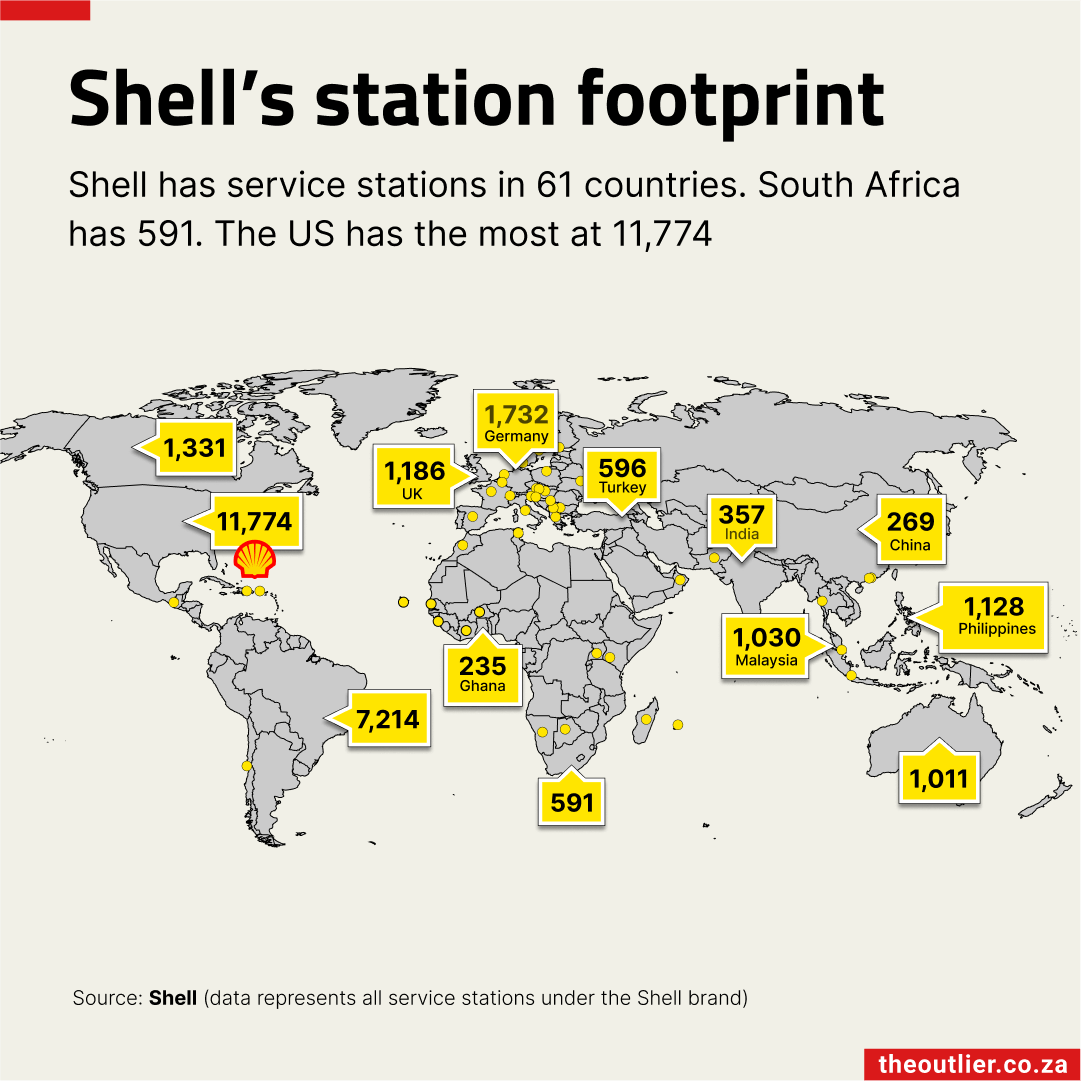
- Shell says it plans to sell South African downstream assets
- These include 591 fuel stations and its Durban refinery
- The group retains rights to explore Wild Coast and Karoo
Shell has confirmed that it plans to sell its South African downstream assets – its service stations and refinery. It will, however, retain its upstream business – the explorative and extractive activities in the Karoo and off the Wild Coast.
The energy group owns about 40,000 fuel service stations around the world. Half the stations are in the Americas. There are 591 retail outlets in South Africa, its 13th-most among the 61 countries where Shell has a presence.
Its refinery in Durban has been inactive since the end of March 2022, when Shell and BP decided to suspend operations and spending.
Shell said in May its decision to divest in South Africa was part of a comprehensive review of its global operations. For the past 10 years, it has been selling off downstream assets in Australia and Africa. It has also been scaling down in Malaysia and South America.
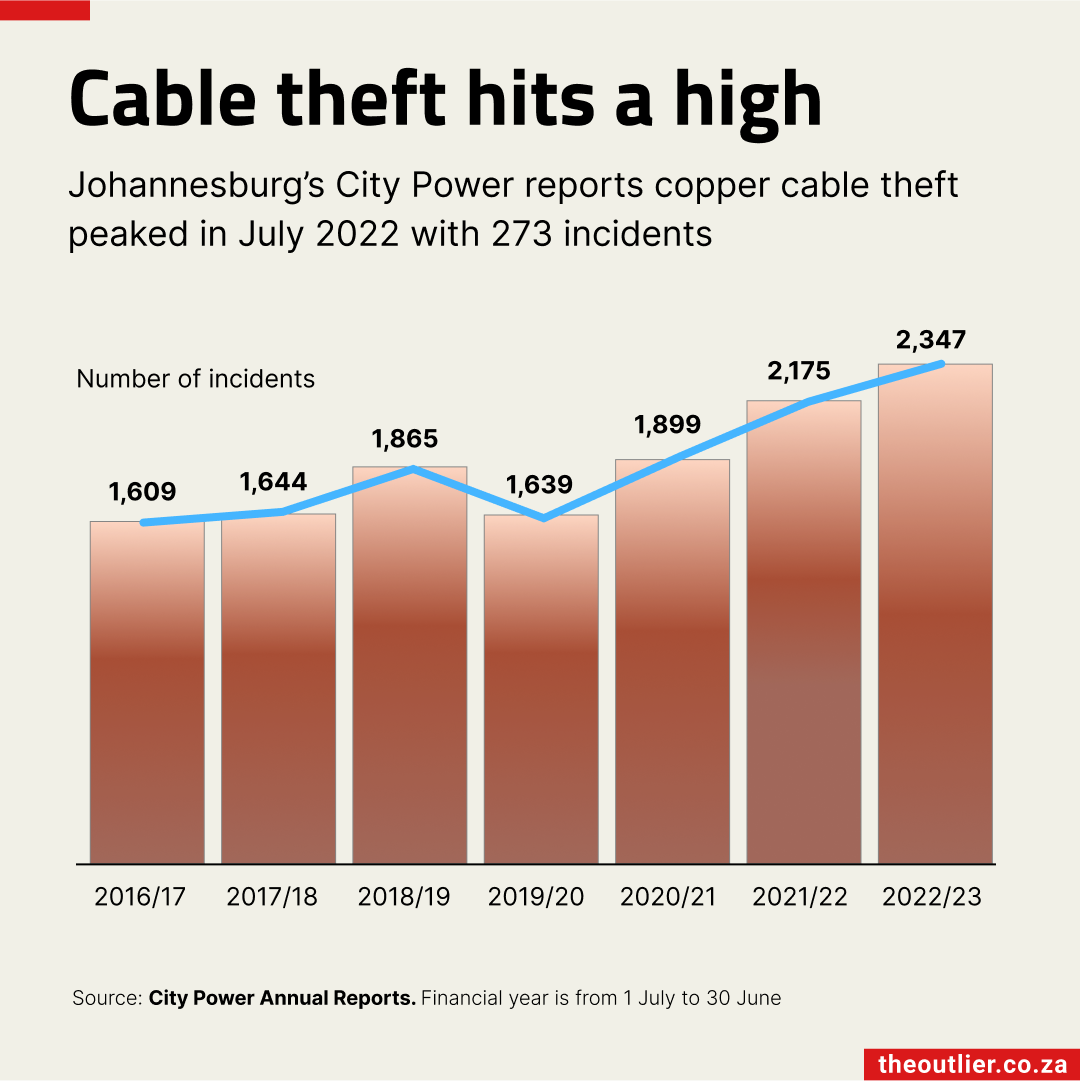
- Cable theft is escalating to new highs in Joburg
- City Power calls in military assistance due to sophisticated criminals
- Cable theft prolongs power outages, damages costly infrastructure
Johannesburg is facing a copper cable theft crisis. Between July 2022 and June 2023, there were an average of 6 thefts a day. This is an increase from 6 years ago, when there were an average of 4 a day.
The highest number of cable theft incidents in a month was July 2022, when there were 273 incidents, according to City Power’s latest annual report.
The theft has become so bad that City Power has turned to the military for help.
‘The people who attack our network are highly sophisticated and militarised. The type of firearms they carry, we cannot withstand it as civilians, and we have called on law enforcement to assist us,’ Sergeant Thela, general manager of risk and security at City Power, told Newzroom Afrika last week.
Cable theft was behind the fire on the M1 highway earlier this month. It will cost Joburg R23-million to repair. Residents in parts of the city lost power for a week.
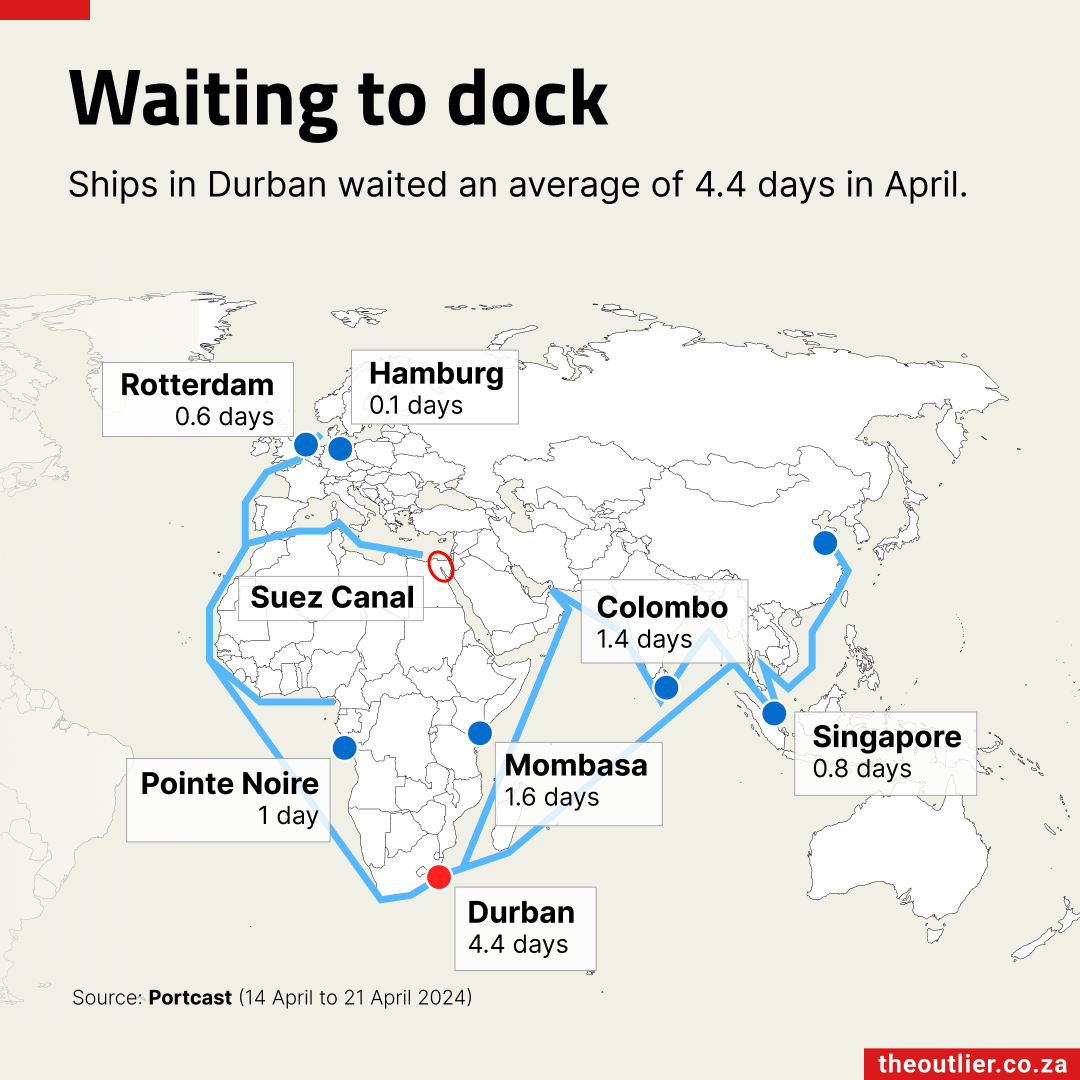
- Commercial ships are bypassing Durban because of congestion
- Ships waited an average of 4 days to dock in Durban in April
- Average wait time in Mombasa and Pointe Noire is under 2 days
Ships avoiding attacks on commercial vessels in the Red Sea are sailing past the Cape of Good Hope. Neither Cape Town nor Durban have seen an uptick in ships docking to refuel.
One reason why ships bypass Durban is because of how congested it is. In mid-April, the average wait time was 4 days, according to Portcast, which tracks global shipping carriers.
The average wait time at Mombasa in Kenya or Pointe Noire in the Republic of Congo is less than 2 days. In China’s Shanghai port, where 336 ships were waiting to dock between 15 and 21 April, the wait time was 1.1 days.
Mombasa and Pointe Noire have seen a marked increase in the number of ships docking. According to the Portcast dashboard, Point Noire’s vessel count rose from a 3-month average of 15 ships to 20 ships in one week in December 2023. Mombasa’s rose from an average of 15 vessels a week to 23.
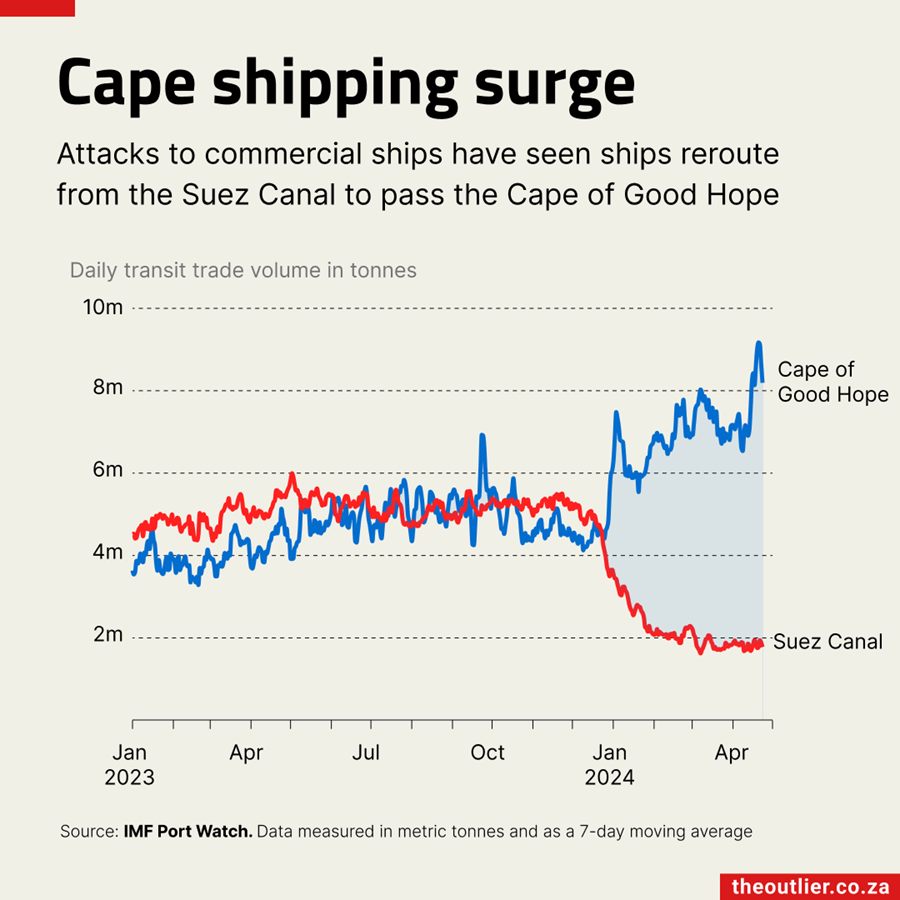
- Red Sea crisis is rerouting cargo ships around Africa
- Number of ships round the Cape is almost double
- South Africa is not benefiting from the surge in traffic
South Africa’s ports are missing out on revenue generated by the increase in commercial ships being rerouted around the southern tip of Africa.
Iran-backed Houthi rebels started targeting ships on the Red Sea in solidarity with Palestinians in November 2023. More than 50 ships were attacked between January and March this year.
As a result, shipping companies are choosing to avoid the Suez Canal. About one-tenth of maritime trade volume usually passes through the Suez Canal, but the ships are now being sent via Africa instead.
The number of ships rounding the Cape of Good Hope has almost doubled to 7,078 so far this year from 3,815 in 2023, according to PortWatch, a project of the IMF and Oxford University.
The number of ships docking at Durban, SA’s busiest port, has not increased, however. This may have to do with the waiting time. In mid-April, ships had to wait 4 days to dock.
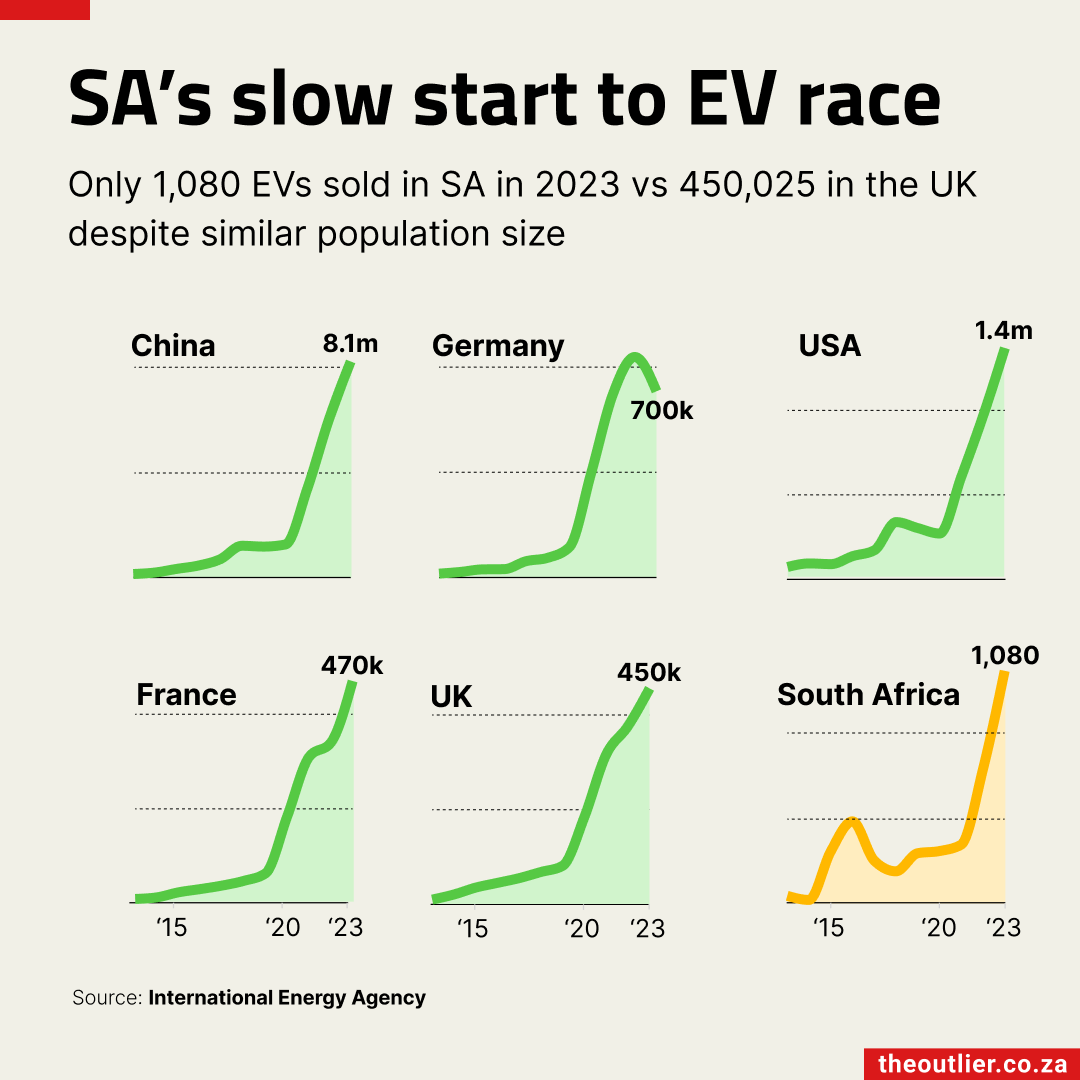
- South Africa sold 1,080 electric vehicles last year
- The UK sold more than 450,000
- China sold the most electric vehicles, 8.1-million
South Africa is way behind countries such as the UK when it comes to sales of electric vehicles. Although the countries have similar-sized populations – 60-million for South Africa and 67-million for the UK – the latter sold hundreds of thousands more EVs last year.
South Africa only sold 1,080 electric vehicles in 2023, according to the International Energy Agency, an independent organisation that focuses on the global energy sector. More than 450,000 were sold in the UK and 8.1-million were sold in China, the most in the world.
The high price range, lack of variety and charging stations are some reasons why South Africans have been slow to take to the green road.
Most of the electric vehicles available in SA are high-end cars from manufacturers such as Volvo, Porsche and Mini. With a starting price of R687,000, the GWM ORA 03 is one of the cheapest EVs in South Africa, according to cars.co.za.
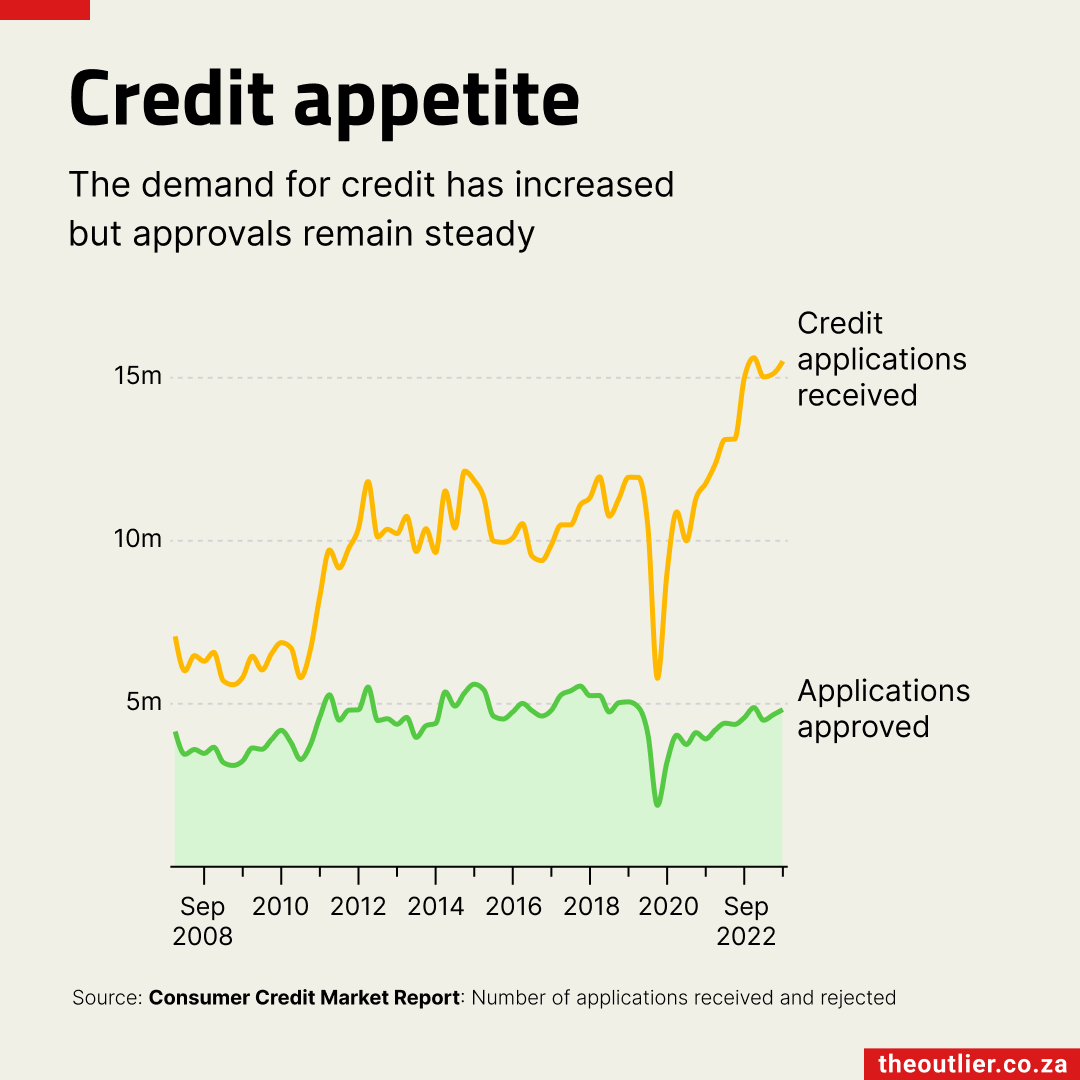
- Credit applications are increasing despite repayment struggles
- The rate of approval has declined significantly
- The number of consumers in arrears has tripled since 2007
South Africans’ appetite for debt has increased even though one-third of the country’s 27-million credit holders are struggling to pay back their loans.
According to data from the National Credit Regulator, there were 15.5-million credit applications between July and September last year. Only 31% of these applications were approved, which is a significant decrease from 2007 when about 60% of loans were approved.
About 6-million people were three or more months behind on their repayments last year, which is three times higher than the number of consumers who were in arrears in 2007.
Lending institutions generally have a low tolerance for risk, says Ans Gerber, the head of data insights at Experian, a credit bureau. They also take into account the ability of consumers to pay back their loans, which is being constrained by high-interest rates and South Africa’s high cost of living.
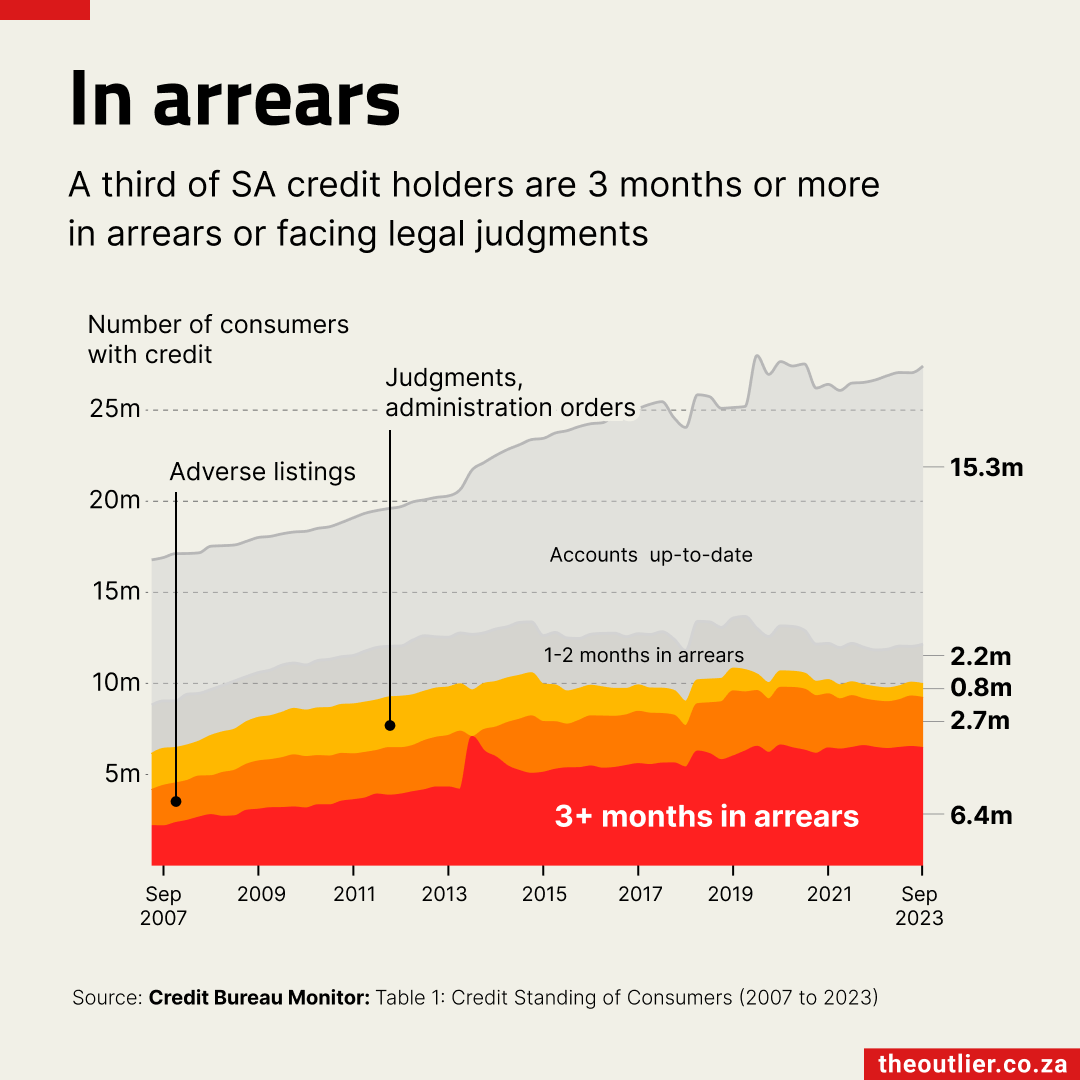
- One-third of SA’s 27-million credit holders can’t repay debt
- 10-million are +3 months behind, adversely listed or facing judgments
- Despite the challenges, appetite for credit is increasing
Almost one-third of the people in South Africa with credit are struggling to repay their debts. That’s 10-million people who are 3 months or more behind in debt repayments, or who are facing legal action and adverse listings, according to Credit Bureau Monitor data for September 2023. That’s 10-million out of the 27-million South Africans with credit.
Part of the increase is because more people have access to credit today than they did previously. In 2007, for example, 16.8-million people had credit and 6-million were behind with their repayments. That’s nearly 36%, marginally lower than today’s ratio of 37%.
Most of money owed is for mortgages and vehicle loans, as well as debt on credit and store cards. The Credit Monitor Bureau collects the data from credit providers, courts and utility service providers.
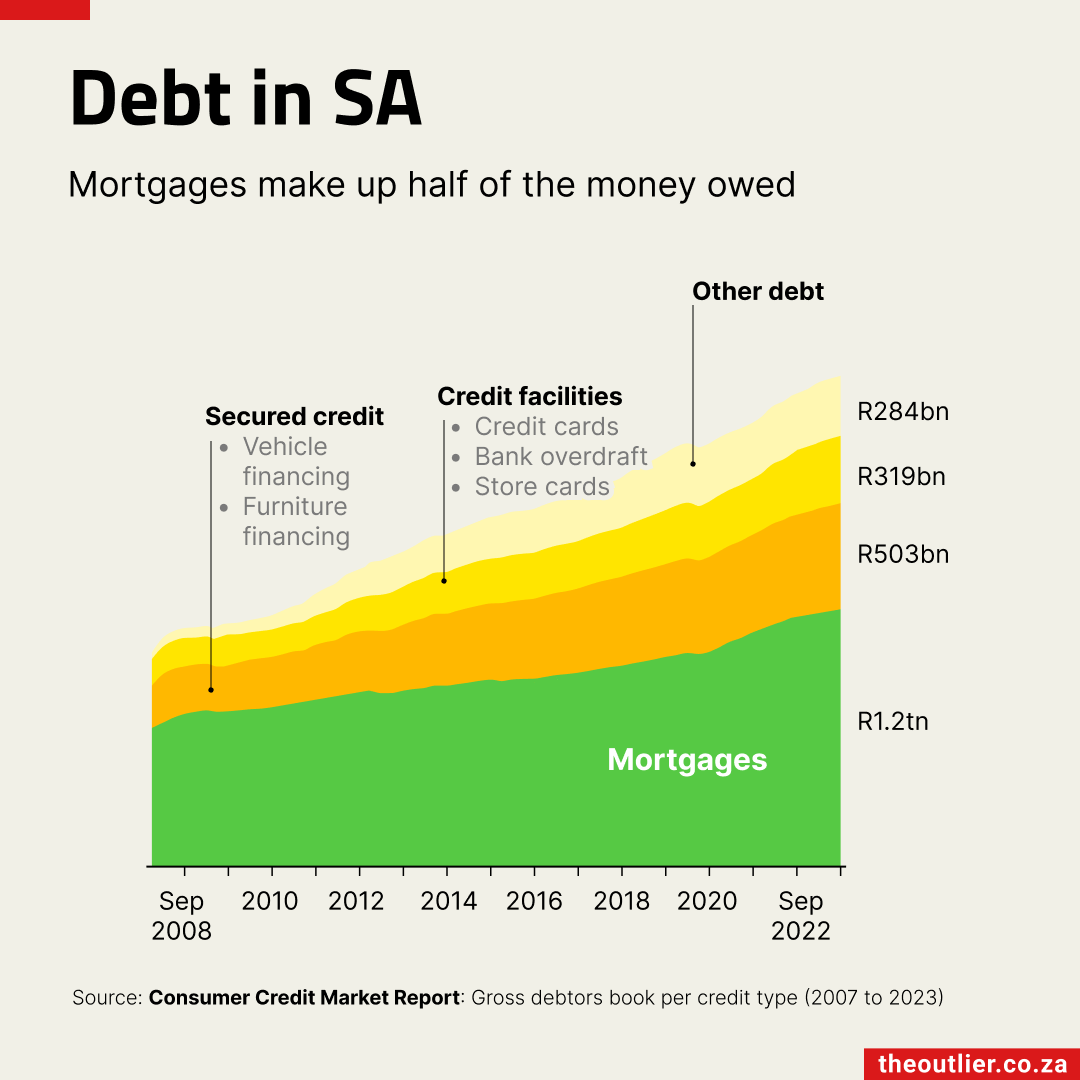
- 27-million South Africans have credit, up from 16.8-million in 2007
- Mortgages make up just over half of the country’s R2.3-trillion debt
- Banks provide 80% of consumer credit
South Africans are R2.3-trillion in debt, according to the National Credit Regulator’s consumer credit market report. This includes home and car loans as well as credit and store cards.
South Africans’ debt comprises mortgages (52%); secured credit, which includes pension-backed loans, furniture and motor accounts (22%); credit facilities, which include bank overdrafts, credit, garage and retail cards (14%). Other debt, such as unsecured and short-term loans, makes up 12%.
The number of credit consumers in South Africa has doubled in the past 16 years, but the growth includes the number of consumers with access to credit. In 2007, 16.8-million people had credit. By 2023, the number had grown to 27-million.
A third of people with credit are struggling to repay their accounts.
Banks granted 80% of consumer credit. Retailers granted 4% and non-bank financiers provide 8%. The remaining 8% is attributed to ‘other credit providers’.
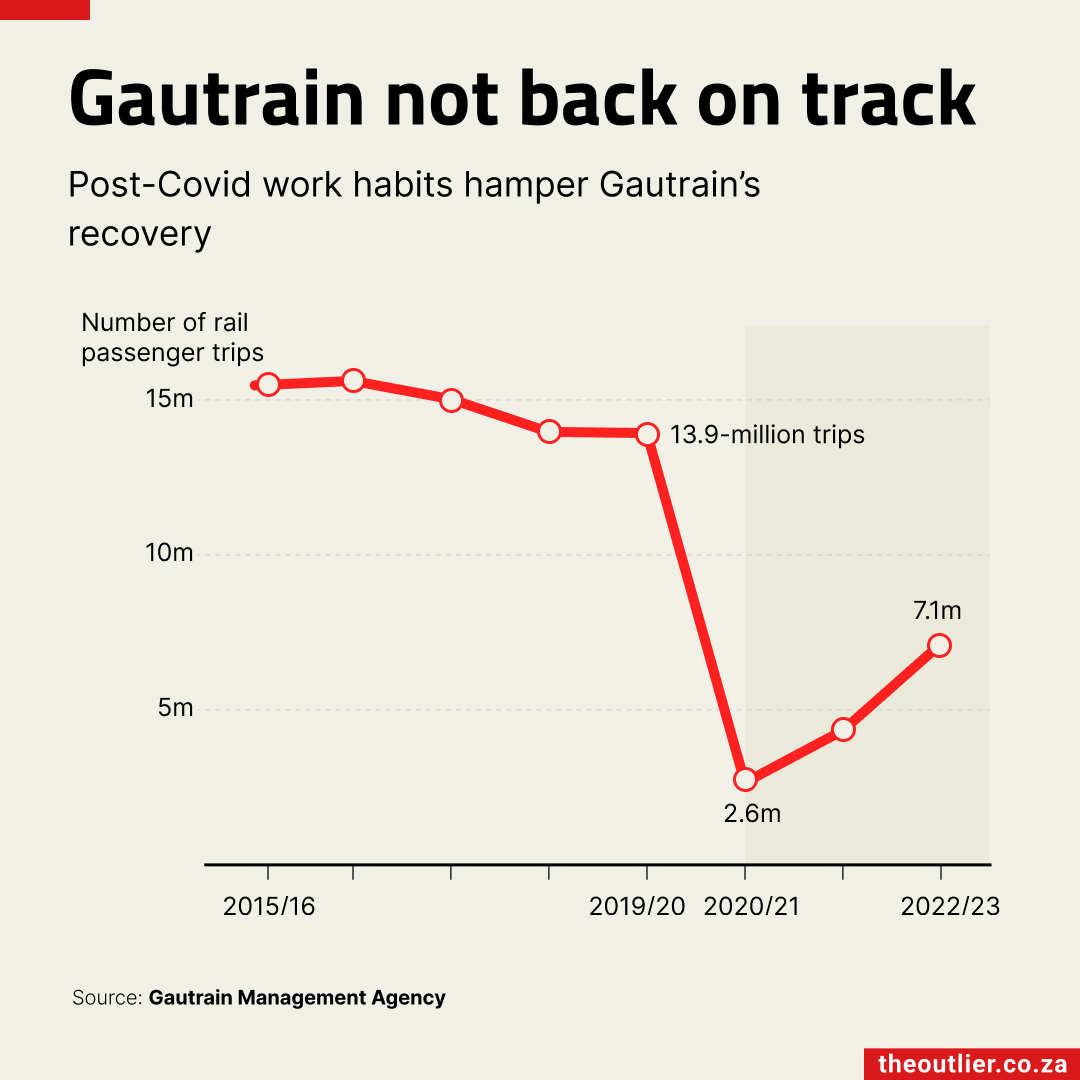
- In 2015, Gautrain made 50% more passenger trips than now
- 7-million trips were made between April 2022 and March 2023
- Trip numbers fell to 2.6-million during the Covid-19 pandemic
Five years after opening to the public in 2010, Gautrain was making around 15-million trips a year. Then the Covid-19 pandemic hit, and trips on the urban high-speed train dropped to 2.6-million. Although things have started to improve, rates are still far from what they used to be.
In the 2022/23 financial year, the number of trips increased to 7-million, a 64% increase on the year before. However, numbers would need to double to match what they were in 2015/16.
‘Like most public transport systems, Gautrain has had to adapt to a new normal of a society that no longer requires public transport in the same shape and form as before,’ says William Dachs, the CEO of the Gautrain Management Agency.
Gautrain operates across Johannesburg, Tshwane and Ekurhuleni and connects to OR Tambo International Airport. The agency has recently introduced promotions such as student discounts and half-price trips in efforts to attract commuters.
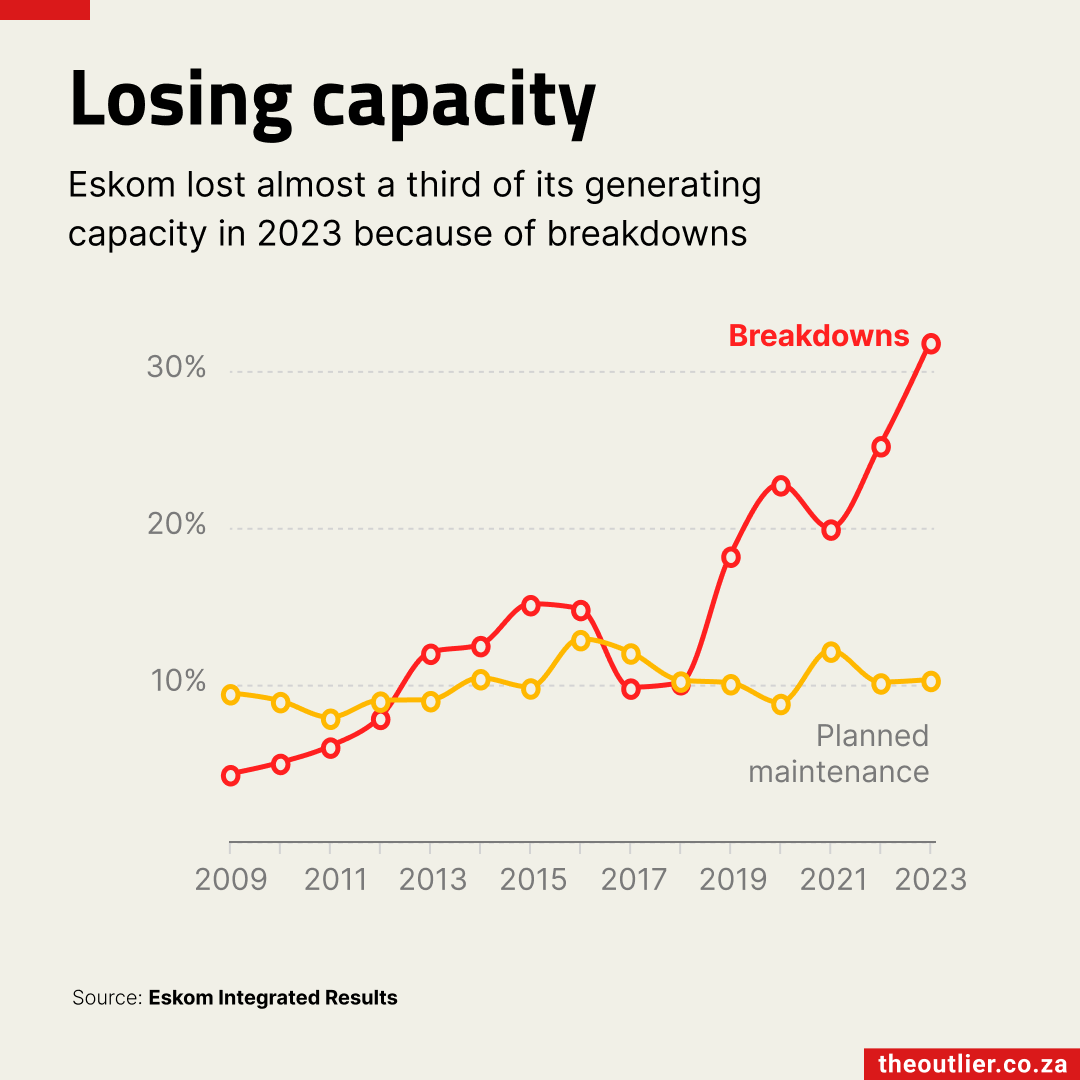
- SA’s power utility lost 32% of its capacity to breakdowns in 2023
- It’s the most energy lost to breakdowns in 14 years
- Unprotected strikes and operational issues contributed to capacity loss
Eskom’s ability to generate electricity in 2023 was significantly affected by breakdowns at its power plants. The power utility says these included electrical trips at generating units, outage ‘slips’ as well as boiler tube failures, which prevent the creation of steam to drive power-generating turbines.
Eskom CEO Calib Cassim said, however, that these were not the only causes of the 32% unplanned capacity loss. An unprotected employee strike in mid-2022 had a devastating effect on the system. The protest action, which fell within the 2022/23 financial year, was sparked by a failure in wage negotiations after the National Union of Mineworkers’ demanded a 15% increase.
Cassim has suggested that either deliberate sabotage or neglect of power stations during the stayaway exacerbated the coal-handling operations. Eskom had to pay R2.5-billion in overtime because of breakdowns at its power plants. This is an increase from the R2.1-billion paid in 2022.
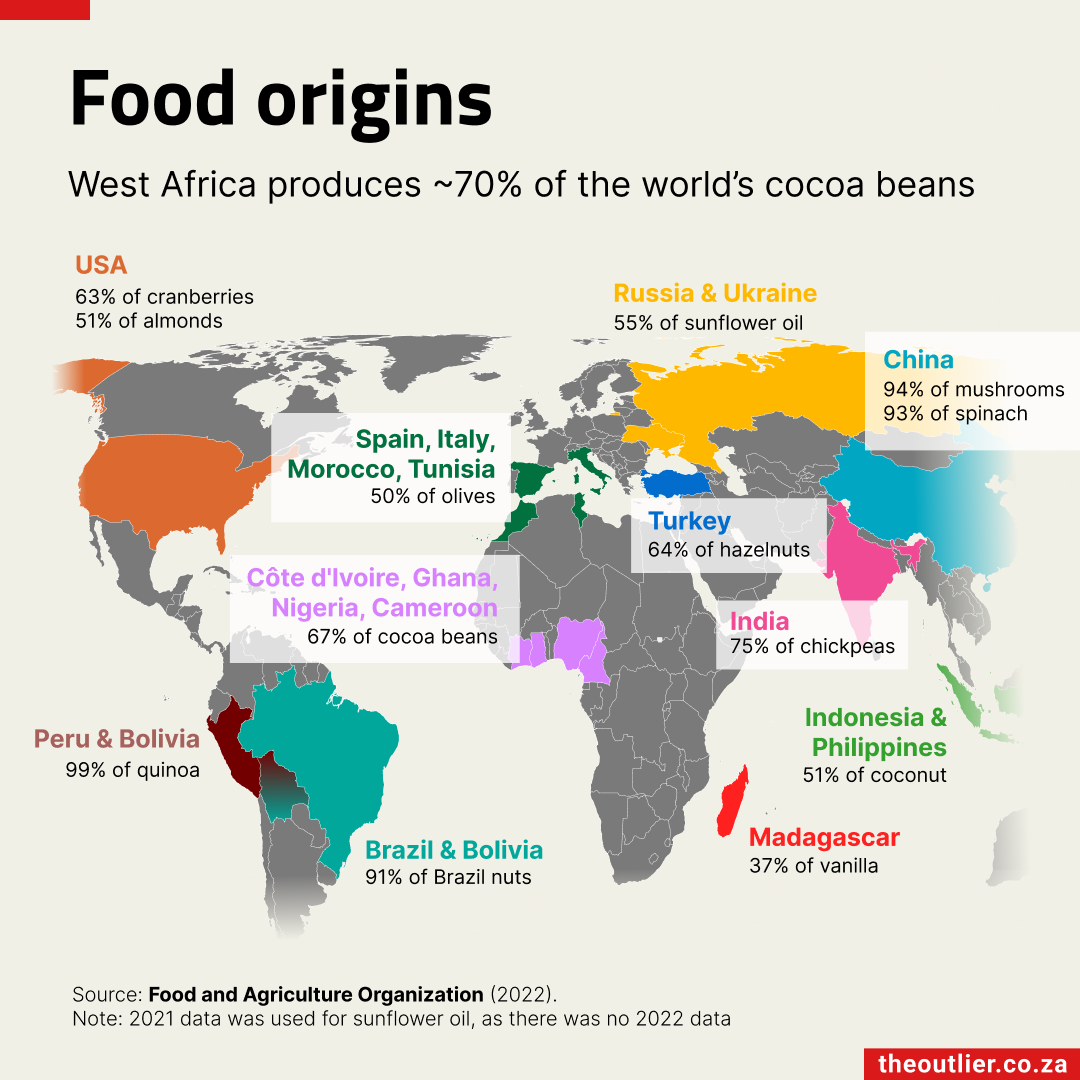
- Cocoa thrives in equatorial regions with high rainfall
- 70% of the world’s cocoa is from West Africa
- Indonesia and the Philippines produce half the world’s coconuts
Cocoa, like many food crops, is consumed globally but produced regionally. Cocoa trees predominantly grow in countries within the belt between 10° north and south of the equator, with West Africa contributing two-thirds of global cocoa production. Their natural habitat is in the lower storey of rainforests where rainfall is high throughout the year, and the temperature is relatively uniform.
Sunflower oil production is centred in Ukraine and Russia, notably affected by price spikes during the Ukraine-Russia conflict. China is the producer of various staple foods such as mushrooms and spinach, with over 90% grown within its borders. Indonesia and the Philippines produce half of the world’s coconuts, while Turkey leads in hazelnut production, and olives are primarily from Spain, Italy, and North Africa.
In the southern hemisphere, Madagascar produces a third of the world’s vanilla, while Peru and Bolivia dominate quinoa production, and Brazil and Bolivia are known for Brazil nuts.
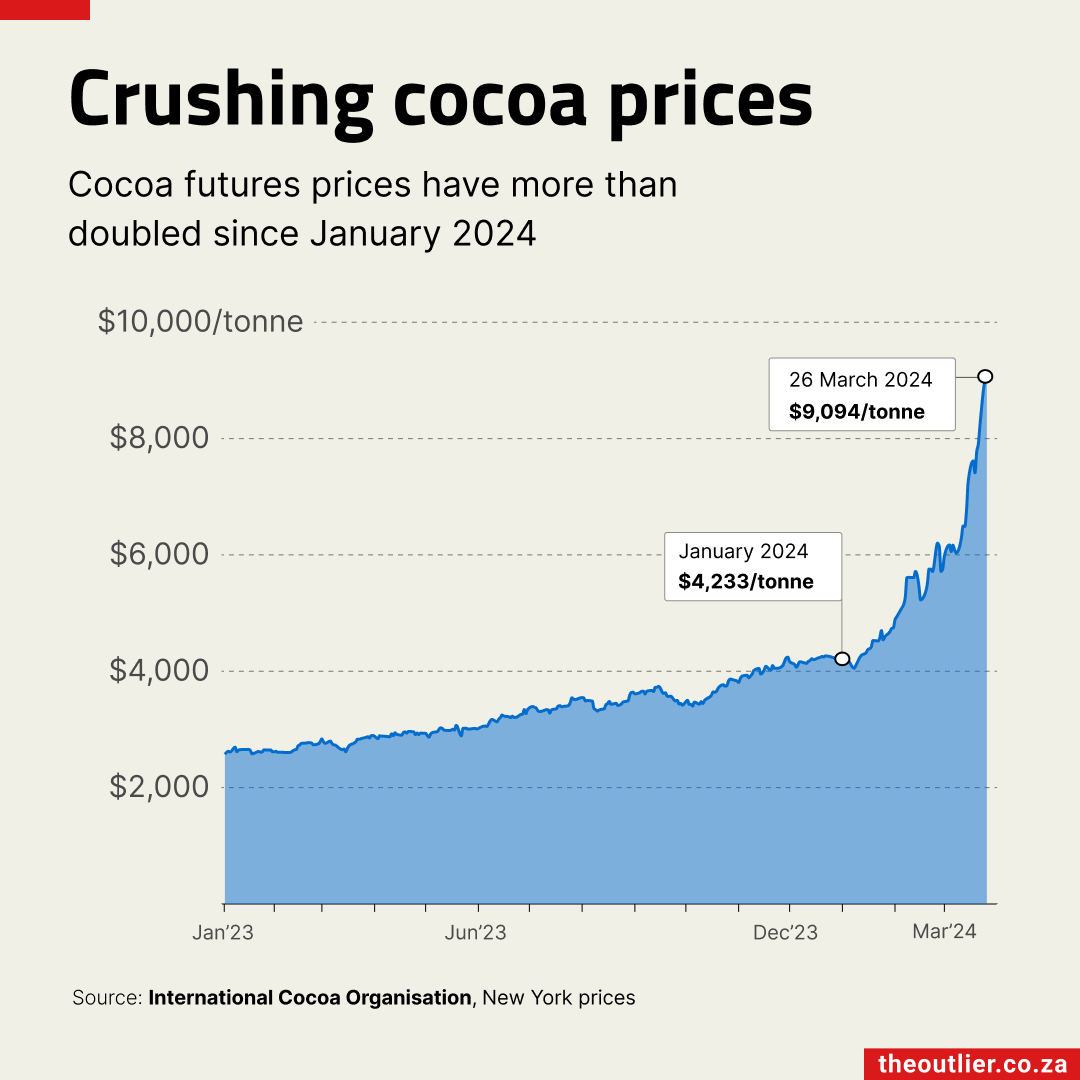
- Cocoa prices are skyrocketing due to limited production in west Africa
- Bad weather and illegal mining are exacerbating production challenges
- Cocoa futures have doubled since January, reaching $9,000/tonne
Cocoa prices have risen because most of the cocoa is grown in just a handful of countries in west Africa.
Côte d’Ivoire and Ghana, which account for more than 60% of global cocoa production, have been hit by bad weather related to the El Niño phenomenon, resulting in hundreds of thousands of hectares in lost production.
There are other confounding factors, such as illegal mining, which has overtaken many farms in Ghana and degraded the land, making it unsuitable for cocoa production.
Because cocoa bean production has dropped, the price of cocoa in global markets has increased dramatically. In New York, cocoa futures prices have doubled since January from just over $4,000 per tonne to more than $9,000/tonne this week. Cocoa futures are financial contracts that allow buyers and sellers to agree on the delivery of cocoa at a predetermined price.
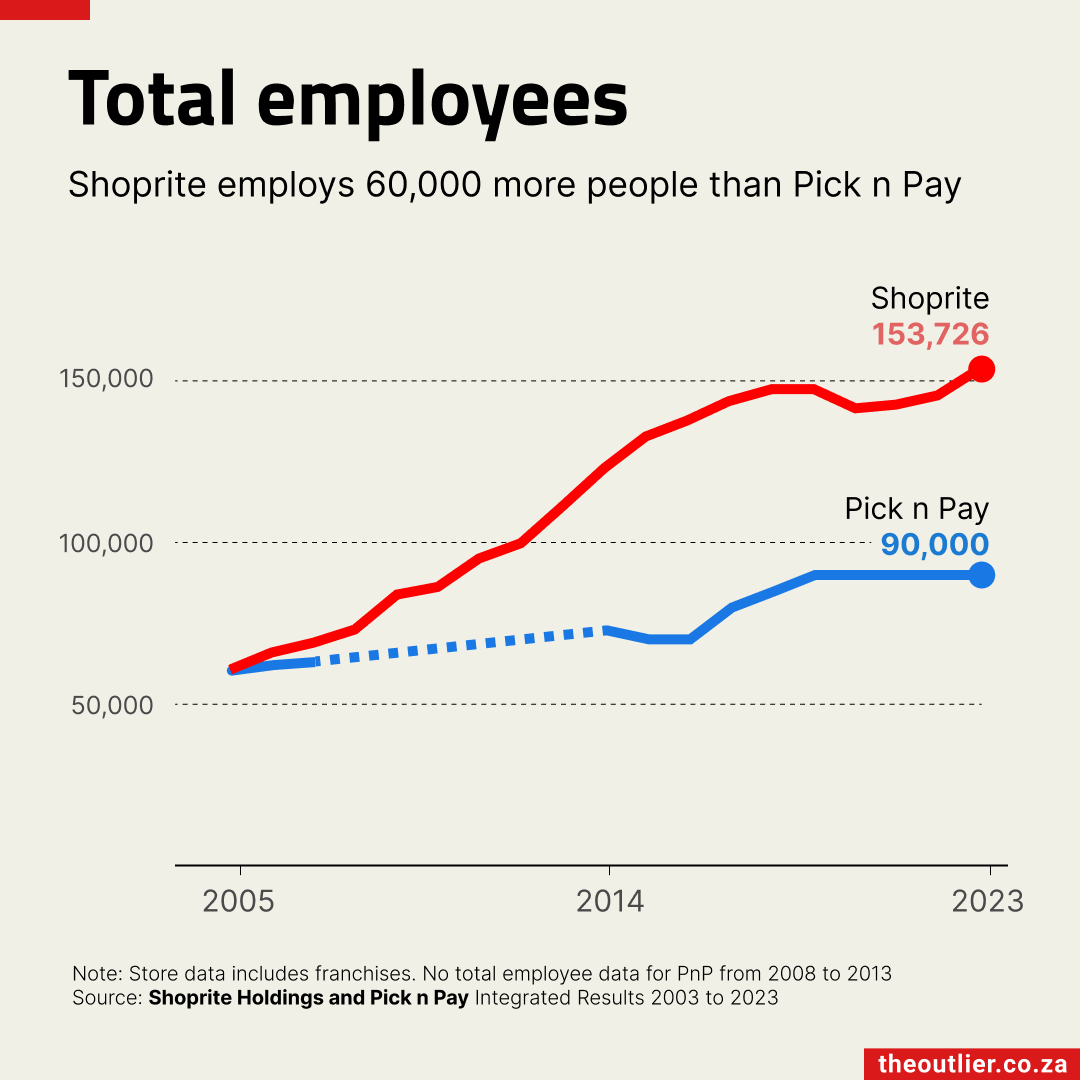
- Shoprite’s workforce exceeds 150,000, second only to government
- Sixty60 and Pick n Pay’s ASAP have over 4-million downloads each
- Sixty60 covers 505 locations, ASAP 400
In 2023, Shoprite had a workforce of 153,726 employees, which was over 60,000 more than Pick n Pay. According to Shoprite’s quarterly report issued in March 2024, the number of people it employed had increased to over 160,000. This makes Shoprite the second-largest employer in South Africa after the government. On the other hand, Pick n Pay’s employee numbers have remained relatively static, hovering around the 90,000 mark since 2019.
Shoprite’s Checkers Sixty60 and Pick n Pay’s ASAP delivery apps have become an integral part of South African culture. Although it is difficult to obtain exact numbers on home deliveries and app downloads, it appears that Checkers Sixty60 might be slightly ahead. The service covers 505 locations compared with Pick n Pay’s 400. In its 2023 integrated report, Pick n Pay reported ‘over 4-million installs,’ while Checkers Sixty60 claimed 4.5-million downloads of their app in a recent promotional video.
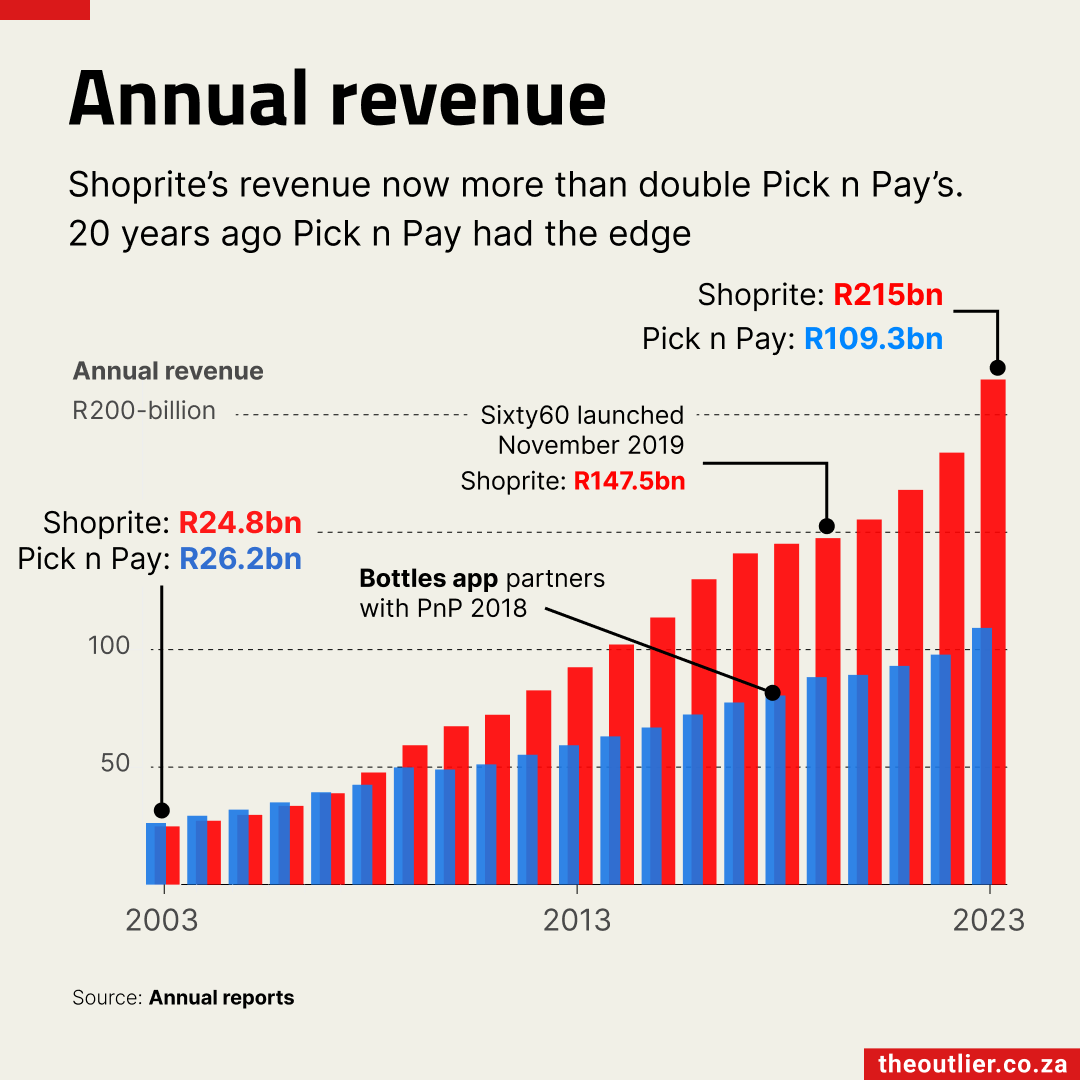
- Shoprite’s annual revenue in 2023: R215-billion
- Pick n Pay made R109.3-billion the same year
- Shoprite achieved R10-billion in revenue every 15 days in 2023
In 2007, Shoprite and Pick n Pay were on par in almost every respect: They had roughly the same revenue and employed the same number of people (~60,000).
Just over a decade later, it is different. Shoprite started pulling ahead of Pick n Pay in 2008. Since then, it has rapidly been increasing its dominance.
In 2023, Shoprite reported an annual revenue of R215-billion. It is R106-billion more than Pick n Pay for the same period. Shoprite makes more than R4-billion a week in revenue, or nearly R600-million a day.
Those are eye-watering numbers. Even people inside Shoprite seem awed by the success. Shoprite CEO Pieter Engelbrecht said in a presentation: ‘I joined Shoprite in ‘97, and in those days, it took 19 years to do R10-billion in revenue. Today, we do R10-billion in revenue every 15 days.’
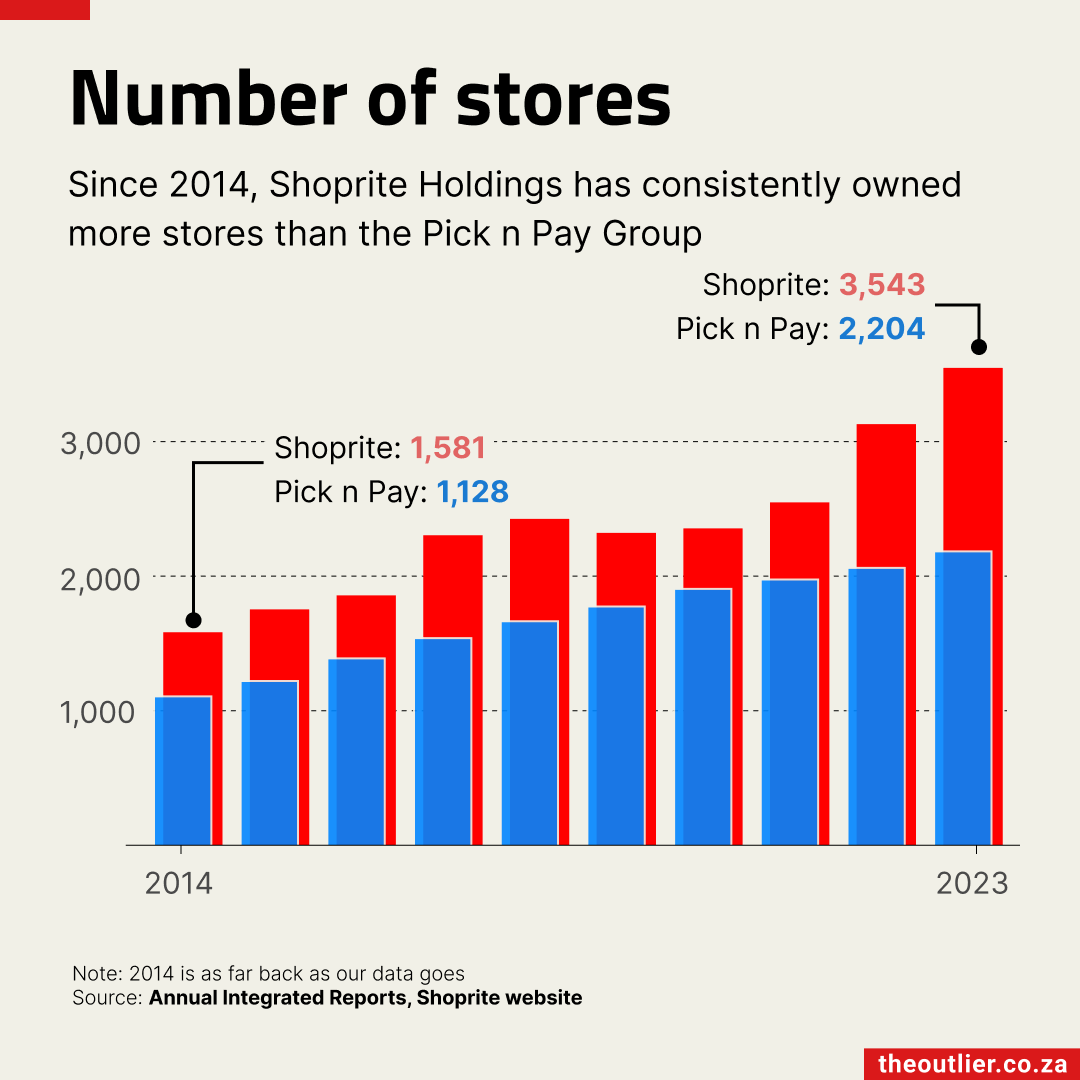
- Shoprite grew from 1,581 to 3,543 stores between 2014-2023
- The majority of Shoprite’s stores are in South Africa
- Shoprite operates in 10 African countries, mostly in southern/eastern Africa
Except for a brief time in the early 2010s, Shoprite has always had more stores than Pick n Pay. In the past three years, it has been on a new store drive.
Started as an 8-store family franchise in the Western Cape in 1979, Shoprite now has more than 3,500 stores. It adds a new store every day.
Between 2014 and 2023, the number of Shoprite stores (including franchises) increased from 1,581 to 3,543. Pick n Pay went from 1,128 to 2,204 stores over the same period.
Almost 90% of Shoprite’s stores are in South Africa. It has a presence in 9 other countries on the continent, mostly in southern and eastern Africa, including Namibia (163 stores), Eswatini (62) and Zambia (52). It has 7 stores in Ghana.
Over 90% of Pick n Pay’s stores are in South Africa. The remaining stores are in 7 countries, including Zimbabwe (72) and Namibia (35).
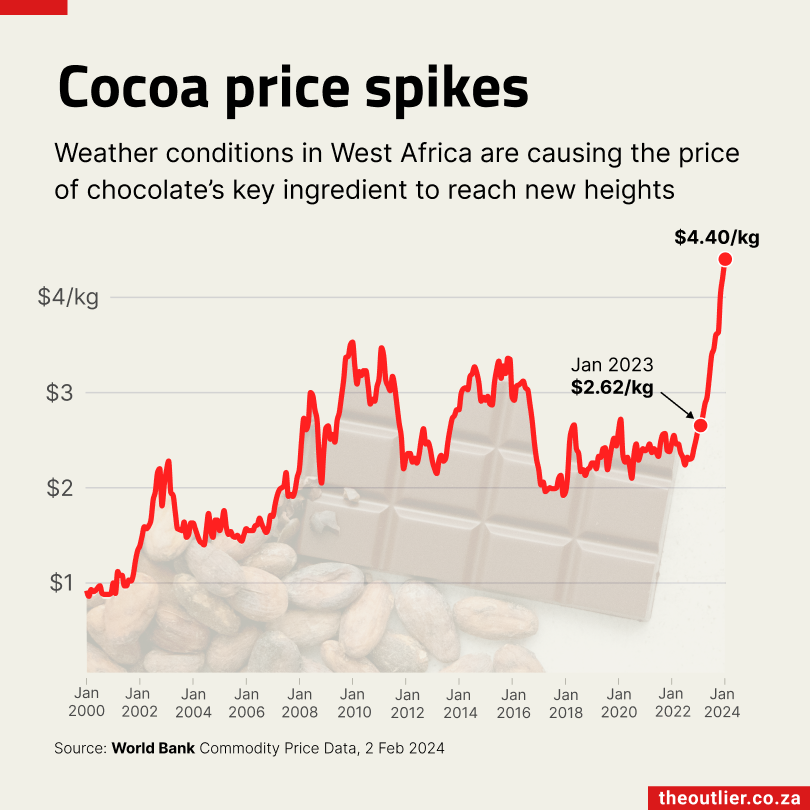
- Cocoa prices have risen by 68% in the past year due to extreme weather in Côte d’Ivoire and Ghana
- Extreme weather in West Africa damaged the cocoa harvest, affecting global supply
The price of cocoa, the key ingredient of chocolate, increased by 68% in the past year. The reason? Extreme weather conditions in two West African countries, Côte d’Ivoire and Ghana. Together they produce 58% of the world’s cocoa.
Cocoa trees grow best in the belt between 10° north and south of the equator. The trees’ natural habitat is in the lower storey of rainforests where rainfall is high throughout the year and temperatures are uniform.
Heavy rains in 2023 damaged the crop in those two countries, but shifting rainfall patterns and hotter temperatures in West Africa lie at the root of a bigger problem. Researchers project that by 2050 the areas suitable for cocoa production will shrink dramatically.
About 73% of the world’s cocoa beans come from Africa. Cameroon and Nigeria follow Ecuador to make up the top 5 cocoa-producing countries.
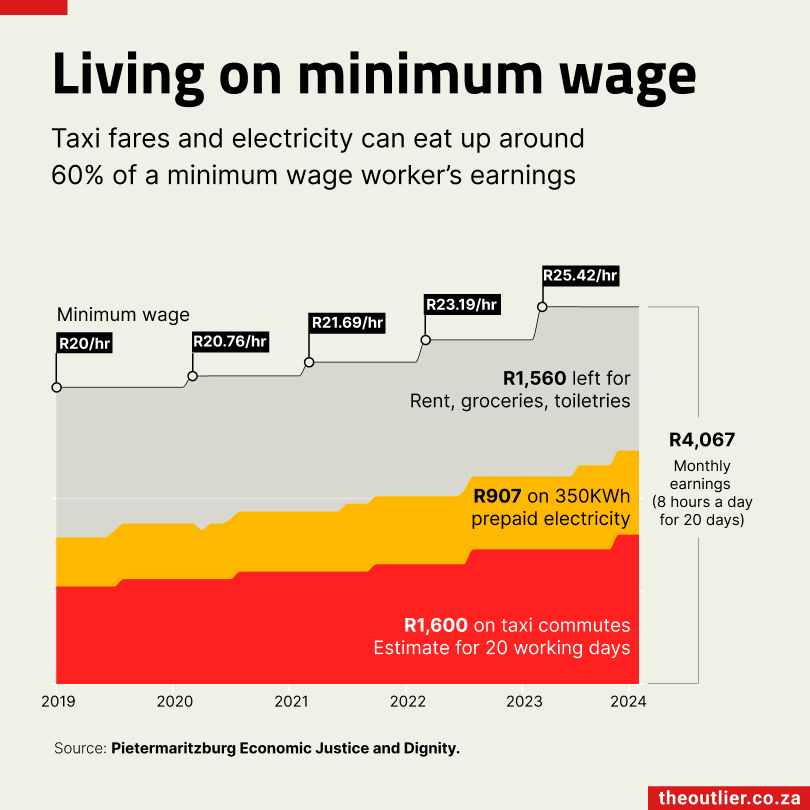
- The minimum wage is just over R4,000 per month
- Taxi travel can cost R1,600 per month
- Electricity costs another R900
The minimum wage in South Africa is R25.42 an hour. This equates to just over R4,000 a month for 20 days’ work. Last year it was R23.19 an hour.
It’s an amount that doesn’t go far in South Africa in 2024.
The bulk of a minimum wage could easily be swallowed up by basic services like transport and electricity, leaving very little for food, rent, schooling costs and so on.
Using data published by the Pietermaritzburg Economic Justice & Dignity Group (PMBEJD), taxi transport can easily cost R1,600 a month for someone travelling between their home and the nearest business district. This assumes they travel 5 days a week, and take two taxis in each direction.
PMBEJD collects prepaid electricity data from the Msunduzi Municipality and, in July 2023, the cost per kilowatt-hour of electricity increased from R2.25/kWh to R2.59/kWh. Typical usage is 350kWh a month, meaning many households spend about R900 a month on electricity.
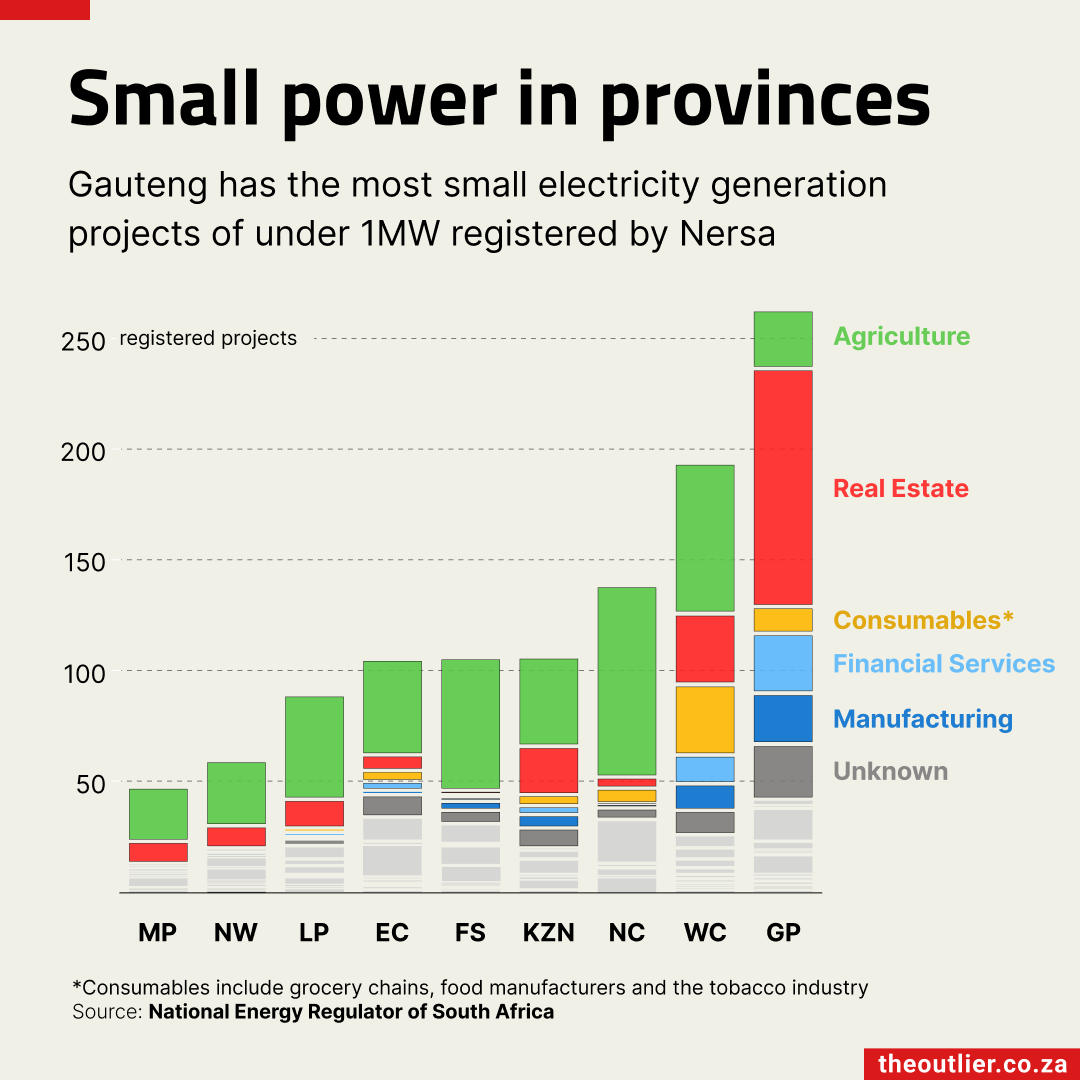
- 85% of 1,310 Nersa-registered projects are under 1MW
- Agriculture and real estate businesses lead <1MW installations
- Solar dominates <1MW installations, except in 4 projects
Between 2018 and 2023 1,310 energy projects were registered with the National Energy Regulator of South Africa (Nersa). The majority of these projects (85%) were under 1MW.
The majority of the Nersa registrations under 1MW are by businesses taking charge of their electricity security after severe blackouts in the past 3 years.
Agriculture and real estate businesses registered over half of these <1MW energy installations. Unsurprisingly, solar made up the vast majority of these. The few exceptions were:3 businesses registered wind energy, andCathedral Peak Hotel in KwaZulu-Natal registered a hydropower plant in 2019Almost a quarter of the 1MW and smaller installations are in the economic hub of Gauteng.All the smaller registered energy projects in the province are solar PV, presumably rooftop and parking lot cover installations. 40% of the installations were for the real estate industry, which includes malls, office buildings and residential properties.
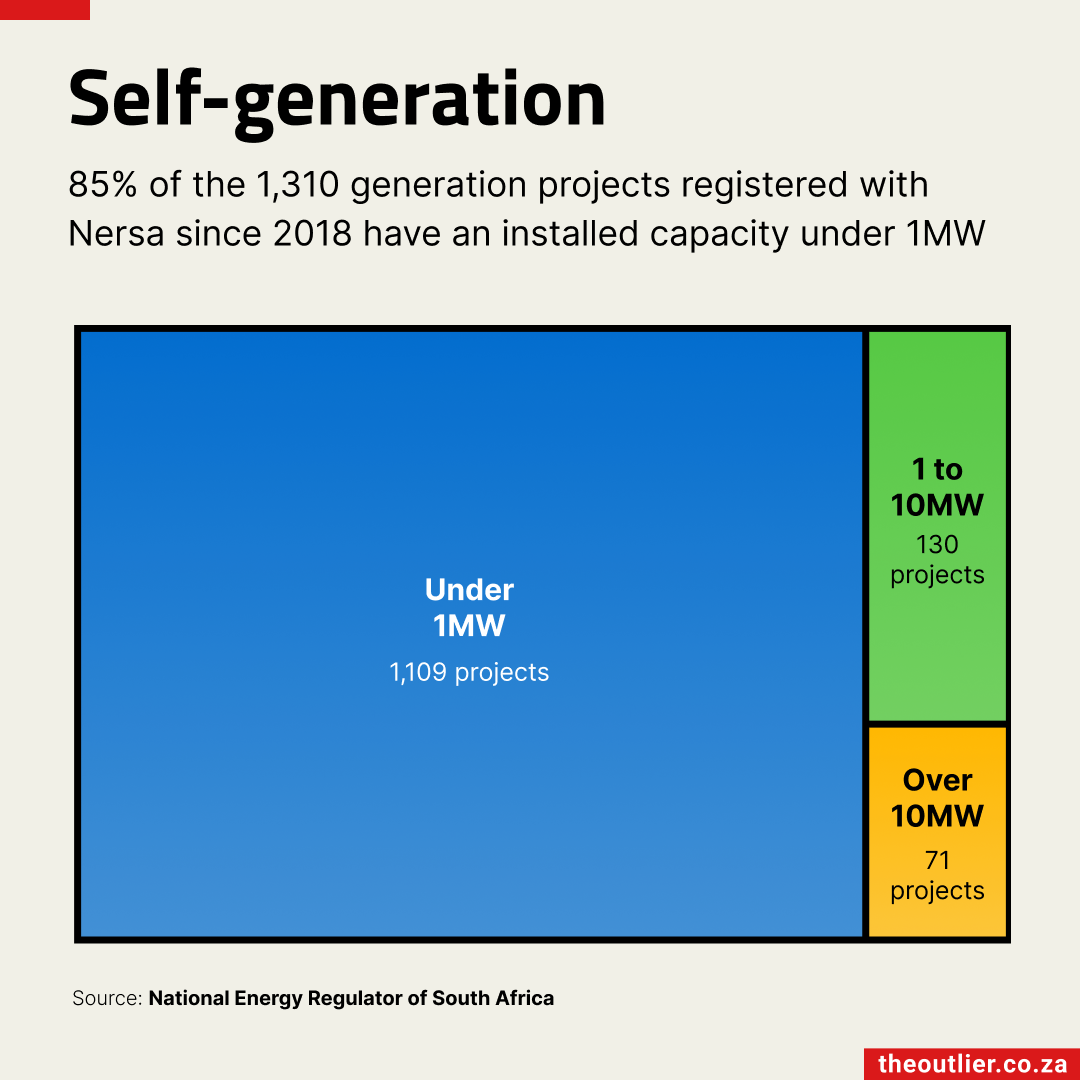
- 1,310 energy projects registered with Nersa between 2018 and 2023
- 85% of projects under 1MW serve businesses and farms
Between 2018 and 2023, businesses registered 1,310 energy projects with the National Energy Regulator of South Africa (Nersa).
The majority of these projects (85%) were under 1MW. A 1MW installation is roughly enough to power 650 average homes. These ‘smaller’ installs are primarily those done by businesses, farms and shopping centres looking to bolster their energy supply against the threat of loadshedding. In the last 3 years, the country experienced 495 days of blackouts.
Nersa’s registrations do not include the much larger REIPP projects like the solar and wind farms that are focused on putting power into the national grid.
Of the 1,310 projects licensed, 1,109 have been installs of under 1MW. There are also 130 projects between 1MW and 10MW and 71 projects larger than 10MW. The caption of this chart has been updated.
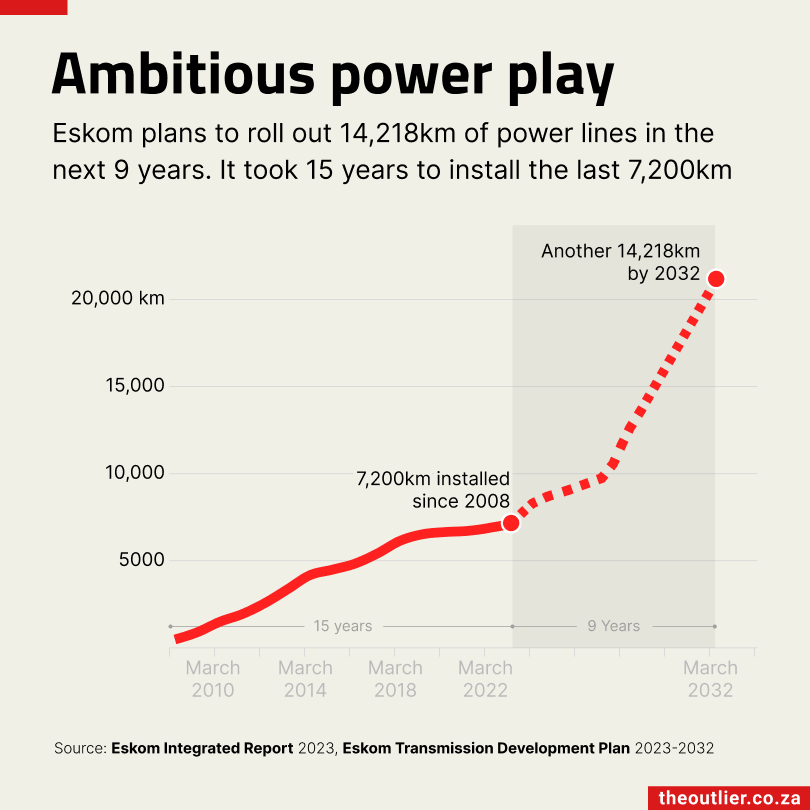
- Eskom needs to add 14,218km of transmission lines
- It has a 9-year deadline
- Eskom took 15 years to install 7,200km of transmission lines
Eskom has signed up 6,180MW of independently produced renewable power in its last 4 bid windows. It’s a 10th of Eskom’s generation capacity. But Eskom is only using a third of this renewable power, according to its daily generation reports. In November, Eskom used an average of 2,100MW of renewable energy. Eskom’s own wind farm generates 100MW.
To integrate new renewable energy generated in the Northern, Eastern, and Western Cape into the national grid, Eskom must add 14,218km of transmission lines by 2032. The deadline for this addition is 9 years away. Over the past 15 years, Eskom installed 7,200km of transmission lines at an average of 451km per year. To meet the 2032 deadline, Eskom will need to triple its efforts.
The Transmission Development Plan outlines two deadlines for Eskom: 2,893km of transmission lines installed by 2027 and 11,325km by 2032. These lines will extend the 350,000km-long national grid.
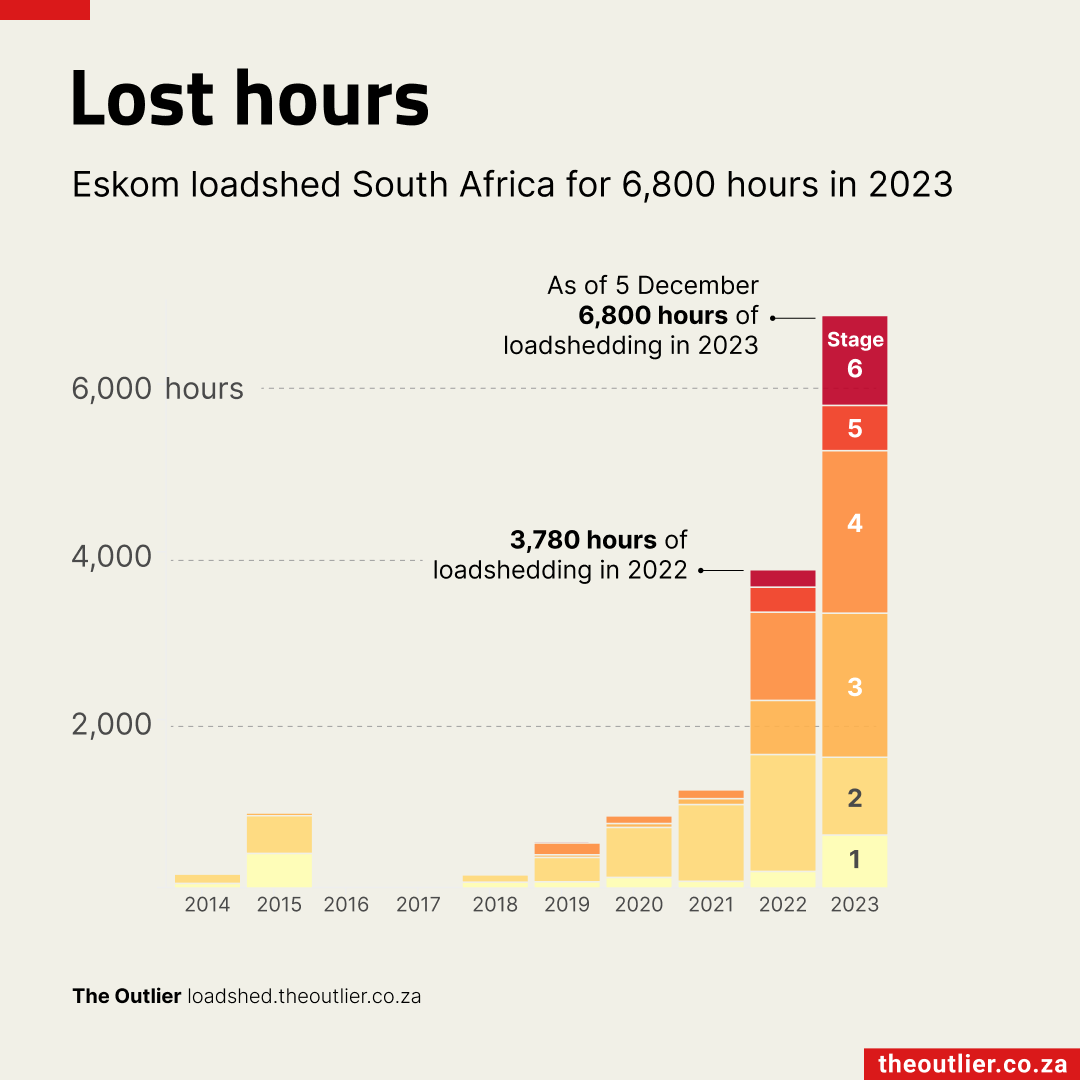
- 6,800 hours of loadshedding in 2023 so far
- Most of the year has been under stage 4
- 1,060 hours of stage 6, five times that of 2022
By early December Eskom had shed more than 6,800 hours of electricity in 2023. This is almost double the amount lost in 2022. For 8 years, stage 2 was the most common stage of loadshedding. However, 2023 saw a shift: South Africa saw 1,940 hours of stage 4 loadshedding, the most common stage. Stages 3 and 6 followed. The country only had 1,326 hours with no loadshedding. This was a drop from 4,980 in 2022.
South Africa had more hours of stage 6 loadshedding in 2023 than in any previous year. It first had stage 6 in 2019.
Eskom struggled with breakdowns, costing it a third of its generation in 2023. 9 years ago, breakdowns affected just over a tenth of its generation.
In May South Africa imported over 880MW of solar panels from China. It coincided with the month with the highest stages of loadshedding.

- China loaned African countries $170-billion over 20 years, primarily to develop infrastructure
- The transport sector received R49-billion, some of which was spent on SA’s locomotives
- The biggest portion went to the energy sector, although no new projects have been added since 2020
China committed about $170-billion in loans to African countries between 2000 and 2020. Most of it was to develop infrastructure under the Belt and Road Initiative, a grand plan to connect Asia with Africa and Europe.
About 70% of the money was funnelled to 10 countries, with Angola receiving the most. It spent a third of its $45-billion on Sonangol, the state-owned oil company.
Nearly a third of the loans was directed to the transport sector. The biggest amounts funded railway projects in Kenya, Ethiopia and Nigeria as well as South Africa’s Transnet locomotives.
About $60-billion was spent on energy projects, including the Kusile and Medupi coal power stations.
Chinese loans tapered off during the Covid-19 pandemic and no new energy projects have been added since 2020.

- Almost 60% of SA grant recipients who have bank accounts depend on private institutions to deliver their money
- State-owned Postbank administers payments, but its service is unreliable
- Postbank lost 1.8-million customers in the past year, while Capitec grew its grantee customer base by 54%
Each month the money for 19-million people who rely on SA Social Security Agency grants is paid into 12-million bank accounts. An increasing number of these (59%) are at commercial banks, with the remainder paid via the Postbank or the Post Office.
State-run Postbank took over the administration of payments in October 2022, the third change in 5 years. The transition has been difficult and there are regular reports of delays and other ‘glitches’.
As a result, grantees have been seeking more reliable options. In the past 12 months, Capitec Bank increased its number of grant account holders by almost 1.1-million to 3-million while Postbank lost 1.8-million customers.

- 712 fully electric vehicles were sold in SA in the first nine months of 2023
- 502 electric vehicles were sold in the whole of 2022
- Volvos and BMWs are among the most popular electric vehicle choices for South Africans
The market for electric vehicles in South Africa is still small but it’s growing quickly. 712 electric vehicles have been sold in South Africa in the first nine months of 2023. This is 40% more than were sold in the whole of 2022. And 2022 electric vehicle sales were already more than double the previous year.
Despite heading for a record year of sales, fully electric vehicles make up just 0.3% of South Africa’s passenger vehicle sales.
Electric vehicles still fall at the high end of the market with most buyers opting for the Volvo XC40, BMW iX or BMW X3, which cost between R1-million and R2-million. In the first 9 months of this year, 351 electric BMWs were bought and 144 Volvos. This is followed by 72 Minis and 69 Mercedes.

- 15% increase in food poverty line is the biggest in the past decade
- Monthly child grants are more than 30% less than the cost of a minimum nutritional diet
- Rocketing food costs push the poverty line up by almost R100/month
South Africa's child support grant has been below the food poverty line – the amount it costs to buy the food needed to meet a child's basic nutritional needs – for more than a decade, and the gap is growing.
Every year, the government increases the grant by an average of R20, but recent food price increases have been far higher than in previous years. The most recent poverty line is R750 a month, which is 15%, or nearly R100, higher than it was a year ago. The gap between the child grant and the food poverty line now stands at R250.
In 2012, the child support grant covered 76% of the minimum amount of food for a month prescribed by the poverty line. The latest grant covers only 67%.

- It was 20% more expensive to buy eggs in October than in September
- There are fewer eggs available in stores after 1 in 5 egg-laying hens died because of avian flu
It was expensive to buy eggs in October. The cost of 60 eggs rose from R136 to R162 between September and October, according to prices collected by the Pietermaritzburg Economic Justice and Dignity Group, which tracks the cost of food for families living on low incomes.
Supermarket shelves have been low on eggs the past few weeks because of an avian flu outbreak, which led to 1 in 5 egg-laying hens being culled or dying, the Financial Mail reported.
The country has had outbreaks before, but the usual control methods have been less effective this time around, says Shahn Bisschop, a specialist poultry vet from the University of Pretoria.
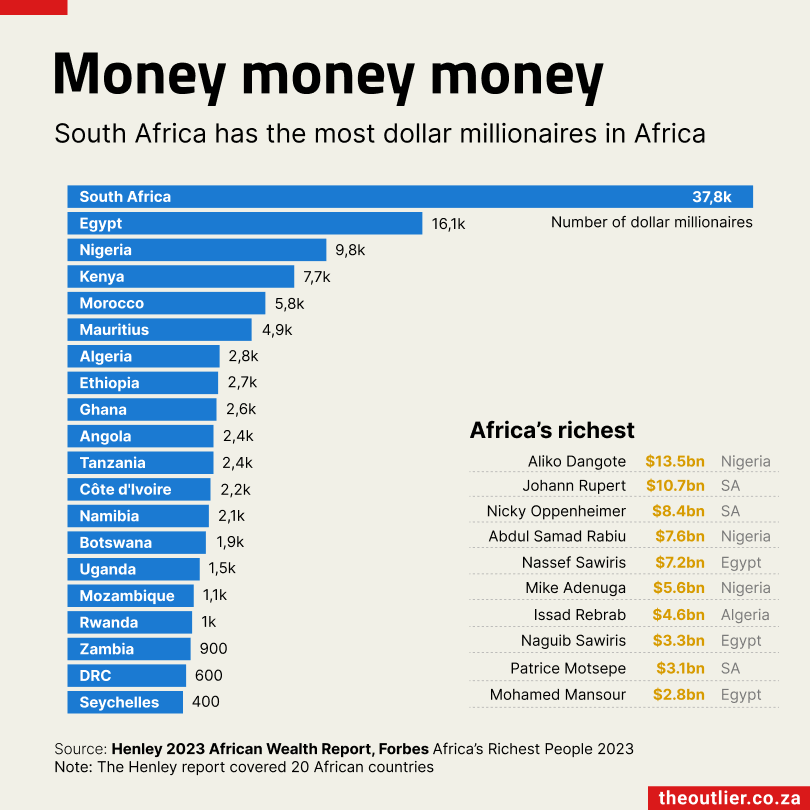
- More than half of Africa’s 138,000 dollar millionaires live in just 5 countries
- The richest man in Africa is Nigeria’s Aliko Dangote, who has a net worth of $13.5-billion
- Joburg is home to 14,600 dollar millionaires, the most of any African city
More than half of Africa's 138,000 dollar millionaires live in South Africa, Egypt, Nigeria, Kenya and Morocco. South Africa has the most, and Johannesburg is the city with the highest number of people (14,600) with assets worth more than $1-million. Africa's wealthiest individual is Nigerian industrialist Aliko Dangote, who has a net worth of $13.5-billion. He is followed by South Africa's Johann Rupert ($10.7bn) and Nicky Oppenheimer ($8.4bn). Three-quarters of Africa's 23 dollar billionaires live in South Africa, Nigeria and Egypt – which is also where you’ll find 9 of the continent’s 10 wealthiest people.
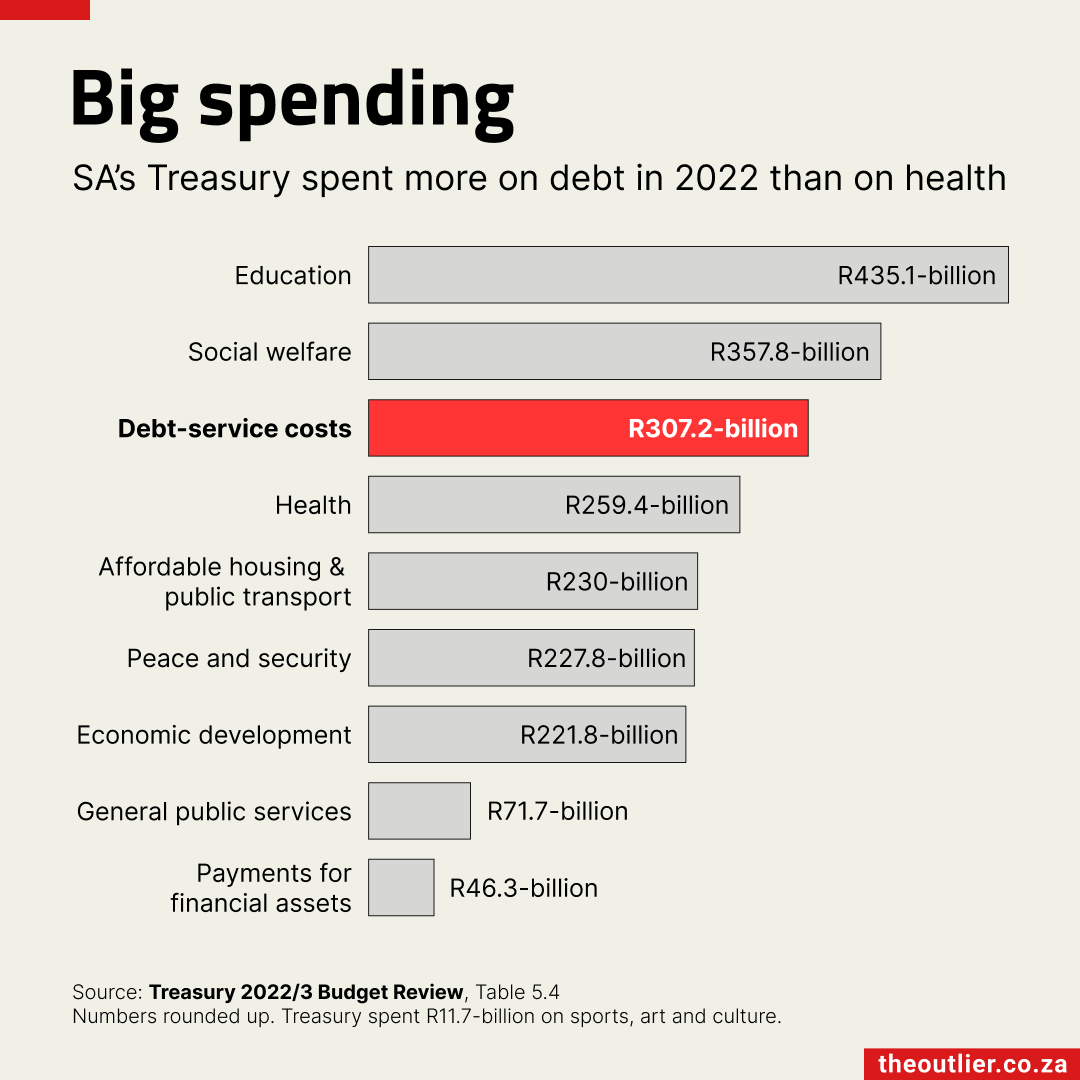
- In 2022/3, the government spent more money servicing its debt than it paid for health services
- Over the next 3 years, the government will spend R1.1-trillion to pay off the interest and part of its debt
- 14% of its total budget of R2.17-trillion was allocated in 2022/3 on servicing its R4.7-trillion debt
South Africa spends more on servicing its R4.7-trillion debt than it spends on any other service, bar education and social grants. In 2022/3, it spent R307.2-billion honouring its debt – R47.7-billion more than it spent on health and R79-billion more than it spent on safety and security. The only two other items in its R2.17-trillion budget that cost the government more are social welfare (+R51-billion) and education (+R127.9-billion). The government says it has set aside R1.1-trillion to service its debt in the next three years. Fuelled by pandemic borrowing and slowing economic growth, government debt increased by R792-billion between 2020/1 and 2022/3.
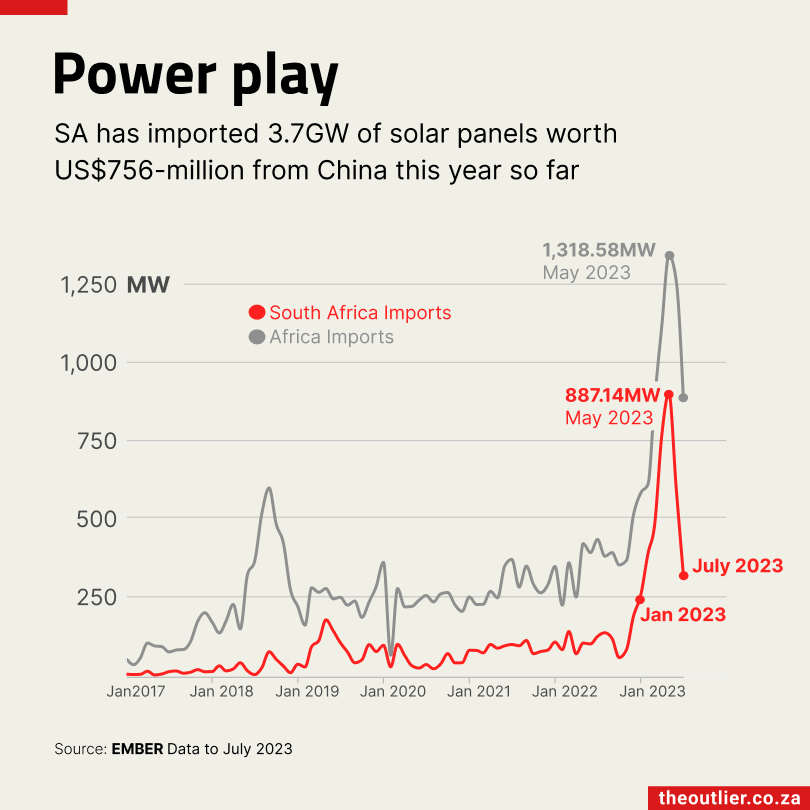
- Chinese exports of solar panels account for 80% of the global market
- Exports to Africa increased by 187% in the first half of 2023 compared with the same period last year
- South Africa has imported panels equivalent to 3.7GW in 7 months
African imports of solar panels from China are increasing rapidly, driven largely by South Africa, according to data released by Ember, which tracks Chinese customs data. Chinese exports account for about 80% of the global solar panel market. In the first 7 months of 2023, South Africa imported panels equivalent to 3.7GW, up from 0.6GW in the same period last year. South Africa was the 20th largest solar power producer in the world in 2021 – and the largest producer in Africa. It generated 6.65 terawatt hours (TWh), compared with world No 1 China’s 327TWh that year.
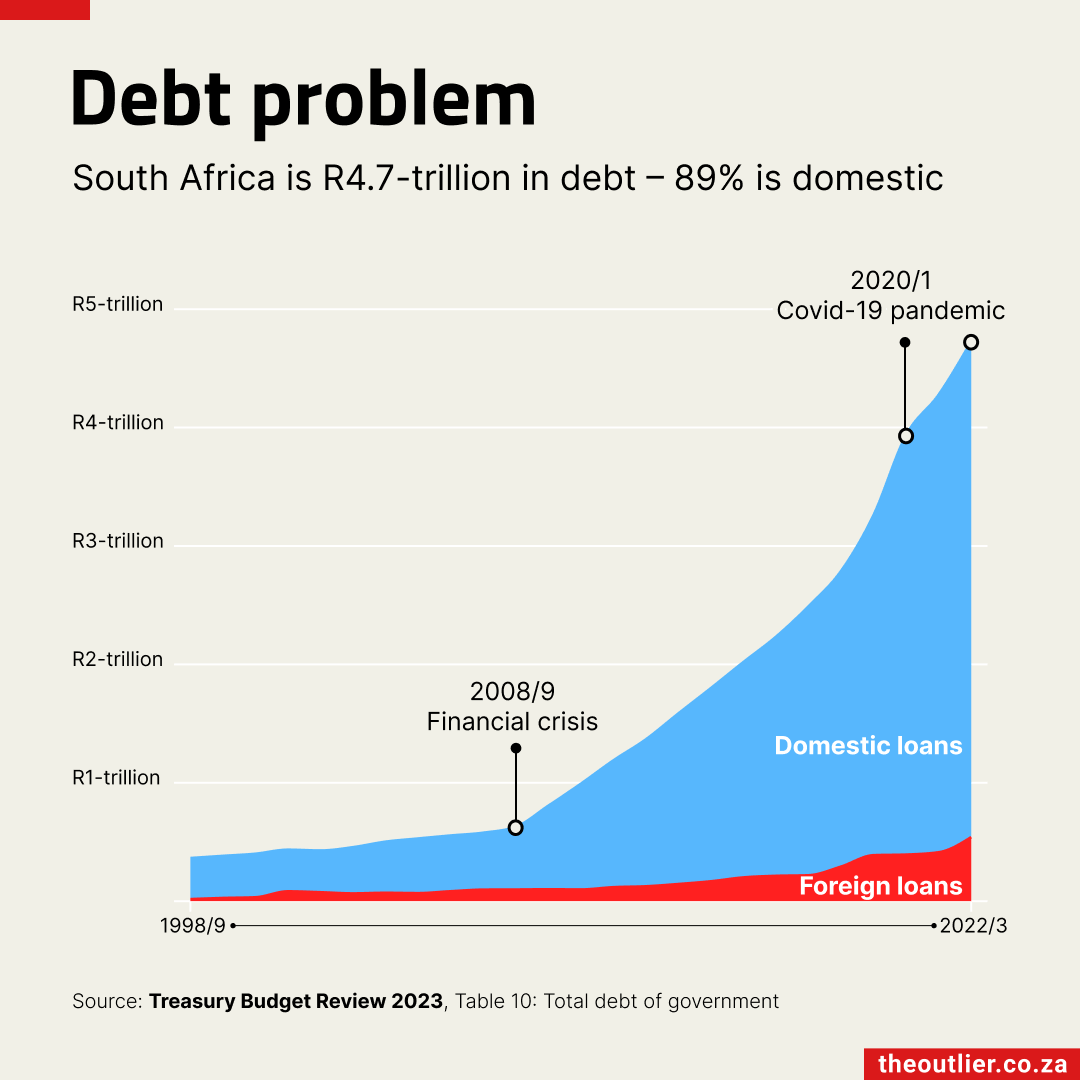
- The South African government’s total debt is R4.7-trillion
- Debt increased by R792-billion in the 2 years after the Covid pandemic
- Factors such as loadshedding and the failure of state-owned companies are adding to the burden
South Africa's debt has been spiralling since the 2008 global financial crisis. Exacerbated by pandemic-related borrowing in 2020, the government's total debt is now R4.7-trillion. Most of the funds have been raised on the domestic bond market. Factors such as failing state-owned companies, wasteful expenditure, loadshedding and unemployment mean the economy isn’t generating enough tax to balance the budget. With an election in 2024, spending is likely to remain high, with the debt burden rising even further.
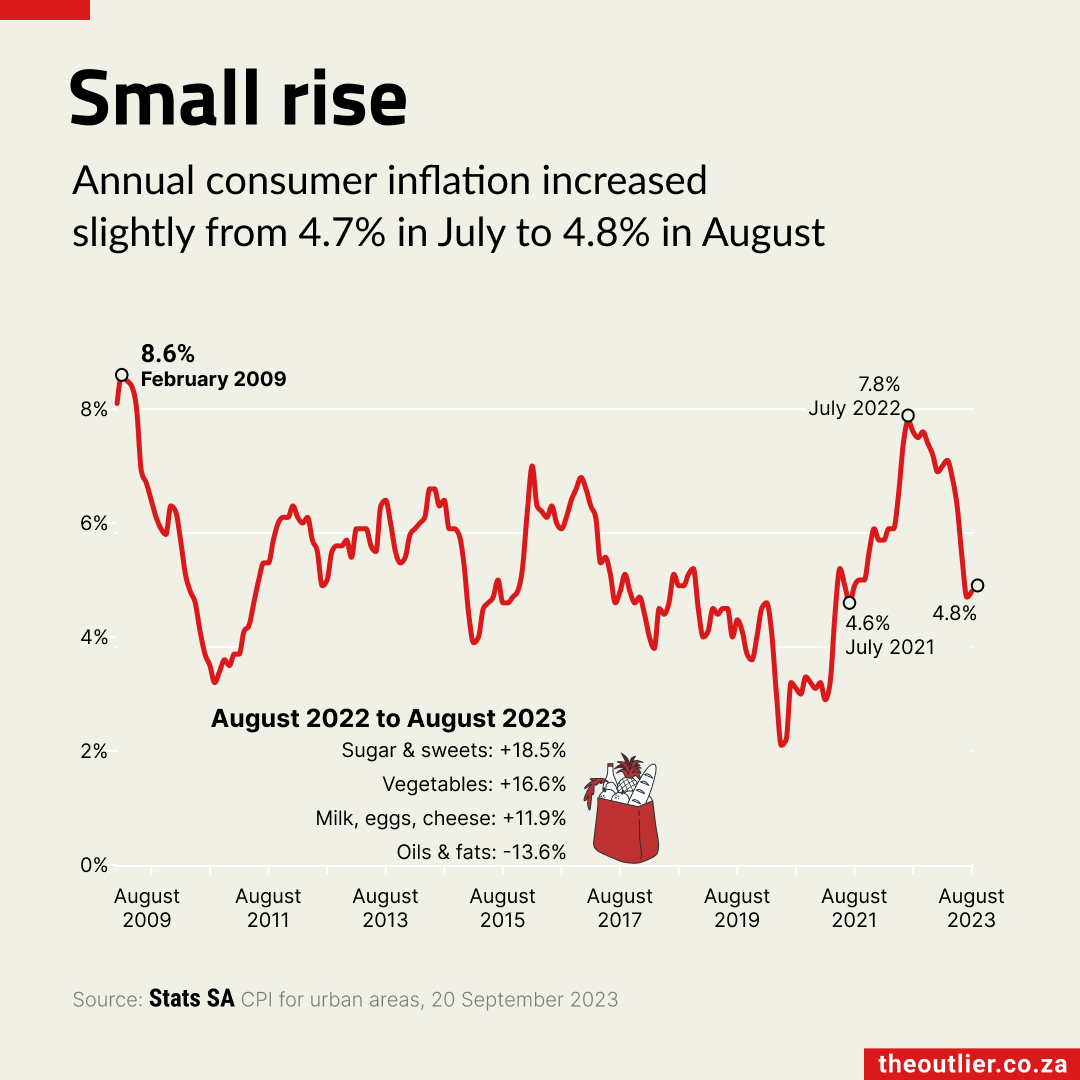
- There was a slight uptick in inflation from 4.7% in July to 4.8% in August after slowing for four consecutive months
- Sugar, sweets and deserts increased by 18.5% between August 2023 and 2022
- The price of cooking oil decreased by 13.6%
It's getting more expensive to have a sweet tooth. Sugar, sweets and desserts have increased by 18.5% over the past year. It's the highest increase of all the food items. Vegetables cost 16.6% more in August 2023 than in 2022. Although milk, eggs and cheese are 11.9% more expensive, it is now almost 14% cheaper to buy cooking oil. Food and the cost of electricity – which went up by 15.1% – contributed to the slight increase in year-on-year inflation.
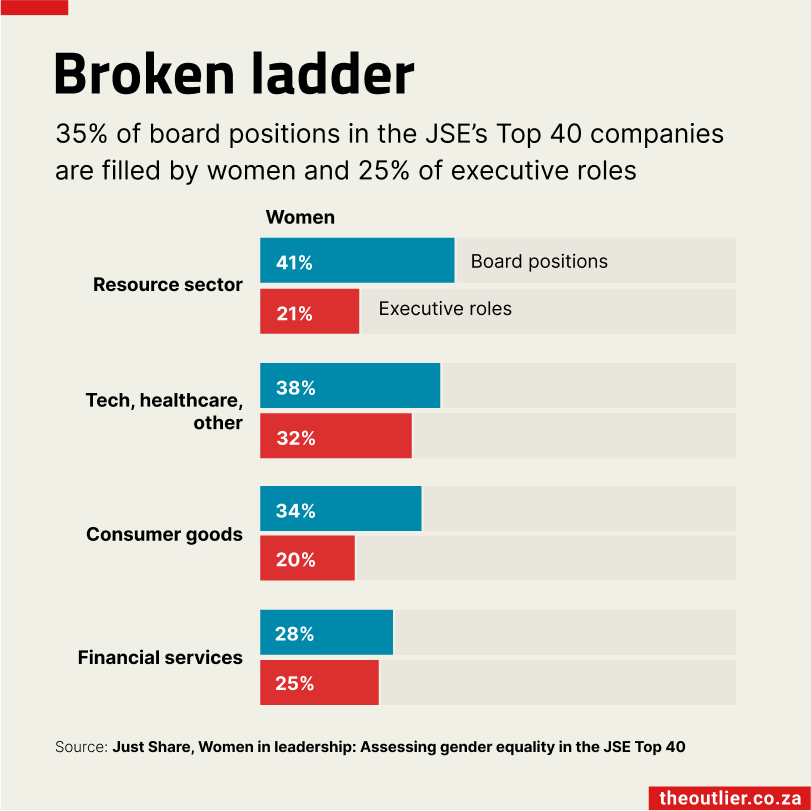
- Women make up 35% of board members in the JSE’s Top 40 companies
- One quarter of senior executive positions are held by women
- Only 1 company has gender parity or better at both board and executive level
Women hold 180 of the 515 board positions (35%) at the JSE's Top 40 companies. Despite making up 46% of South Africa’s economically active population, they hold 115 of the 468 executive positions (25%). That women are not better represented at the C-suite level 'reflects the lack of progress in ensuring that corporate culture supports the advancement of female employees,' Just Share says in a new report. There are 5 female chairpersons and 4 female CEOs in the Top 40. Bidvest is the only company with gender parity or better at board and executive level: 75% of its board are women, and 50% of its executives. Only two other companies have more than half their board seats filled by women: Impala Platinum and Exxaro.
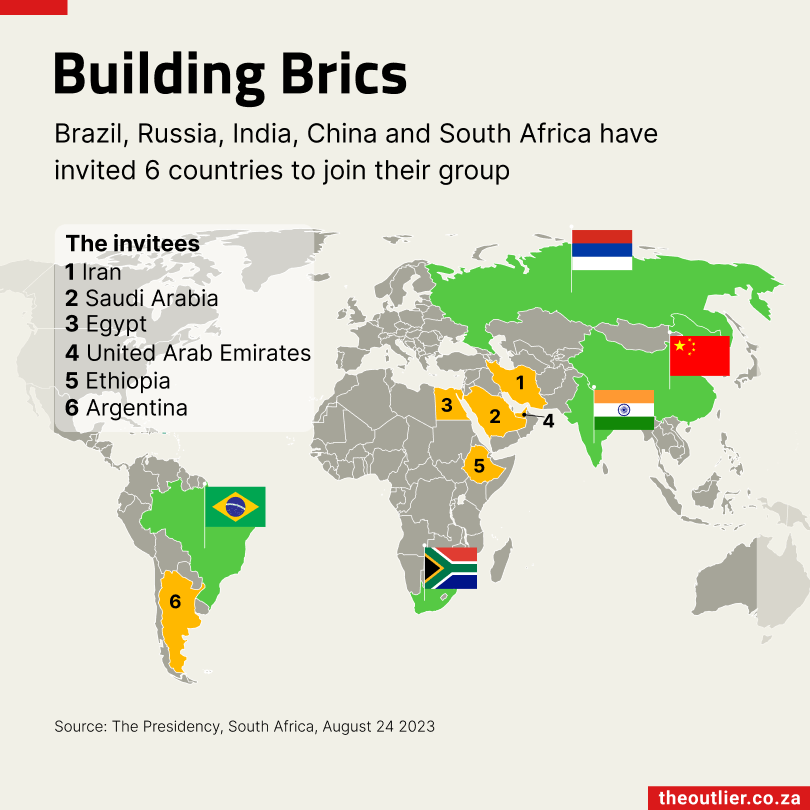
- Ethiopia, Egypt, Saudi Arabia, the United Arab Emirates, Iran and Argentina have been invited to join Brics.
- If they all accept the invitation, Brics will expand from 5 to 11 members from 1 January 2024.
Six countries were invited to join the Brics grouping of major emerging economies at its summit held in Johannesburg from 22 to 24 August 2023. Five countries are in the Middle East and Africa: Saudi Arabia, United Arab Emirates, Iran, Egypt and Ethiopia. The sixth is Argentina. If all the countries accept the invitation the bloc with increase from five members – Brazil, Russia, India, China and South Africa – to 11 on 1 January 2024. Saudi Arabia’s foreign minister has said on Al Arabiya TV that his country will review the details of membership before making a decision to join.
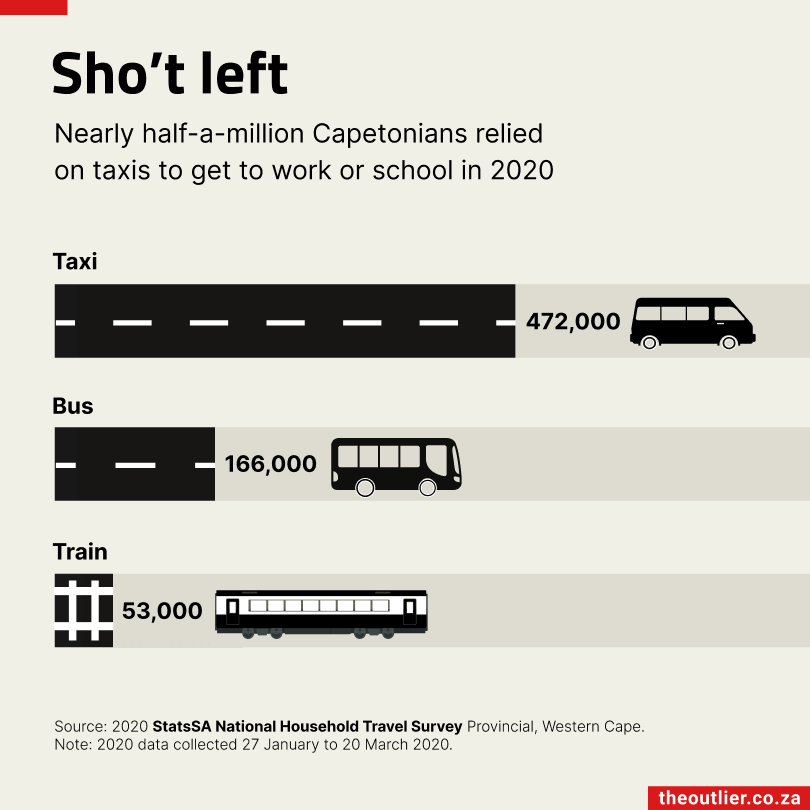
- Around 500,000 people in Cape Town rely on minibus taxis to get to work or school
- The SA National Taxi Council brought the city to a halt in an 8-day protest, which severely affected transport services
Nearly 500,000 people in Cape Town used minibus taxis to travel to and from work and school in 2020. According to StatsSA's National Household Travel Survey, 325,000 of these people were travelling to work and 147,000 were learners – about a quarter of all commuters and a fifth of all learners. The city's learners and workers were left stranded in August 2023 by an 8-day South African National Taxi Council strike. Santaco's protest centred on a city by-law that allows authorities to impound vehicles for violations. Both private and public transport services were severely affected.
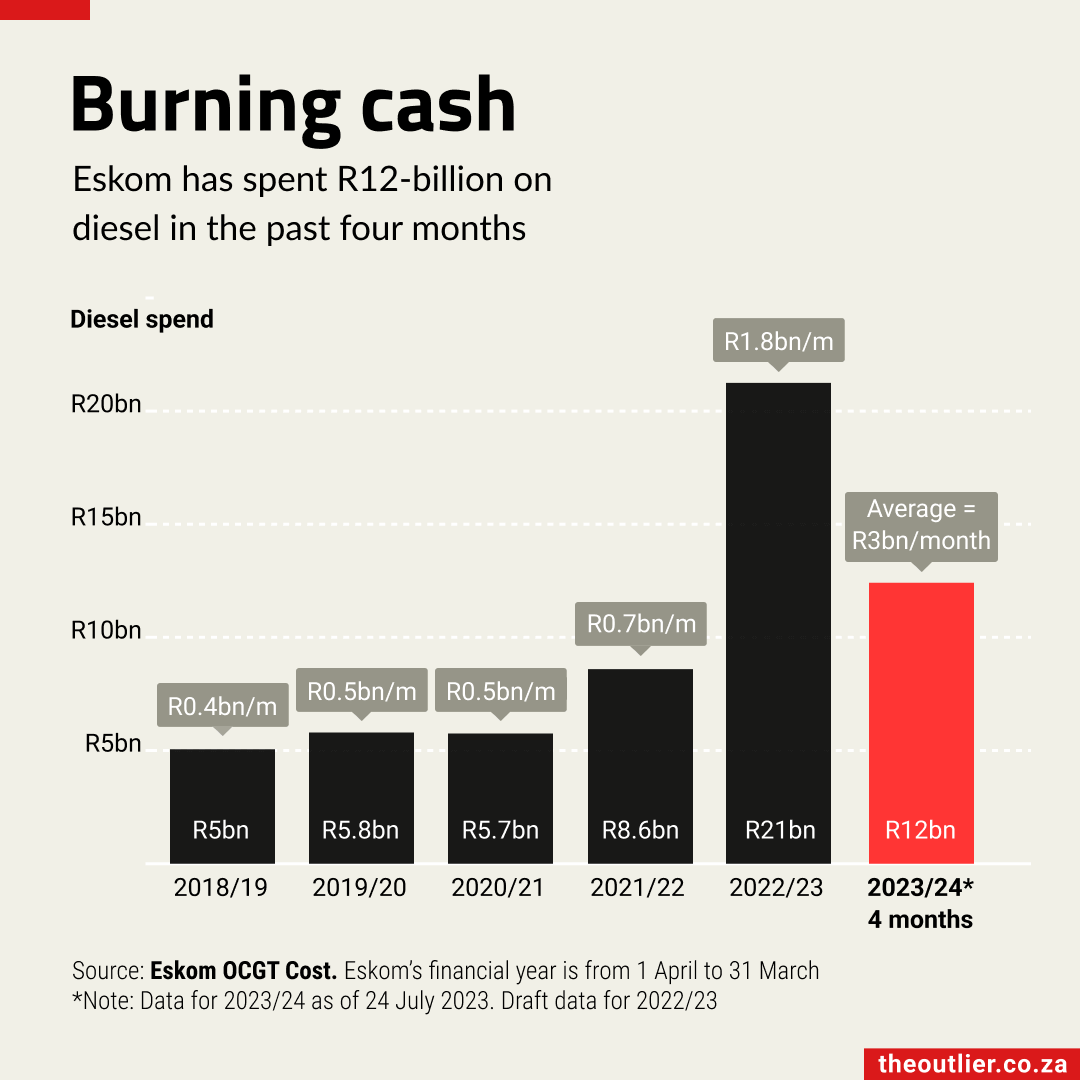
- Eskom is spending an average of R3-billion a month on running its open-cycle gas turbines
- The turbines, which run off diesel, are meant to be used in emergencies and peak periods
- The power utility doubled its diesel bill between its 2021/22 and 2022/23 financial years
Eskom's two open-cycle gas turbines, Ankerlig and Gourikwa, which run off diesel, were designed to be used during peak periods and in emergencies. But the power utility has been using them more often. In its 2022/23 financial year, Eskom reports that it generated 3,018 gigawatt hours (GW/h) of electricity from its open-cycle gas turbines – a big increase on the 1,826GW/h it generated from them in 2021/22. Its diesel bill more than doubled from R8.6-billion in 2021/22 to R21-billion in 2022/23. So far this financial year – April, May, June and July – Eskom has spent an average of R3-billion a month on diesel. Last year’s average monthly spend was R1.8-billion.
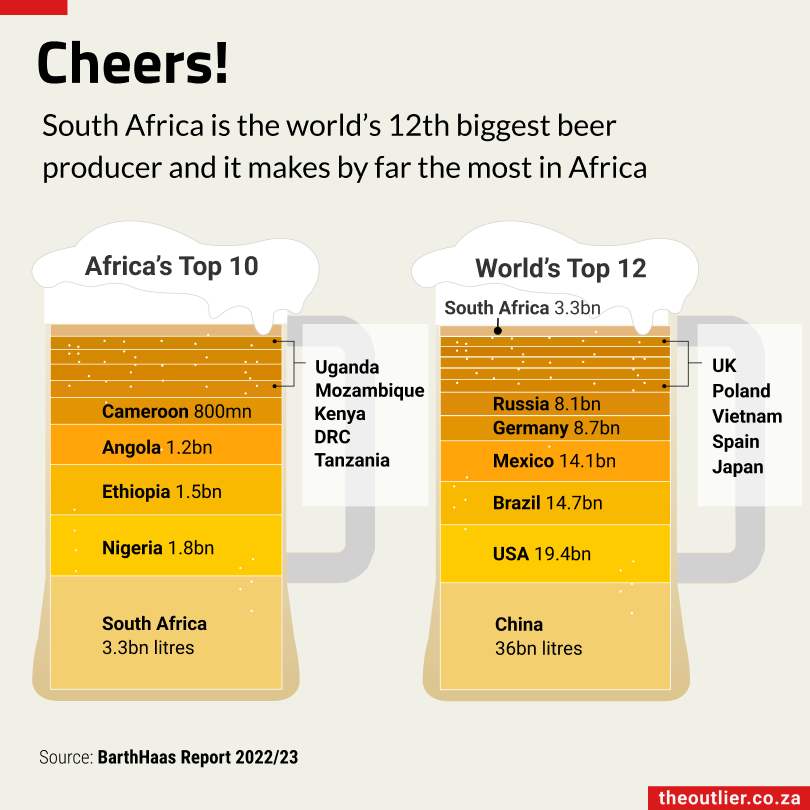
- South Africa produces the most beer in Africa
- China produces the most beer in the world
- Of the 189-billion litres made last year, a fifth of it was in China
South Africans love their beer, but it might be news to some people that the country is the 12th biggest beer producer in the world. It's also by far the biggest in Africa. South Africa produced almost twice as much beer as Nigeria in 2022.
But South Africa pales in comparison with China, which produced 36-billion litres in 2022 – that's 20% of the world's beer.
More than 189-billion litres of the brew were produced globally last year. The top-12 beer-producing countries were responsible for two-thirds of that total.
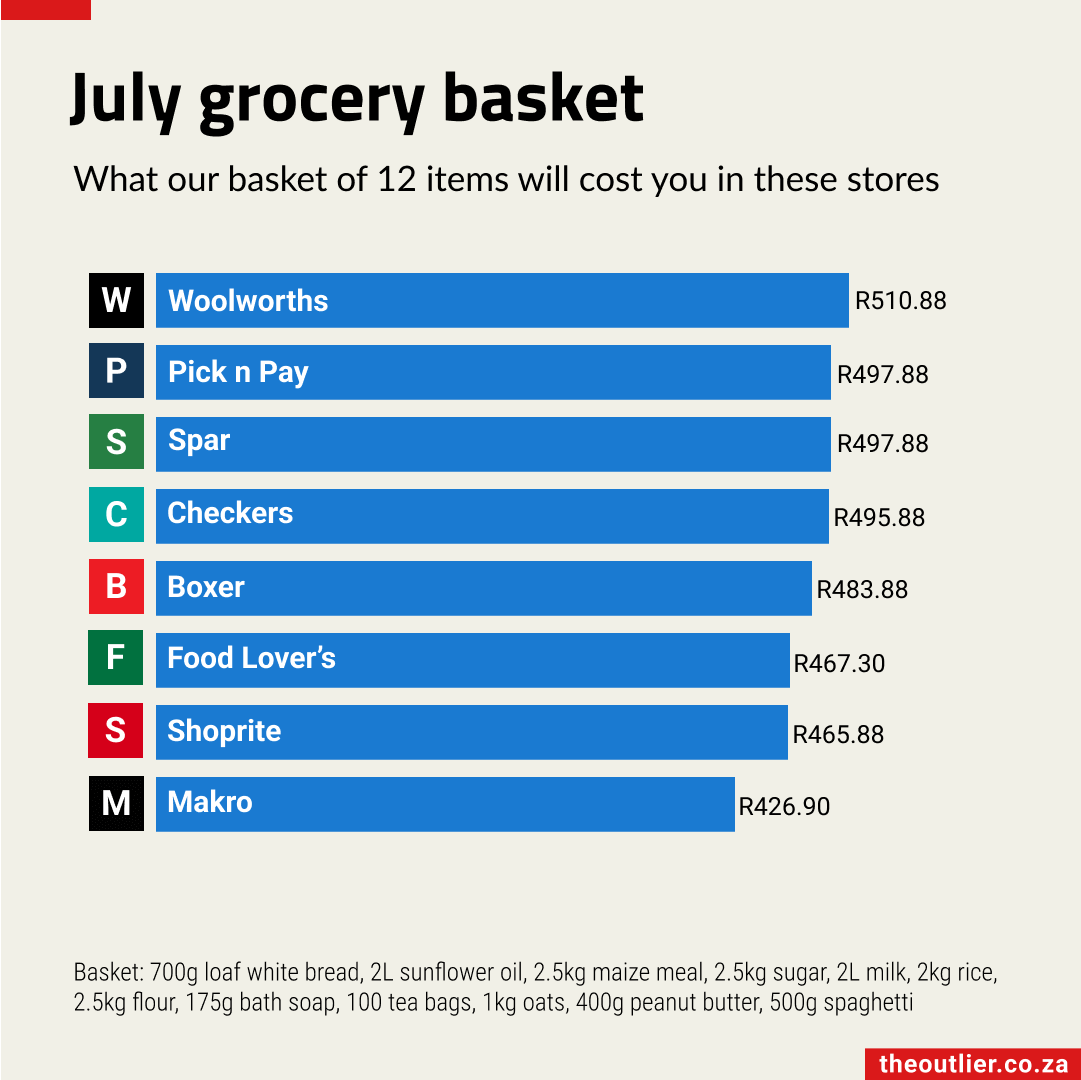
- The average cost for our basket of 12 staple items in July was R480, which is slightly cheaper than last month
- Based on our basket, there’s a price difference of R84 between the most expensive and the cheapest retailers
- The price of sunflower oil is one of the main reasons for this
The Outlier's grocery basket covers the prices of the same 12 staple items from eight retailers: Woolworths, Checkers, Pick n Pay, Spar, Food Lover’s Market, Shoprite, Boxer and Makro. In July, the average cost was R480, slightly cheaper than in June. Woolworths was the most expensive retailer based on our basket, at R510.88. All the other retailers came in at under R500. The difference between the cheapest and most expensive basket is R84, which is much bigger than June’s difference of R55. A drop in the price of sunflower oil is the main reason for this.
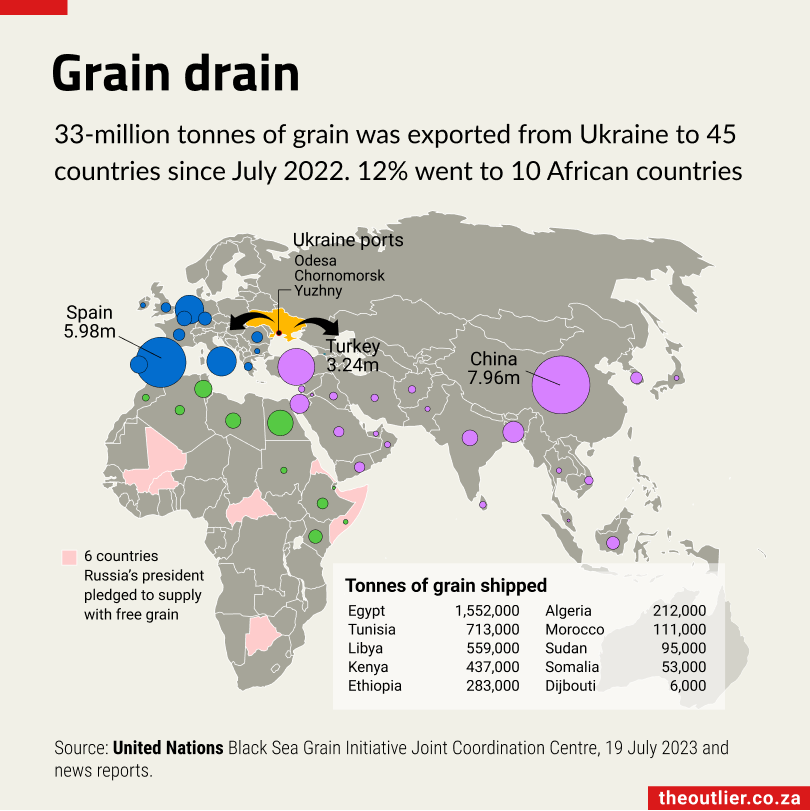
- After withdrawing from the Black Sea Grain Initiative on 17 July, Russia offered 6 African countries free grain
- African leaders, including SA president Cyril Ramaphosa, say they would prefer the deal be reinstated
The Black Sea Grain Initiative is a UN-brokered deal that allowed Ukraine to ship grain through a Russian blockade from July 2022. About 32.9-million tonnes of grain and oilseeds was shipped to 45 countries, including 10 in Africa. Russia pulled out of the deal on 17 July and bombed Ukraine’s ports, destroying 60,000 tonnes of grain. Russian President Vladimir Putin said on 27 July that he would send free grain to Zimbabwe, Mali, Central African Republic, Burkina Faso, Eritrea and Somalia. African leaders, including South African president Cyril Ramaphosa, responded that they would rather the grain deal be reinstated.
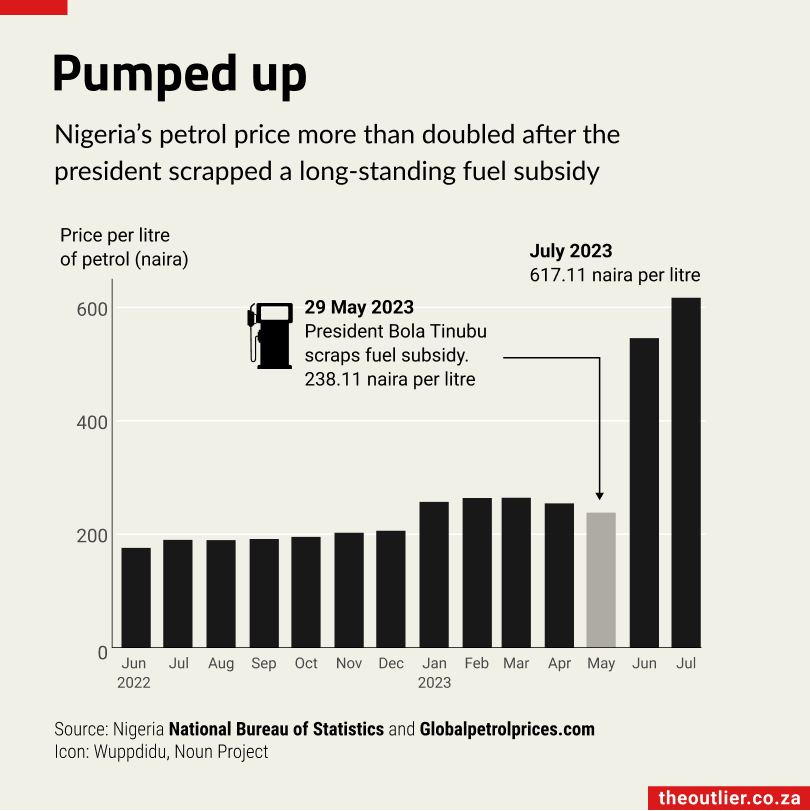
- Nigeria’s petrol price more than doubled after it scrapped its fuel subsidy
- Despite this, its fuel price remains one of the lowest in Africa
After Nigeria’s fuel subsidy was scrapped by President Bola Tinubu in May, the price more than doubled from 238.11 naira per litre to 545.83 naira per litre.
The subsidy, introduced in the 1970s, was expensive for the government. PWC estimates it cost $30-billion over 18 years.
It also created an incentive for smuggling petrol to neighbouring countries, where it was sold at higher prices. An estimated 58-million litres a day was smuggled out of the country in 2022.
Nigeria’s fuel price remains one of the lowest in Africa. In July it was 617 naira per litre ($0.78). South Africa’s fuel price on 24 July was $1.26 per litre, Ghana’s was $1.14 and Kenya’s was $1.38.

- A 2.5kg of Selati white sugar now costs R70 at some stores
- The average price of sugar has increased by 18% since June 2022
- In June 2022, the average price of a 2kg bag of Selati white sugar was R52.74
At some retailers, the price went up significantly between May and June. This brand of sugar was most expensive at Checkers and Shoprite in June, costing R69.99 for the 2.5kg bag.
The price surge stems from substantial increases that were passed on by the South African Sugar Association to all producers and customers due to cost pressures, according to an email reply from the Woolworths press office. The association said it could not respond to our questions.
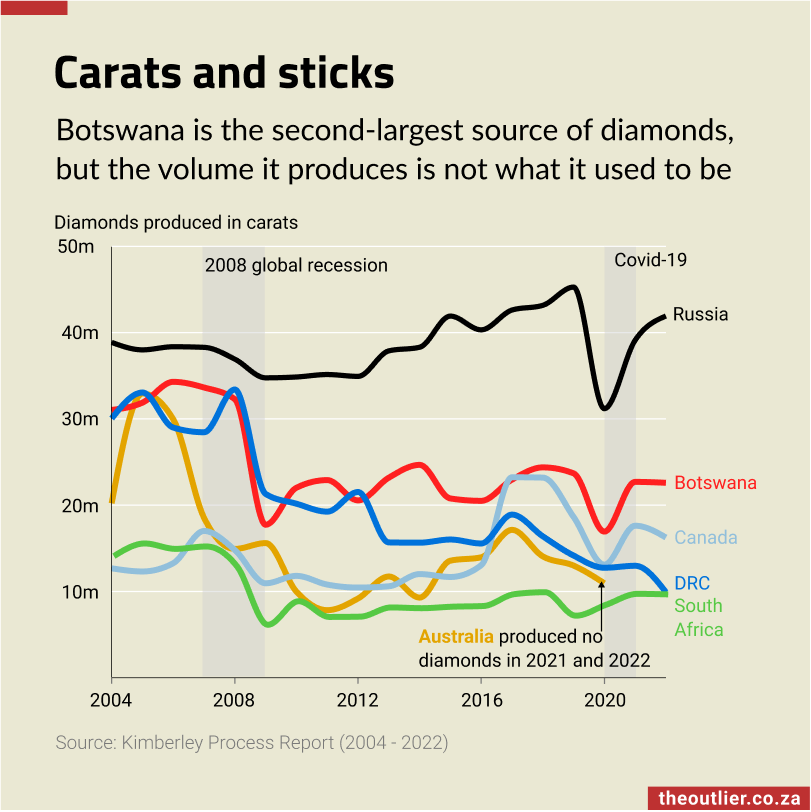
- In 2022 half of the world’s diamonds were mined in Africa
- Botswana is the second-biggest diamond producer. The Democratic Republic of Congo and South Africa are also in the top five
- Russia produces the most diamonds by volume but the value of Botswana’s diamond output is higher. In 2022 it was worth $4.7-billion; Russia’s was $3.5-billion
Botswana has a reached a new agreement with DeBeers which gives it a larger portion of the diamonds mined in the country to sell. Under the new agreement the state-owned Okavango Diamond Company (OKD) will get 30% of the diamonds mined by Debswana, a joint venture between the Botswana government and De Beers. OKD previously got 25%, with the remainder going to DeBeers. By the end of the 10-year agreement OKD’s share will increase to 50%.
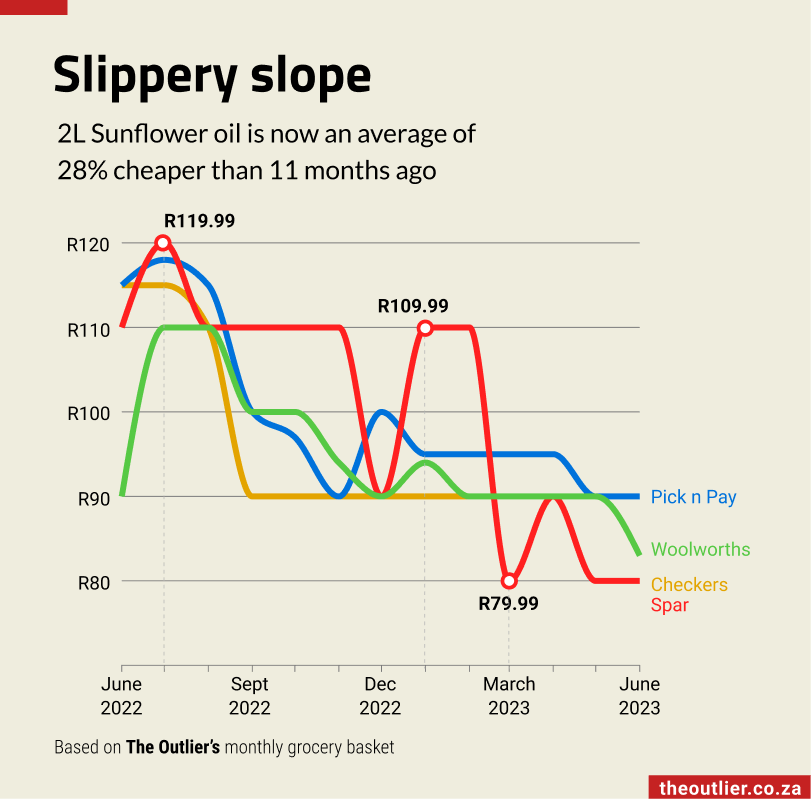
- In July 2022, the average price of a 2-litre bottle of sunflower oil was R115.74 between four stores – Pick n Pay, Woolworths, Checkers and Spar
- A year later, the average price is R83.24, a decrease of more than 28%
- Russia and Ukraine are the two largest producers of sunflower in the world and the invasion of Ukraine pushed up prices in early 2022
The June 2023 grocery basket marks a year since we started collecting and comparing grocery prices. We started collecting prices for four stores and now collect eight. Last year sunflower oil saw a large price increase as a result of the Ukraine war, poor climate conditions and poor harvests. Ukraine and Russia are the two largest producers of sunflower oil in the world. A year later the sunflower oil is one of the few items in our basket that has decreased in price compared with a year ago.

- We’ve added spaghetti, peanut butter, oats and tea to our monthly grocery basket
- The price of sugar has increased by 18% on average since June 2022
- The sunflower oil price has stabilised after a tumultuous 2022
We’ve been collecting our grocery prices for exactly a year and since June 2022 a lot has changed. We started out comparing the prices of nine basic goods across four retailers: Woolworths, Checkers, Pick n Pay and Spar. That has now doubled to eight retailers with the addition of Food Lover’s Market, Shoprite, Boxer and Makro.For June’s new basket of 12 staple items, Pick n Pay was the most expensive at R505.88.For the third month in a row, Makro’s basket emerged as the cheapest option at R450.99.
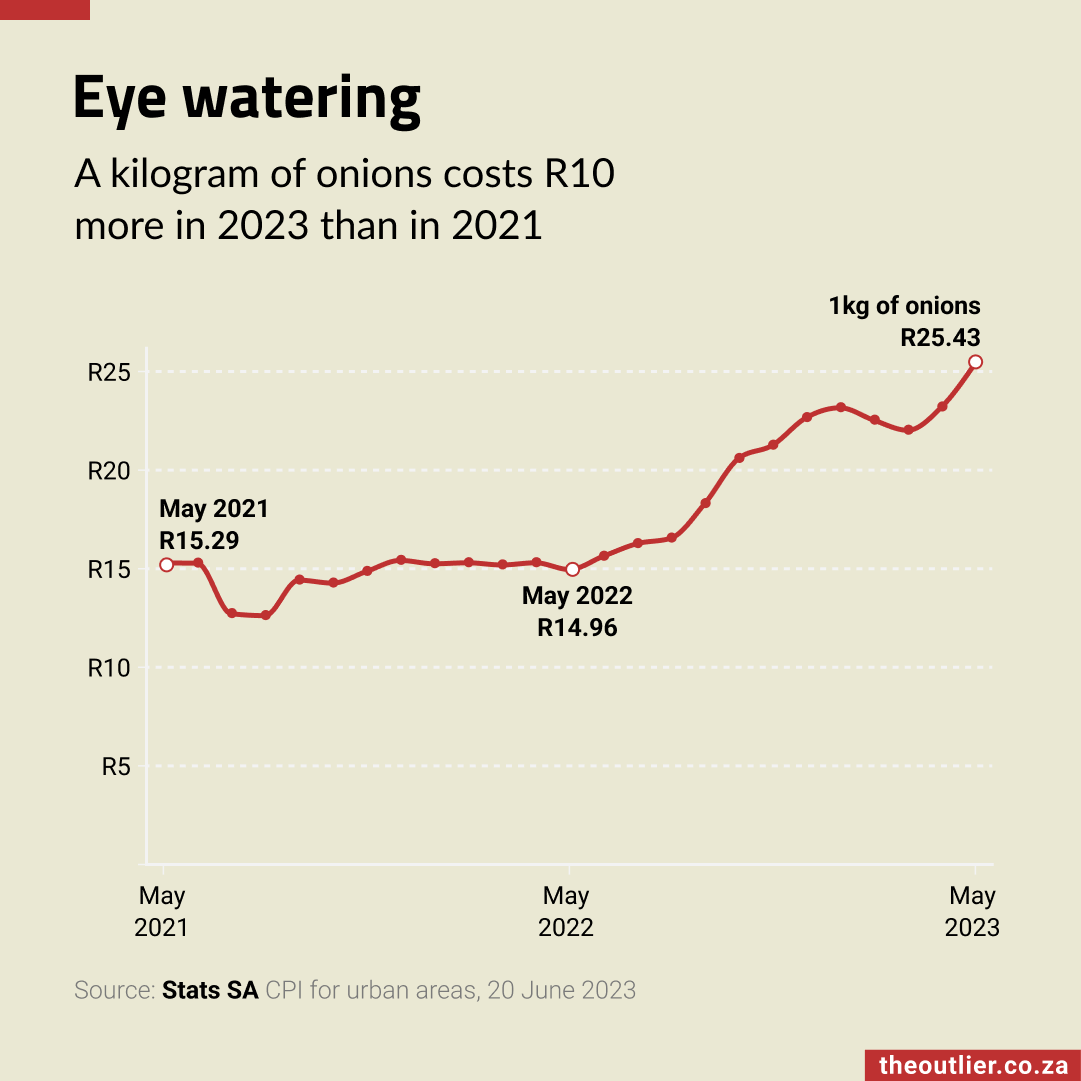
- Vegetables were 20.8% more expensive in 2023 than in 2022
- Most vegetables increased by 20% over the last year
- Inflation decreased to 6.3% in May from 6.8% in April
Your eyes weren’t deceiving when you saw the price of a bag of onions in May. The price of this cook’s staple has increased by 70% and now costs more than R10 a kilo than it did in 2022
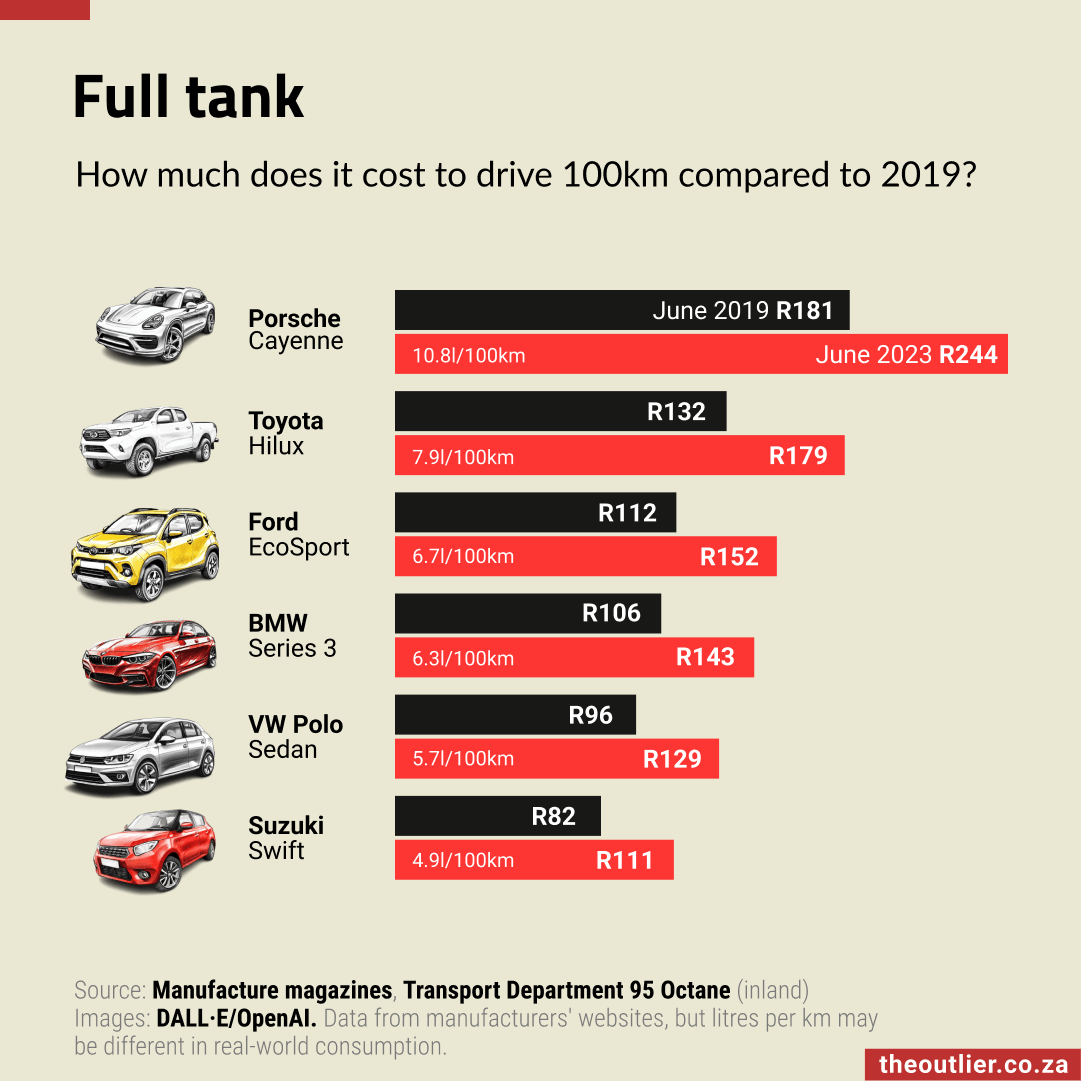
The price of a barrel of crude oil is a big driver in the increase in the petrol price – it costs almost a third more than it did in 2019 – driven up over the past year because of the war in Ukraine. But it is not the only factor. South Africa buys its oil in US dollars, and since January 2019, the US dollar exchange rate went from R14.9 to the dollar to R18.99 – making the crude oil we buy that much more expensive.
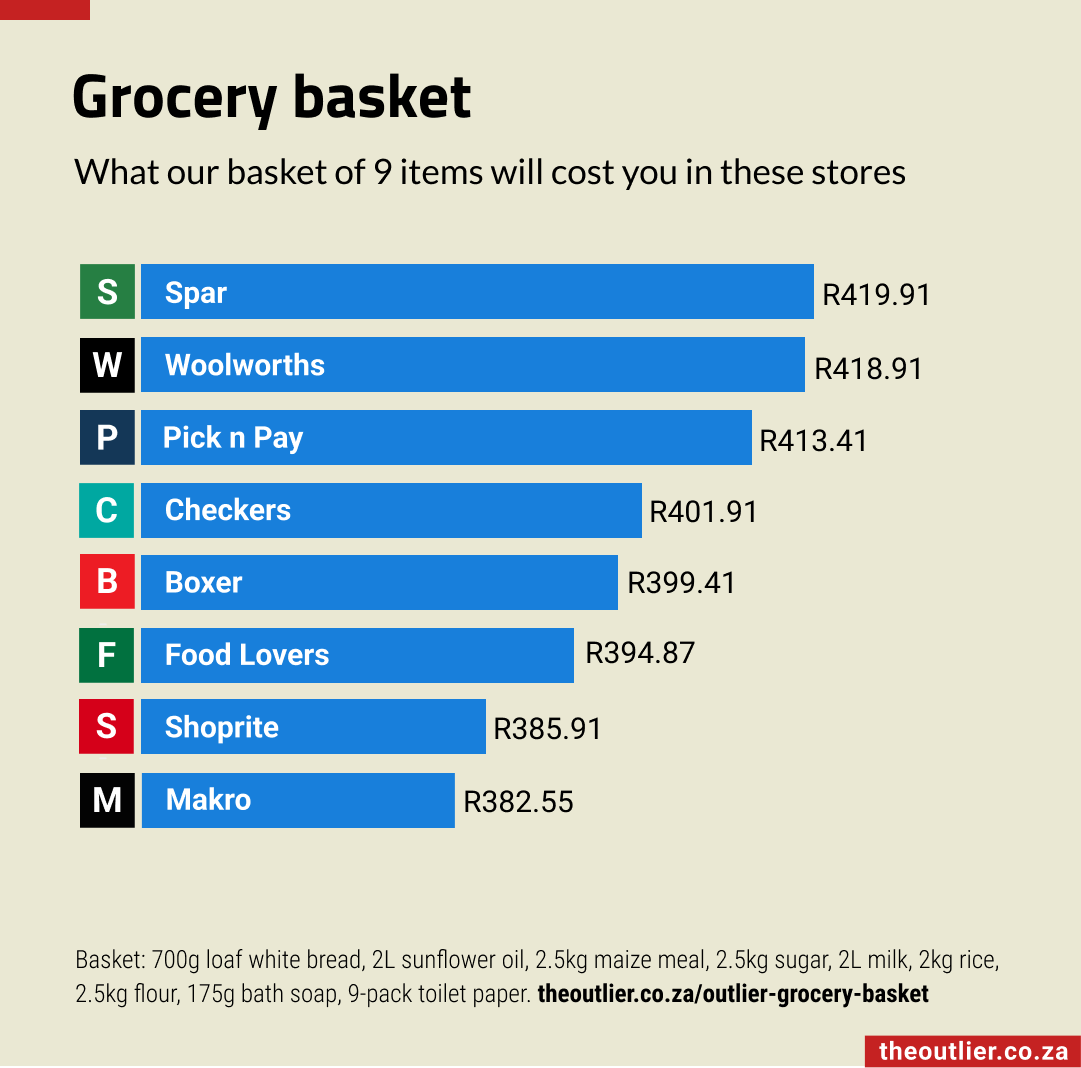
In May 2023, we switched over to the cheapest, most comparable sunflower oil, milk and toilet paper brands on offer at the different retailers. We did this because it has become increasingly difficult to compare the same brands between retailers.
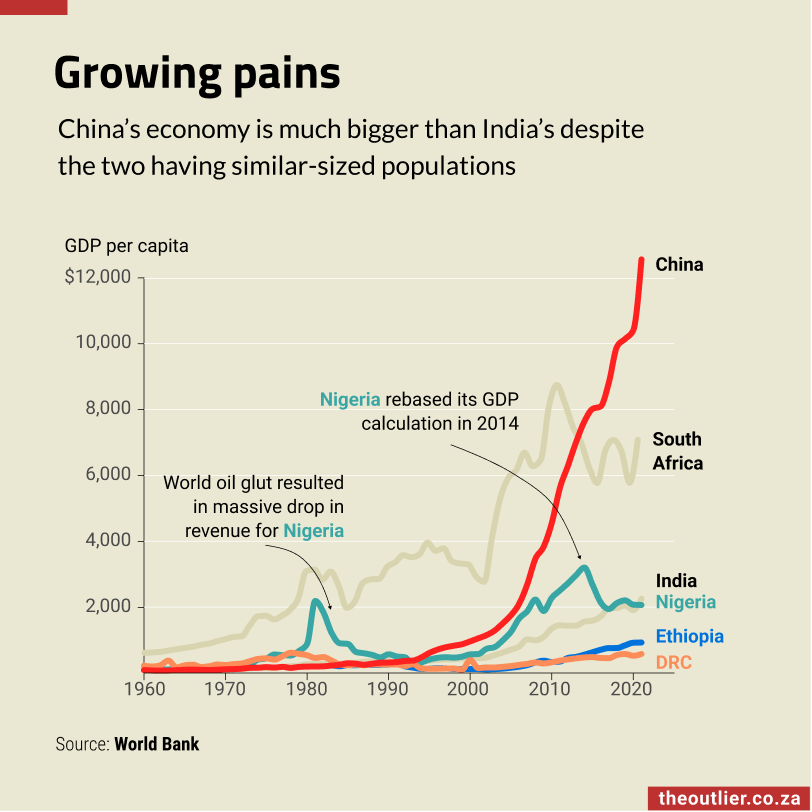
China’s economy boomed in the 1990s when half of its 1.1-billion people were 24 years old or younger. India also reached 1-billion people in the mid-1990s but it did not follow China’s rapid economic growth.
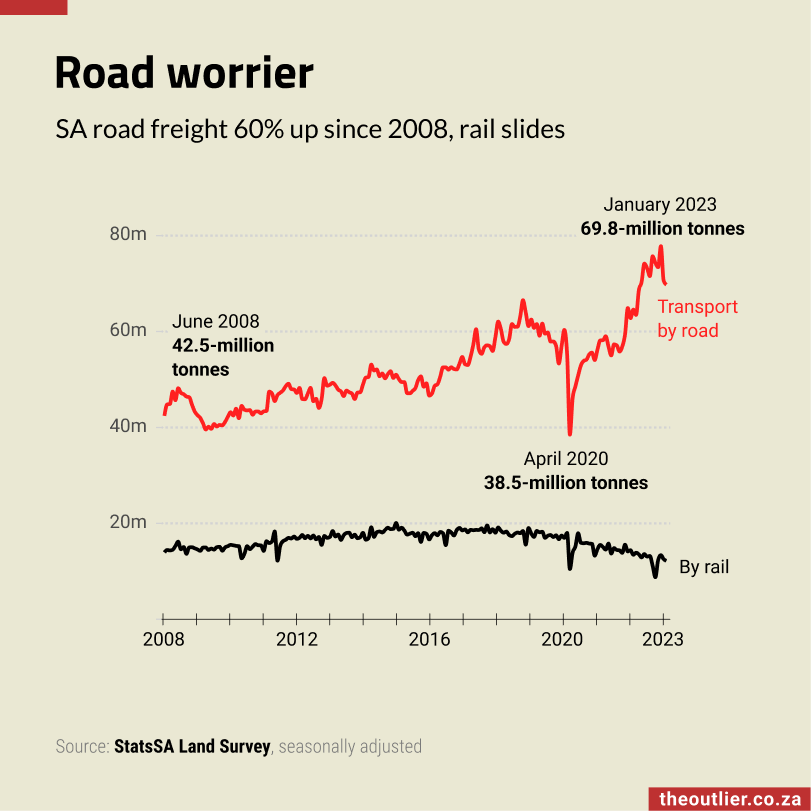
In two years the payload for road freight transportation has increased by 20% thanks to the problems on Transnet’s rail lines.
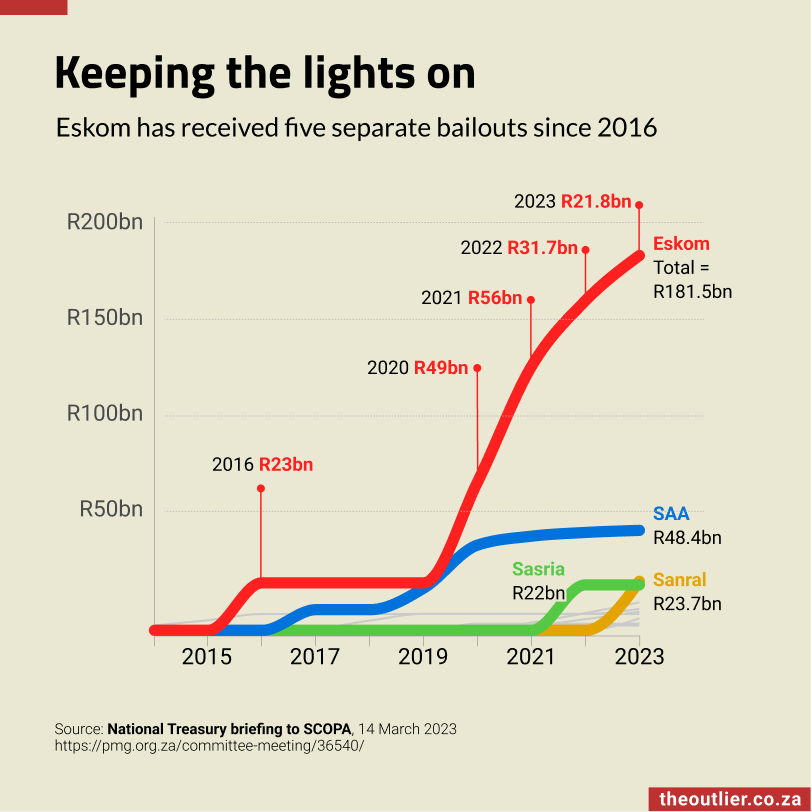
R181-billion. That’s how much the treasury has given Eskom since 2016 to help keep things running. And Eskom is not alone. The government has granted R331.2-billion in bailouts to state-owned companies in the 10 years since 2013.
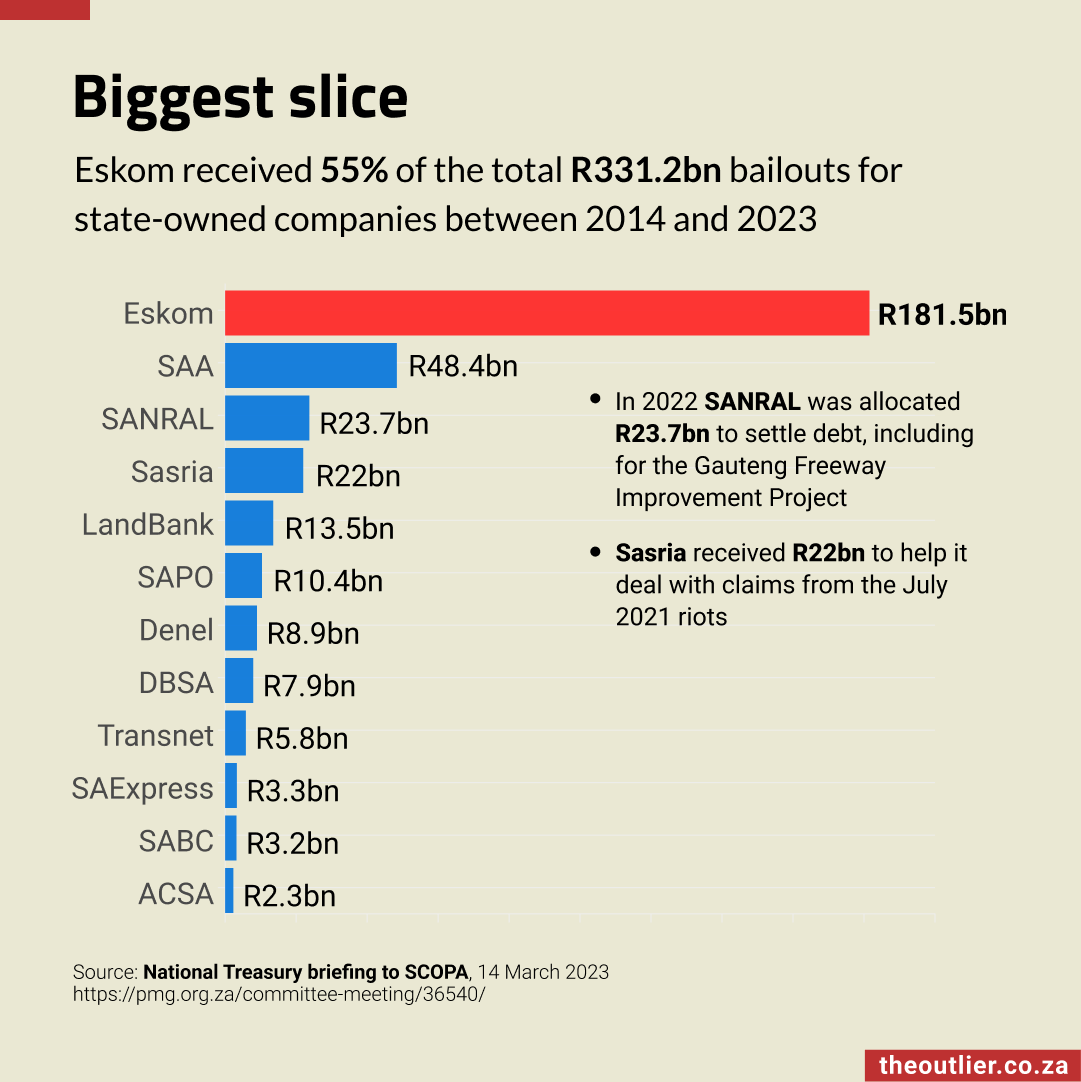
Eskom has received bailouts in 2016, 2020, 2021, 2022 and 2023. Other big recapitalisations were for SAA, Sasria (as a result of the July 2021 riots) and Sanral.
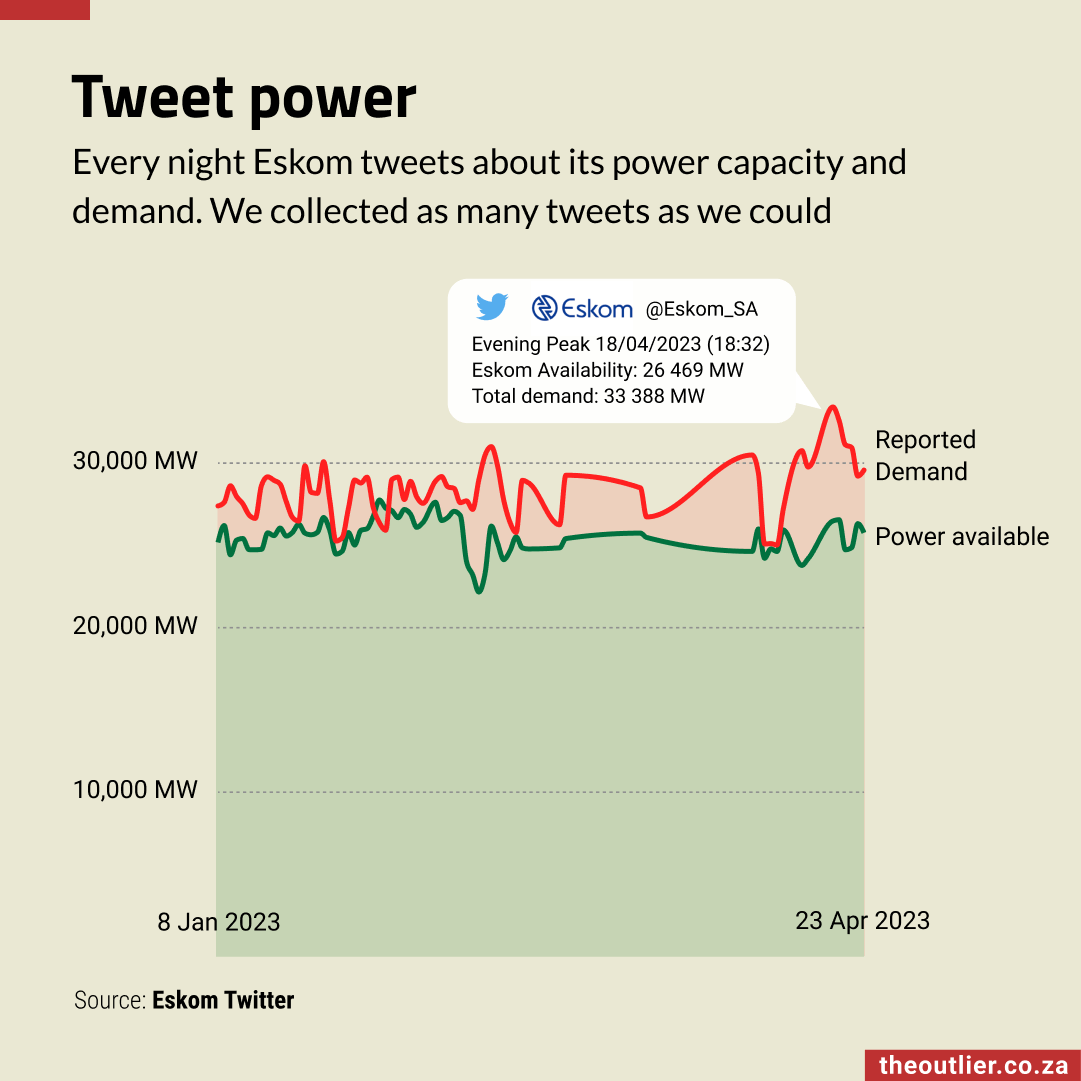
Most evenings Eskom uses Twitter to share details of the current demand for electricity and how much power is actually available. A typical tweet also includes details of renewable power available and open-cycle gas turbines in use. For power and data nerds it’s a lot of useful information in a concise package and also a good view of the power(less) situation in South Africa.
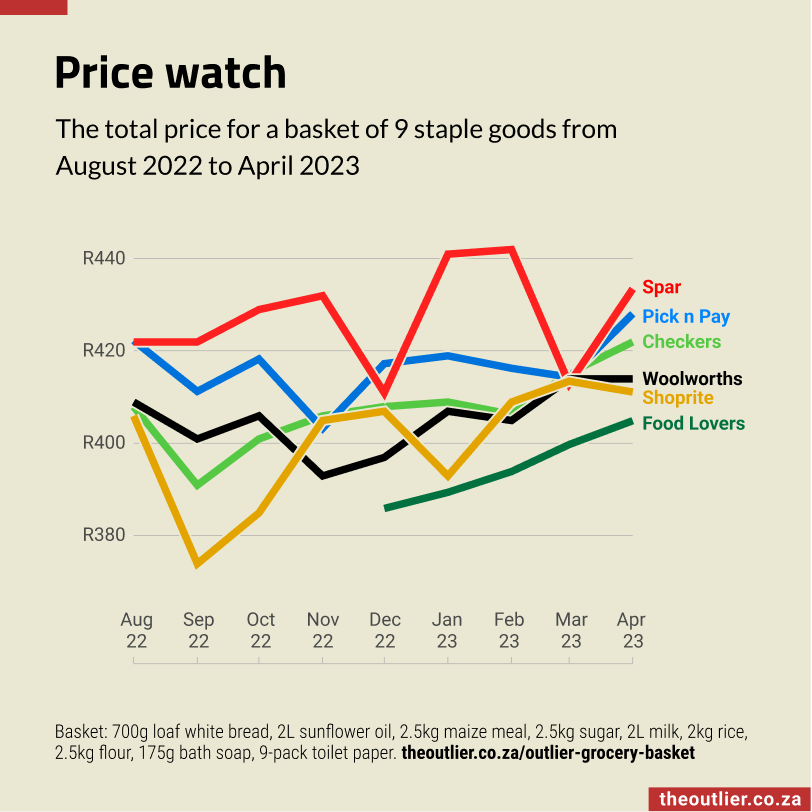
In the meantime, these are the running prices for the main retailers from August 2022 until this month. The chart leaves out the June and July 2022 prices where we adjusted the quantities.

In the first three months of 2023 more than 2,400 MW of power projects have been registered, more than the number registered in 2022 and more than all the projects registered in the previous 5 years.
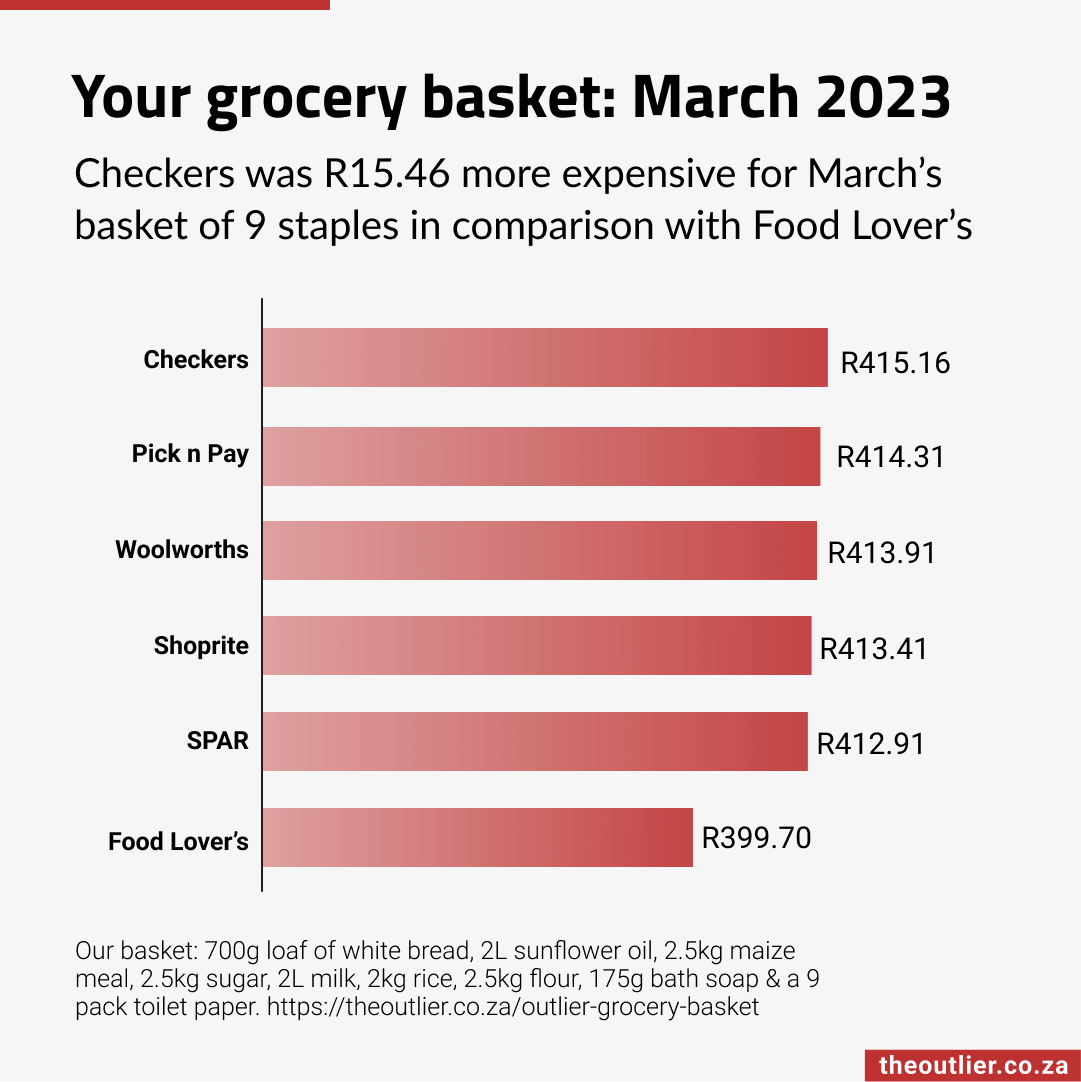
For the first time this year, the SPAR basket was not the most expensive, in fact, it came in at the second-cheapest price. Checkers took the priciest spot by R15.46 in comparison with Food Lover’s Market’s bag of goods which was the most affordable at R399.70.
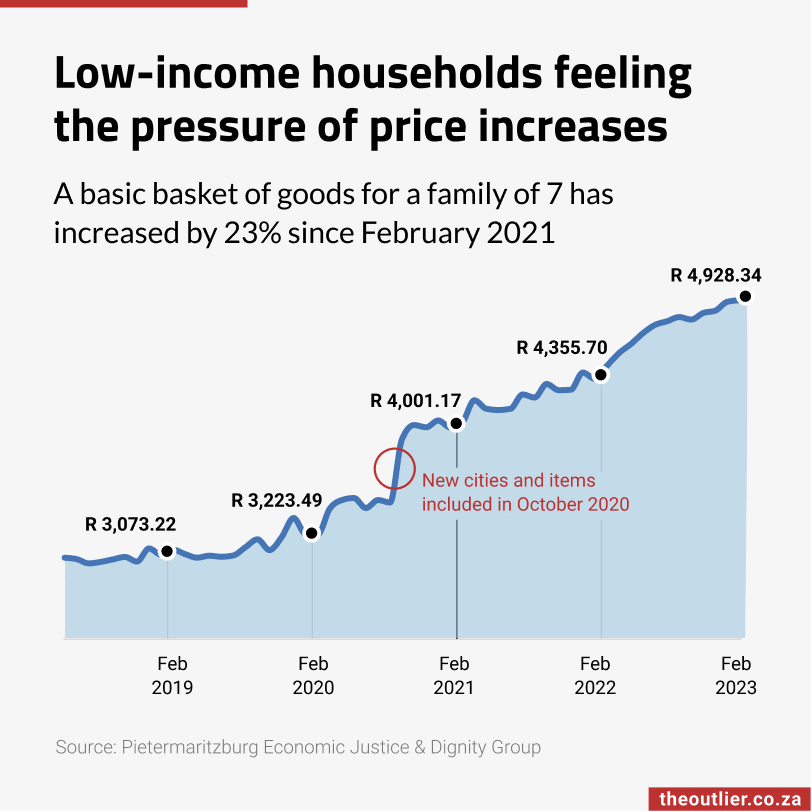
The Pietermaritzburg Economic Justice & Dignity Group has built up an important database of the cost of groceries that low-income households buy regularly. Two years ago, the basket cost just over R4,000. Today, the same items cost just under R5,000, an almost 25% increase.In October 2020, the survey was expanded to include prices from Durban, Cape Town, Johannesburg, and Springbok in the Northern Cape. It previously only collected prices in Pietermaritzburg. The number of items in the basket was also expanded from 38 to 44 items during this expansion. Since February 2019 the price of a basket of goods has increased by 60%.
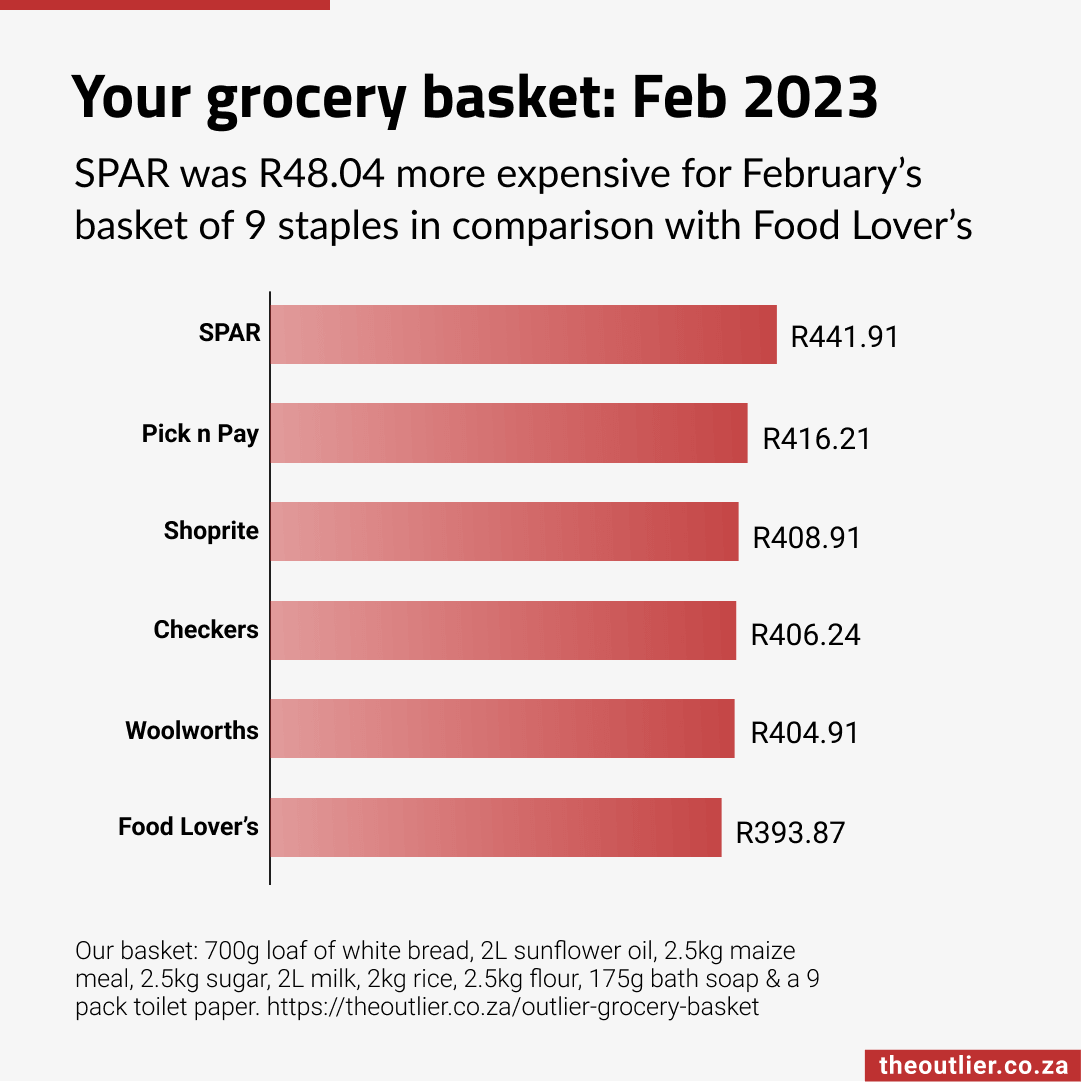
Every month we take a look at the in-store prices of the same basket of goods across six major retailers – Shoprite, Checkers, Pick n Pay, SPAR, Food Lover’s Market and Woolworths.
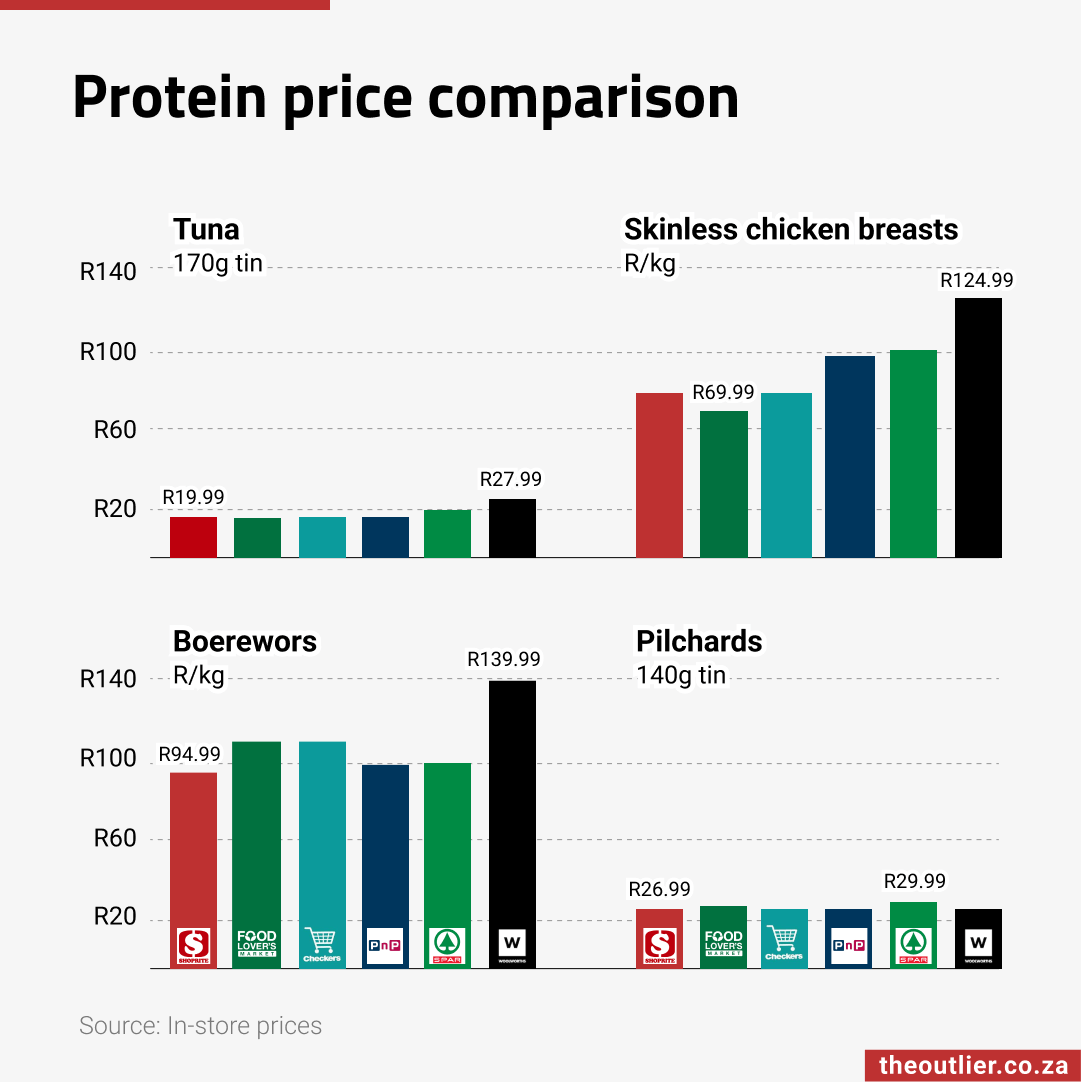
For chicken breasts, Food Lover’s Market was the most affordable option at R69.99 a kilogram versus Woolworths at R124.99.
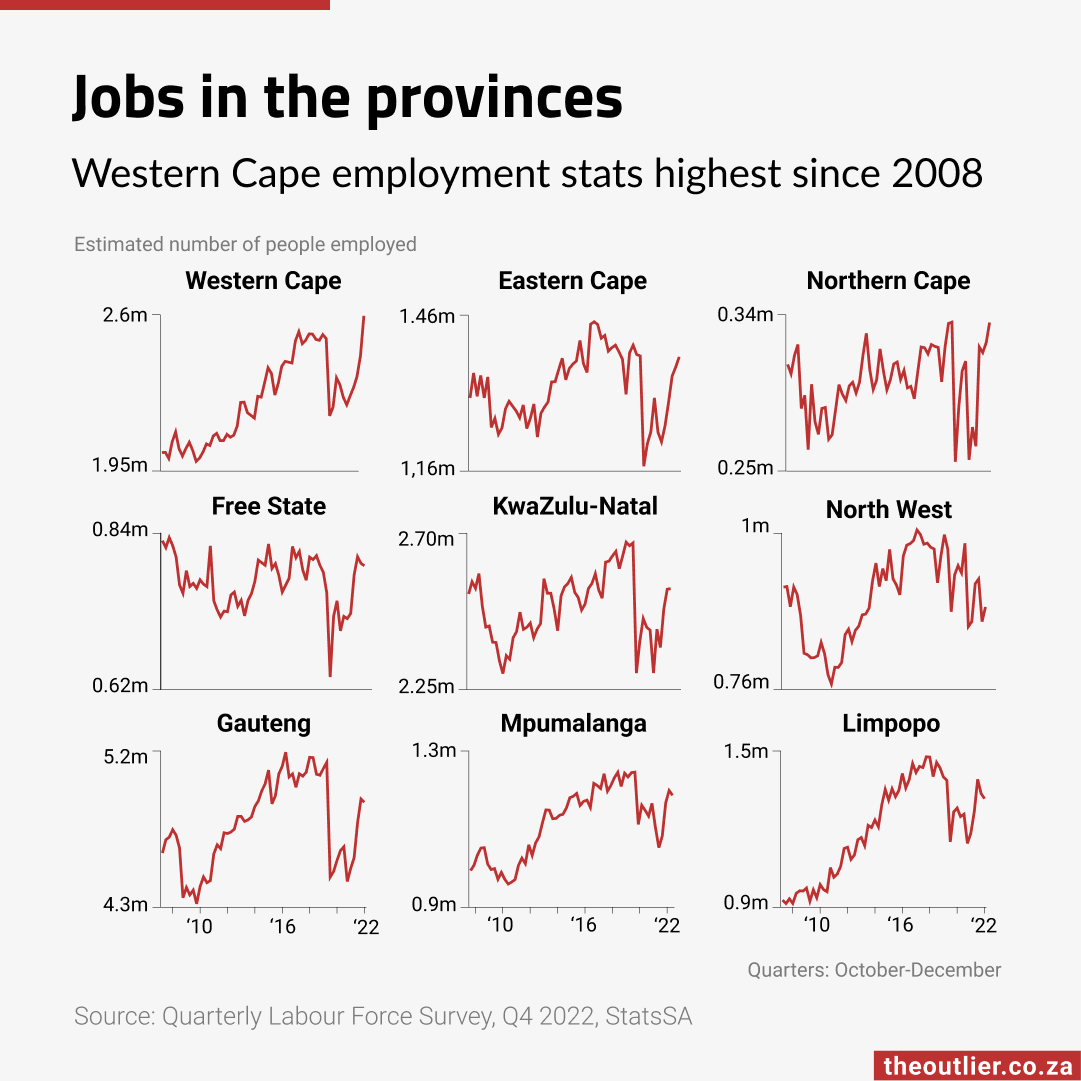
In the latest Quarterly Labour Force Survey from StatsSA, the Western Cape has the highest number of employed people since 2008. Its unemployment rate is 22.5%, well below the national rate.
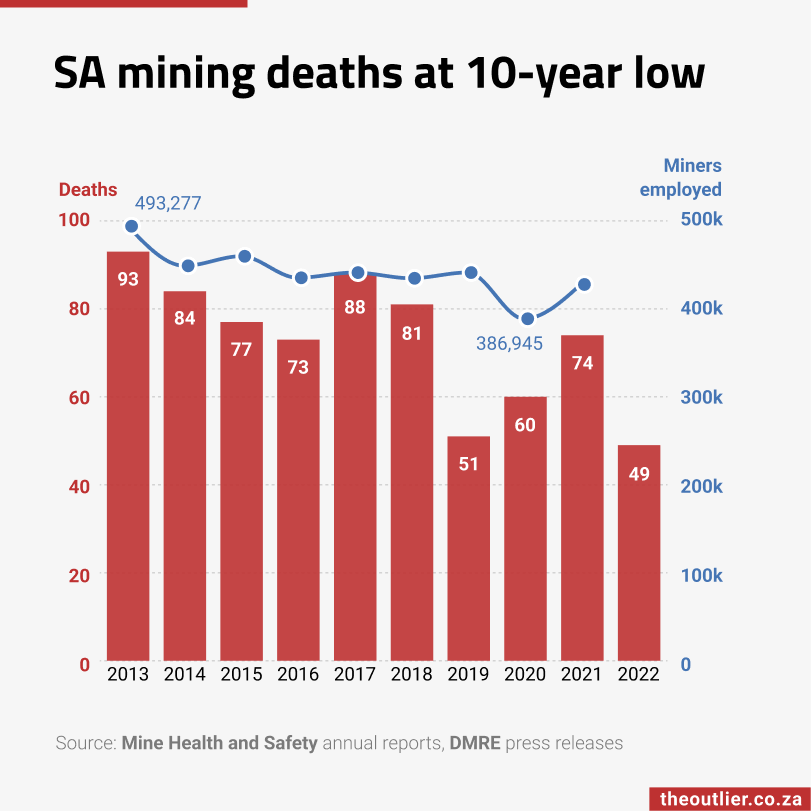
Gold mining accounts for more deaths than any of the other sectors. Since 2013, about 40% of deaths have been at gold mines. Next is platinum (about 30% of deaths) and then coal (10%).
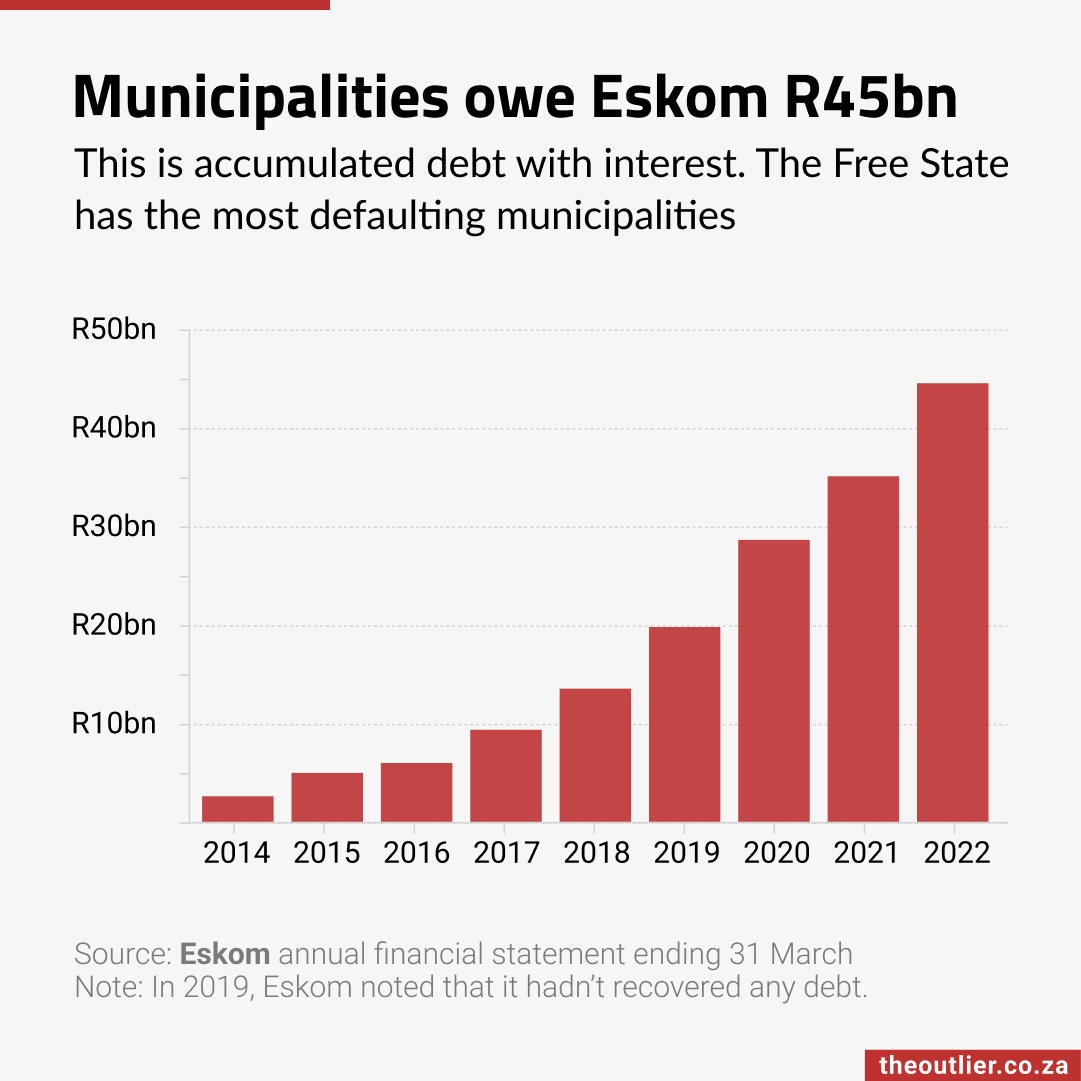
Eskom faces a lot of problems: it has had three chief executives since 2018, it is R396.3-billion in debt, its elderly power stations need constant maintenance, and it doesn’t have enough electricity to supply South Africa.It also has to deal with the fact that municipalities haven’t been paying for the power it supplies. By the end of March 2022, municipalities owed Eskom R44.8-billion.

